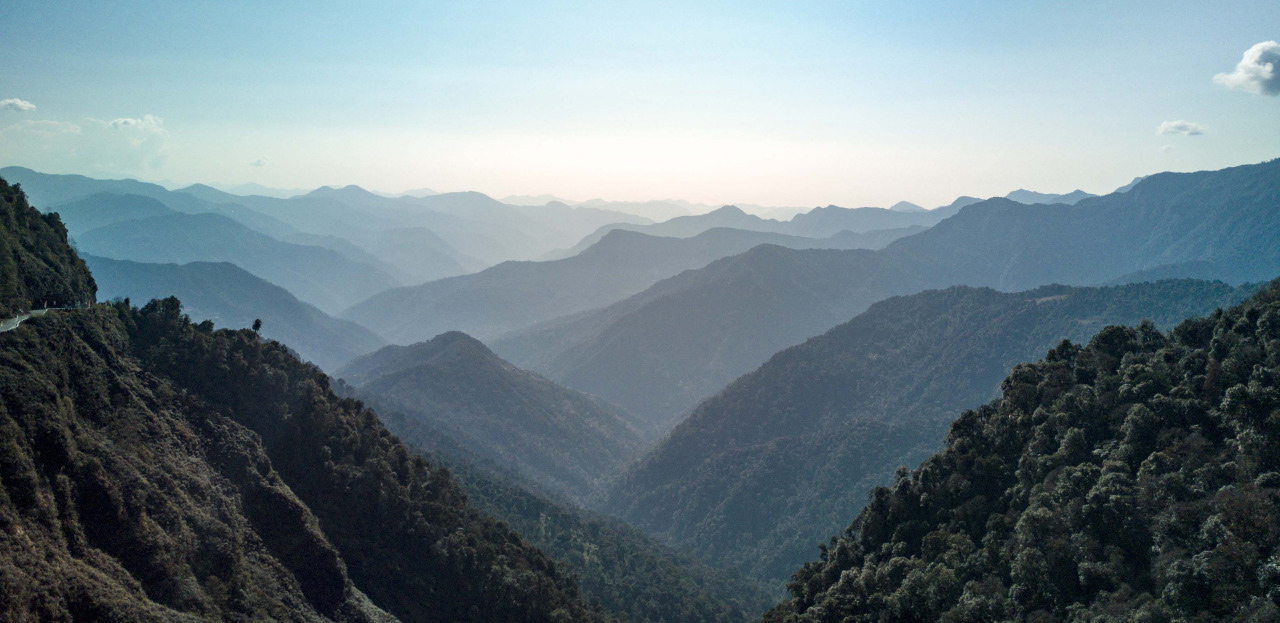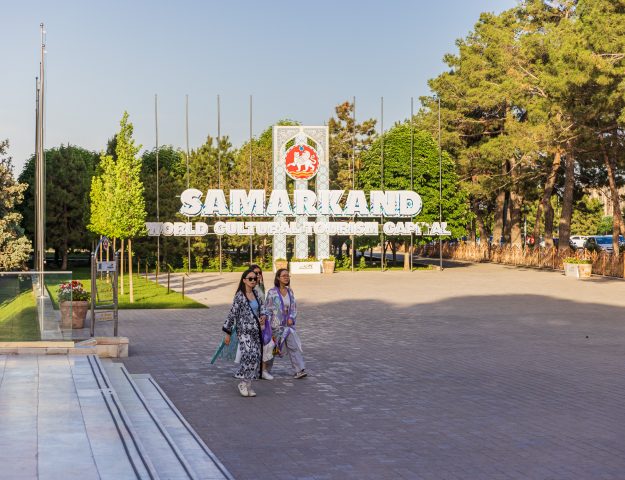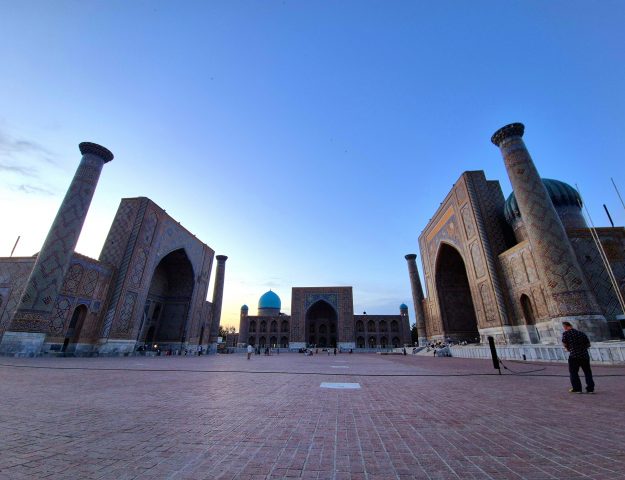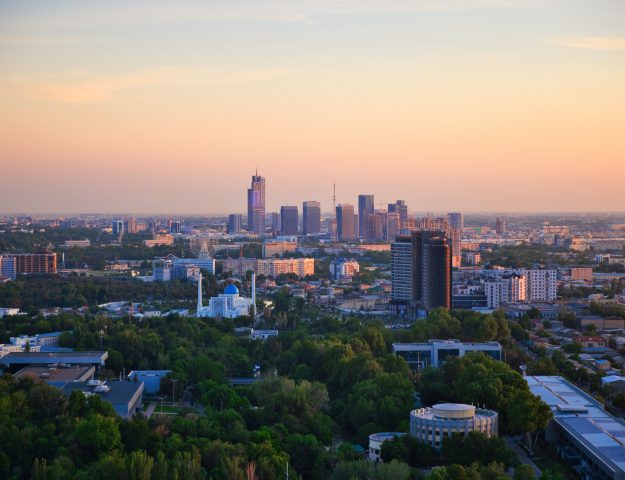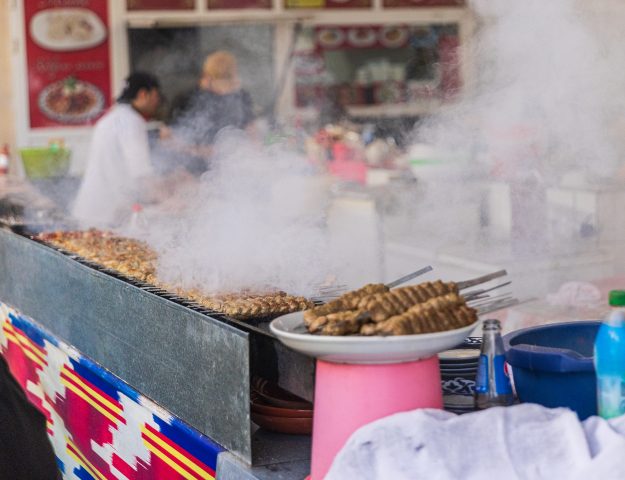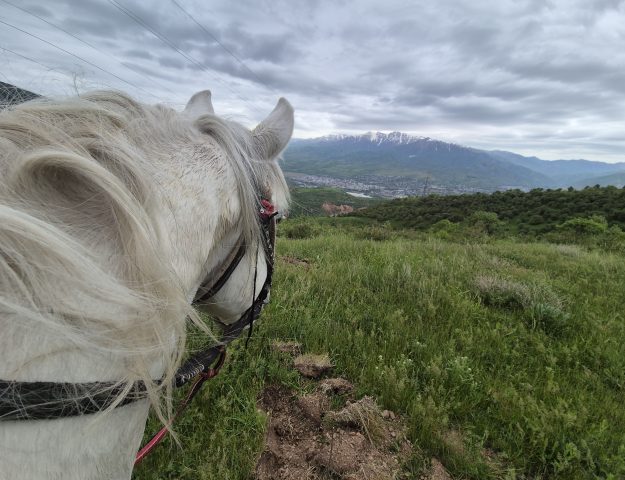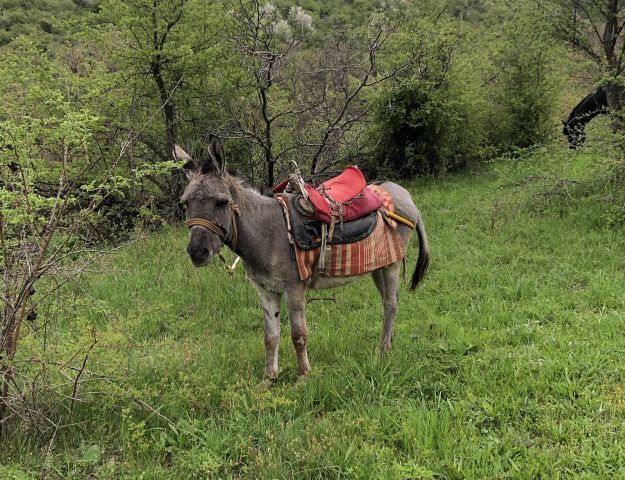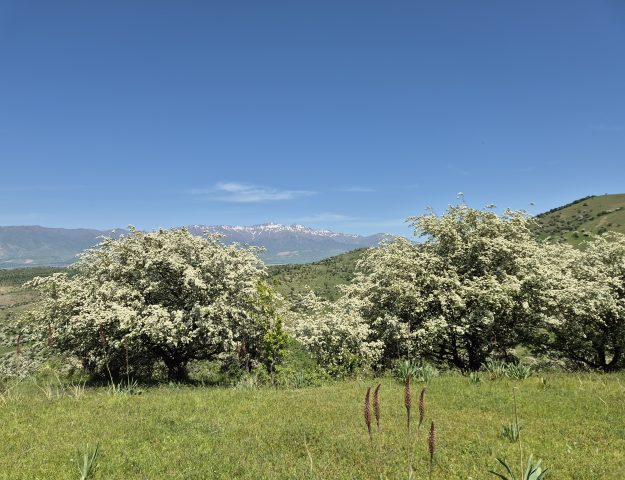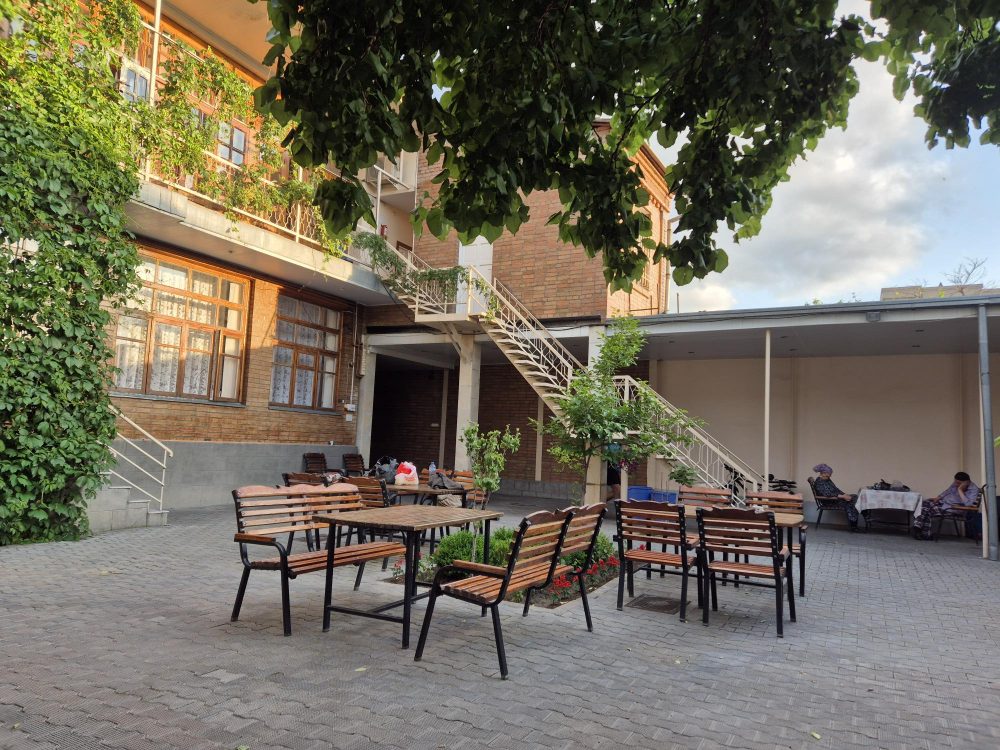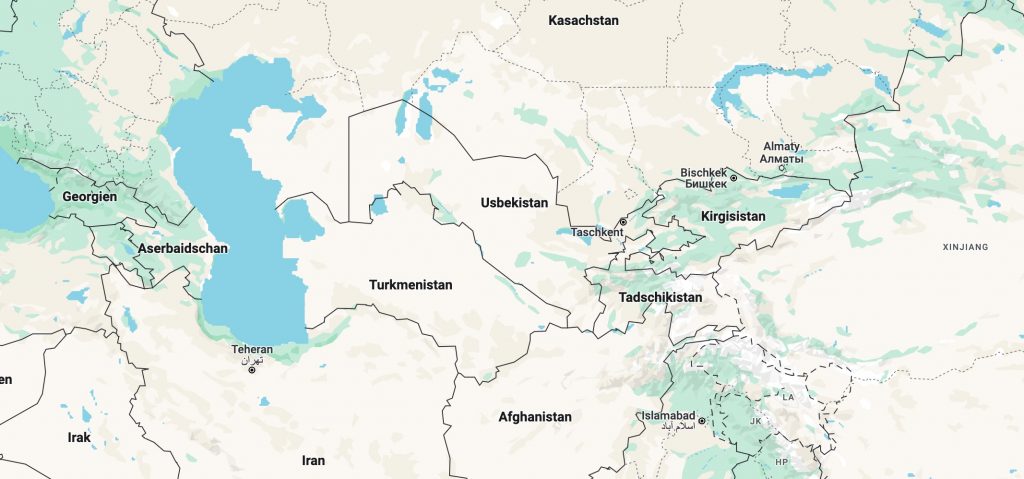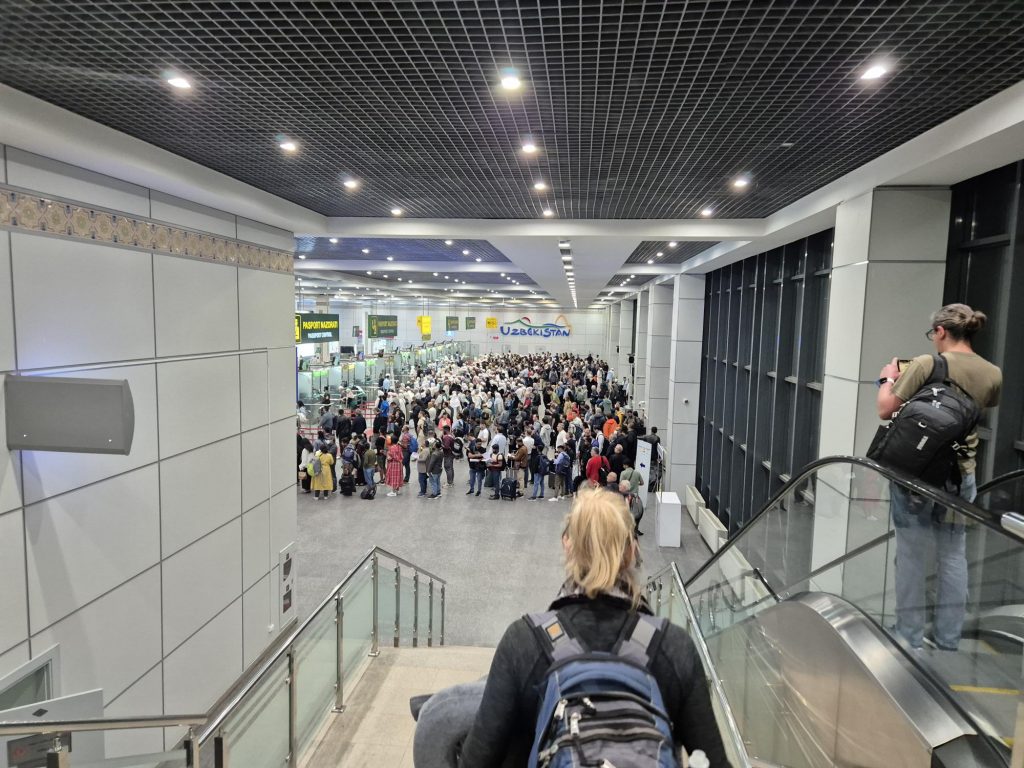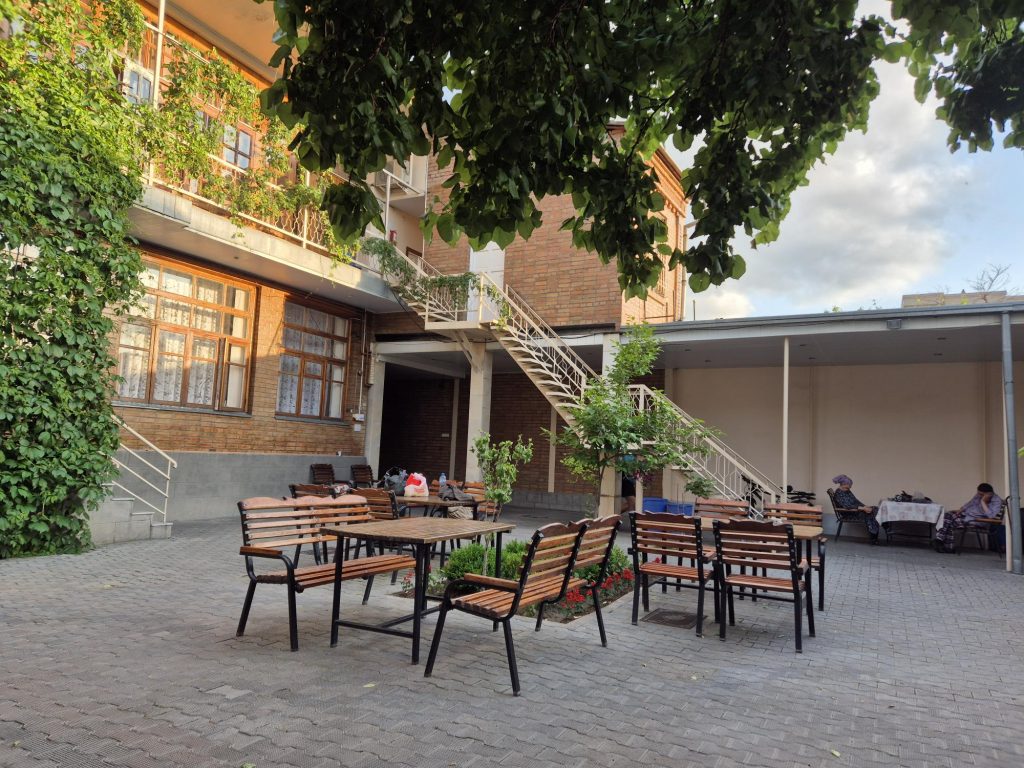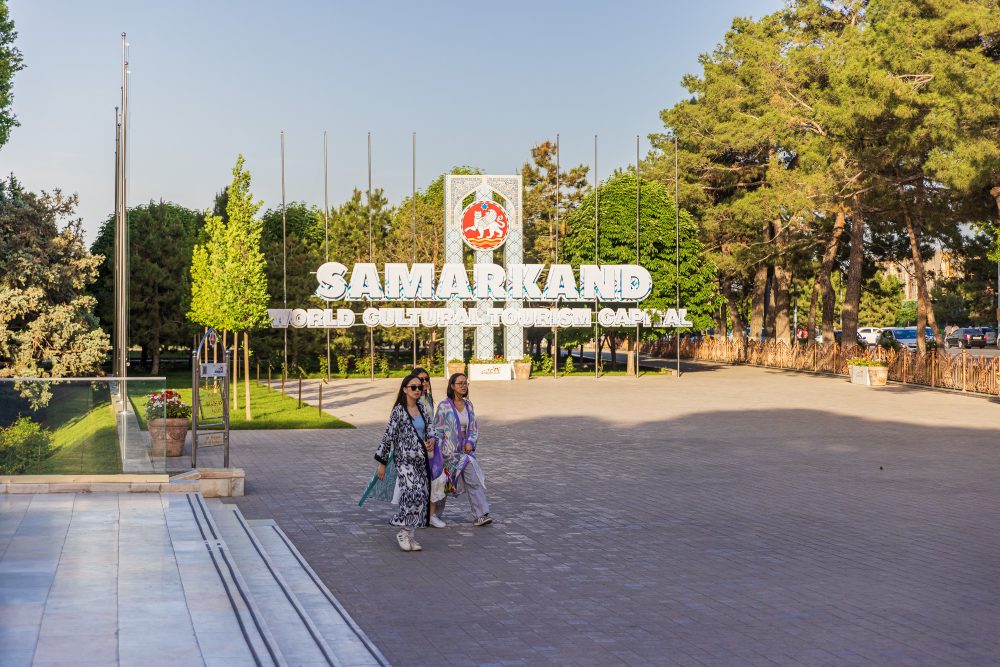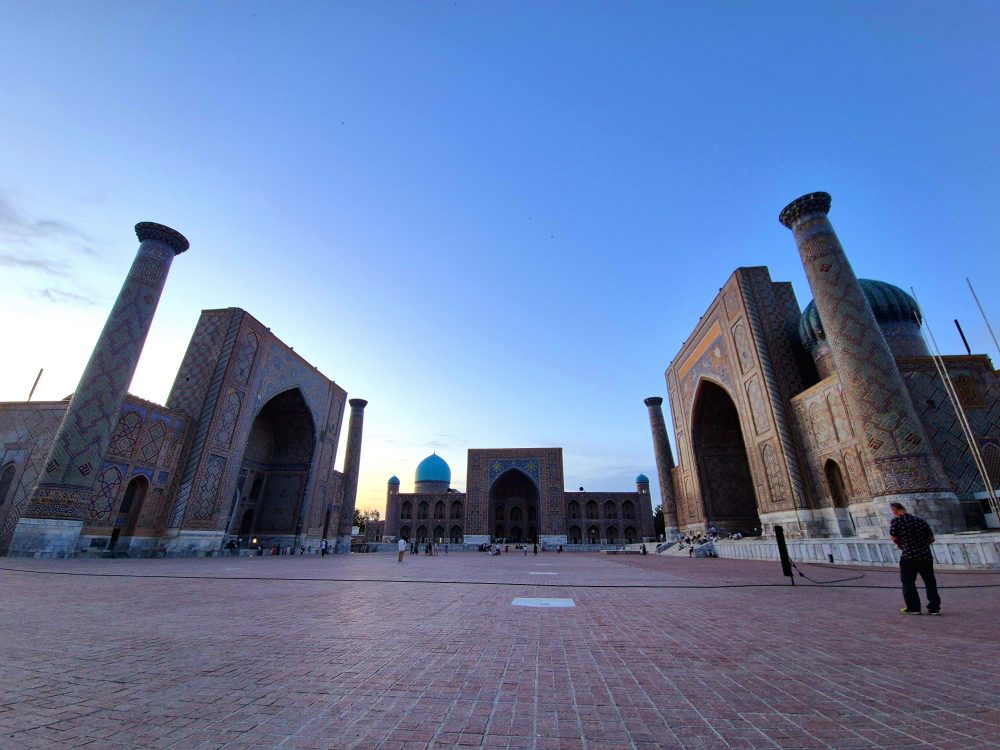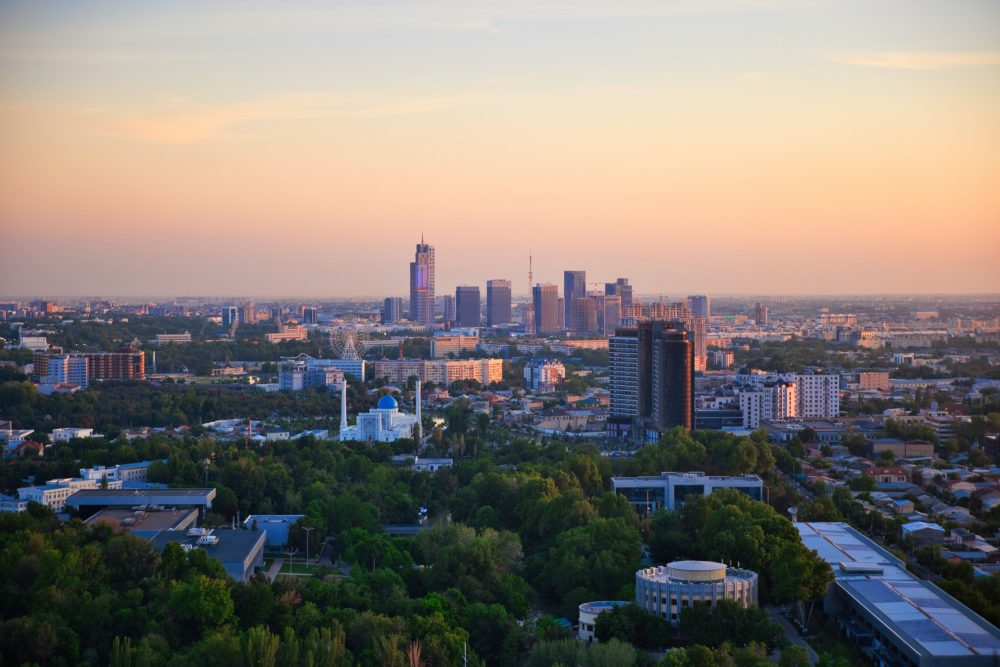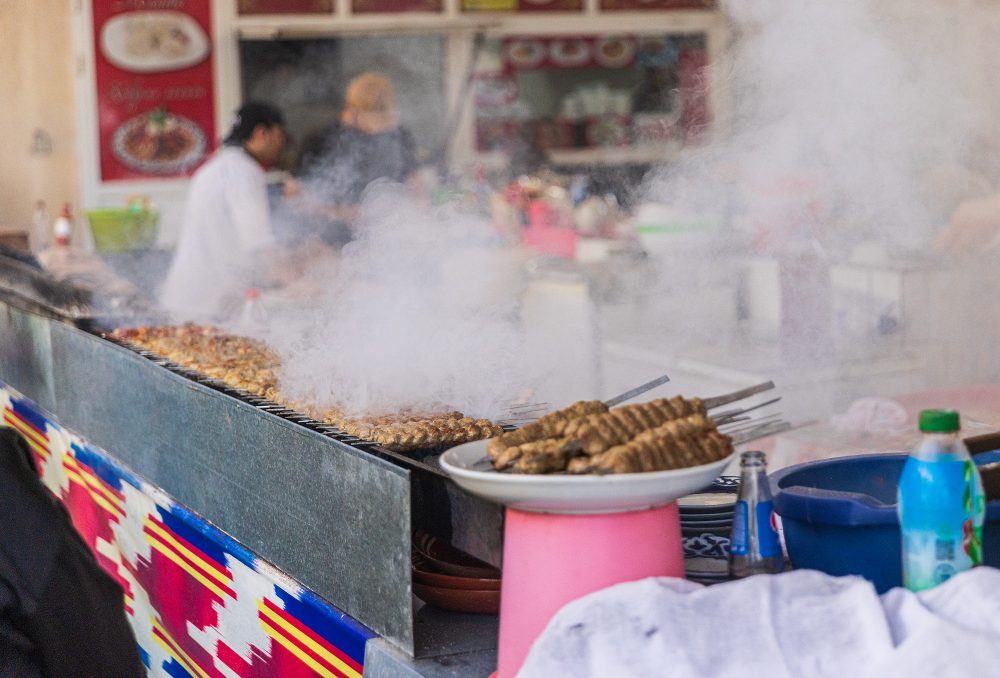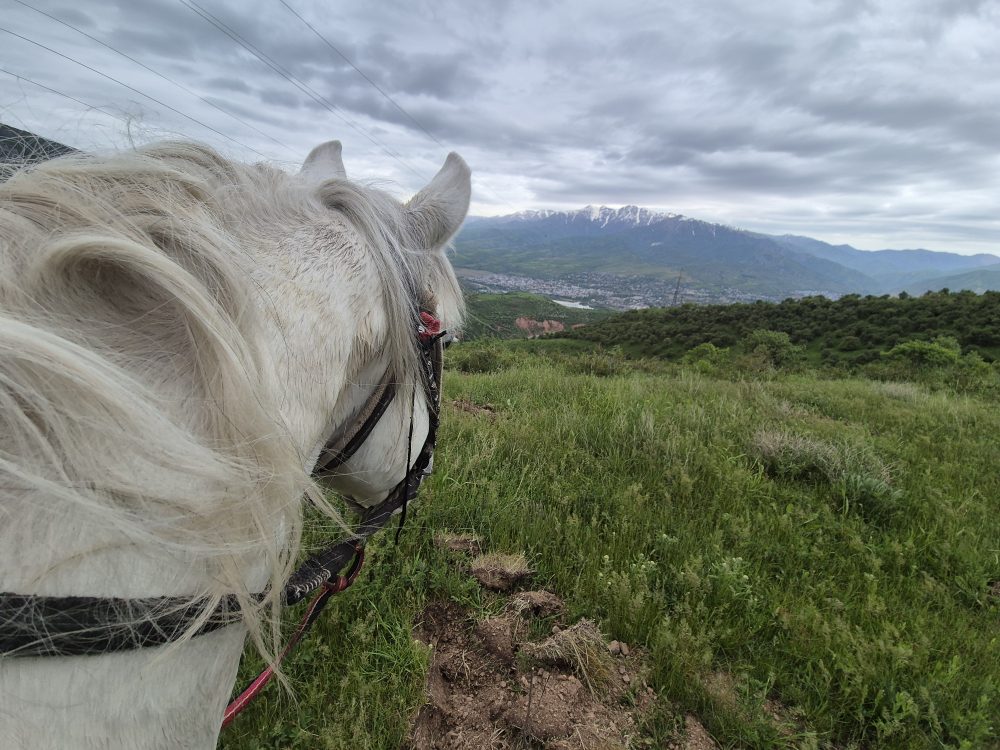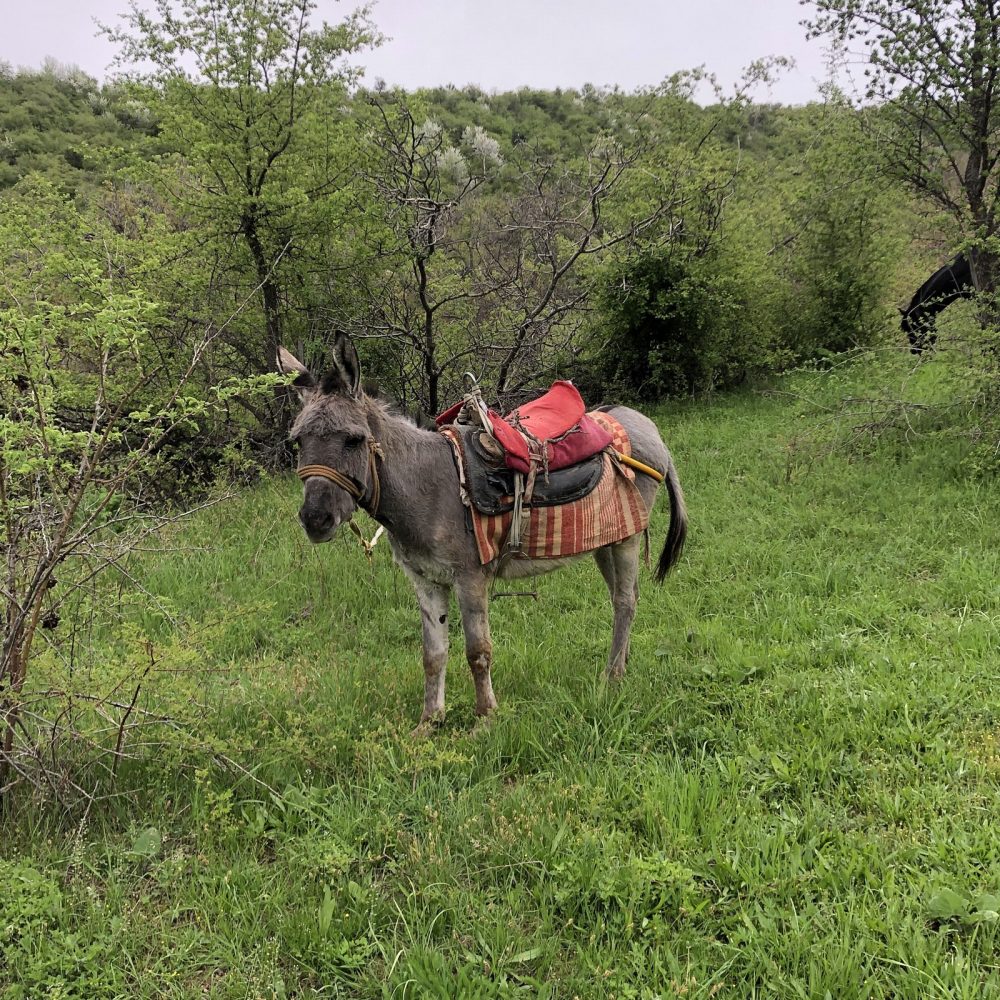Heute war ein weiterer Reisetag. Wir sind relativ spät aufgestanden und ließen es gemütlich angehen. Beim Frühstück verging die Zeit wie im Flug dank lebhafter und lustiger Gespräche mit unseren beiden deutschen Mitreisenden. Sie haben sich über das Internet gefunden, als sie nach Mitreisenden für anspruchsvollere Reiseziele gesucht hatten. Dies war ihre zweite oder dritte Reise zusammen. Für uns war es vor allem auch deswegen unterhaltsam, weil die beiden extrem verschieden waren. Manchmal wirkten die beiden wie ein lange verheiratetes Ehepaar, das sich trotz aller Unterschiede und kleinere Streitereien irgendwie ergänzt und am Ende doch immer wieder zusammenfindet. Später kam die Eigentümerin des Camps vorbei und brachte uns jeweils ein Glas frisch gemolkene Kamelmilch. Da Esther sie noch nie probiert hatte, war sie zunächst skeptisch, aber zu ihrer Überraschung schmeckte die Milch recht mild und ähnelte Kuhmilch mit wenig Fett. Eine weitere Erfahrung für unseren Gaumen.

Wir packten unsere Koffer für den Flug zurück nach Taschkent, was nicht einfach war, da wir einen Liter Wodka für Inom und drei Liter frische Kamelmilch für die Besitzerin des Jurtencamps mitnehmen mussten, für ihre Verwandten in Taschkent. Die Menschen hier helfen sich immer gegenseitig, und so war es für Inom selbstverständlich, ja beinahe verpflichtend ihr diesen Gefallen zu tun. Irgendwie haben wir es geschafft, alles zu verstauen, und hofften nur, dass weder der Wodka noch die Kamelmilch oder der Liter Baumwollsamenöl, den wir gekauft hatten, während des Fluges auslaufen würde.
Wir machten uns gegen Mittag auf den Weg nach Urgench, dem nächstgelegenen Flughafen (auch für Reisen nach Khiwa, wenn man den Zug oder die Straße meiden möchte). Da wir noch etwas Zeit hatten, bevor unser Flug ging, beschlossen wir, am örtlichen Markt von Urgench für einige letzte Einkäufe und ein schnelles Mittagessen anzuhalten. In der Stadt bemerkten wir viele Autos mit kleinen Stücken Papier oder Stoff, die Teile ihrer Nummernschilder bedeckten. Offenbar verwenden Polizeiautos Kameras verwenden, um im Vorbeifahren geparkte Autos aufzunehmen und dann Bußgelder für falsches Parken verhängen. Wenn jedoch die Nummernschilder teilweise verdeckt sind, können die Kameras nicht die vollständige Nummer erfassen, was die Behörden daran hindert, Bußgelder zu verhängen.

Wir lieben lokale Märkte. So viele Gerüche und Eindrücke. Alte, klapprige Einkaufswagen, die durch die Gänge geschoben werden, Säcke mit Gewürzen, die herumstehen, viele verschiedene Süßigkeiten, die uns zum Probieren verführten, und der Viehsektor, der lebende Hühner und Kaninchen verkaufte. Da hatten wir allerdings kein Bedarf – wir kauften lieber verschiedene Teesorten und Gewürze.







Nachdem wir mit dem Einkaufen fertig waren, machten wir uns auf die Suche nach einem Ort, um einen schnellen Happen zu essen.

Immer der Nase nach entdeckten wir frisch gegrilltes Hähnchen, also setzten wir uns in das entsprechende, kleine, aber sehr geschäftiges Restaurant voller Einheimischer.

Wir fielen auf wie bunte Hunde, weil wir die einzigen Ausländer hier waren. Wir verspeisten sechs köstliche Hähnchenspieße und etwas Salat für nur 100.000 Soms (~7,50 EUR) für drei Personen, einschließlich drei Flaschen Cola. Unschlagbar.

Bis zu unserem Flug um 15:30 Uhr von Urgench nach Taschkent blieb uns genug Zeit für unser Mittagsmahl.
Der Flug war unsere erste Gelegenheit, mit Uzbekistan Airways zu fliegen.

Wer denkt, dass Uzbekistan Airways eine ‘never-come-back airline’ ist, mit alten Ilyushin-Flugzeugen, liegt komplett falsch.

Wir bestiegen einen brandneuen, gut ausgestatteten Airbus, komplett mit Bildschirmen und USB-Ladeanschlüssen – viel mehr als Lufthansa (Hallo Herr Spohr?!) auf Inlandsflügen bietet. Außerdem erhält man ein Sandwich und kostenlose Getränke. Uzbekistan Airways haben ausserdem ein sehr unterhaltsames Sicherheitsvideo, das alle touristischen Highlights des Landes zeigt.


Da dies das Ende unserer Reise war, erkannten wir alle Sehenswürdigkeiten wieder, da wir jede einzelne besucht hatten. Lufthansa hat endlich auch ein neues Sicherheitsvideo veröffentlicht – allerdings ist es komplett humorfrei. Passt wohl nicht zum deutschen Image.
Inom bat seine Sitznachbarn, sich ihm für ein schnelles Gebet anzuschließen, und so hoben wir mit Allahs Segen ab, zurück zum Ausgangspunkt unserer Reise, nach Tashkent.

An unserem letzten Abend reservierten wir ein sehr schönes Restaurant und wollten Inom und seine Frau zu unserem Abschiedsessen hier in Usbekistan einladen. Lustigerweise war eine Reisebekantschaft, die wir in Myanmar getroffen hatten, Amish aus Indien, zur gleichen Zeit in der Stadt, und so vereinbarten wir, gemeinsam zu Abend zu essen. Da Amish ein Reisebüro in Indien betreibt und Inom Reisen in Uzbekistan organisiert, weiß man nie, was die Erweiterung seines Netzwerks bringen kann.

Es war ein schöner Abend, und wieder geht ein schöner Urlaub zu Ende. Morgen früh geht unser Flug zurück nach München via Istanbul, und Inom bestand darauf, uns selbst zum Flughafen zu fahren.
Wir hätten uns keinen netteren und besseren Reiseführer als Inom wünschen können. Zusammenfassend war dies ein sehr interessanter Urlaub. Eine gute Mischung aus Natur, Kultur und Aktivitäten sowie dem Besuch verschiedener Städte. Uns haben Samarkand und Taschkent am besten gefallen, da diese Städte eine gute Mischung aus Geschichte und authentischen Alltag bieten.
Khiva und Buchara waren auch großartig, aber nicht so belebt wie die anderen Städte. Damit hatten sie einen eher musealen Charakter. Das Essen war eher – sagen wir mal – herausfordernd. Während einfache Gerichte wie Suppen, Gemüse und Salate durchaus lecker waren, waren die meisten anderen Speisen nicht nach unserem Geschmack, insbesondere solche mit Ziegen- oder Lammfleisch, was letzten Ende auch Hammelfleisch einschließt. Die größte Herausforderung war das Plov, das für den ‘besseren’ Geschmack mit dem Hammelfett des Fettschwanzschafs zubereitet wird.
Damit kommt unser Reiseblog aus Usbekistan zu seinem Ende. Solltet Ihr noch Fragen haben oder weitere Details über Usbekistan wissen wollt… einfach schreiben oder uns fragen.
Today was another travel day. Getting up fairly late we started the day out slowly. Having animated and funny conversations with our fellow travelers from Germany at breakfast time flew by. They searched for fellow travelers for more challenging destinations through the internet. This was their second or third trip together. Despite their huge differences, which made it enjoyable to listen to their stories and experiences, they complemented each other well in some ways. The women owner came by and brought us each a glass of freshly milked camel milk. Having never tried it Esther was very sceptic at first, but to her surprise it tasted quite mild and very similar to rich cows milk. Another experience to add to our plate.

We packed our bags for the flight back to Tashkent, which was not easy as we had to fit in a liter of Vodka for Inom and three liters of fresh camel milk for the yurt camp owner to take to her relatives in Tashkent. People always help each other out here and so Inom did that lady a favor. We managed fit everything in and just hoped that neithr the Vodka, nor the camel milk or our liter of cotton seed oil we bought will be running out during our flight.
We set out mid morning to drive to Urgench, the closest airport. As we had some time left before taking our flight we decided to stop the the local Urgench market for some last minute shopping and light lunch. In the city, we noticed many cars with small pieces of paper or cloth covering parts of their license plates. It turns out that police cars use cameras to record parked cars while they drive by and issue fines for illegal parking. However, with the license plates partially obscured, the cameras can’t capture the full plate number, preventing the authorities from issuing fines.

We love the local markets. So many smells and sights. Old rickety shopping carts being pushed through the aisles, bags of spices standing around, lots of different sweets tempting us to be tried , the live stock section selling chickens and rabbits. We bought diferent types of teas and also decided to take home some cotton seed oil.







After being done with the shopping part we looked for a place to have a quick bite.

The noses smelled grilled chicken and so we went to sit in a small but very busy restaurant full with locals.

We stuck out as being the only foreigners here. We had delicious chicken kebaps and some salad for a mere 100.000 Soms (~7.50 EUR) for three people including three bottles of Coca-Cola. Can‘t beat that.

We had enough time to catch our 3:30 PM flight from Urgench to Tashkent, our first opportunity to fly with Uzbekistan Airways.

For those who might think that Uzbekistan Airways is some ‘never-come-back airline’ flying old Ilyushin planes, you couldn’t be more wrong.

We boarded a brand-new, well-equipped Airbus, complete with screens and USB charging ports—much more than Lufthansa offers on local flights. Plus, you get a sandwich and complimentary drinks. They even have a very entertaining safety video showcasing all the tourist highlights of the country.


Since this was the end of our journey, we recognized all the landmarks, having visited each one. Lufthansa has finally released a new safety video as well—needless to say, it is not funny at all. Inom asked his seat neighbors to join him for a quick prayer, and so we took off, safely protected by Allah’s hands, back to the starting point of our journey.

On our last evening we reserved a very nice restaurant and wanted to invite Inom and his wife for our final dinner here in Uzbekistan. Funny enough an aquaintance we met in Myanmar, Amish from India, happend to be in town at the same time and we agreed to have dinner together. Amish being a travel agent in india and Inom one in Uzbekistan, one never knows what extending ones network may bring.

It was a lovely evening and again a nice vacation comes to an end. Tomorrow morning our flight back to Munich via Istanbul leaves early and Inom insisted on driving us to the airport himself.
We could not have wished for a nicer and better guide then Inom. In summary this was a very interesting vacation. A good mix of nature and activity as well as visiting different cities. We liked Samarkand and Tashkent best as those cities have a good mix between history and real life.
Khiva and Bukhara were great too, but not as bustling with everyday life as the other cities. Food-wise, it was a bit challenging—while simple dishes like soups, vegetables, and salads were nice, most other foods weren’t to our taste, especially those involving goat or lamb, which includes all ages of mutton.
This concludes our travel blog from Uzbekistan. Feel free to ask any questions or if you need more details about Uzbekistan.
Heute haben wir einen letzten frühen Spaziergang durch Chiwa gemacht. Die Sonne bahnte sich ihren Weg durch die Wolken, und vor acht Uhr morgens war die Stadt leer, abgesehen von ein paar Händlern, die ihre Stände für den Tag vorbereiteten, und Frauen, die die Straßen fegten. Wir ließen uns durch die jahrhundertealte Stadt treiben und dachten darüber nach, wie anders diese Straßen und Gebäude im 16. Jahrhundert ausgesehen haben müssen.

Die Architektur und Fassaden haben uns sehr gefallen, dennoch fanden wir Chiwa als Stadt nicht so lebendig wie Samarkand oder Taschkent, wo Tradition und alltägliches Leben viel stärker miteinander verschmelzen.

Nach einem herzhaften Frühstück verließen wir unser gemütliches Hotel in Chiwa gegen zehn Uhr morgens und machten uns auf den Weg in die Wüste von Karakalpakistan, der autonomen Republik innerhalb Usbekistans. Karakalpakistan war einst eine blühende Region, die im großen Flussdelta des Amudarja-Flusses lag. Der Fluss, der in Tadschikistan entspringt, fließt auch durch Afghanistan und Turkmenistan und mündete einst in das Aralsee. Heutzutage erreicht nur noch ein Drittel des ursprünglichen Wasservolumens Usbekistan, da die Nachbarländer bereits zwei Drittel für die Landwirtschaft abzweigen. Von dem verbleibenden Drittel benötigt Usbekistan den Großteil für seine Baumwollindustrie. Heute fließt nichts mehr in den Aralsee, der große Fluss versiegt jetzt im Wüstensand.
Während der zweistündigen Fahrt sahen wir die gigantischen Kanäle, die gegraben wurden, um die enormen Wassermengen sicherzustellen, die für die Baumwollfelder benötigt werden. Baumwolle ist eine Pflanze, die kurz vor der Ernte, in den trockensten Zeiten des Jahres, riesige Mengen Wasser benötigt.
Dies ist eines der Umweltkatastrophen, die die Sowjets verursacht haben. In den 1940er Jahren wurden riesige Kanäle und Wasserreservoirs gebaut, um sicherzustellen, dass die Baumwollfelder im September rechtzeitig geflutet werden können, damit die Baumwollknospen aufplatzen und geerntet werden können.


Die Sowjets und später die usbekische Regierung konzentrierten sich auf Baumwolle als das Hauptexportgut, unbeeindruckt davon, wie schädlich diese Pflanze für die raue usbekische Umwelt war. Baumwolle benötigt nicht nur enorme Wassermengen in einem Wüstenstaat, sondern laugt auch den Boden aus und erfordert große Mengen an Düngemitteln sowie Pestiziden. Selbst heute noch ist die Bodenqualität in Usbekistan durch die toxischen Substanzen, die für den Baumwollanbau verwendet wurden, stark geschädigt. Langsam ändert sich die Situation, und das Land ist weniger abhängig vom Baumwollanbau, sondern setzt vermehrt auf Obst und Gemüse, das höhere Preise erzielt, sowie andere Rohstoffe wie Öl, Gas und Mineralien. Auch der Tourismus beginnt einen wesentlichen Beitrag zum BIP zu leisten.
Der Wassermangel hat die einst blühende Fischergemeinde in Karakalpakistan im wahrsten Sinne des Wortes austrocknen lassen, und die Städte wurden zunehmend verlassen. Heute ist es ein recht deprimierender Ort. Der Aralsee ist nahezu verschwunden. Die Grundwasserstände sind gesunken, und der Salzgehalt der verbleibenden Brunnen und Bäche ist hoch.

Je weiter wir in die Wüste fuhren, desto schlechter wurden die Straßen zu unserem letzten Ziel. Obwohl sie nicht so schlecht wie in Simbabwe waren, waren sie teilweise ziemlich holprig. Wir hatten den Eindruck, dass unser Fahrer schneller fuhr, um zu vermeiden, dass seine Reifen in ein Schlagloch fallen. Fun fact: Auf dem Weg nach Elliq Qala, was fünfzig Burgen bedeutet, fuhren wir durch eine Stadt namens Bo‘ston.

Zwischen dem einst grünen Flussdelta und den Wüstengebieten gab es eine große Anzahl von verlassenen Burgen, die bis ins Jahr 200 v. Chr. zurückreichen. Wir hielten an einem Hügel auf dem die Ruinen einer Burg mit Lehmmauern zu sehen waren.

Als wir einen steilen Pfad hinaufgingen, sahen wir einen Schwarm wunderschöner, leuchtend grüner Vögel mit roten Unterflügeln und einem schwarz-weißen Streifen auf dem Kopf sowie einem spitzen schwarzen Schnabel. Wir identifizierten sie als Grüne Bienenfresser.
Diese Festungen, die von den frühen Siedlern und Herrschern der Oase erbaut wurden, um sich gegen marodierende Nomadenstämme zu schützen, sind ziemlich groß (etwas mehr als 10×10 Meter) aber von den inneren Wänden sind nur noch vage Umrisse zu erkennen.

Der Regen und der ständig wehende Sand nagen jedes Jahr an ihnen. Tuprak Qala war eine solche Festung, die von 200 v. Chr. bis 600 n. Chr. zurückreicht, aber seitdem verlassen ist. Viele Mauern sind eingestürzt oder wurden weggeschwemmt. Wir wären fast selbst weggespült worden, als uns mitten während unseres Besuchs auf der Spitze ein schnell herannahendes Gewitter überraschte.

Wir machten uns so schnell wie möglich auf den Weg nach unten und retteten uns ins Auto, bevor der große Regen auf uns einprasselte. Andere Besucher hatten nicht so viel Glück und wurden nicht nur durchnässt, sondern rutschten auf den immer schlammiger werdenden Wegen aus.
Während des Gewitters fuhren wir weiter und erreichten schließlich das Ayaz Qala Jurtenlager, das sich direkt am Fuß von zwei ehemaligen Festungen, Ayaz Qala Eins und Zwei, befindet.

Wir hatten ein nettes Mittagessen in unserer Jurte, das von der Besitzerin des Lagers serviert wurde. Es parkten auch noch eine Reihe von Reisebussen und Autos, und so beschlossen wir zu warten, bis alle bis auf die Übernachtungsgäste gegangen waren. Um 17 Uhr hatten wir den Ort für uns alleine, und wie durch ein Wunder klarte das Wetter auf, und die Sonne kam heraus.

Wir machten uns auf den Weg zur ersten Festung, und ähnlich wie bei Tuplak Qala bestand Ayaz Qala eins aus einem großen Platz, der von hohen Mauern umgeben war.

Einige Teile waren noch sichtbar, andere waren verschwunden oder eingestürzt. Die Mauern mussten hohl gewesen sein, da Bögen einen überdachten Gang stützten. Einige davon sind noch erhalten. Nach der Tour durch die obere Festung machten wir uns auf den Weg zur unteren.




Wir sahen einen merkwürdig aussehenden kleinen Baum, der aus dem sandigen und felsigen Boden wuchs. Diese Pflanze wird von Einheimischen zur Behandlung von Diabetes verwendet. Nach den Frühlingsregen kann sie an einem Tag bis zu einem Meter wachsen, viel Wasser in ihrem Stamm speichern und ihr Fruchtfleisch kann auch gegessen werden, wenn es noch nicht vertrocknet ist. Wir sahen keine Pflanze, die größer als eineinhalb Meter war.

Die untere Festung war viel kleiner und beherbergte ursprünglich die Soldaten, die die Festung bewachten. Von dort aus war die Aussicht auf die obere Festung großartig.

Auf dem Rückweg zum Jurtenlager sahen wir niedliche kleine Erdhörnchen und kleine Eidechsen, die vor uns davonhuschten. Das Abendessen wurde auf einer großen, mit Teppichen ausgelegten Plattform serviert, und wir trafen unsere Mitreisenden, die auch über Nacht im Lager blieben.


Der Sonnenuntergang tauchte die Festung in goldenes Licht, und ein gekühltes Glas Wein und gutes Essen rundeten einen sehr angenehmen Abend in der Wüste ab.
Weiter geht es hier mit Tag 17, dem letzten Tag unserer Reise.
Today we went for an early last stroll through Khiva. The sun was making her way through the clouds and before eight in the morning the city is empty besides a handful of merchants readying their stalls for the day and women sweeping the streets. We let ourselves drift through the centuries old town, thinkig how different those very streets and buildings must have looked in the 16th century.

We liked the architecture and fassades very much, still Khiva as a city we found not as vibrant as Samarkand or Tashkent where tradition and normal life is mixing much more.

After a hearty breakfast we left our lovely hotel in Khiva around ten AM and set out to drive into the desert in Karakalpakstan or Republic of Karakalpakstan. Karakalpakstan is an autonomous province inside Uzbekistan and was a thriving area living in a great river delta of the Amudarja river that orinigated in Tajikistan but also flows through Afghanistan and Turkmenistan and ended in the Aral sea. Nowadays only a third of the original water level still flows into Uzbekistan, as their neighbours already siphon off 2/3 for agriculture. Of the remaining third, Uzbekistan needs most of it for their cotton industry. Today nothing flows into the Aral sea anymore, the great river nowadays ends in the desert sand.
During the two hour drive we saw all the gigantic canals that were dug to ensure the enormous quantities of water that were needed for the cotton fields. Cotton is a plant that needs huge quantities of water exactly right before the harvest, in the driest times of the year.
This is one of the environmental desasters that the Soviets have created. Huge canals and water reservoirs were built in the 1940 to ensure that in September the cotton fields can be flooded in time to make the cotton buds burst open so they can be picked.


The soviets and then later the Uzbek government forced the concentration on cotton as the number one export good regardless how harmful this plant for the harsh Uzbek environment. Cotton not only needs huge quantities of water in a desert state, it also depletes the soil and needs large quantities of fertilizer and pesticides. Even today the soil quality in Uzbekistan is damaged by the toxic substances that were used to grow cotton. Slowly things are changing and the country is less dependent on cotton, but grows more fruit and vegetables as well as other raw materials like oil, gas and minerals. And tourism is starting to make a difference.
The lack of water dried up the thriving fishing community in Karalpakstan and citys became more and more deserted. It‘s quite a depressing place nowadays. The Aral sea has all but disappeared. Ground water levels have sunken and salt content of the remaining wells and streams is high.

The roads to our final destination in the desert deteriorated the further we drove. Although not as bad as in Zimbabwe, they became quite rough at a certain point. We had the impression that our driver sped up just to avoid his tires falling into a pothole. Fun fact, we drove through a town called Bo‘ston on our way to Elliq Qala, meaning fifty castles.

Between the once green river delta and the desert areas were a large number of now abandoned castles dating back to 200 BC. We stopped at a hill that had ruins of a mud walled castle on top.

Going up a steep path we saw a flock of beautiful bright green birds with red underwings and a black and white stripe on their face. They had a pointy black beak We identified them as the green bee eaters.
Built by the early settlers and rulers of the Oasis to protect themselves against marauding nomad tribes those fortresses are fairly large in size ( easily 10×10 meters square) but only a vague outline of the inner walls could be made out.

The rain and constantly blowing sand are eating away at them every year. Tuprak Qala was one such fortress dating back to 200 BC until 600 AD but lies abandoned since. Many walls had fallen down or been washed away. We nearly were washed away too when a fast moving thunderstorm caught us by surprise in the middle of our visit on top.

Making our way down as fast as we could we saved ourselves into the car before the big deluge started. Other visitors weren‘t that lucky and literally got not only drenched but also slid down the fast developing mud slides due to the torrential rain.
Heading on through the thunderstorm we made our way to the Ayaz Qala yurt camp, right on the foot of two former fortresses Ayaz Qala one and two.

We had a nice lunch in our yurt served by the woman owner of the camp. We still saw a number of tour busses and cars despatching their passengers onto the forts and decided to wait until all but the camp overnighters had left. By 5 PM we had the place to ourselves and magically the weather had cleared up and the sun came out.

We made our way up the first fortress and similar to Tuplak Qala, Ayaz Qala one consisted of a large square surrounded by high walls. Some still visible, other parts had vanished or fallen down. The walls must have been hollow as arches supported a covered walkway originally. Some were still preserved, after a tour through the upper fortress, we made our way down to the lower one.





We saw a strange looking little tree that grew out of the sandy and rocky soil. This plant is used by locals to treat diabetes. After spring rains, it can grow up to a meter in a day, store a lot of water in its trunk and it‘s flesh can also be eaten when still growing. We saw no plant taller than a meter.

The lower fortress was much smaller and originally housed the soldiers that protected the fortress. From there the view onto the upper fortress was great.

Making our way back to the yurt camp we saw cute littel ground squirrels and little lizzards dashing away from us. Dinner was served on a large carpeted platform and we met our fellow travelers who also stayed overnight at the camp.


The sunset bathed the fortress in golden light and a chilled glass of wine and good food rounded off a very pleasant evening in the desert.
Khiva hat so viele erstaunliche Sehenswürdigkeiten zu bieten, dass es sich anfühlt, als würde man durch eine Museumsstadt spazieren, in der sich ein beeindruckendes Gebäude an das nächste reiht. Die Stadt ist für allen rund um die Uhr offen, wer die vielen Gebäude im Inneren besichtigen möchte, muss aber ein 2-Tages-Sammelticket kaufen. Khiva war einst von zwei Mauern geschützt, aber die äußere Mauer ist inzwischen verschwunden. Die inneren Mauern, die das Herz der Stadt schützen, wurden restauriert und ziehen sich in einem beeindruckenden Band um die gesamte Stadt.

Diese Mauer mit ihren Wehrgängen ist gute 15-20 Meter hoch und massiv gebaut. Sie umfasst die Altstadt vollständig. Der Zugang ist nur durch vier Tore möglich, in jeder Himmelsrichtung eines.

Von unserem sehr schönen Hotel aus sind es keine 100 Meter zum Haupttor. Es gibt einen Hauptweg vom westlichsten Tor bis zum östlichen Tor. Er ist mit kleinen Souvenirständen gesäumt, die grösstenteils lokale Kunst- und Handwerksartikel verkaufen.

Die gesamte Stadt ist im Wesentlichen mit Stein gepflastert, Bäume wachsen in speziellen Blumenbeeten und in den Innenhofgärten. Khiva ist äußerst sauber und ordentlich. Wie üblich ist der Palast das zentrale Objekt der alten Stadt und wird Kuhna Ark genannt.

Der Ark beherbergte nicht nur den regierenden Khan (König) mit seinem Thronsaal, seiner privaten Moschee und seinen Empfangsräumen, sondern auch seinen Harem, seine Ställe, Ehrenquartiere für Gäste, Kasernen für seine Wache, die Münze, das Waffenarsenal und ein Gefängnis.

Fast alles ist auf Neuzustand restauriert und zeigt einige schöne blaue Fliesenarbeiten und bemalte Decken. Der Ark hat auch einen hohen Wachturm, von dem aus man die gesamte Stadt in alle Richtungen überblicken kann. Kurz vor Sonnenuntergang bot sich uns ein großartiger Rundumblick.

Über die Stadt verstreut gibt es eine Reihe größerer und kleinerer Medressen, also religiöser Schulen. Die meisten sind jetzt in kleine Museen umgewandelt. Es gibt Museen für alte Kunst, Musikinstrumente, Wissenschaft, Medizin, traditionelle Kleidung, Schmuck und Teppiche.

Wir besuchten ein kleines Teppichgeschäft, in dem drei Frauen jeweils ihren Seidenteppichen knüpften. Es ist jedes Mal aufs neue faszinierend zu sehen, wie viel Handarbeit erforderlich ist, um einen einzigen Seidenteppich herzustellen. Eine Teppichmacherin benötigt etwa ein Jahr, um einen Seidenteppich mit den Maßen 1,20 m x 2 m herzustellen. Dafür muss man dann – je nachdem wie dicht die Knotenzahl pro Quadratzentimeter ist – 6.000 Euro und mehr hinblättern.

atürlich gibt es eine Reihe von Mausoleen, einige größere, einige sehr kleine, die hoch angesehene religiöse Führer ehren, und es ist üblich, dass alle Frauen angemessene Kleidung tragen, einschließlich eines Kopftuchs, und dass Männer ihre Knie und Schultern bedecken und die Schuhe vor der Tür lassen bevor sie die Innenräume des Heiligtums betreten.

Jeder größere Komplex hat hohe Außenmauern und einen hübschen Innenhof, meist mit einem großen Maulbeerbaum, der einen schattigen Platze zum Sitzen und Entspannen bietet.

Die ikonischsten Sehenswürdigkeiten der Stadt sind jedoch ihre Minarette. Es gibt vier große und eine Reihe kleinerer. Jedes ist an eine Moschee angeschlossen, aber besonders die beiden größten übertreffen ihre Moscheen in ihrer prachtvollen Erscheinung.

Das Kalta Minor Minarett ist kurz und dick. Es ist vollständig mit verschiedenen türkisfarbenen Fliesen und unterschiedlichen Mustern bedeckt. Es ist wirklich ein Anblick, den man gesehen haben muss. Es sieht aus, als hätte jemand geplant, dies zum höchsten Minarett der Welt zu machen, aber nach einem Drittel aufgehört und es nicht vollendet. Genau das ist passiert. Der Herrscher Amin Khan begann 1851 mit dem Bau, starb jedoch 1855, bevor das Minarett vollendet werden konnte. Sein Sohn hatte offenbar kein Interesse den Bau abzuschließen.

Das andere große Minarett ist das der Islom-Hoja-Medresse-Moschee. Es wurde 1910 erbaut. Mit 57 Metern Höhe ist es das höchste Minarett Usbekistans und hat mit seiner eleganten Form ein bisschen etwas von einem Leuchtturm. Hierfür war ein gesondertes Ticket notwenig, was Gnom ein wenig verärgerte, weil es früher offenbar im 2-Tages-Pass eingeschlossen war. Wir erklommen das Minarett über eine ziemlich steile Wendeltreppe (stellenweise sogar auf allen Vieren). Ganz oben wurden wir mit einer grandiose Aussicht belohnt. Islom Hoja selbst war ein wohltätiger Großwesir und gründete auch das erste Krankenhaus in Khiva, direkt neben dem Minarett.

Da Khiva der letzte Stadtstopp unserer Reise ist, konnte Esther nicht widerstehen, einige der Waren zu kaufen, die in der alten Karawanserei angeboten wurden. Wunderschön weiche Seidenschals, elegante Wickelhosen, farbenfrohe Tischläufer – wir hätten viel mehr kaufen können, aber wählten nur einige ausgewählte Stücke aus. Die Preise werden von den Verkäufern meist willkürlich festgelegt weswegen feilschen angesagt ist. Wer den Preis nicht mindestens um die Hälfte drückt kann davon ausgehen, dass er übers Ohr gehauen wurde.

Als wir unsere Beute im Hotel ablegen wollten, sahen wir, wie ein Tandoori Ofen mit trockenen Baumwollzweigen angeheizt wurde. Auf dem Tisch warteten verschiedene Sorten Samsa Teigtaschen darauf ausgebacken zu werden. Zwei Damen hatten drei Sorten vorbereitet, mit Kartoffel-, Kürbis- und Fleischfüllung. Wir sicherten uns unsere Portion frischer Samsas und verschlangen die köstlichen Samsas, nachdem wir unsere Taschen im Hotel abgelegt hatten. Das Mittagessen konnten wir damit ausfallen lassen und stattdessen den zweiten Teil des Tages mit einem Abendessen auf der Dachterrasse abzuschließen, und bei einem leckeren Mahl den Sonnenuntergang beobachten, der Khiva in ein sanftes, warmes Licht tauchte.



Ein schöner Abschluss unserer Stadtführungen durch Usbekistan, die voller Geschichte und einigen Überraschungen waren. Letztlich wurde uns wieder mal bewusst, wie hart das Leben früher gewesen sein muss und wie gesegnet wir sind, in unserer Zeit zu leben.


Für den nächsten Tag steht unser letzter Ausflug an. Ziel sind einigen alten Wüstenfestungen und eine Nacht im Jurtencamp am Rande der Wüste an, bevor es mit Uzbekistan Airways zurück in die Hauptstadt nach Taschkent geht.
Hier geht es zu Tag 16
Where to start? Khiva has so many amazing sites to offer, it‘s like walking in a museum town with one stunning building next to another. Khiva had two walls protecting it, but the outer wall has since disappeared.

The inner walls protecting the heart of the city have been restored and are running in an impressive band around the entire town. The wall with it‘s ramparts is easily 15-20 meters high and of a massive build. They surround the city completely. Access is only possible through four gates, one in each direction.

From our very lovely hotel one had to simply walk 100 meters to the main gate. There is one main throughfare from the Western most gate to the Eastern gate lined with little souvenir stalls that also sold local arts & crafts items.

Basically all of the town has a stone floor and trees are reserved for dedicated flower beds and inner courtyard gardens. Khiva is extremely clean and tidy. As customary the palace is a central piece of the ancient town and called the Kuhna Ark.

The Ark not only housed the residing Khan with his throne room, private mosque and receiving chambers but also of his harem, his stables, honorary guest quarters, barracks for his guard, the mint, the arsenal of weapons and a jail.

Nearly all has been well preserved and restored and it shows some beautiful blue tilework and painted ceilings. The ark also has a high watch tower where one could see in al directions. We had a very nice pre sunset view from the top.

Scattered across town are a number of larger and smaller Medrassas, religious schools. Most are now converted into small museums. There are museums for ancient art, musical instruments, science, medical, traditional clothing, jewelry and carpets.

We visited a smal carpet shop where they showed how real silk carpets are still being made. It is mind boggling to see how much manual labor it is to produce one single silk carpet. One carpet maker needs about one year to make a silk carpet of 1.20m x 2 m dimension. It then is sold for about 6000 EUR.

There are of course a number of mausoleums, some larger, some very small that honors some highly respected religious leaders and it is customary for all women to wear proper attire, incl. A head scarf and for men to cover their knees and shoulders and leave the shoes outside.

Each larger complex has high outer walls and a pretty inner courtyard, mosyly with a large Mulbery tree and provide some shaded spots to sit down and relax.

The most iconic sights of Khiva though are it‘s minarets. There are four large ones, and numbr of smaller ones. Each is attached to a mosque but especially the two major ones eclipse their mosques in impressiveness.

The Kalta Minor Minaret is short and fat. It is covered all over with a variety of turquoise tiles and different shapes. It is truly a sight to be seen. It looks as if someone had planned to make this the highest Minaret in the whole world but stopped half way and could not finish it. That‘s exactly what happened. The ruler Amin Khan started to build it in 1851 but dropped dead in 1855 unable to finish the minaret.

The other major minaret is the one attached to the Islom Hoja Medrassa‘s mosque. It was built in 1910. At 57 meters height it is Uzbekistans highest Minaret and has a little bit of a light house with it‘s elegant shape. This one we could climb up a steep spiral staircase and had a grandiose view from up top. Islom Hoja himself was a benevolent grand vizir and also created the first hospital in Khiva, right next to the minaret.

Khiva being the last city stop on our journey, we could not resist buying a few of the wares that were offered in the old Caravanseray. Beautifully soft silk scarfes, elegant wrap around trousers, colorful table runners , we could have bought much more but we hand picked just a few items.

Pricing is random by the sellers and you always have to haggle.
Having the hotel so close by is a clear advantage as one can have a light lunch and then drop ones shopping bags in the hotel at lunchtime. As we had eaten some delicious hot Samsas (dough with potato, pumpkin or meat filling, baked in a round clay oven) we decided to skip lunch and instead finish out our second half of the day with a roof top terrace dinner overlooking the central square and watching the sunset bathe Khiva in a soft warm light.



A nice way to end our Uzbekistan city tours so full of history and surprises. We imagined how hard the life then must have been and how blessed we are to live in our times.


Tomorrow is our last excursion to some old desert fortresses and a night in the yurt camp before flying back to Tashkent.
Wir mussten um 2:40 Uhr morgens aufstehen, um unseren Zug nach Chiwa zu erwischen. Es ist eine nette Abwechslung verschiedene Transportmittel zu kombinieren, um eine Vielzahl von Erfahrungen zu sammeln und den Menschen in ihrem Alltag nahezukommen. Nachdem wir mit dem Auto, auf dem Pferderücken, zu Fuß und auf Kamelen unterwegs gewesen sind, wollten wir die Strecke von Buchara nach Chiwa mit dem Zug zurücklegen. Chiwa ist (geographisch) die westlichste Stadt, die wir in Usbekistan besuchen. Dort sollen sich weniger Touristen als in Buchara oder Samarkand herumtreiben. Zum einen, weil sie kleiner ist – vor allem aber weil sie weitab von den anderen touristischen Hotspots liegt. Mit dem Zug sollten es etwas mehr als sechs Stunden sein. Es wird allerdings bereits an einer Strecke für den Bullet-Train, den Schnellzug gebaut.
Ein Taxi holte uns um 3:00 Uhr morgens ab, da der Hauptbahnhof rätselhafterweise 25 km außerhalb von Buchara liegt.

Dort machten sich noch weitere verschlafen wirkende Touristen und etliche Einheimische auf den Weg zum Bahnsteig. Es gibt keine Über- oder Unterführungen, um zu den anderen Bahnsteigen zu gelangen, daher mussten wir alle die Gleise überqueren. Inom hatte für uns einen Schlafwagen gebucht, da zur Zeit alle Tickets für den Tageszug ausverkauft sind, und so mussten wir mit einem Nachtzug fahren.

Der Zug war enorm lang, 14 Waggons plus ein Bordrestaurant. Unser Waggon war die Nummer 14, also gingen wir bis ans Ende des Zuges und hievten unsere schweren Taschen in den Waggon.

Es war ein alter sowjetischer Wagen, und als wir im Dunkeln einstiegen, tasteten wir uns langsam durch einen schmalen, schwach beleuchteten Gang, mit schlafenden Menschen rechts und links. Füße hingen in den Gang, Leute schnarchten, andere unterhielten sich leise. Ein Schlafwagen bedeutete nicht, dass man ein eigenes Abteil bekam, es bedeutete lediglich, dass die Sitze zu einfachen Liegen mit Matratzen umgeklappt wurden, zwei unten, zwei oben und zwei auf der anderen Seite des Ganges.

Es war sehr stickig und heiß dort, und man konnte die Fenster nicht öffnen. Etwas ratlos standen wir vor unseren drei reservierten Betten mit unseren großen Taschen und wussten nicht, was wir als nächstes tun sollten. Wir hatten unsere Schlafsäcke in Taschkent gelassen, und es wäre ohnehin viel zu heiß für sie gewesen. Eines unserer Betten war von jemand anderem belegt, und Inom ließ ihn umziehen. Dann verschwand er und tauchte mit drei Plastiktüten auf, die frisch gewaschene Bettwäsche enthielten. Ein Kissenbezug, ein Bettlaken und ein Oberlaken, alle frisch gestärkt und gebleicht. Sie rochen sauber, und so machten wir jeweils unsere Betten, verstauten unser Gepäck darunter oder oben und legten uns für ein paar Stunden unruhigen Schlafs hin. Trotz des sanften Schwankens und Rhythmus des fahrenden Zuges wurden wir nicht in einen langen Schlaf gewiegt, es war zu heiß, und das Schnarchen war erheblich. Der Tagesanbruch begann um 5:00 Uhr, und um 5:30 Uhr war es bereits hell. Die Fahrt sollte etwa 6 Stunden dauern.
Also waren um 8:00 Uhr fast alle wach und machten sich so gut wie möglich frisch. Zum Glück haben die olten Sowjetwaggons einen integrierterten Samovar mit heißem Wasser, dazu gibt es für jeden Teegläser und -beutel.

Zwei Frauen in ihren Vierzigern saßen auf der anderen Seite des Ganges, und wir begannen ein nettes übersetztes Gespräch mit ihnen mit Inoms Hilfe.
Kontakte zu knüpfen ist hier in Usbekistan einfach, sich verständlich zu machen ist jedoch eine größere Herausforderung. In der Schlange vor der Toilette wurde Chris auf Russisch angesprochen, da jemand dachte, er sei Russe. Das führte zu einem interessanten, aber kurzen Gespräch. Denn auch wenn Chris ein paar Brocken Russisch beherscht, reicht es nicht für eine vertiefendes Gespräch. Die beiden Frauen hingegen fragten Inom nach uns, da wir die einzigen Touristen in unserem Waggon waren und es wohl eher untypisch ist hier Leute anzutreffen die sich auch die deutlich bequemere Anreise im Flugzeug hätten leisten können.

Bald lachten wir und tauschten Frühstückssnacks und Bilder unserer Familien aus. Besonders Ticktack-Omi (Die Urgroßmutter) mit ihrem rosa Haarbüschel und ihrem stolzen Alter von 101 Jahren erhielt jede Menge bewundernde Ahs und Ohs. Die Zeit bis zu unserer Ankunft in Chiwa verging dank diesem Smalltalk wie im Fluge, zumal die Landschaft draußen nur aus Wüste bestand, soweit das Auge reichte. Obwohl wir nicht viele Nächte in solchen Zügen verbringen möchten, fühlte es sich gut und richtig an, mitten unter normalen Usbeken zu reisen.


In Chiwa angekommen, nahmen wir ein Taxi für die kurze Fahrt zu unserem Boutique-Hotel direkt gegenüber dem Haupttor der Stadt. Die Seidenstraßen-Karawanserei war eine umgebaute kleine Medresse mit nur 12 Zimmern, alle schön renoviert, aber die kuppelförmigen Räume und der Innenhof sind original erhalten geblieben, auch wenn später Dinge wie fließendes Wasser, Elektrizität, Air Condition und eine Dusche hinzugefügt wurden. Ein echtes Kleinod und genau der richtige Ort, um die heißen Mittagsstunden im Schatten oder bei einem Nickerchen im Zimmer zu verbringen.

Nach einer kühlen Dusche, die wir nach Stunden im heißen Zug alle dringend brauchten, genossen wir einen Cappuccino und machten uns dann auf, die Stadt zu erkunden.
Chiwa wurde um das 8. Jahrhundert gegründet, entwickelte sich aber erst im 16. Jahrhundert zu einem wichtigen Handelszentrum und zur Hauptstadt der Region. Diese Wüstenstadt hatte einige Brunnen, die durstigen Wüstenreisenden Wasser bereitstellten, daher war sie ein sehr wichtiger Anlaufpunkt für die Karawanen. Aber lange Zeit hatte sie auch einen sehr zweifelhaften Ruhm. Chiwa war die Hauptstadt des Sklavenhandels (bis zum Anfang des 20. Jahrhunderts wurden hier Sklaven gehandelt), Synonym für barbarische Grausamkeit, schreckliche und gefährliche Wüstenreisen sowie für Banden gesetzloser Stämme, die unter den Reisenden und Kaufleuten Angst und Schrecken verbreiteten.

Das heutige Chiwa ist wirklich ein Schritt zurück in die Zeit, da alle originalen Gebäude, die gesamte innere Stadt erhalten und restauriert wurden. Es fühlt sich mehr wie eine Aladdin-Filmkulisse oder ein Freilichtmuseum an als eine lebendige und geschäftige echte Stadt. Es ist viel los, aber alles kommt von den Touristen, die die Stadt besuchen. Etwa 6.000 Einheimische leben noch innerhalb der alten Stadtmauern, wir schätzten, dass etwa 90 % von ihnen in irgendeiner Weise vom Tourismus leben.


Die wunderschön restaurierten Gebäude sind wirklich atemberaubend, besonders die Minarette. Und davon gibt es viele. Wir werden diese in unserem nächsten Blogeintrag ausführlich beschreiben, da wir den ganzen Tag mit der Erkundung von Chiwa verbringen werden. Wir ließen uns ein wenig durch die Stadt treiben, wo nach 15:00 Uhr überraschend wenige Touristen unterwegs waren. Das warme Licht bot sich für ein paar Fotos an.








Wir hatten einen Platz auf der Dachterrasse für den Sonnenuntergang und das Abendessen reserviert und ließen den Tag mit gutem Essen und einem Glas gekühltem Weißwein ausklingen. Leider hatte eine Gruppe deutscher Touristen einen Teil der Dachterrasse für ihr Glas ‘Champanskoje’ reserviert. Später begann eine weitere deutsche Gruppe zu beliebten internationalen Gassenhauer, live auf Oboe gespielt, ausgelassen zu tanzen. Aber hey, wir waren ja im Urlaub, also lachten wir über die Absurdität der Situation. Wir waren nur froh, dass Inom das nicht miterleben musste. Er hätte sicher Himmel und Hölle in Bewegung gesetzt uns entweder einen neuen Platz zu finden oder alle von der Dachteressae zu verbannen.


Am Ende des Tages freuten wir uns auf den Nächten und waren gespannt darauf, alles noch ausführlicher zu erkunden.
Weiter zu Tag 15
We had to get up at 2.40 AM in the early morning in order to catch our train to Khiva. We always like to combine different modes of transport on our travels for a variety of experiences. After cars, horses, on foot trekking and camel, we decided that the easiest route to get from Bukhara to Khiva is by train. Khiva is the most western city we are visiting while in Uzbekistan. It has less tourists than Bukhara or Samarkand but also is a smaller area. Being the westernmost city in Uzbekistan, its geographical location makes access for travellers more challenging.
Inom and his taxi driver picked us up at 3 AM, as the train station, for whatever reason, is located 25 km on the outskirts of Bukhara.

Sleepily a few other tourists and a lot of locals headed the same way, rolling our travel bags across the cobblestones to our platform. There are no underpaths to cross over to a different platorm, so we all had to cross over the rails. Inom said he booked a sleeper coach for us and that there were no tickets for a day train, so he had to book us an overnight train.

The train was enormously long, 14 wagons plus an on board restaurant. Our waggon was number 14 so we walked all the way to the end of the train and hieved our heavy bags into the waggon. It was an old Soviet style coach and as we boarded in the near dark, we made our way slowly through a narrow, dimly lit isle with people sleeeping right and left.

Feet hanging into the aisle, people snoring, others quietly talking. Sleeper coach did not get you an own compartement, it simply meant that the seats are folded down to a simple cot like bed with mattress two below, two above and two across the aisle on the other side.

It was very stuffy and hot in there and one could not open the locked windows. A bit clueless we stood in front of our three reserved beds with our big bags not knowing what to do next. We had left our sleeping bags in Tashkent and it would have been much to hot for them anyway. One of our beds was occupied by someone else and Inom made him move. Then he disappeared and reappeared with three plastic bags which had freshly washed linens in there. A pillow case, a bottom sheet and a top sheet, alle freshly starched and bleached white. They smelled clean and so we each made our cots stored our luggage underneath or on top and settled down for a few hours of fitfull sleep. Despite the gentle swaying and rhythm of the moving train, it did not lull us into a long sleep, it was too hot and the snoring level was considerably high. The day break started at 5 AM and by 5.30 it is full daylight. The journey was supposed to take about 6 hrs.
So by 8 AM pretty much everyone was awake and cleaned up as best as possible. Good thing about those old russian trains: there is always a samovar with hot water and you get glases & tea bags.

Two women in their mid forties sat across the aisle from us and we stroke up a nice translated conversation between them and us with Inoms help. Making contact is easy here in Uzbekistan, getting understood is more challenging. In line for the toilet Chris got chatted up in Russian by someone thinking he was Russian. It was an interesting, yet short conversation as Chris’ Russian is rather limited. The two ladies asked Inom about us as we were the only tourists in our waggon and an unusual sight for someone that should be able to afford more comfortable transport.

We soon laughted and exchanged breaksfast snacks and pictures of our families. Specially Tick Tack Omi with her pink whiff of hair and her age got the most astounded comments. The time until we arrived in Khiva flew by with small talk especially as the outside landscape consisted only of desert as far as the eye could see. While we would not want to spend many nights in trains like that, the experience to be in the middle of just normal Uzbek people traveling their way was something that felt right.


Arrived in Khiva, we took a shot taxi ride to our boutique hotel right opposite the main Khiva city gate. The Silk Road Caravansaray was a converted small Medrassa that only had 12 rooms, all nicely renovated but the domed room shapes and inner courtyard remained original, even though other things like running water, electricity and a shower were added later. A real find and super pleasant to spend the hot lunchtime hours in the shade or napping.

After a cool shower that we all craved bwing in the hot train for hours, we enjoyed a coffee and then headed out to explore the city.
Khiva was founded around the 8th century, but did not become a major trading hub and capital of the region until the 16th century. This desert town did have some wells to provide for water during desert travel, so it was an important life saving stop for the caravans, but in the beginning it did have a very somber claim to fame. Khiva was the capital of the slave trade, synonomous of barbaric cruelty, horrible and risk desert journeys and bands of lawless tribesmen that struck fear in all the travelers and merchants.

Today’s Khiva truly feels like a step back in time. All the original buildings and the entire inner city have been preserved and restored. It feels more like the backdrop of an Aladdin movie or an open-air museum than a living, bustling city. There is indeed a lot of activity, but it primarily comes from tourists. About 6,000 locals still live within the old town’s walls, and we estimated that around 90% of them are involved in tourism in some capacity.


The beautifully restored buildings are truly stunning. Especially the minarets. And there are plenty of them. We‘ll describe those in detail in our next days blog entry as we‘ll be spending a whole day exploring Khiva. Today, we just wandered around the city, which had surprisingly few tourists after 3 PM but a beautiful light for photography. Enjoy some of Chris‘ pictures.








Having reserved a roof top terrace spot for sunset and dinner we let our day phase out with some good food and a glass of chilled white wine. Unfortunately, a group of German tourists had reserved a section of the rooftop for their glass of ‘Champanskoje.’ Later, another German group started dancing to popular international songs played on an oboe. But hey, we were on holiday, so we laughed at the absurdity of the situation. We were just glad that Inom didn’t have to witness it.


At the end of the day, we were looking forward to tomorrow, eager to explore in much more detail.
Buchara, von den Einheimischen Buxoro genannt, war einst eine der größten Städte Zentralasiens. Eine ehemalige Hauptstadt, bekannt für ihre Medressen (islamische Religionsschulen) und die vielen Kanäle und Becken, die durch die Stadt verliefen. Viele der alten Gebäude aus dem 16. Jahrhundert sind erhalten geblieben, aber viele der Kanäle und Becken sind verschwunden.

Wie in Samarkand vereinen sich in Buchara die nördliche und südliche Route der Seidenstraße. Es war ein bedeutendes Handelszentrum mit einer großen Festung, die es bewachte und auch als Residenz des herrschenden Emirs diente.

Nachdem wir bei unserem abendlichen Spaziergang am Vorabend gesehen hatten, wie viele Touristen sich in der Stadt herumtreiben, beschlossen wir, früh aufzubrechen und erst im Anschluss zu frühstücken. So konnten wir die Stadt in der morgendlichen Ruhe erkunden.


Die Sonne war schon seit 5:30 Uhr aufgegangen und tauchte die Stadt in ein sanftes gelbes Licht. Es war so schön, die leeren Straßen entlangzugehen. Die Händler begannen gerade, einige Stände zu öffnen, und es waren keine Touristen in Sicht. Es fühlte sich an, als hätten wir die Stadt für uns allein.

Wir klapperten alle bekannten Sehenswürdigkeiten ab, und Chris konnte einige gute Fotos machen, ohne das Heerscharen von Touris drauf waren. Als wir beim Kalon-Komplex ankamen, sahen wir, dass die Tore bereits geöffnet waren.

Wir zahlten die kleine Eintrittsgebühr und hatten den Innenhof und die Kalon-Moschee für uns allein. Es finden gerade etliche Renovierungsarbeiten im Inneren statt, und wir sahen, dass der Weg zum ikonischen Kalon-Minarett, das beeindruckende 47 Meter hoch ist, abgesperrt war. Schade, die Aussicht von oben wäre sicher großartig gewesen.

Wir wussten, dass Inom uns später am Tag alles über die Geschichte der einzelnen Orte erzählen würde, also ließen wir einfach die ruhige Morgenatmosphäre auf uns wirken. Und Chris konnte auf Fotopirsch durch die Stadt streifen.



Nach anderthalb Stunden waren wir zurück in unserem netten kleinen Hotel und trafen dort Inom zum Frühstück. Wir probierten einige neue Dinge, Blini mit einer Spinat- und Kürbisfüllung, hartgekochte Wachtel-Eier, und Chris hatte ein Déjà-vu, als er eine der lokalen Frühstücksspezialitäten sah: Pfannkuchen mit einer Art Bröselquark und Kirschmarmelade obendrauf. Er erzählte, dass seine Mutter diese Art von harten Quark als typisch tschechische Zutat zu ihren Erdbeerknödeln liebte.
Um Antizyklisch zu den Busgruppen unterwegs zu sein, war unser erster Halt auf dem Stadtrundgang die Festung des Emirs, die „Ark“ genannt wird. Dies ist das älteste Gebäude der Stadt und war vom 5. Jahrhundert bis 1920, als die Rote Armee sie bombardierte, durchgehend bewohnt.

Die Festung hat beeindruckende Außenmauern, aber heute liegen 80% davon in Ruinen. Die anderen 20% wurden restauriert und dienen heute als Freilichtmuseum. Eine alte Moschee, der Krönungs- und Empfangshof des Königs und einige kleinere Gebäude existieren noch, aber der Rest ist ein Erdhügel, allerdings mit einem fantastischen Blick über die gesamte Stadt.

Nachdem wir die Ark verlassen hatten, gingen wir zur nahegelegenen Bolo-Hauz-Moschee, dem offiziellen Gebetsort des Emirs. Bemerkenswert sind die Holzsäulen, die zu den feinsten in Zentralasien gehören.

Wir nahmen uns Zeit, die Moschee aus verschiedenen Blickwinkeln zu erkunden. Auf dem Weg zurück ins Stadtzentrum waren wir bereit für eine Kaffeepause auf einer schönen Terrasse mit Blick auf den Kalon-Platz und sein gigantisches Minarett.
Interessante Tatsache: Alle Tische hatten eingelassene Hufeisen für Glück

Dann betraten wir den Kalon-Komplex. Das Erste, was alle Blicke auf sich zieht, ist das Minarett. Es wurde 1129 von einem der herrschenden Khans erbaut und war damals das höchste Gebäude in Zentralasien mit einer fast zehn Meter breiten Basis und sogar Schilfrohren, um es erdbebensicher zu machen. Es hat 106 Stufen im Inneren, ist aber nur über eine kleine Brücke vom Hauptkomplex der Kalon-Moschee aus zugänglich und ist seit Jahren für Touristen geschlossen – dachten wir zumindest. Es sollte sich noch herausstellen, dass Inom eine Überraschung für uns in petto hatte.
Im Inneren des großen Eingangsportal der Kalon-Moschee befindet sich ein Innenhof, der von einem zweistöckigen Ring von Balkonen und Zimmern umgeben ist, die größtenteils aufgrund laufender Umbauarbeiten abgesperrt sind. Die Moschee selbst war geöffnet und wie in Samarkand mit wunderschönen blauen Fliesen verziert und hatte zwei Türme mit glänzenden türkisfarbenen Fliesen rechts und links. Sie wurde im 16. Jahrhundert erbaut und bietet Platz für bis zu 10.000 Menschen. Sie ist heute noch eine aktive Moschee.
Gegenüber der Moschee und dem Minarett befindet sich die Mir-i-Arab-Medresse, ein beeindruckendes Gebäude, das jedoch als noch aktive Schule für Touristen geschlossen ist.

Beim Durchwandern der drei alten Basargebäude waren wir überrascht, dass immer eine leichte Brise herrschte, die die 33°C Grad angenehmer machte. Bevor wir zum Mittagessen pausierten, machten wir noch einen weiteren Halt an einem Paar älterer Gebäude, die sich gegenüberstanden, beides Medressen. Die Uglugbek-Medresse sahen wir nur von außen, während die Abdul Aziz Khan Medresse eine der wenigen Gebäude ist, die nicht viel renoviert wurden. Die meisten Gebäude in der Stadt sehen frisch renoviert aus, fast wie eine Kulisse eines Films und nicht wie Gebäude aus dem 16. Jahrhundert.
In der Abdul Aziz Khan Medresse fanden wir auch wunderbare handgefertigte Tischläufer, etwas, das wir gerne von unseren verschiedenen Reisen mitbringen.
Wir hatten ein kurzes Mittagessen mit Hühnchen-Kebap, frischem Brot und Salaten, bevor wir zurück zum Hotel gingen, um uns frisch zu machen, am Blog zu schreiben und zu duschen.
Um 16 Uhr machten wir uns erneut auf den Weg, und Inom führte uns durch ein Labyrinth von kleinen Straßen, weg vom Stadtzentrum.

Während wir uns fragten, wo wir landen würden, öffnete sich plötzlich ein kleiner Platz vor uns, und in der Mitte stand ein sehr malerisches Gebäude namens Char Minar.

Ursprünglich war das ein Eingangsgebäude zu einer längst verschwundenen großen Medresse. Char Minar hat vier kleine Türme, die die Toleranz der damaligen großen Religionen symbolisieren, bzw. dessen Symbole integriert haben: Ein Fisch für das Christentum, den fünfzack für den Islam, den Davidstern für das Judentum und Schildkröten für den Zoroastrismus (eine an den Buddhismus angelehnte Religion). Wir stiegen auf das Dach, um die Türme aus der Nähe zu betrachten.
Danach schlenderten wir durch das jüdische Viertel, enge Gassen mit Häusern, die hinter großen geschlossenen Metalltoren versteckt waren. An einem Ort wurden die Häuser von drei jüdischen Familien, die gemeinsame Räume teilten, in ein Hotel umgewandelt und hatten einen sehr charmanten Innenhof und einen gemeinsamen Frühstücksraum aus dem 16. Jahrhundert.

Wir machten uns auf den Rückweg zum Zentrum und standen vor dem Lyabi-Hauz, einem großen ursprünglichen Wasserbecken, das von alten Maulbeerbäumen beschattet wurde, die mit reifen Früchten beladen waren. Wir hatten noch nie Maulbeeren gegessen. Sie kommen in weißen und schwarzen Früchten vor und schmecken sehr süß, und lecker. Es gibt so viele Früchte an diesen Bäumen, dass sie einfach auf den Boden fallen und die Gehwege darunter klebrig machen. Kleine Kaffee- und Imbissstände säumen den Pool, und jeder genießt es, hier zu sitzen und der Sonne zu entfliehen. Der Platz stammt aus dem 16. Jahrhundert, ebenso wie einige der Bäume.

Der Platz wird auf einer Seite von der Nadir Divanbegi Medresse eingerahmt, wo heute zweimal täglich usbekische Folkloretänze und Modenschauen präsentiert werden. Ursprünglich war es ein Karawanserei für die Handelskaufleute, bevor es in eine Medresse umgewandelt wurde. Sie hat einen schönen Innenhof und einen umlaufenden Balkon mit einer Reihe von Studierzimmer im zweiten Stock.

Auf der anderen Seite des Lyabi-Hauz befindet sich die Kukeldash-Medresse. Eines der wenigen nicht renovierten Gebäude. Sie stammt aus dem Jahr 1569 und war damals die größte islamische Schule in Zentralasien. Wir stiegen einige sehr enge und alte Treppen bis zum zweiten Stock hinauf und machten uns durch eine Reihe von Treppen und niedrigen Durchgängen bis zur Vorderseite der Medresse auf einen kleinen Balkon, der den Platz überblickte. Nicht viele Touristen kommen in den Genuss dieser Aussicht, da der Ort normalerweise übersehen wird. Wieder einmal waren wir dankbar, Inom bei uns zu haben, der scheinbar jede Ecke kannte.

Auf der dritten Seite des Lyabi-Hauz sahen wir die Nadir Divanbegi Khanaka, einen Sufi-Klosterhof, der damals für religiöse Zeremonien und wissenschaftliche Debatten genutzt wurde.
Inzwischen hatten wir etwas Appetit bekommen und machten uns langsam auf den Weg zu unserem Abendessen, das direkt über dem Poi Kalon (Kalon-Platz) lag. Das Abendlicht war sanft und gelblich. Als wir uns auf den Poi Kalon begaben, mit seinem atemberaubenden Kalon-Minarett, bat uns Inom, einen Moment zu warten, und verschwand im Eingang der Moschee. Nach einer Weile kam er zurück und winkte uns mit Verschwörermine herbei. Auf irgendeine Weise war es ihm gelungen, einen der Wächter zu überzeugen, uns den Minaretturm hinaufsteigen zu lassen.

Esther hatte nicht das passende Schuhwerk an, aber Chris machte sich mit Inom und einem Wärter auf den Weg, um die 106 Stufen zum Gipfel des Turms zu erklimmen.
Wir sind uns nicht sicher, wie viele Touristen die schnelle Bewegung von drei Personen über den kleinen Brückenzugang bemerkten oder anschließend die Köpfe oben auf dem Minarett sahen, aber wir fühlten uns wirklich privilegiert, diese Gelegenheit bekommen zu haben, den Platz aus der Vogelperspektive zu betrachten.

Nach diesem unerwarteten Bonusausflug gingen wir zu unserem Restaurant auf der Dachterrasse mit Blick auf den Kalon-Platz, von dem aus wir einen ausgezeichneten Blick auf das Minarett und die Mir-i-Arab-Medresse bei Sonnenuntergang hatten.


Wir genossen den wunderbar lauen Abend, das bislang beste Essen unserer gesammten Reise, sowie guten Wein, angenehme Gesellschaft und eine grandiose Aussicht.

Da wir in dieser Nacht um 2:40 Uhr aufstehen mussten, um unseren Schlafwagenzug nach Buchara zu erwischen, zogen wir uns früh zurück, um wenigstens ein paar Stunden Schlaf zu bekommen.


Zusammenfassend ist Buchara eine beeindruckende, alte Stadt, die reich an Geschichte ist. Wenn man die richtige Zeit und die richten Spots wählt, kann man jede Menge entdecken, und die Stadt einem ans Herz wachsen. Wer tagsüber durch die Stadt schlendert kann aber auf ein Touristan stoßen, das vielleicht nicht jedermanns Sache ist.
Weiter zu Tag 14
Bukhara, which the locals call Buxoro, was one of the greatest citys in Central Asia. A capital once, renowned for it‘s Medrassas (Islamic religious schools) and many canals and pools that ran through the city. Many of the old buildings dating back to the 16th century remain, many of the canals and pools disappeared.

Like in Samarkand, in Bukhara the northern and southern route of the silk roads come together. It was a major trading hub with a huge fortress guarding it which also serves as the residence of the ruling Emir.

Having seen how many tourists are in town on our evening walk the night before, we decided to head out early and have breakfast later just to explore the city in the morning calm.


The sun was already up since 5.30 in the morning and bathed the city in a soft yellow light. It was so nice to walk the empty streets. Merchants started just to open a few stalls, No tourist in sight. We it felt like we had the place to ourselves.

We walked past all the known landmarks and Chris was able to shoot some good photos without many people in them. When we arrived at the Kalon Complex and saw that the doors were already open.

We paid the small entrance fee and had the Courtyard and Kalon Mosque to ourselves. A lot of renovations were going on and we saw that the way to the Iconic Kalon Minaret, an impressive 47 meters high, was roped off and under construction. Too bad, the view from up above would have been great.

We know that Inom will tell us all about the history of each place later duting the day, so we just let the serene early morning atmosphere sink in and Chris went photo hunting through town.



After 1,5 hours we were back at our nice little hotel and met Inom there for breakfast. We tried some new things, blini with a spinach and pumpkin filling. Hard boiled Quail eggs, and Chris had a dejà – vu as one of the local breakfast specialty is pancake with a quark like filling and cherry jam on top. He said that his mom loved those in Prague.
Our first stop on our walking city tour was the Emir‘s forteress, called the Ark. This is the oldest building in town and was consecutively lived in from the 5th centruy until 1920 when the Red Army bombed it.

It has impressive outer walls and today 80% are in ruins. The other 20% were restored and serve as an open air museum today. An old Mosque, the kings coronation and reception court and some smaller buildings still exist but the rest is a dirt mound, albeit one with a fantastic view across the entire city.

Leaving the Ark, we headed to the nearby Bolo Hauz Mosque, the Emir‘s official place of worship. Noteworthy are the wood carved pillars that are one of hte finest in Central Asia.

We took some time to explore all the different angles. Heading back towards the city center, we were ready for a coffee break on a nice terrace overlooking the Kalon square with it‘s gigantic minaret.
Fun fact: all the tables had used horse shoes inlaid in them for good luck.

We then went into the Kalon complex. The first think that draws all eyes is the Minaret. Built in 1129 by one of the ruing Khans, it was the tallest building in Central Asia at the time with a nearly 10 meter wide base and even reeds to make it earthquake proof. It has 106 steps inside but is only accessible through a small bridge from the main Kalon Mosque complex but has been closed to tourists for years – so we thought. Turns out Inom had a surprise in his pocket for us.
Inside the great entrance portal of the Kalon mosque is an inner courtyard ringed with a two storey series of balconies and rooms, most of the roped off due to reconstruction work going on. The mosque itself was open and like in Samarkand, tiled with beautiful blue tiles and had two towers with shiny turquoise tiles right and left. It was built in the 16th century and is big enough for up to 10.000 people. It is still an active mosque today.
Opposite the mosque and minaret is the Mir-i-Arab Medressa an astounding building but as it is still an active school, it is closed to tourists.

Wandering through the three ancient bazaar buildings we were surprised how always a small air flow was going on that made the 33°C degrees more pleasant. We had one more stop before breaking for lunch and that was a pair of older buildings oppsite each other, both Medrassas. The Uglugbek Medrassa we just saw from the outside, while the Abdul Aziz Khan Medrassa is one of the few buildings that havn’t been renovated much. Most of the buildings in town look newly renovated, nearly like a backdrop of a movie scene rather than stemming from the 16h century.
In the Abdul Aziz Khan Medrassa we fund also some wonderful hand crafted table runners, one thing that we find easy and useful to bring from our various travels.
We had a quick and yummy Chicken Kebap lunch with fresh bread and salads before heading back to the hotel for a quick fresh up, blog writing and shower session.
At 4 PM we headed out again and Inom led us through a maze of smaller streets, away from the city center.

Wondering where we would end up, all of a sudden a small square opened up in front of us and in the middle stood a very picturesque building called Char Minar.

Originally that was an entrance building to a long gone large medrassa. Char Minar has four small towers to symbolize the tolerance of each of the major religions at the time. Christianity, Islam, Judaeism and Zoroastrism (similar to Bhuddism). We climbed up to the top roof to see the towers close up.
Afterwards we ambled through the jewish quarter, small alleys with houses hidden behind big closed metag gates. In one place homes of three jewish families sharing some common space, was converted into a hotel and had a very charming interior courtyard and a common breakfast room dated back to the 16th century.

We headed back to the center and stood before Lyabi Hauz, a large origial pool of water shaded by old Mulbery trees ripe with fruit. We hadn‘t eaten Mulberries before. They come in white and black fruits and taste very sweet but good. There is so much fruit on those trees that is simply drops to the floor making for a sticky affair crossing the walkways underneath them. Small coffee and snack shops line the pool and everyone enjoys sitting here and esacpe the sun. The plaza dates back to the 16th century as do the trees.

The square is framed on one side by the Nadir Divanbegi Medrassa, now converted into a enter for Uzbek folklore dancing and fashion show twice a day. Originally it was a caravanserai for the trading merchants before it was converted into a Medressa. It has a lovely courtyard and a surround balcony with a number of study rooms on the second floor.

On the other side of the Lyabi Hauz is the Kukeldash Medressa. One of the few non renovated buildings. It dates back to 1569 and was the biggest Islamic school in Central Asia at that time. We climbed up some very narrow and old stairs to the second floor and made our way through a series of stair cases and low ceilinged passages to the front of the Medrassa onto a little balcony overlooking the square. Not many tourists get to enjoy that view as we normally would never have ventured that far. Again we were grateful to have Inom with us who seemed to know every nook and cranny.

On the third side of Lyabi Hauz we saw the Nadir Divanbegi Khanaka, a Sufi cloister used in religious ceremonies and scientific debates at the time.
We worked up some appetite by now and slowly headed to our dinner place right overlooking the Poi Kalon (Kalon square). The evening light was soft and yelow. Wandering onto Poi Kalon with it‘s stunning Kalon Minaret, Inom asked us to wait a bit and disappeared in the entrance of the Mosque. After a while he came back and motioned to us to follow him. He somehow managed to convince one of the guards to let us to climb the minaret tower.

Esther did not have the suitable footwear on but Chris happily went with inom and a guard to climb up 106 steps to the top of the tower.
We are not sure how many tourists neoticed a quick dash of 3 people across a little bridge or some faces on top of the Minaret, but we felt really proviledged to have been given that opportunity to look onto the square from the birds perspective.

Chris in person and Esther in form of his pictures. After this unexpected bonus excursion, we went to our roof top terrace restaurant overlooking the Kalon square with an excellent view onto the Minaret and Mir i Arab Medrassa at sunset.


We had a wonderful balmy evening, good food, nice wine, nice company and a grandiose view.

As we needed to get up at 2.40 AM that night to catch our sleeper car train to Bukhara, we retired early to get a few hours of sleep.


Summarizing Bukhara, it is am ancient, impressive city steeped in history and if you pick the right times and spots, you can see so much more and it grows on you, as long as you avoid the crowds that can transform the whole place into some kind of Touristan which can easily put a damper on everything.
Nach einem typischen Wüstensonnenuntergang und etwas lokaler Musik am Lagerfeuer am Abend zuvor hatten wir eine kurze Nacht auf extrem harten Matratzen im Qizilkum Jurtenlager. In der Folge schmerzten unsere Knochen – oder ist es doch das Alter? Vielleicht sollten wir das nächste Mal doch unsere aufblasbaren Therm-a-Rest-Matratzen mitnehmen?


Wir hatten entschieden, dass es für einen richtigen Wüstenausflug einen ordentlichen Kamelritt bräuchte. Wir bestiegen also unsere Kamele Nr. 12 und 25 (der Kamelführer erklärte uns, dass die Kamele nur Nummern, keine Namen, hatten).

Chris taufte seines Fuchur (es hatte dieselben weißen Haarspitzen auf dem Kopf wie der Drache aus dem Film “Die unendliche Geschichte”), und Esther nannte ihres Vokuhila, da es vorne kurz geschnittenes und hinten langes Haar hatte.

Beide waren ziemlich groß und mitten im Fellwechsel, daher sahen sie etwas struppig aus, wirkten aber gut genährt und zufrieden. Auf ihnen zu sitzen, wenn sie aufstehen oder sich hinlegen, ist eine wackelige Angelegenheit, aber wir haben es gut gemeistert.


Auf ging’s zu unserem Halbtagesausflug zum nahegelegenen Aydarkul-See. In gemächlichem Tempo schunkelten wir mit unserem Kamelführer los, um etwa 12 km durch die wüstenartige, trockene Gegend zu reiten. Es war sehr friedlich und ruhig. Wir sahen eine Reihe von Vögeln, hauptsächlich Insektenfresser, Erdhörnchen, die in der Gegend herumflitzten, eine neugierige Schildkröte, einen ängstlichen Hasen und einige freche Eidechsen.


Als wir am See ankamen, wartete Inom bereits mit unserem Gepäck aus dem Jurtenlager auf uns. Er hatte es vorgezogen mit dem Auto zu fahren satt auf einem Kamel zu reiten. Gemeinsam mit etlichen lokalen Familien machten wir eine Pause in einem Gebäude auf einer Klippe oberhalb des Sees – offenbar der ideale Ort für einen Sonntagsausflug.

Es stellte sich heraus, dass die Einheimischen sonntags gerne ihre gesamte Familie mitnehmen und einen Tisch mit Kochgelegenheit an diesem Aussichtspunkt reservieren. Unser Jurtenlager-Team kochte hier ebenfalls, und so saßen wir oben auf den Klippen, in einer angenehmen Brise, zufrieden und erfreuten uns an unseren köstlichen Salaten und gefüllten Paprika.

Wir schlenderten dann zum Sandstrand hinunter. Zu unserer Überraschung war das Wasser ziemlich warm. Der Aydarkul-See ist ein riesiger Süßwassersee mit leicht erhöhtem Salzanteil, ideal zum Schwimmen und Bootfahren. Da er etwas abseits der üblichen Touristenrouten lag, waren wir im Grunde die einzigen Nicht-Usbeken. Wir machten einen schönen Spaziergang am Strand, bevor wir uns auf den Weg nach Buchara machten.

Chris konnte Inom überzeugen ihn eine Weile fahren zu lassen. Da die Straße kerzengerade und von guter Qualität war, war das einfach. Sobald die Straße schlechter wurde, wollte Inom dann doch lieber selber das Steuer übernehmen.


Ein paar Mal mussten wir um Schildkröten herumfahren, die versuchten, die Straße zu überqueren. Einmal hielten wir an und halfen zwei Schildkröten auf die andere Seite, nachdem wir gesehen hatten, wie ein großes Auto beinahe über eine drübergefahren wäre. Das arme Dinge machte dabei drei Saltos, bevor Chris sie auf die sichere Seite brachte.

Nach einer Weile kamen wir in Nurata City an, ein kurzer Zwischenstop auf dem Weg nach Buchara.
Hier gibt es zwar nicht viel zu sehen, aber wir wollten uns ein wenig die Beine vertreten. Es gibt eine Ruinen einer einst mächtigen Festung, die von Alexander dem Großen erbaut wurde und von der nur noch Lehmmauern übrig sind.

Die andere Sehenswürdigkeit ist die heilige Quelle von Cashma, zu der Pilger kommen, um Behälter mit heiligem Wasser aus der Quelle zu füllen.


Das Wasser ist sehr sauber, und viele heilige Forellen schwimmen darin. Für ein paar Cent kaufen die Menschen leere 5-Liter-Behälter, um so viel heiliges Wasser mit nach Hause zu nehmen, wie sie tragen können. Ein interessanter Anblick.

Unser nächster Zwischenstopp war bei einigen wenig bekannten Felsen, die einige tausend Jahre alte Petroglyphen zeigten, darunter Kamele, Schafe und einige Menschen. Leider ritzen Vandalen aufgrund fehlenden Schutzes in die Felsen hinein, ignorieren oder zerstören dabei sogar die alten Bilder.




Schließlich kamen wir am frühen Abend in Buchara an, einer weiteren dualen Seidenstraßenstadt. Mehr dazu in unserem nächsten Beitrag.

Wir checkten in unser nettes kleines Gästehaus am Rande der Altstadt ein und machten uns auf, einen Abend auf einer Dachterrasse mit wunderschöner Aussicht und einem sehr schönen Sonnenuntergang zu genießen, während wir einen kalten weißen Wein schlürften und einem überraschend guten Quartett lauschten, das usbekische traditionelle Lieder sowie einige bekannte Klassiker spielte.


Wir sind neugierig darauf, mehr zu erkunden, aber es war ein langer Tag, und wir wollten ein wenig Schlaf auf einer angenehmeren – weicheren Matratze nacholen.
Weiter zu Tag 13
After a nice desert sunset and some local music on the camp fire the evening before, we had a short night on extremely hard yurt matresses, our bones were aching but a good breakfast at the Qizilkum Yurt camp. Maybe we should start taking our thermarest blow up matresses next time after all?


We decided that it would not be a desert vacation without a proper camel ride. We mounted our camels Nr. 12 and 25 (the camel guide told us the camels only had numbers not names).

Chris called his Fuchur (had the same white shock of hair on top of his head like the dragon from the movie: The Neverending Story) and I called mine Vokuhila as he had his fringe short in the front (VOrne KUrz) and hair long on his neck (HInten LAng).

Both were quite tall an in the middle of shedding their winter coat. So they looked a bit shaggy, but well fed and content. To sit on them when they get up or down ist a wobbly affair, but we managed just fine.


We booked a half day trek to the nearby Aydarkul Lake. In sedate pace we set out with our camel guide to ride through the deserty, dry areas for about 12 km. It was very peaceful and quiet. We saw a number of birds, bee eaters mostly, ground squirels that chased each other into their burrows, a turtoise looking curiously at us, a scared rabbit and some cheeky lizards.


Once arrived at the lake, Inom already waited for us with our luggage from the yurt camp. We were on top of a cliff overlooking the lake together with many local families as it was Sunday.

Turns out that on Sundays locals love taking out their entire family and book a table with a cooking space at this lookout spot. Our yurt camp also provided food and so we at on top of the cliffs, in a nice breeze, happily munching on some great salads and stuffed peppers.

We then wandered down to the beach which was Sandy and to our surpsise the water was fairly warm. Aydarkul Lake is a huge sweet water lake ideal for swimming and boating. As it was a bit out of the way of the normal tourist routes, we basically the only non Uzbek people here. We had a nice stroll on the beach before heading out on our way to Buchara.

Chris weasled his way to have Inom let him drive a while. As the road was dead straight and good quality, that was easy. As soon as the road got worse, Inom wanted to take the wheel again.


A couple of times we sverved around turtles trying to cross the road. We stopped once and helped two turtles to the other side after we saw that a big car nearly ran over one and made it spin on his shell. The poor creature.

After a little while we arrived in Nurata City on our way to Bukhara.
There are only a few things to see here so we stopped to strech our legs. One is the ruins of a once mighty fotress built by Alexander the Great of which only mud walls remain.

The other is the holy spring of Cashma where arrive on their pilgrimage to fill containers with holy water from the spring.


The water is very clean and many holy trout swim in it. For a few cents people buy empty 5 liter containers to take home as much holy water as they can carry. Quite a sight.

Our next road stop was some little known rocks that depicted again some tousands of years old petroglyphs showing camels, sheep and some people. Unfortunately due to zero protection, vanadals just scratch into the rocks as well, ignoring or even destroying the old images.




Finally in early evening we arrived in Bukhara. Another dual silk road city. More in our next days post.

We checked into our nice little guest house at the edges of the inner city and set out to enjoy an evening on a roof top terrace with beautiful views and a very nice sunset while sipping some cold white wine and listening to a surprisingly good quartett playing Uzbek traditional songs as well as some well known classics.


We are curious to explore more but it was a long day and we need the sleep on a nicer = softer matress.
Nach dem üblichen reichhaltigen Frühstück freuten wir uns darüber, dass der Regen aufgehört hatte und der Himmel langsam aufklarte. Wir packten also unseren kleinen Rucksack mit etwas Wasser und Müsliriegeln und begannen, in eine andere Richtung als am Vortag bergauf zu wandern.

Unser Ziel war eine Felswand mit 3.000 Jahre alten Petroglyphen im Nationalpark. Wir wanderten durch kleine Dörfer und sahen, wie sorgfältig die Menschen ihre kleinen Gemüsegärten pflegten. In kleinen aquäduktartigen ausgehobenen Pfaden floß Wasser und bildete kleine Bäche, die manchmal kilometerlang von oberhalb der Dörfer in einem gleichmäßigen Gefälle von 5% abwärts flossen. Eine jahrhundertealte Technik um noch heute im Sommer die Felder zu bewässern. Diese Aquädukte müssen jedes Jahr gereinigt und repariert werden. Oft fließt das Wasser nur bis Juli in den Bächen, sodass bis dahin die runden, steinernen Zisternen der Dorfbewohner aufgefüllt werden müssen. Für Trinkwasser gibt es heutzutage Plastikrohre, aber die alten Aquäduktwege werden immer noch zur Bewässerung der Felder genutzt.

In einem Dorf sahen wir, wie Briketts aus Tierdung hergestellt und an der Seite der Ställe getrocknet werden. Sobald sie trocken genug sind, werden sie eingesammelt und für den Winter in einem Schuppen gelagert.

Alte Traktorreifen dienen aufgeschnitten als Futtertröge, alte Autoreifen als Schubkarrenräder. Hier wird nichts verschwendet und möglichst viel recycelt. Und erneut waren wir erstaunt, wie wenig Müll herumlag.

Wir wanderten etwa sieben Kilometer flussaufwärts, als wir zu einer seltsamen Anordnung kamen. Das Schild gab uns einen ersten Hinweis, aber erst dank Inoms erklärung wurde uns klar, dass dieses Set an Werkzeugen für die Brandbekämpfung gedacht ist. Es besteht aus fünf größeren mit Wasser gefüllten Plastikflaschen. Dazu zwei große Stöcke mit dicken Filzenden, offenbar um das Feuer auszutreten, und noch eine Schaufel und zwei Besen. Wir waren uns nicht sicher, wie viel Feuer sich damit bekämpfen lässt.

Im Nationalpark kletterten wir einen felsigen Hang hinauf. Alle Felsen hier bestehen aus Schiefer, der leicht bricht. Ohne Inom, der uns den Weg zeigte, hätten wir die Petroglyphen nie gefunden, da es keinen ausgeschilderten Pfad gibt. Wir waren die einzigen Besucher hier, abgesehen von ein paar Einheimischen, die wir auf dem Weg dorthin getroffen haben. Englisch spricht hier niemand, gelegentlich kommt man mit Russisch weiter.

Unter den Petroglyphen konnten wir eingeritzte Darstellungen eines Mannes und einiger Mufflonschafe in der Felswand eines schwärzlichen Schiefergesteins erkennen. Das frühzeitliche Kunstwerk muss einst größer gewesen sein, da einige Felsen drumherum abgbrochen sind. Es gibt keinerlei Schutz vor Touristen oder dem Wetter. Trotzdem haben die Reliefs die Jahrtausenden gut überdauert.


Nach einer kurzen Pause nahmen wir flußabwärts einen anderen Weg und stießen zufällig auf einige große, fußballgroße weiße Pilze. Sie sahen aus wie gigantische Boviste und schienen sehr selten zu sein. Inom konnte sich nicht erinnern, jemals so große Pilze gesehen zu haben.

Auf dem Heimweg zum Mittagessen begegneten wir einigen Einheimischen auf ihren Pferden, Eseln oder zu Fuß. Inom begrüßte jeden einzelnen von ihnen per Handschlag und führte mit allen ein kurzes Gespräch. Die Menschen hier sind sehr freundlich, sobald man sie in ihrer Sprache anspricht.


Im allgemeinen hatten wir den Eindruck, wenn wir alleine unterwegs waren, dass die Menschen hier nie lächelten oder gar lachten. Ob das daran liegt, weil das Leben hier in den Bergen so hart ist, oder ob sie von Natur aus eher zurückhaltend sind weil unser Usbekisch auf eine handvoll Worte beschränkt ist und sie hier nahezu kein Englisch sprechen? Inom, unser Alleinunterhalter, quatschte jeden so lange voll, bis ein paar Goldzähne aufblitzten.

Nach einer gut vierstündigen Wanderung erreichten wir wieder unser Gästehaus, um ein letztes Mittagessen hier zu uns zu nehmen. Dann packten wir unsere Taschen und machten uns auf den Weg zu einem Jurtenlager für unsere nächste Nacht.

Wir erreichten unser neues Zuhause gegen fünf Uhr Nachmittags. Die Fahrt verlief wieder ereignislos, die bergige, grünliche Landschaft wich einer gelblichen, wüstenartigen und flachen Landschaft.

Unsere Jurte ist sehr geräumig und bietet Platz für vier Personen, daher ist es ein Luxus, so viel Platz für uns zwei alleine zu haben. Und zum Glück war für morgen wieder Sonnenschein angekündigt.
Weiter zu Tag 12
After the usual filling breakfast we were happy to see that the rain had stopped and the weather even looked brighter than we had hoped. We prepared our little backpack with some water and muesli bars and started hiking uphill into a different diretion from the day before.

Our goal was a rock face with 3.000 years old petroglyphs inside a national park. We hiked through small villages and saw how meticulously peple were maintaining their small vegetable gardens. All water was flowing in little aqueduct style excavated paths creating little streams frowing sometimes kilometers long from upstream in a steady decline of 5% downhill to each village. This was a centuries old tradition and those aqueducts have to be cleaned and repaired each year. Often water only flows in the stream until July, so until then the round stone walled cisterns of the villagers need to be filled up. For drinking water there are plastic pipes nowadays, but the old aqueduct paths are still in use today for watering the fields.

In one village we saw how fire briquets were made out of animal dung and dried on the side of the stables until they were dry enough to be collected and stored in a shed for the winter.

Old tractor tyres served as mangers, old car tyres as wheelbarrow wheels. Nothing goes to waste here. And again we were amazed at how little trash was lying around.

We hiked upstream for about seven kilometers, when we came to a strange looking display. A sign clearly indicated that this set of tools is for fire fighting. It consisted of five larger bottles filled wiyth Water, ready to be used. Two large sticks with thick felt ends seemingly to put out the fire, a shovel and two brooms. Not sure how much fire you can fight with that.

Inside the nation park, we climbed up a rocky slope. All rocks here consist of slate and that breaks easily. So scrambling up a hill without a path, we would have never found the petroglyphs without Inom. No sing posting all the way and we were the only ones here other than a few locals that we saw.

The petroglyphs were etched depictions of a man and some mufflon sheep in the rockface of a blackish sheet rock. It must have been larger at one time as some rock has cumbled around it. It is not protected in any way from tourists or the weather. The etchings were still clearly visible.


After a short rest we took a slightly different path downstream, and happened to stumble over a few large, football size white mushrooms. They looked like gigantic bovists and seemed to be very rare. Inom did not recall having ever seen something as big as those.

Heading back home for lunch, we passed a few locals on their horses, donkeys or on foot. Inom greeted everyone by shaking their hand and having a small chat. People here are very friendly as soon as they were adressed in their language.

In general when it was only Chris and me, people here seemed to smile or laugh a lot less. They are naturally reserved, maybe because our Uzbek is so rudimentary and they do not speak English well here.

After a good four hours hike we arrived back in our guest house for a last lunch, packed our bags and headed out to dive to a yurt camp for our next night, where we arrived at around five PM that afternoon. The drive was uneventful, the mountainous, greenish landscape gave way to a yellowish, deserty and flat landscape.

Our Yurt is very spaceous and sleeps four, so it’s a luxury to have so much space to ourselves. Luckily the weather is supposed to be even better tomorrow.
Wir sind im Nieselregen aufgewacht. Es hatte die ganze Nacht geregnet. Tief hängende Wolken verdeckten die Aussicht. Unser Gästehaus wird von einer Familie betrieben, bei der alle Familienmitglieder, einschließlich der Kinder, mithelfen müssen um die Gäste zu bekochen, zu bedienen und aufzuräumen.

Die Zimmer sind einfach, aber sauber. Die Duschen sind im Wohnkomplex, aber die Toiletten sind draußen hinter dem Haus. Überraschenderweise gibt es ein gutes WLAN. Damit hatten wir nicht gerechnet. Orte, an denen man sich vollständig von der digitalen Welt abschotten kann, scheinen immer seltener zu werden. Vom Gastgeber haben wir erfahren, dass das Internet erst vor einem Jahr installiert worden ist. Natürlich klagte er darüber, wie schnell seine Kinder süchtig nach sozialen Medien geworden sind. Trotzdem gilt im Haus eine strikte Regel: Sie müssen den Gästen zu jeder Zeit zur Hand sein – solange muss jegliches Surfen ruhen.
Nach einem typischen Frühstück bestehend aus grünem Tee, Brot, Eiern, etwas Honig, Marmelade und hausgemachter Butter schlug Inom vor, dass wir uns auf den Weg machen, um uns die einheimischen Mufflon-Schafe anzusehen. Gleich in der Nähe von unserem Gästehaus leben ein paar Exemplare in einem eingezäunten Gehege, wo sie von Wissenschaftlern besser studiert werden können.
Wir zogen also unsere Regenkleidung an und machten uns in Begleitung des Familienhundes auf, die Umgebung zu erkunden.

Angekommen an einem großen Gehege, suchten wir den Hügel ab, bis wir einige Mufflon-Weibchen mit ihren Jungen entdecken konnten. Da wir wussten, dass die Männchen mit ihren beeindruckenden großen Hörnern nicht weit sein konnten, machten wir uns auf den Weg zur anderen Seite. Und da waren sie. Hoch auf einem Felsvorsprung standen die männlichen Schaf mit ihren beeindruckenden, spiralförmigen Hörnern. Die Nurata-Berge sind das größte Naturschutzgebiet in Usbekistan und beherbergen mehr als 10.000 Mufflon-Schafe. Sie dürfen in nur sehr begrenzte Kontingenten gejagt werden, um sie nicht weiter zu gefährden.

Als wir die Berge weiter erklommen, folgten wir einem Bach in ein Tal hinauf. Da der Bach gerade sehr viel Wasser führte konnten wir nicht verhindern, dass unsere Füße dabei klatschnass wurden. Dazu wurde der Regen heftiger, und so waren wir nach einer Weile trotz unserer Regenjacken ein wenig durchnässt.
Der Familienhund folgte uns treu auf dem ganzen Weg. Unterwegs kamen wir an mehreren Bauernhöfen vorbei, und Esther bemerkte, dass einige Hunde kupierte Ohren und Schwänze hatten, andere jedoch nicht. Es stellte sich heraus, dass männliche Hunde, die den Hof und in den Bergen die Schafe vor Wölfen schützen müssen, die Ohren und Schwänze abgeschnitten werden. Die Erklärung der Einheimischen: So können die Wölfe sie nicht an ihren Ohren packen und festhalten und riskieren dann auch keine Infektion. Weibliche Hunde hingegen bleiben zu Hause, daher werden ihre Schwänze und Ohren nicht kupiert.


Wir waren rechtzeitig zum Mittagessen in der Pension zurück wo ein einfaches Mahl auf uns wartete. Wie immer mit zwei Arten von Salaten dazu etwas Gemüse-Reis mit Fleisch obendrauf, alles wieder mal in sehr viel Öl gekocht.
Da die Wettervorhersage Regen für den Rest des Tages voraussagte und unsere Ausrüstung bereits nass war, entschieden wir uns für ein Nickerchen. Im Anschluss haben wir dann in der Küche bei der Zubereitung unseres Abendessens ausgeholfen und uns mit Inoms Hilfe über unsere Famillien ausgetauscht.

Auf dem Menü standen usbekische Teigtaschen namens Manti. Der Teig, bestehend aus Wasser, Salz und Mehl, wird sehr dünn ausgerollt und in zehn cm große Quadrate geschnitten. Dann wird eine kleine Handvoll Füllung in die Mitte gelegt und die Ecken so zusammengelegt, sodass eine Teigtasche entsteht, die wie ein kleines Boot aussieht. Die Füllung besteht aus klein gehackten Zwiebeln, Kartoffeln, Dill und einigen kleinen Stücken Rindfleisch. Sobald die Bötchen geformt sind, kommen die Manti in einen Dampfgarer mit mehreren Ebenen, um im Anschluss im Wasserdampf zu garen.

Wir brauchten ein paar Anläufe, um die Teigtaschen richtig zu formen, aber wir hatten den Dreh schnell raus.
Es war eine nette Art, einen regnerischen Nachmittag zu verbringen und dabei das eigene Essen zuzubereiten. Die Manti waren lecker. Inom zauberte eine Flasche Weißwein und Wodka hervor, und so verbrachten wir einen unterhaltsamen Abend und quatschten bis spät in die Nacht.
Am folgenden Tag sollte es zumindest trocken bleiben, und so planten wir für den Morgen eine Wanderung zu Petroglyphen im Nationalpark.

Weiter zu Tag 11
We woke up to a drizzle. It had rained all night. Low hanging clouds obscured the view. Our guest house was family run, everyone including the kids were helping to cook, serve the guests and clean up.

Our room was basic but clean. Shared showers were in the house, but the toilets outside, behind the house. But surprisingly it had a good wireless network. We hadn’t expected that. The places where we can escape completely from the digital world become far and few between it seems. The owner informed us that they had recently installed internet connection, just a year ago. However, his children swiftly became addicted to social media. Despite this, the father maintains a strict rule: they must attend to the guests whenever required.
After a typlical breakfast consisting of green tea, bread, eggs, some honey, jam and home made butter Inom proposed that we head out and see the native mufflon sheep that are being kept for a while to be studied, then the animals get exchanged for others.
We donned our rain gear and set out in company of the family dog to explore the surroundings.

Arrived at a large enclosure, we searched the hillside until we found a few mufflon females with their little ones. Knowing that the males with their big impressive horns can’t be far away we made our way to the other side. And here they were. Standing tall on a rocky outcrop was the biggest male sheep with impressive spiralled horns. The nurata mountains are the largest nature reserve and more than 10.000 mufflon sheep live here. They can only be shot in select quantities as to not endanger them.

Heading up to the larger mountains we followed a stream up into a valley. As we needed to cross it with a good amount of water we could not manage without getting soaking wet feet. To top that it started raining in earnest and as we made our way back to the guest house we got pretty wet, despite our rain jackets.
The family dog has followed us faithfully all the way. We had passed several farm houses on our way and Esther noticed that some dogs had their ears cut and tails docked, others did not. Turns out that male dogs, supposedly as they may have to fight off wolves when hearding sheep in the mountains, have their tails and ears cut off (explenation by the locals: that way the wolves are unable to bite and hold onto their ears). Female dogs are staying at home, so their tails and ears ar not cut.


Arriving back in time for lunch we enjoyed a simple lunch, always with two types of salads and some veggie rice cooked with a lot of oil.
As the weather forecast was predicting rain for the remainder of the day and with our gear already being wet, we decided to take a nap and then help a bit in the kitchen to prepare our evening meal.

On the menu were Uzbek dumplings called Manti. Dough made from water, salt and flour gets rolled out very thinly and cut into 10 cm squares. Then a small hand full of filling is placed in the middle and the corners closed a certain way to form a dumpling that looked like a little boat. The filling consisted of small chopped onions, potatoes, dill and some pieces of beef cut into small pieces. Once the boat shape was formed, they were placed in a multi rack steamer to be cooked.

It took a bit of trial and error to close the dumpling properly but we got the hang of it quite quickly.
It was a nice way to spend a rainy day and prepare ones own food. It tasted very nice when we had dinner. Inom magically produced a bottle of white wine and vodka and so we had an amusing evening chatting until late into the night. The next day the weather looked to be at least dry and so we had planned on doing our trek to the petroglyphs in the morning.

Wir machten uns früh auf den Weg, denn vor uns lag eine vierstündige Fahrt von Samarkand nach Hayat in den Nuratau-Bergen. Die Fahrt verlief ziemlich ereignislos. Die Straße ist zu Beginn gut. Die versprenkelten Dörfer auf dem Weg sind unscheinbar und eher funktional und nicht sonderlich hübsch. Die bevorzugte Dacheindeckung besteht aus Sandwichpanelen aus Blech oder Wellblech, die Hauswände sind entweder aus grauen Ytong-Blöcken oder weiß gestrichen. Viele Gebäude machen einen unfertigen Eindruck, als hätte der Besitzer die Arbeit eingestellt, sobald er eingezogen ist.
Wohin wir auch schauten, überall sind jede Menge Neubauten zu sehen. Industrie-, Gewerbe- und Wohngebäude. Wir fuhren auch durch einige kleinere Städte, und wieder fiel uns auf, wie sauber alles hier ist. Kein Müll am Straßenrand, keine herumtreibenden Plastiktüten in der Steppe. Kein Glas oder Dosen, die über die Straßen rollen, wie es in so viel anderen Ländern zu sehen ist. Die Usbeken geben sich wirklich auffallend Mühe ihr Land sauber und ordentlich zu halten.
Die Landschaft die wir durchqueren, ist komplett flach, und während zu Beginn noch einige Felder die Straße säumten, wurde die Landschaft umso trockener und steiniger, je weiter wir nach Norden kamen. Die Landwirtschaft ging von Feldfrüchten auf Viehzucht über.

Herden brauner und schwarzer Schafe und Ziegen, einige Rinder, sehr viel mehr war nicht zu sehen. Je weiter wir uns von den größeren Städten entfernten, desto schlechter wurde die Straße, bis sie fast so schlecht war wie in Simbabwe, mit so vielen Schlaglöchern, dass unser Fahrer ständig ausweichen musste, um die größeren Löcher zu umfahren.
Langsam tauchte links von uns eine Bergkette auf. Die Nurata-Berge sind Usbekistans erster Versuch das Feld des Ökotourismus aufzumachen. Es gibt hier viele Wanderwege mit hübschen Tälern und Gipfeln. Leider fing es bei unserer Ankunft an zu regnen, der Panoramablick hielt sich für uns also in Grenzen. Nach vier Stunden Fahrt hatten wir unser Ziel erreichte: eine kleine Familien Pension in Hyat, einem kleinen Bergdorf mitten in den Bergen.


Wir kamen genau zur Mittagszeit an und bekamen ein einfaches Mittagessen mit frischem Salat und gefüllten Teigtaschen serviert. Eine Gruppe Schweizer Reisender war bereits dort, und kurz nach uns kam eine größere Gruppe Russen an. Die Pension wirkte damit ziemlich belebt. Wir bekamen ein einfaches Zimmer mit zwei Betten zugeteilt, eine grelle, bläulich leuchtende LED-Glühbirne erhellte den Raum. Eine Steckdose suchten wir zunächst vergeblich, entdeckten sie dann aber neben der Tür, versteckt hinter den Handtüchern. Der Handyempfang in den Bergen ist mit unserem Provider Beeline (normalerweise besser als Uztelecom) null, aber zu unserer Überraschung gibt es Internet über WLAN.
Nach dieser langen Fahrt und dem Mittagessen hatten wir das Gefühl, dass wir unsere Beine vertreten müssten, also zogen wir unsere Wanderkleidung und die Regenmäntel über, und folgten einfach dem Weg bergauf zur linken der Pension. Der Weg führte uns vorbei an ein paar Bauernhäusern, bis wir zu einer Aussichtsplattform kamen. Von hier aus war die Aussicht trotz des Regens großartig. Viele grüne Hügel, kleine Bauernhöfe und viele weidende Tiere.

Das Eselgeschrei und das Blöken kleiner Ziegen, die nach ihren Müttern rufen, sind allgegenwärtig. Nach etwa 45 Minuten waren wir zurück in unserer Pension. Nach dieser kleinen Wanderung fühlten wir uns deutlich besser. Ein bisschen Bewegung war nach der langen Fahrt eine Wohltat.

Aufgrund des Wetters und der Tatsache, dass unser Guide Inom erst zum Abendessen wieder zu uns stoßen sollte, beschlossen wir, den restlichen regnerischen Nachmittag mit Schreiben, Lesen und Dösen zu verbringen.
Weiter zu Tag 10
We left early for the four hour drive from Samarkand to Hayat in the Nuratau Mountains. The drive is quite uneventful. The road is good in the beginning but the occasional villages nondescript and very functional not pretty at all. Roofing of choice is always corrugated iron, house walls are either exposed grey ytong blocks or painted wite. Many buildings give an unfinished impression as if the owner had stopped the work as soon as they moved in.
Wherever we go lots of new construction can be seen. Industrial, commercial and redidential. We drove through as few smaller cities and again it stuck us how clean everything was here. No rubbish on the road side, not flying plastic bags across the steppe. No glass or cans rolling across the roads like we see in so many other countries. Uzbeks really keep their country clean and tidy.
The land we‘re driving through is dead flat and while in the beginning many fields were visible, the further north we came the more arid the landscape became. Agriculture went from crops to livestock only.

Herds of brown and black sheep and goats , some cattle, not much more could be seen. The further we went from a large city, the worse the road became until it was nearly as bad as Zimbabwe with so many pot holes that our driver needed to swerve to the oncoming traffic lane in order to avoid the largest holes.
Slowly a mountain range to our left emerged. Nurata Mountains are supposed to be Uzbekistans first try at Eco Tourism. Lots of hiking paths here and pretty valleys and peaks. Unfortunately it started to rain, so noch much of a panorama so far. After four hours drive we arrived at our Guest house in Hyat, a small mountain village in the middle of the mountains.

We arrived right at lunchtime as enjoyed a simple lunch with fresh salad and dumplings. A group of Swiss travelers were already there, and a large group of Russians arrived as well. Looks to be a busy place. Our room is simple, two beds, one bright, bluish LED bulb lighting the room and apparently no socket to charge anything (Later, we actually discovered two power outlets by the door, hidden behind the towels). Reception in the mountains is zero, but to our surprise, there is internet through WIFI.
After that long drive and lunch, we felt we needed to stretch our legs, so we donned our hiking gear, rain coat and all and started just walking uphill from our guest house. Just wandering higher up we chose a path that passed a few farm houses until we climbed up t a lookout platform. From here the view was great despite the rain. Lots of green hills, small farms and lots of grazing aninmals.

The braying of donkeys and bleeting of little goats crying for their moms is everpresent. After about 45 min we were back to our guest house, wet but we felt better having done at least some exercise.

Due to the weather and our original guide Inom only joining us for dinner, we decided to spend the rest of the rainy afternoon napping, writing and reading.
Heute sind wir früh aufgestanden und waren bereits vor 8 Uhr am Registan-Platz. Die Sonne geht um 5.30 Uhr auf, daher war es bereits weit nach Sonnenaufgang, aber dennoch waren um diese Zeit fast keine Menschen auf dem Registan-Platz. Wir hatten den Platz also für uns alleine. Leider gab es auch keinen Kaffee, also saßen wir einfach nur dort, machten Fotos und bewunderten die architektonischen Meisterwerke in der morgentlichen Lichtstimmung. Es ist eine dieser Sehenswürdigkeiten, die einen jedes Mal in Ehrfurcht versetzen, egal wie oft man sie sieht.
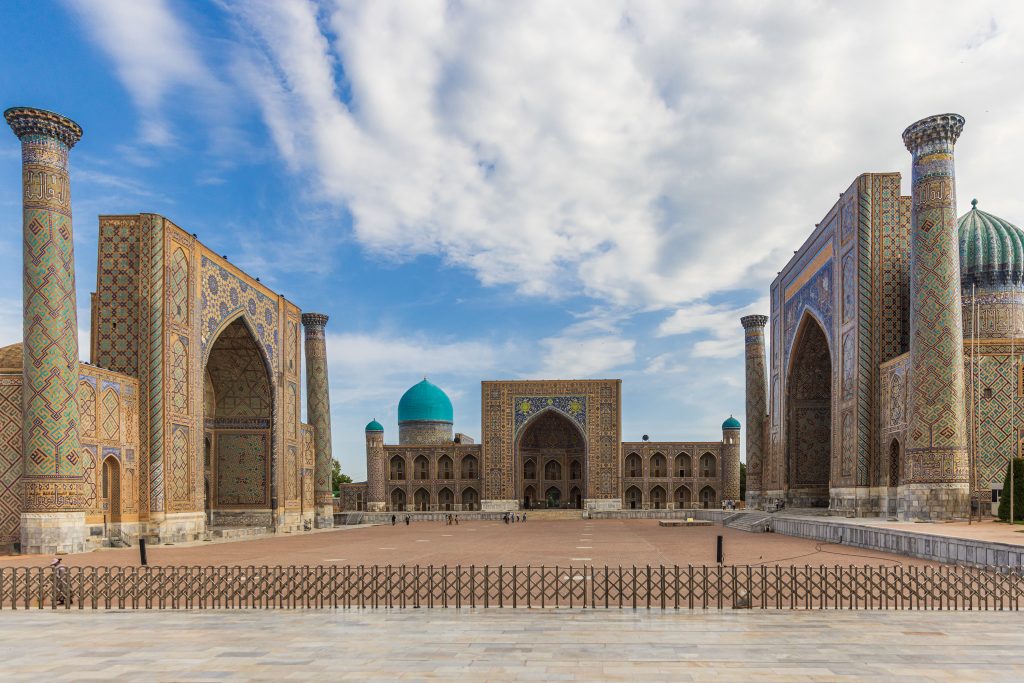
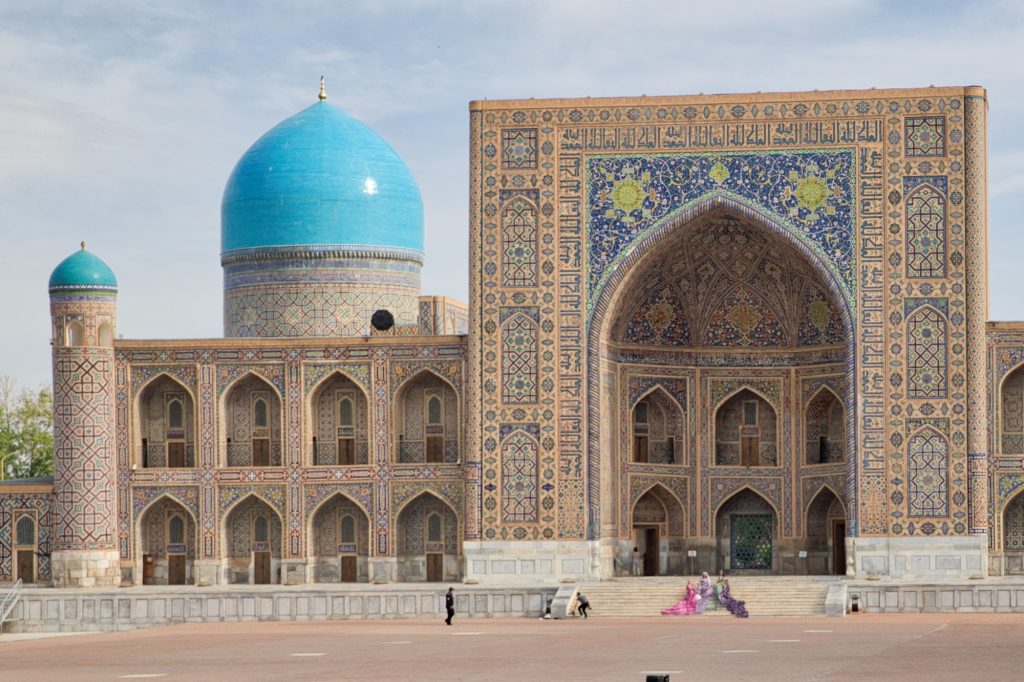
Mit knurrenden Magen kehrten wir zurück zum Gästehaus, wo ein sehr reichhaltiges Frühstück mit usbekischen Köstlichkeiten auf uns wartete. Somsas, lokales Brot, Marmeladen und Honig sowie verschiedene kleine Backwaren luden uns zum Naschen ein.
Der Plan für heute war, Samarkand hauptsächlich zu Fuß zu erkunden und dabei den Registan auszulassen, da wir bereits zweimal dort gewesen waren. Für den Abend hatten wir einen Tisch in einem nahegelegenen Restaurant mit einer tollen Dachterrasse reserviert, von der aus man die Rückseite des Registan überblicken kann. Also fuhren wir zunächst mit dem Auto zum Universitätsboulevard, einer usbekischen Version der Champs Elysées. Über 100 Meter breit, bot er nicht nur Platz für zwei Gehwege, zwei Fahrspuren in jede Richtung, vier Reihen von Bäumen, die zwei sandige Fußwege innerhalb der Fahrspuren trennten, sondern auch einen zentralen Paradeweg in der Mitte. Schöne alte Bäume spendeten Schatten vor der sich ankündigenden Hitze des Tages.
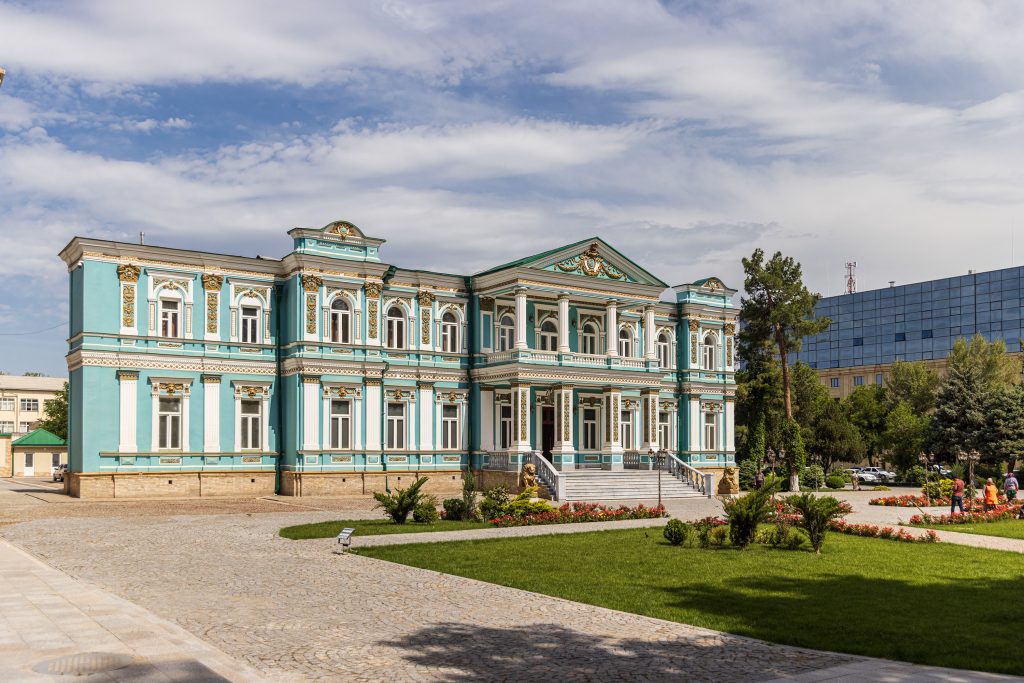
Wir schlenderten entlang des breiten Boulevards, vorbei an der Universität von Samarkand und einem prächtigen Gebäude, das an St. Petersburg erinnerte und für Konferenzen zwischen den zentralasiatischen Staaten genutzt wurde. Schließlich erreichten wir die Statue von Amir Timur, diesmal auf seinem Thron sitzend.
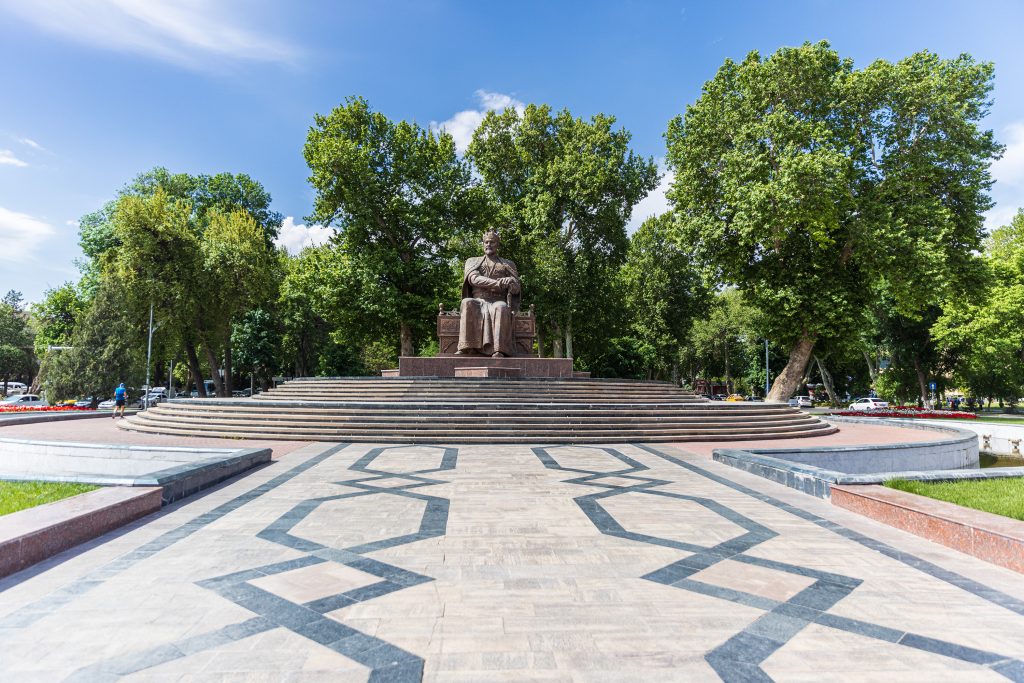
Es gibt drei solcher Statuen, die über Usbekistan verstreut sind: die Reiterstatue, die wir in Taschkent gesehen hatten, die sitzende Statue von Amir Timur in Samarkand auf seinem Thron und eine dritte stehende Statue in Shakhrizabz. Während wir dort waren, machten einige usbekische Studenten ihre Abschlussfotos mit Timur als Hintergrund und dabei kamen wir ein wenig mit ihnen ins Gespräch. Die Jugend hier scheint sehr engagiert und fast alle wollen eine zeitlang nach Europa kommen. Positiv fällt aber auch, dass die Meisten eine sehr gute Vorstellung davon haben, wohin sich ihr Land entwickeln sollte und sich dafür auch einsetzen. Und das obwohl die Regierung ja eigentlich eine milde Form der Diktatur ist. Die Verfassung Usbekistans ist übrigens auf Demokratie, Rechtsstaatlichkeit und Marktwirtschaft mit sozialen Garantien und Grundrechtsschutz ausgerichtet. Die praktische Umsetzung der Verfassung durch die Politik ist jedoch heftiger Kritik wegen mangelnder Rechtsstaatlichkeit und erheblicher Demokratiedefizite ausgesetzt. Wir sind gespannt, wohin sich das Land die nächsten Jahre entwickelt.
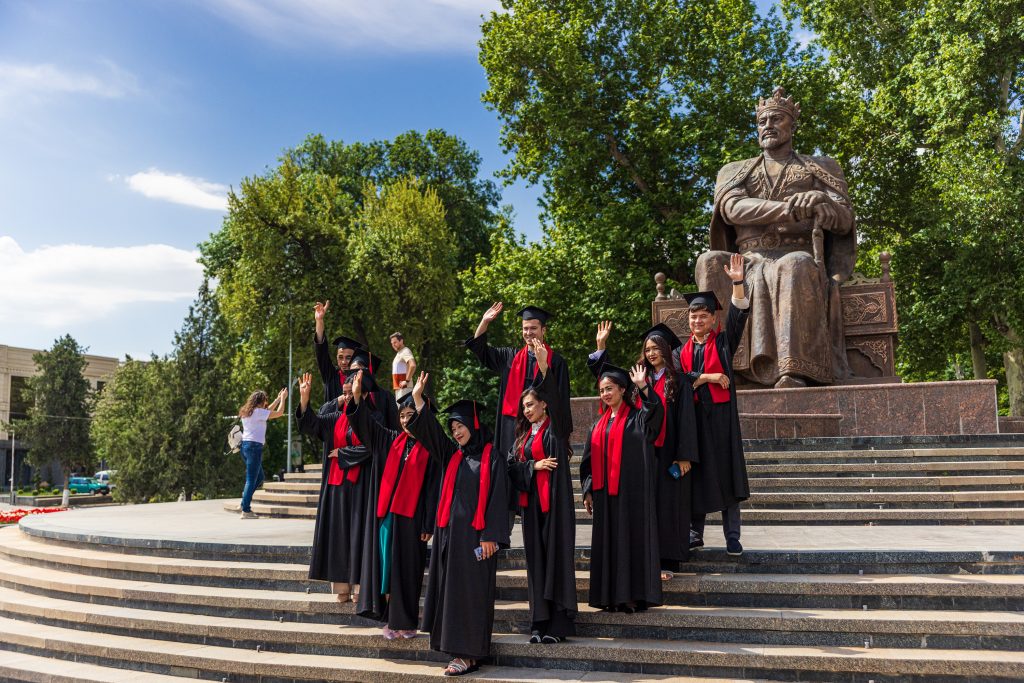
Direkt daneben befindet sich das Gur-e-Amir Mausoleum. Die Usbeken sind sehr angetan von ihren Mausoleen, und wir werden während unseres Aufenthalts hier viele davon besuchen. Das Gur-e-Amir ist die letzte Ruhestätte von Amir Timur, dem großen Herrscher, der während seines Lebens nie eine Schlacht verlor.
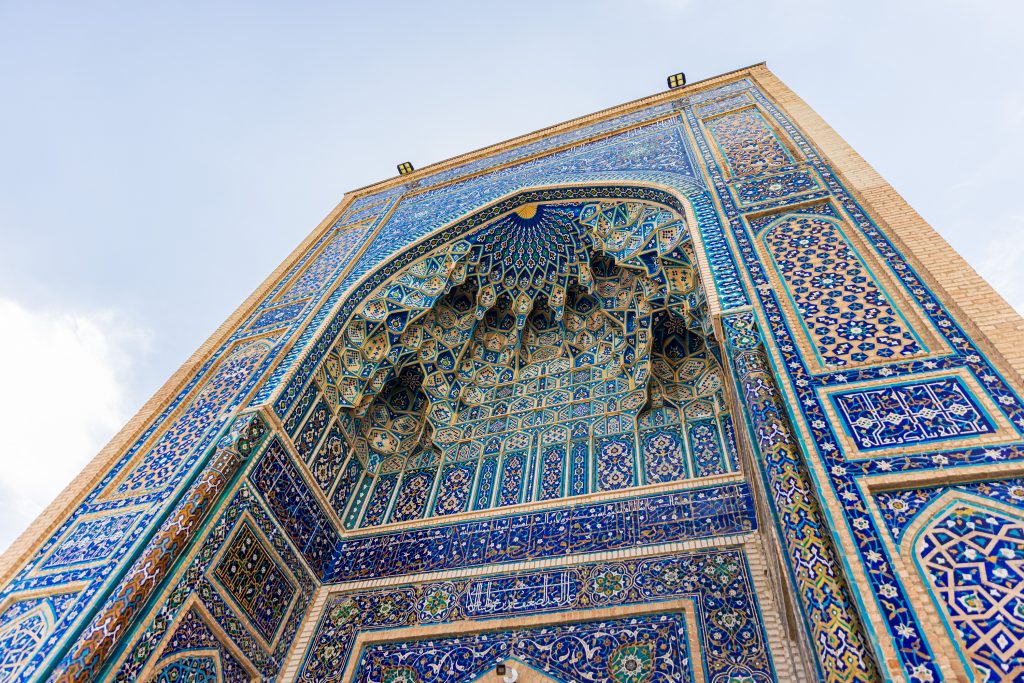
Er sollte nicht hier, sondern in seiner bergigen Heimatstadt Shakhrizabz begraben werden. Ursprünglich hatte er dieses Mausoleum für seinen Enkel und designierten Erben errichtet, der ein Jahr zuvor gestorben war. Aber es kam anders, und das Schicksal wollte es, dass Amir Timur im Winter an einer Lungenentzündung starb. Da die Bergpässe nach Shakhrizabz verschneit waren, war es unmöglich seinen Körper dorthin zu bringen. Daher entschied man sich stattdessen, ihn in Samarkand zu begraben.
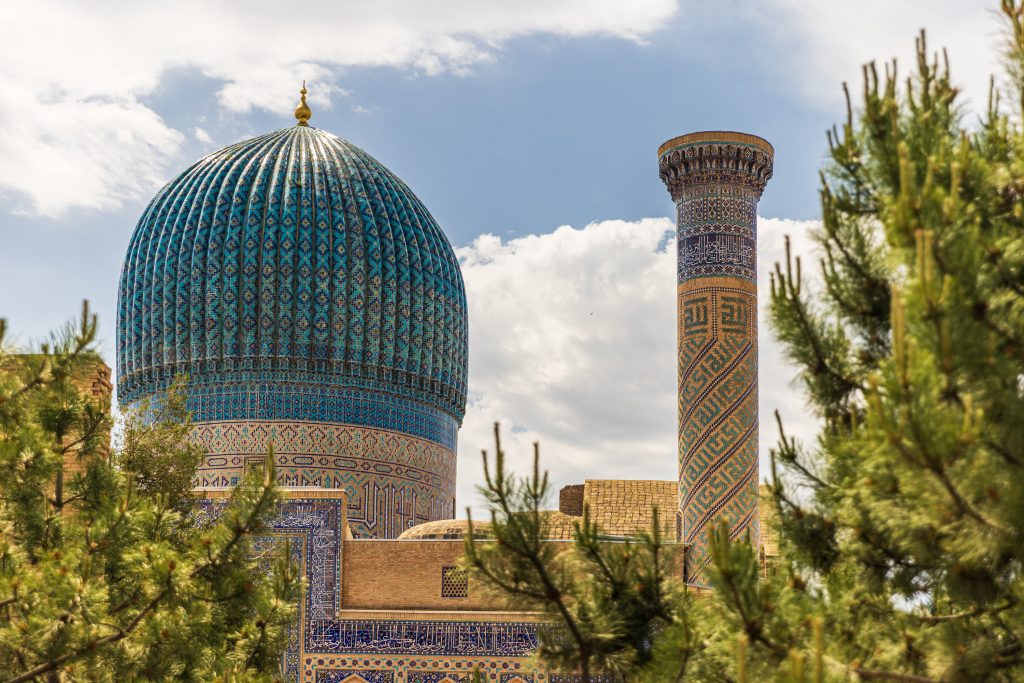
Das Mausoleum ist ein beeindruckender Komplex, nicht nur wegen der verschiedenen Grabmale im Inneren, sondern auch weil es früher eine Medresse und ein Gästehaus für reisende Händler beherbergte. Es hat ein sehr hübsches gefliestes und gewölbtes Dach und, wie die anderen Gebäude hier, aufwändige Mosaikarbeiten in Blautönen, die die Wände und Bögen der Denkmäler schmücken.
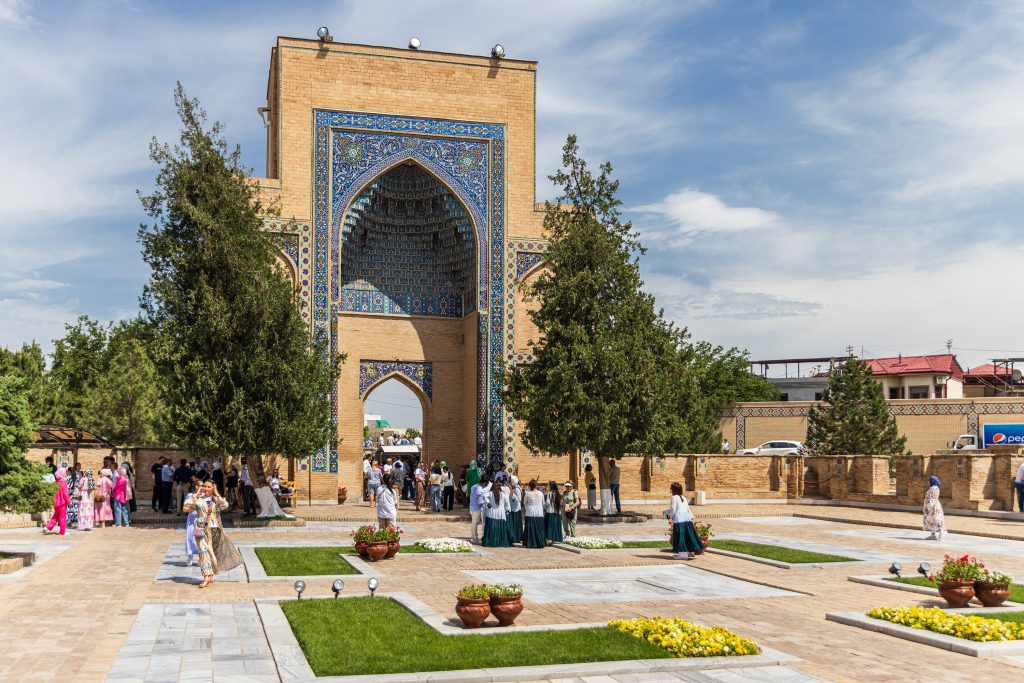
Ein einfacher schwarzer Marmorblock kennzeichnet Amir Timurs Grab in der Krypta. Da das Mausoleum ein beliebter Ort für Touristen ist, insbesondere solche aus Russland, fühlten wir, dass es Zeit war, uns auf den Weg zu unserem nächsten Ziel zu machen.
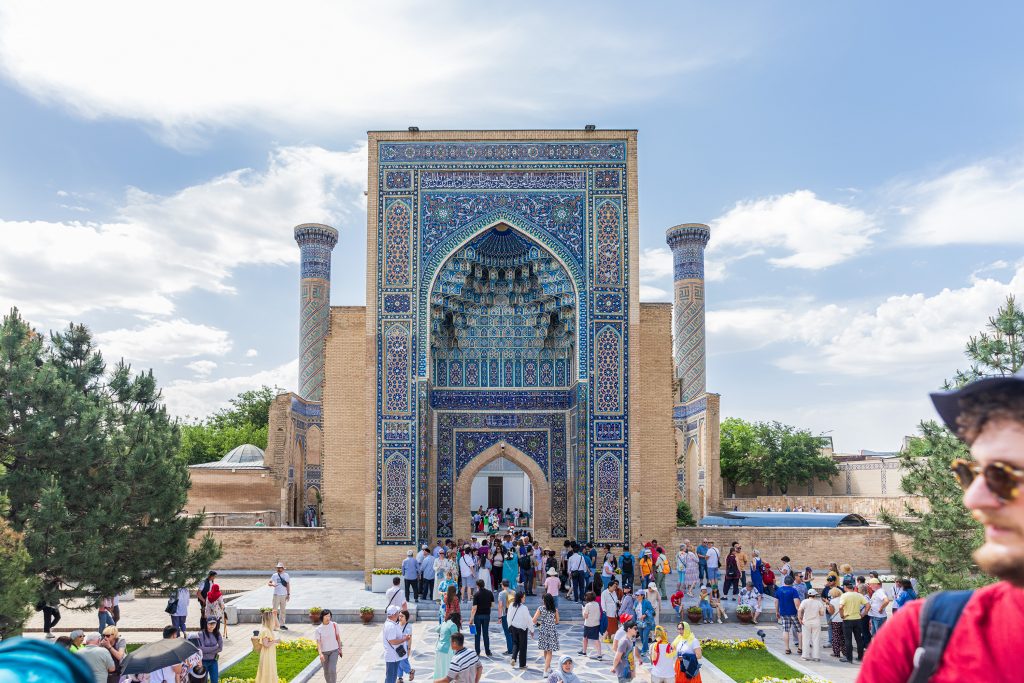
Um den Menschenmassen der Busstouren zu entkommen und gegen den Touristenstrom anzugehen, entschieden wir uns für eine Autofahrt quer durch die Stadt zur Nekropolis von Shah-i-Zinda, die am Nachmittag meist überlaufen ist, da es oft das letzte Ziel ihrer Tour ist.
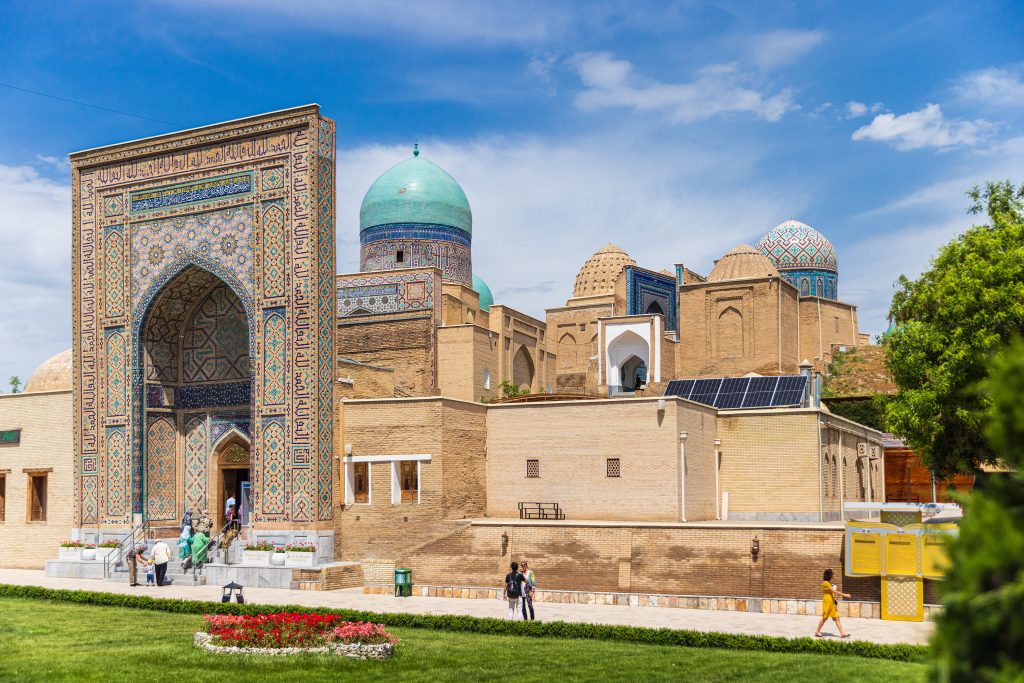
Shah-i-Zinda liegt auf einem Hügel, der als Friedhof dient, und kann am besten als Allee von Mausoleen beschrieben werden. Shah-i-Zinda bedeutet Grab des lebenden Königs.
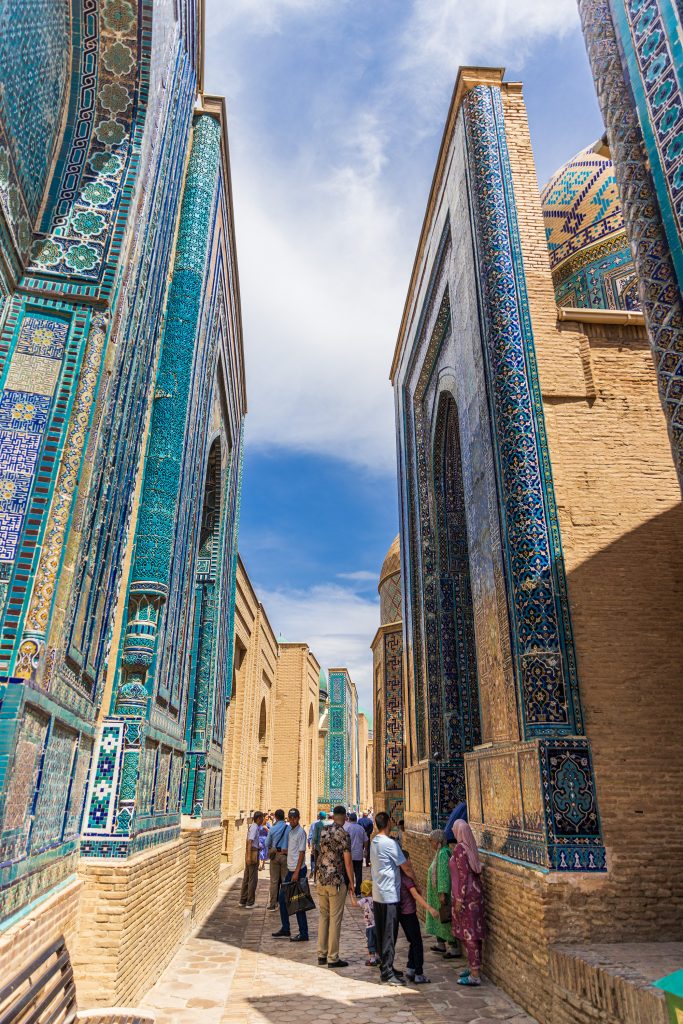
Der Schrein, reicht angeblich bis ins 7. Jahrhundert zurück und beherbergt das Grab des Königs Qusam ibn-Abbas. Dieser soll angeblich den Islam in diese Region gebracht haben. Die Mausoleen sind bekannt als beste Beispiele für Timuriden-Fliesenkunst aus dem 14. und 15. Jahrhundert.
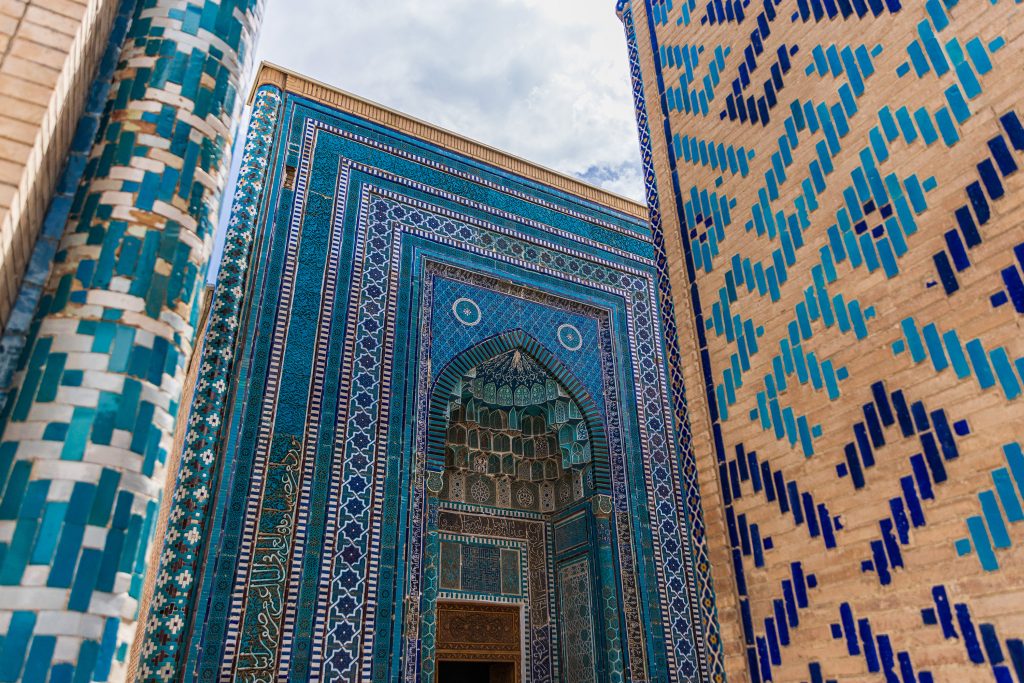
Mehrere Verwandte von Amir Timur, Ehefrauen und hochdekorierte Generäle sind hier begraben und haben ihre eigenen Mausoleen bekommen. Jedes besteht aus einer ziemlich großen Kammer, die meisten davon wunderschön mit verschiedenen Fliesenarbeiten dekoriert – innen und außen.
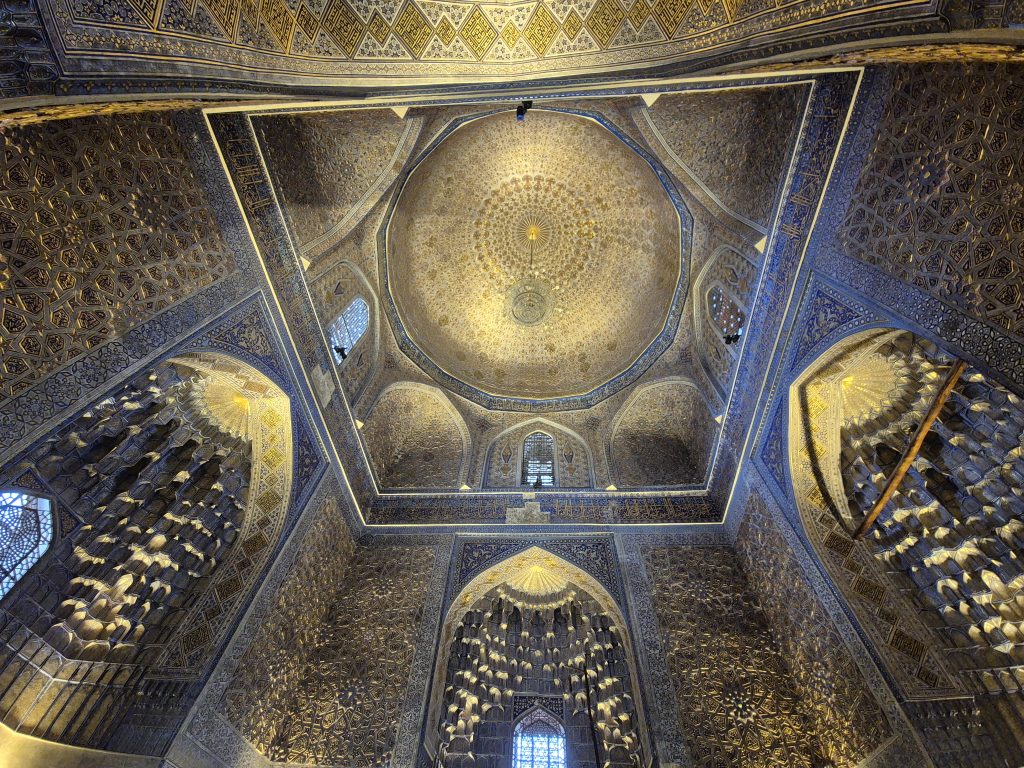
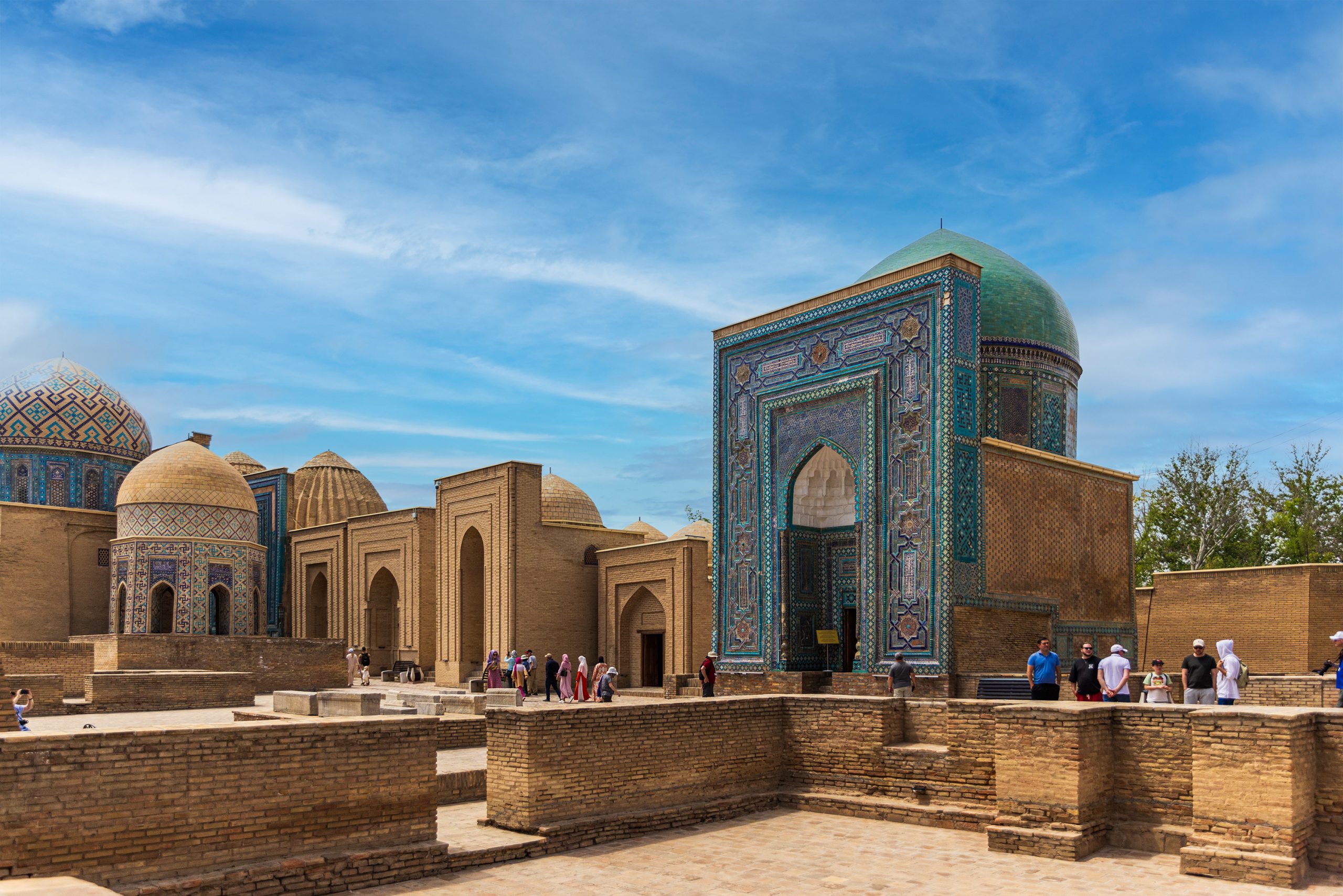
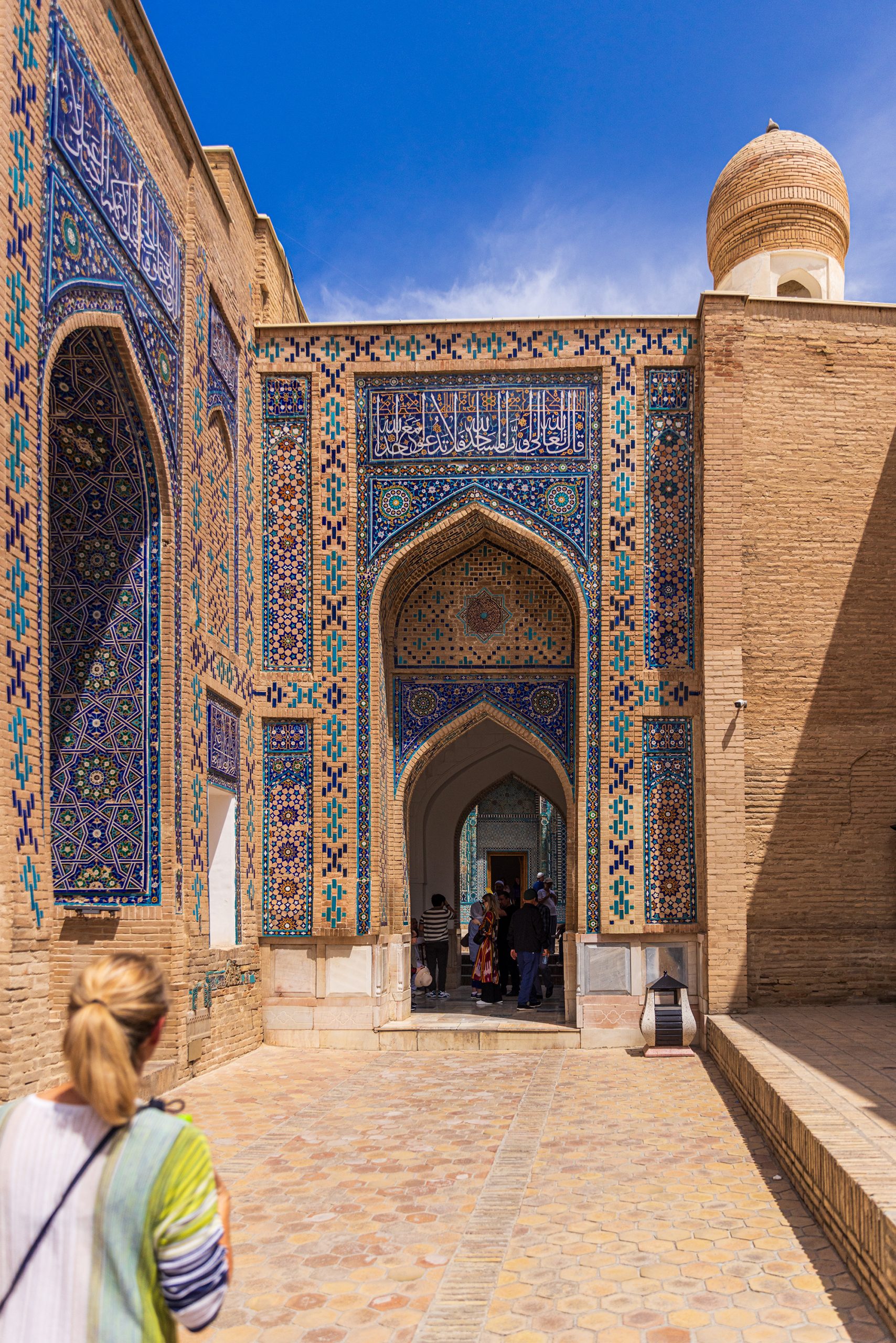
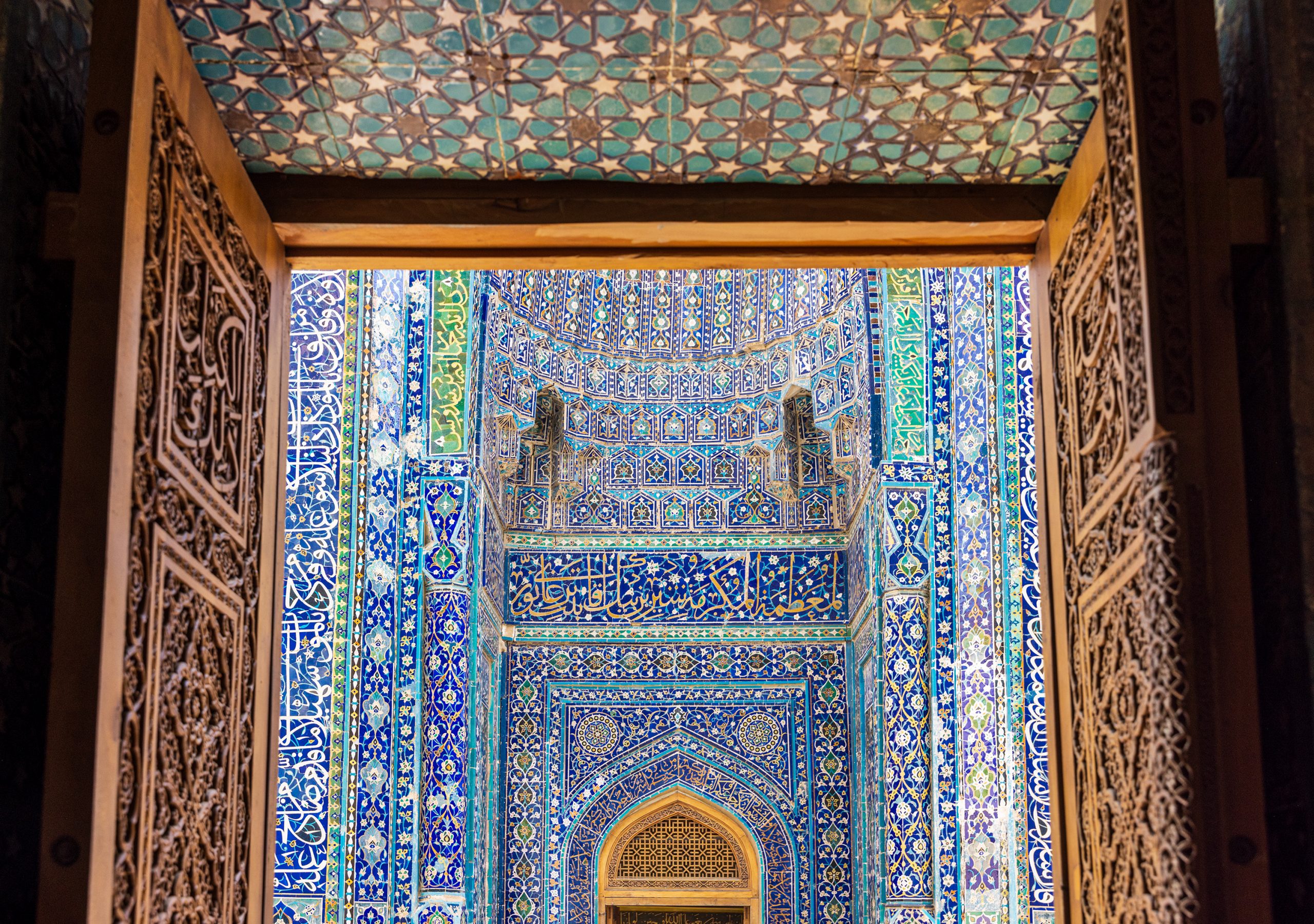
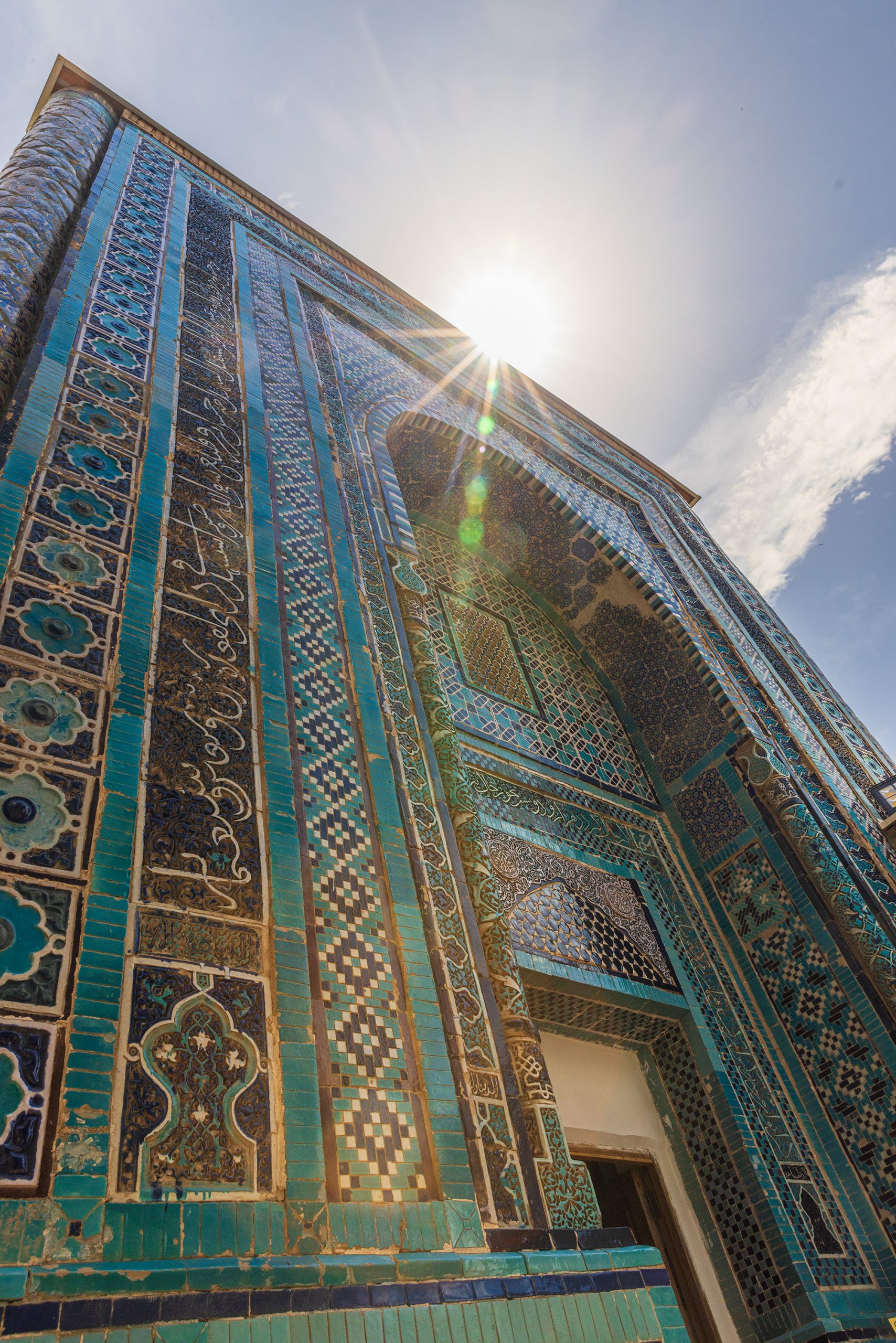
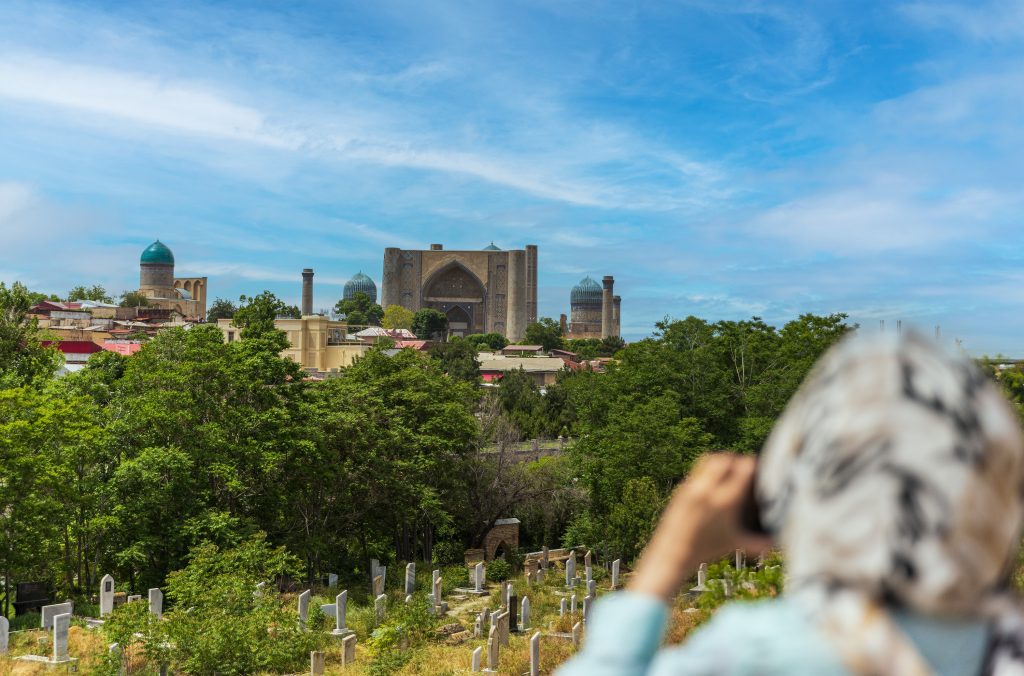
Nach dem Besuch der Nekropole, beschlossen wir, dass es Zeit für ein leichtes Mittagessen war, obligatorischer Tomatensalat inklusive. Schließlich bekam Esther ihre Gemüsesomsas, die sehr ähnlich wie indische Gemüsesamosas schmeckten. Nicht aufregend, aber einfaches und nahrhaftes Essen. Chris hatte Beef-Shashlik, dieses Mal war es nur Rindfleisch, das nicht gleichzeitig in Schafsfett getaucht war. Dafür war es in Essig getränkt. Was aber Chris’ Geschmack durchaus entgegenkam.
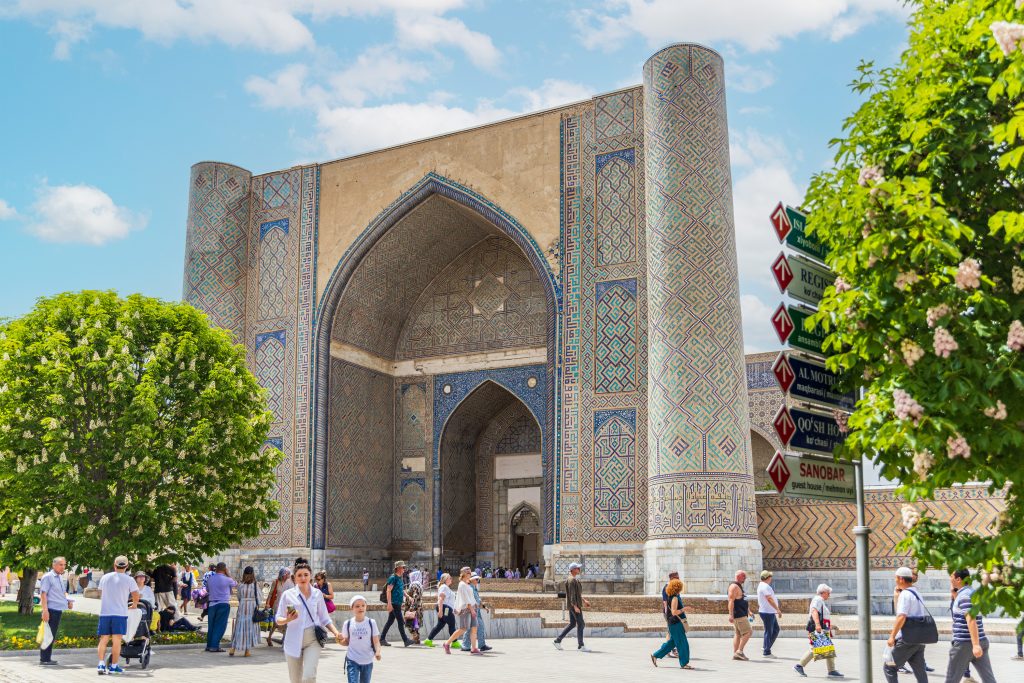
Nach dem Mittagessen schlenderten wir zur bedeutendsten Moschee in Samarkand, der Bibi Khanym Moschee. Timur errichtete sie mit Hilfe seines Beuteguts, das er bei der Invasion Indiens erbeutet hatte. Die Moschee wurde nach seinen Vorstellungen gebaut. Jeder sollte seine Größe sehen und erkennen. Mit über 40 Metern Höhe war sie eine der größten Moscheen ihrer Zeit. Zuerst führt ein großes Eingangsportal mit zwei runden Minarettürmen in einen großen Hof. Der Komplex beherbergt zwei kleinere Moscheen auf der rechten und linken Seite, eine für den Sommer und eine für den Winter, da in früheren Zeiten nur eine beheizt wurde. Die vierte Seite wurde von der Hauptmoschee eingenommen, flankiert von zwei sechseckigen Minarettürmen.
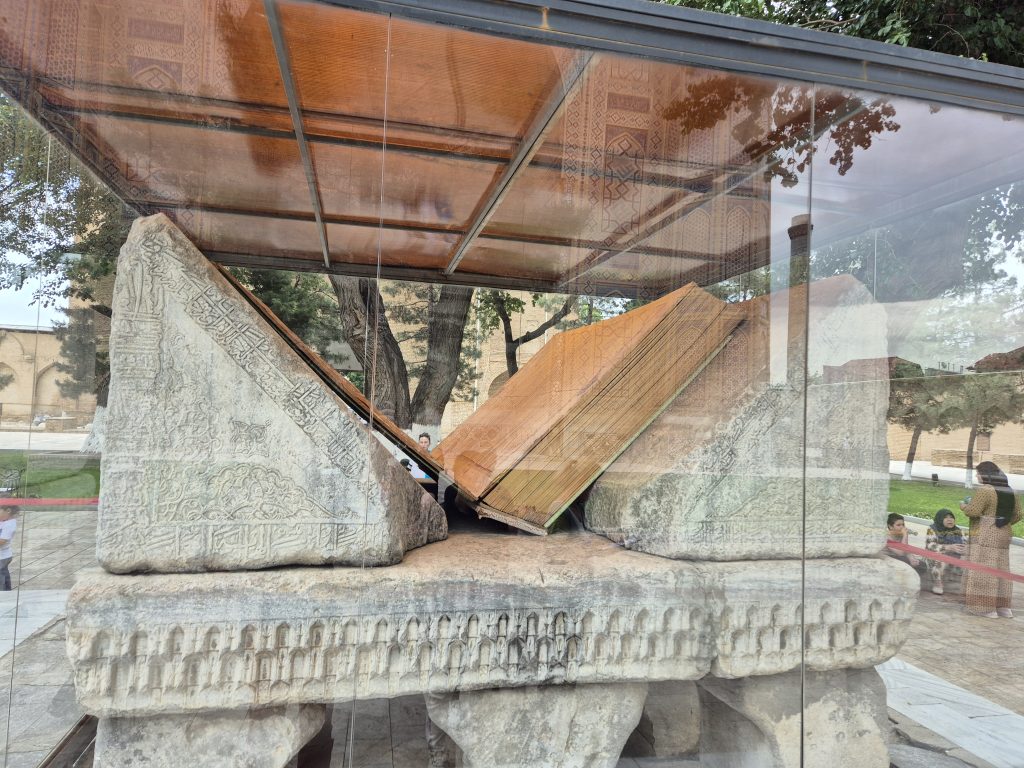
Ein Erdbeben im Jahr 1897 ließ die Moschee teilweise einstürzen. Sie wurde in den 1970er Jahren restauriert, aber dennoch bleibt der Hauptgebetsraum aufgrund großer Risse und mangelnder Mittel für eine ordnungsgemäße Renovierung für die Öffentlichkeit geschlossen. Dennoch ist sie ein beeindruckendes Denkmal für Timurs Herrschaft.
Bevor wir zurück zu unserem Gästehaus fuhren, hatten wir noch einen weiteren Zwischenstop eingeplant: den Siob-Basar neben der Moschee. Es ist der größte Basar in Samarkand und ähnlich wie der Chorsu-Basar in Tashkent verfügt er über die üblichen Bereiche für Gewürze, frisches Obst und Gemüse, Fleisch, Eier, Backwaren, Haushaltswaren, Textilien und Pflanzen. Wir lieben die Gerüche, die uns in den verschiedenen Bereichen umgaben.
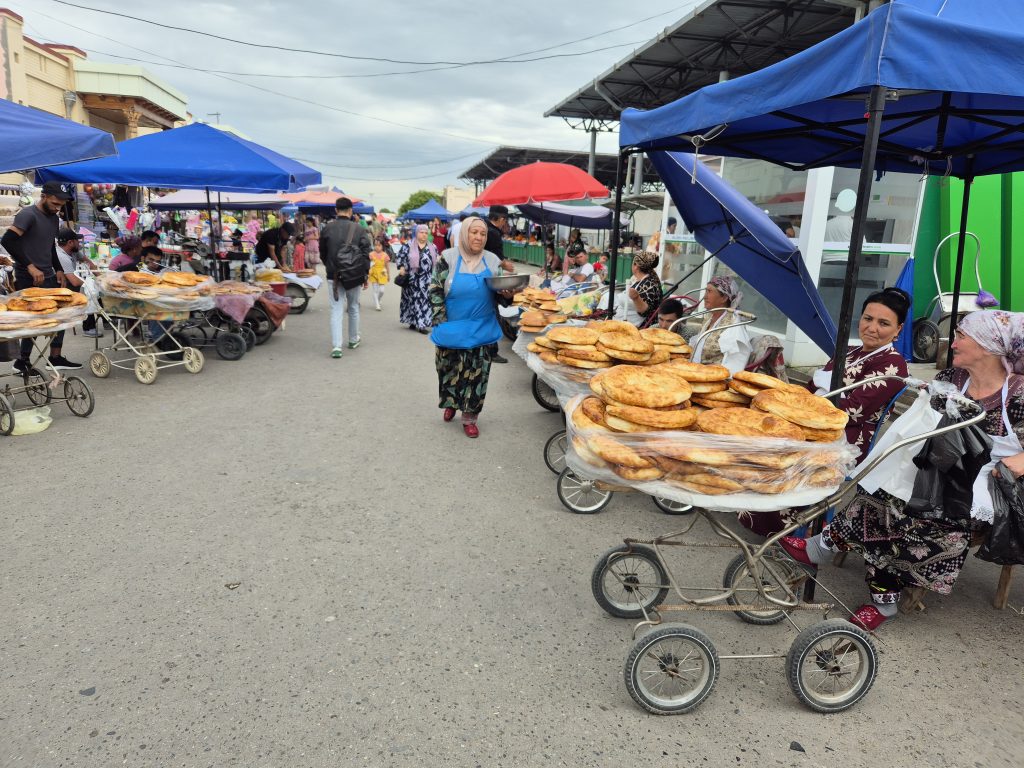
Chris hat eine Handvoll lokaler Tomatensamen erworben, die wir zu Hause pflanzen werden, in der Hoffnung, dass sie genauso geschmackvoll sein werden wie die Tomaten hier. Der Geschmack ist einfach köstlich, voller Aroma, nicht vergleichbar mit denen zu Hause. Esther widmete sich noch dem Shopping, da echte Seidentextilien hier ein Schnäppchen sind. Unsere jungen studentischen Führer hatten viel Spaß daran, uns beim Feilschen zuzusehen, denn ein deutsches “Nein!” ist leicht zu verstehen, und wir fanden, dass wir mindestens einen 50%igen Rabatt vom ersten Preis bekommen sollten, der uns genannt worden war. Es gab viele “Neins”, als die Händler nur wenig nachgaben, bis auch wir ein wenig nachgaben, und das war es dann. Esther verließ den Laden wege einem Euro Unterschied, wurde aber zurückgerufen, um den Verkauf zu ihrem vereinbarten Preis abzuschließen. Es war für die Händlerin trotzdem ein gutes Geschäft, dessen waren wir uns sicher. Ein bisschen Feilschen macht aber immer wieder Spaß.
Unseren Durst löschten wir mit frisch gepresstem Orangen- und Granatapfelsaft und machten uns dann auf den Rückweg zu unserem Gästehaus. Da es gegen Mitte des Nachmittags mit 30°C ziemlich warm geworden war, wollten wir uns ein wenig ausruhen. Chris hatte noch einen geschäftlichen Teams-Call zu tätigen, und bevor wir zum Abendessen auf die Dachterrasse gingen, kamen wir wieder am Registan-Platz vorbei, der wieder in einem ganz anderen Licht erstrahlte als die letzten beiden Male.
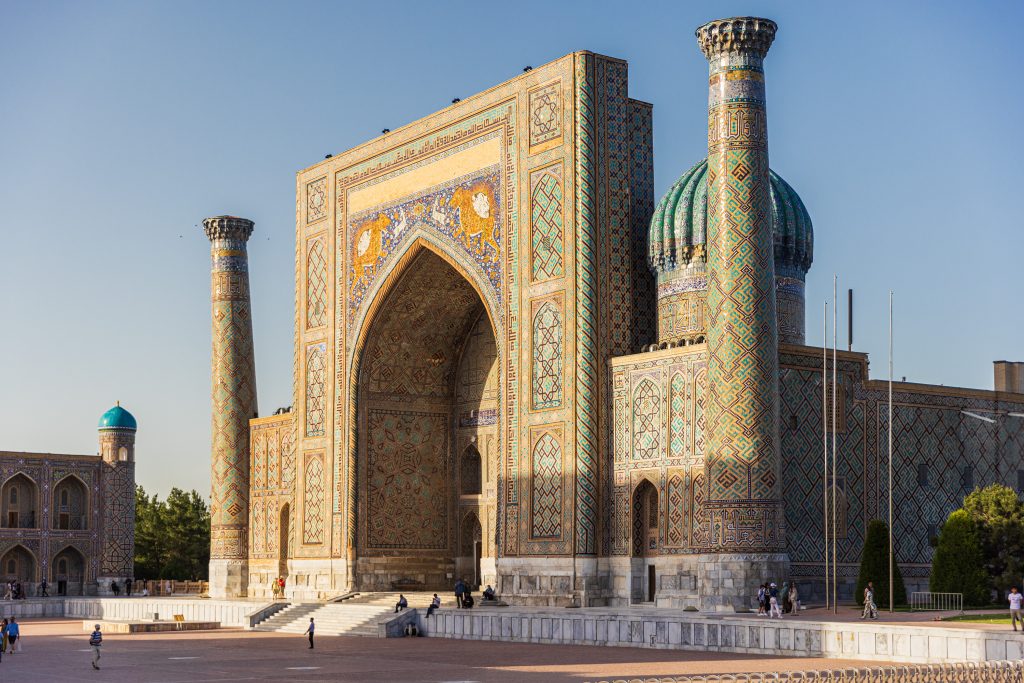
Nach einem wundervollen Abendessen gingen wir früh schlafen, da wir uns am nächsten Morgen früh auf den Weg in die Nuratau-Berge machen wollten.
Weiter zu Tag 9
Today we rose early and were at Registan square before 8 AM already. The sun rises at 5.30 AM so it was well past sunrise, but nevertheless there were no people on Registan square at 8 AM. We had the place to ourselves. Unfortunatly no coffee either, so we just sat there , took pictures and marvelled at the different light in the early morning setting a different tone from yesterday again. It is one of those sights that puts you in awe every time, regardless how often you see it.


Getting hungry we headed back to the guesthouse for a very well lined up breakfast of Uzbek delicacies. Somsas, local bread, jams and honey as well as various little bakery items invited us to taste them.
The plan for today was to explore Samarkand mainly on foot, skipping Registan as we had been there twice already. For the evening we had reserved a table at nearby restaurant with a great rooftop terrace, overlooking the back side of Registan. So we started with a quick car ride to University boulevard, an Uzbek version of the Champs Elysées. Over 100 m wide they not only cater to two side walks, two lanes of car traffic each way, four lines of trees, separating two sandy walking paths inside the car lanes as well as a central concrete parade walk way in the very middle. Beautiful old trees provided shade from the oncoming daytime heat.

We strolled along the wide boulevard, passing by the Samarkand University and a grand building reminiscent of St. Petersburg, which was used for conferences among the Central Asian states. Eventually, we reached the seated statue of Amir Timur.

There are three such statues scattered across Uzbekistan: the equestrian one we had seen in Tashkent, the seated Amir Timur in Samarkand on his throne, and a third standing statue in Shakhrizabz. While we were there, some Uzbek students took their graduation photos with Timur as backdrop and engaged in conversation with us.

Right next to it was the Gur-e-Amir Mausoleum. Uzbeks are very fond of their Mausoleums and we will see plenty of them while being here. Here is the final resting place of Amir Timur, the great ruler who never lost a battle during his lifetime.

He was not supposed to be buried here but in his mountainous home town of Shakhrizabz. He built this Mausoleum originally for his grandson and proposed heir who had died a year earlier, but it came otherwise and fate would have it that Amir Timur died of pneumonia in the winter and the mountain passes to bring his body back to Shakhrizabz were showed in. They decided to bury him in Samarkand instead.

The mausoleum is an impressive complex not only because of the several grave markers inside, also they used to house a Medrassa and an ancient guest house for traveling merchants. It has a very pretty tiled and domed roof and like the other buildings here intricate blue time mosaic work decorating the walls and arches of the monuments.

A plain black marble marker marks Amir Timurs grave in the crypt beneath. As the Mausoleum was a popular spot with tourists, particularly from Russia as we discovered, we felt it was time to move on to our next destination.

To avoid the crowds from the buses and to go against the tourist flow, we opted for a car ride across town to the Necropolis of Shah-i-Zinda, which tends to have the highest number of visitors in the afternoon, as it is often the endpoint of their tour.

Shah-i-Zinda lies on top of a hill that serves as a cemetery and can be best described as an avenue of Mausloeums. Shah-i-Zinda means Tomb of the Living King.

A shrine that is said to date back to the 7th century housing the grave of king Qusam ibn-Abbas, who is said to have brought Islam to this region originally. The Mausleums are known for the best examples of Timurid-aera tilework of the 14th and 15th century.

Several of Amir Timurs relatives, wives and highly decorated generals are buried here and gotten their own Mausoleums. Each consisting of a fairly large chamber, most of the beautifully decorated with different tilework – inside and outside.






When we had visited the necropolis, we decided it was time for a light lunch, obligatory tomato salad included and finally Esther got her vegetable somsas which tasted very similar to Indian vegetable samosas. Nothing exciting but simple and nourishing food. Chris had beef Shashlik, this time it was just beef that was not coated in sheeps fat at the same time.

After lunch we wandered to the most important and historic mosque in Samarkand, the Bibi Khanym Mosque. Timur built it with his spoils he got when invading India and this was his signature mosque that he wanted everyone to see and recognize his grandeur. Over 40 meters tall, it was one of the biggest mosques of the time. First a big entrance portal with two round minaret towers led into a large courtyard. The complex house two smaller mosques on the right and left hand sides and one for summer, one for winter, as only one was heated at the time. The fourth side was taken up by the main mosque flanked by two hexagonal minaret towers.

An earthquake in 1897 made the mosque collaps partially. It was restored in the 1970s but nevertheless the main prayer room remains closed to the public due to big cracks and lack of funds to renovate the rest of it properly. Nevertehless it is an impressive monument to Timur‘s reign.
We had one more stop planned before heading back to our guest house: the Siob Bazaar next door to the mosque. It is Samarkands largest bazaar and like Chorsu Bazaar in Tashkent, it has the usual sections for spices, fresh fruit and vegetables, meat, eggs bakery items, household goods, textiles and plants. We love the smell wafting around us of the different sections.

Chris acquired a bunch of local tomato seeds that we’ll be planting at home, hoping they’ll be as flavorful as the tomatoes here. The taste of the tomatoes here is simply delightful, bursting with aroma, incomparable to those at home. Esther did some textile shopping as real silk textiles are a bargain here. Our young student guides had a blast watching us haggle as a German „Nein!“ is easy to understand and we felt we should get at least a 50% discount from the first price they told to us. There was a lot of „Neins“ when the merchants only came down little by little until we gave a little too and that was it. Esther walked out of a shop over one Euro difference but was called back to finish the sale at her agreed price. It still was a good deal for the merchant we were sure. A bit of haggling is always fun.
We quenched our thirst with freshly squeezed orange and grenadine juice and headed back to our guest house from there. As it was quite warm by mid afternoon, low 30°C. We wanted to rest up a bit. Chris had a business call – and before heading out to our dinner on the roof top terrace we once again passing by Registan square at a different light.

After a wonderful dinner we turned in early as we‘ll be leaving for Nuratau Mountains in the morning.
Heute haben wir uns von Taschkent verabschiedet und uns nach Samarkand aufgemacht. Weil Inom sich noch um andere Kunden kümmern muss, haben wir für zwei Tage einen Ersatzführer bekommen. Leider gestaltete sich die Kommunikation schwierig, da wir kein Usbekisch und nicht genug Russisch sprechen. Sherbat wiederum spricht, wider erwarten nicht besonders viel Englisch. Das machte die Kommunikation, gelinde gesagt, herausfordernd.
Auf der Fahrt von Taschkent nach Samarkand gab es nicht viel zu sehen, nur einige Störche und viele Felder. Wobei uns immer wieder auffällt, dass Usebkistan alles in allem sehr sauber und aufgeräumt wirkt.
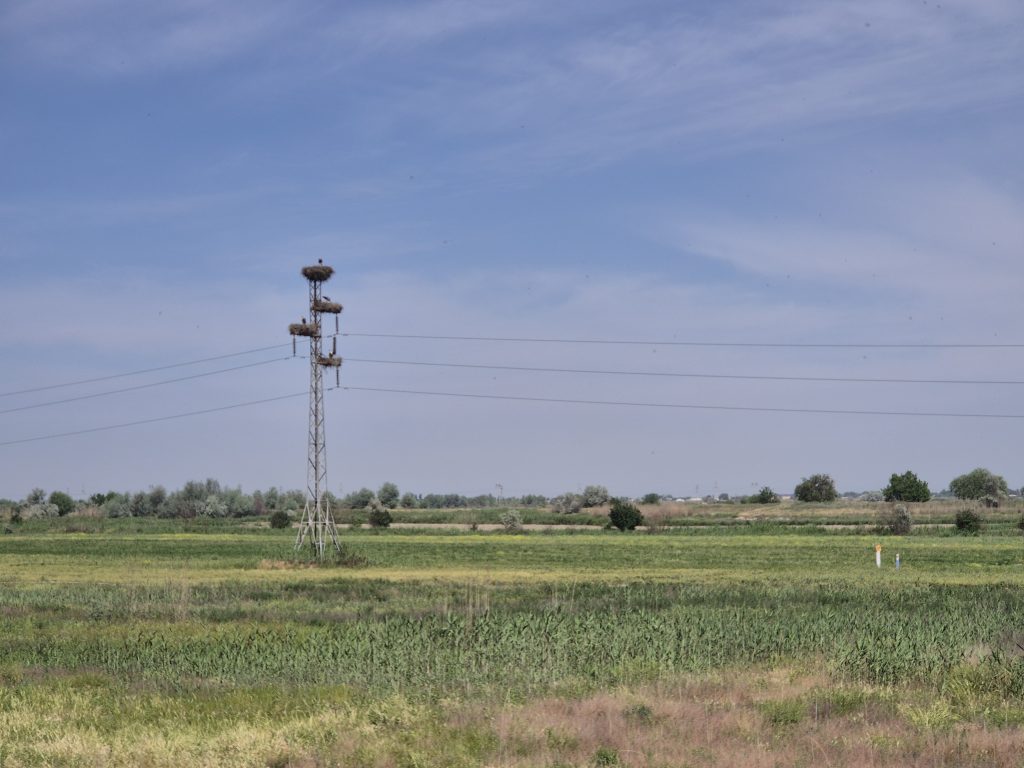
Nach einer langen, sechsstündigen Fahrt mit einigen Umwegen hatten wir ein leckeres Mittagessen in einem kleinen Straßencafé, wo wir allerlei Salate und Borschtsch (ukrainische Rote Bete Suppe) gegessen haben, sowie das beste Brot, das wir bisher in Usbekistan hatten. Es war noch warm und mit einer Art saftigen Blätterteig mit viel Butter gebacken. In gewisser Weise erinnerte es Chris an ein riesiges französisches Croissant. Weniger süß, aber gleiche Textur. Es scheint aber, dass wer vegetarisch essen möchte in den meisten traditionellen Gaststätten auf Salate zurückgreifen muss. Aber hier waren sie zumindest sehr gut. Wir durften auch eine lokale Spezialität probieren: eingelegte Bergzwiebeln.
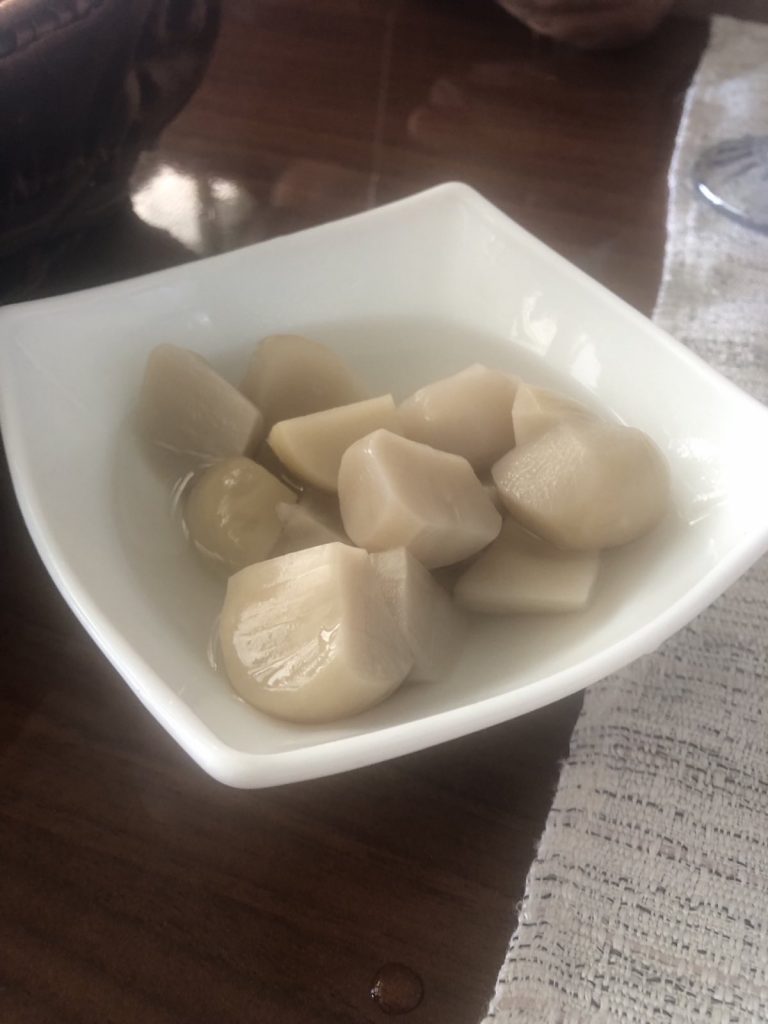
Bissfest und knackig schmeckten sie wirklich sehr lecker. Der Gesamtpreis für uns drei inklusive Getränke betrug nur 12 Euro. Definitiv das Geld wert.
Wir nahmen das restliche Brot für später mit und machten uns auf den Weg in das eigentliche Samarkand.

Samarkand steht als Synonym für die Seidenstraße. Es ist eine von zwei usbekischen Städten, an denen sich die Handelsrouten kreuzten. Eine nördliche Route durch das heutige Kirgisistan und eine südliche Route durch das heutige Tadschikistan. Beide führen von China nach Bagdad, aber je nach Saision, Wetter und Gefahrenlage nahmen die Händler die eine oder die andere Route. Samarkand und Buchara sind die beiden Städte, an denen die Routen jeweils zusammentreffen. Die Bedeutung der Seidenstraße und die Reichtümer die hier umgesetzt wurden spiegelt sich in den beeindruckenden architektonischen Bauwerken, die noch heute, Jahrhunderte später, erhalten sind.
Schließlich erreichten wir unserer gemütliche kleinen Pension in Samarkand.
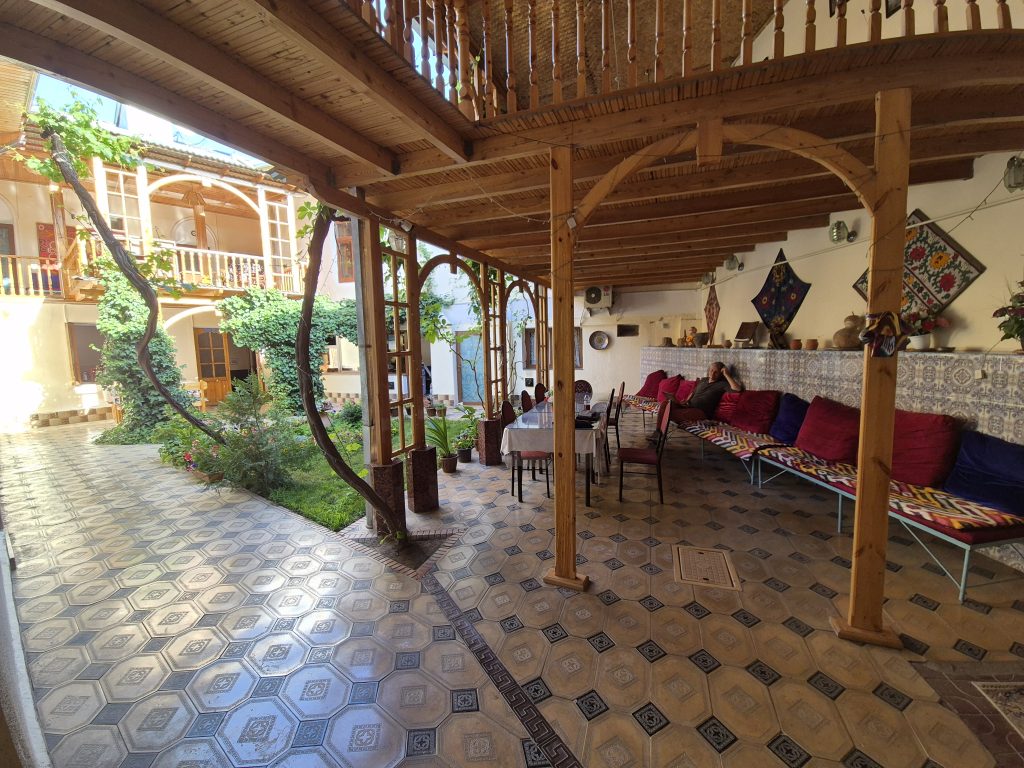
Das Jahongir-Gästehaus liegt mitten in der Altstadt von Samarkand und ist nur 500 m Fußmarsch von der Hauptattraktion, dem Registan-Platz mit seinen drei monumentalen und beeindruckenden Gebäuden, entfernt. Nach dem Einchecken entschieden wir uns, alleine umherzustreifen um Samarkand zu Fuß zu erkunden.
Wir schlenderten zunächst gemütlich zum Registan-Platz. Wenn man ihn zum ersten Mal vor ihm steht, ist er genauso beeindruckend wie das Taj Mahal.
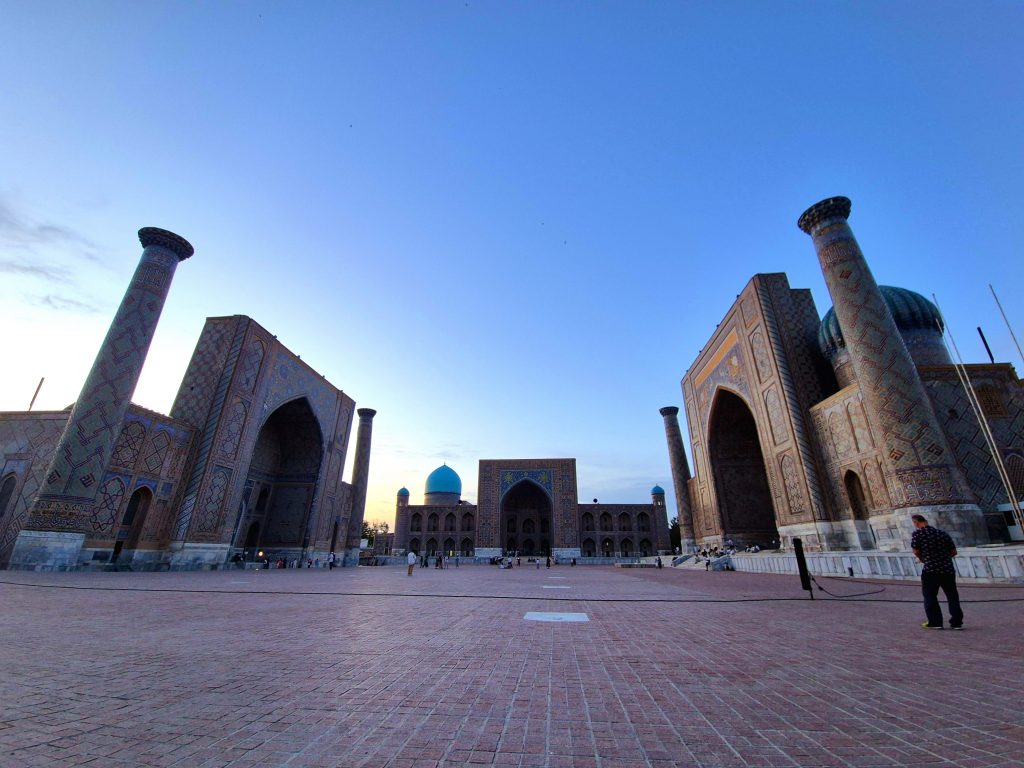
Registan kommt aus dem Persischen und bedeutet ‘sandiger Platz’ oder ‘Wüste’ und war ein Zentrum für Bildung und Handel. Warum Sand? Weil die Karawanen hier mit ihren Eseln, Kamelen und Pferden ihre Zelte aufschlugen. Und auf Sand war das ganze leichter sauber zu halten. Der Registan war zugleich auch ein öffentlicher Platz, auf dem sich die Menschen versammelten, um königliche Proklamationen zu hören, die mit lauten Tröten auf riesigen Kupferhörnern namensDzharchis angekündigt wurden. Hier wurden aber auch öffentliche Hinrichtungen vollzogen.
Drei Medresen flankieren den Platz auf drei Seiten, die vierte Seite ist offen. Während die Händlerkarawanen Rast machten verwandelte sich der Platz in eienn großen Basar. Heute ist die Fläche aber gepflastert, während viele der Studienräume in den Medresen in kleine Touristen- und Handwerksläden umgewandelt wurden.
Während der Zahn der Zeit diesen Gebäuden arg zugesetzt hatte, haben sich die Sowjets während ihrer Herrschaft tatsächlich bemüht den Registan in seinen alten Glanz zurückzuversetzen. Überall sind bunte Fliesen, Mosaike und Kunstwerke zu sehen. Die Gebäude wirken eher wie Paläste als wie islamische Schulen. Jedes der drei Gebäude sieht etwas anders aus.
Das älteste ist die Ulugbek-Medrese, erbaut im Jahr 1420, und sie war der Erforschung von Wissenschaften wie Astronomie und Mathematik gewidmet.
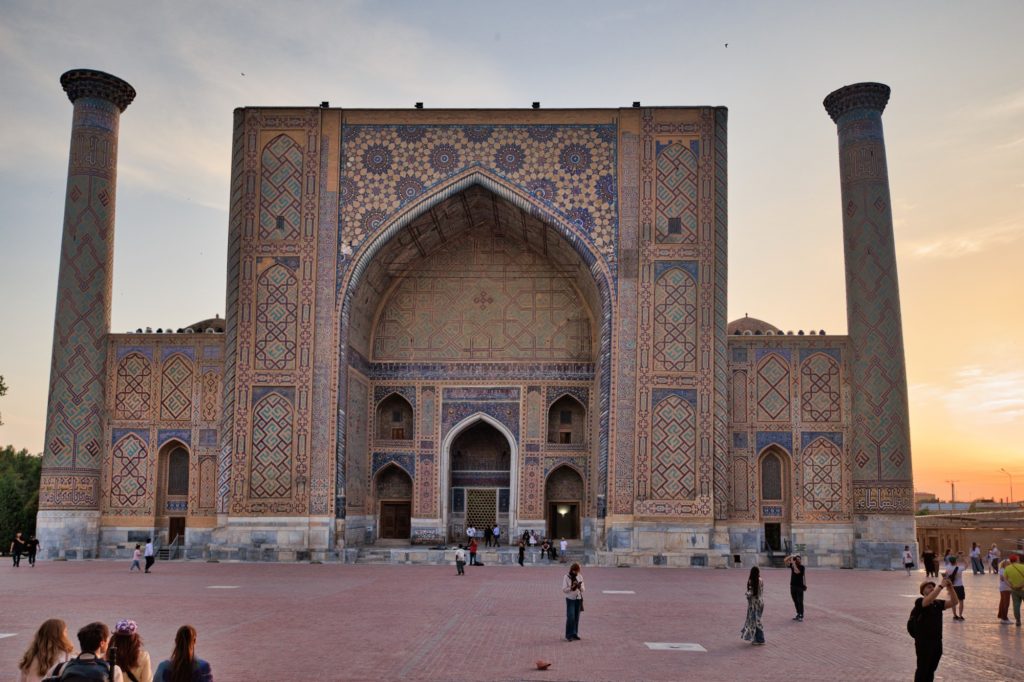
Sie verfügt über einen schönen baumbestandenen Innenhof und zwei Ebenen von Studienräumen. Versteckt in einem der Eingänge befindet sich eine kleine Holztür.
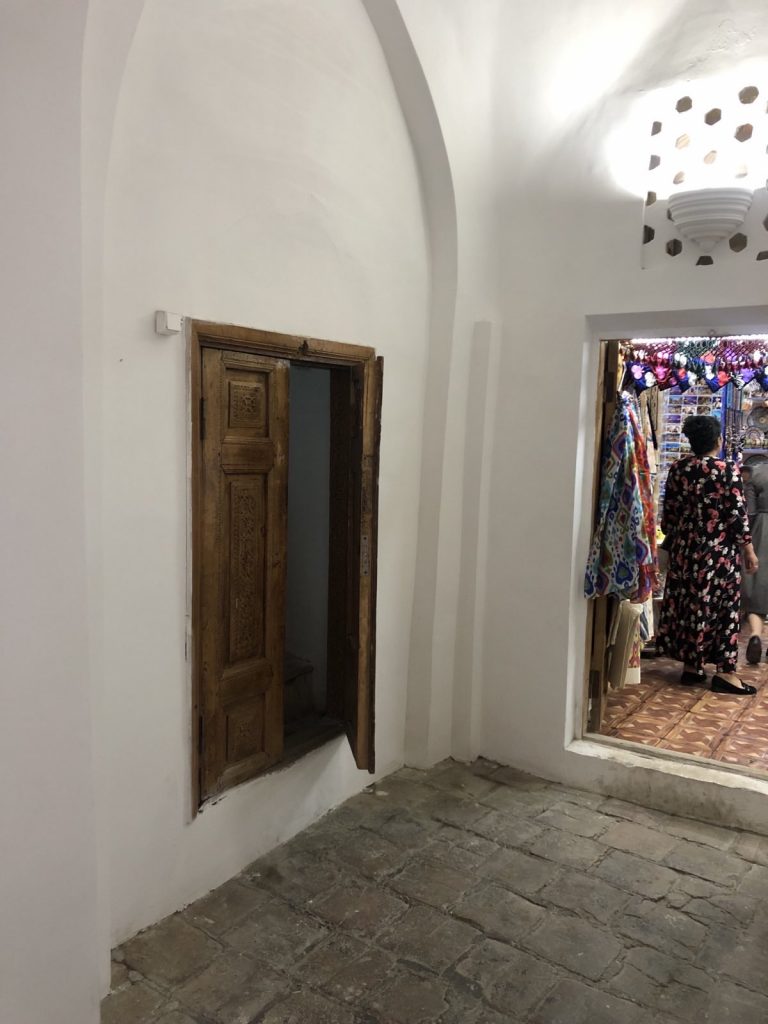
Für Insider ist dies der Eingang zu einem der Minarettürme. Chris schaffte es, ‘ein Ticket’ für den Zugang zu kaufen. Eigentlich ist es eher ein verkapptes Bestechungsgeld und nur zum Schein wird etwas in ein Schulheft gekritzelt. Es wird auch immer nur eine Person hochgelassen, weil die Treppe steil und sehr eng und der Platz oben sehr begrenzt ist.
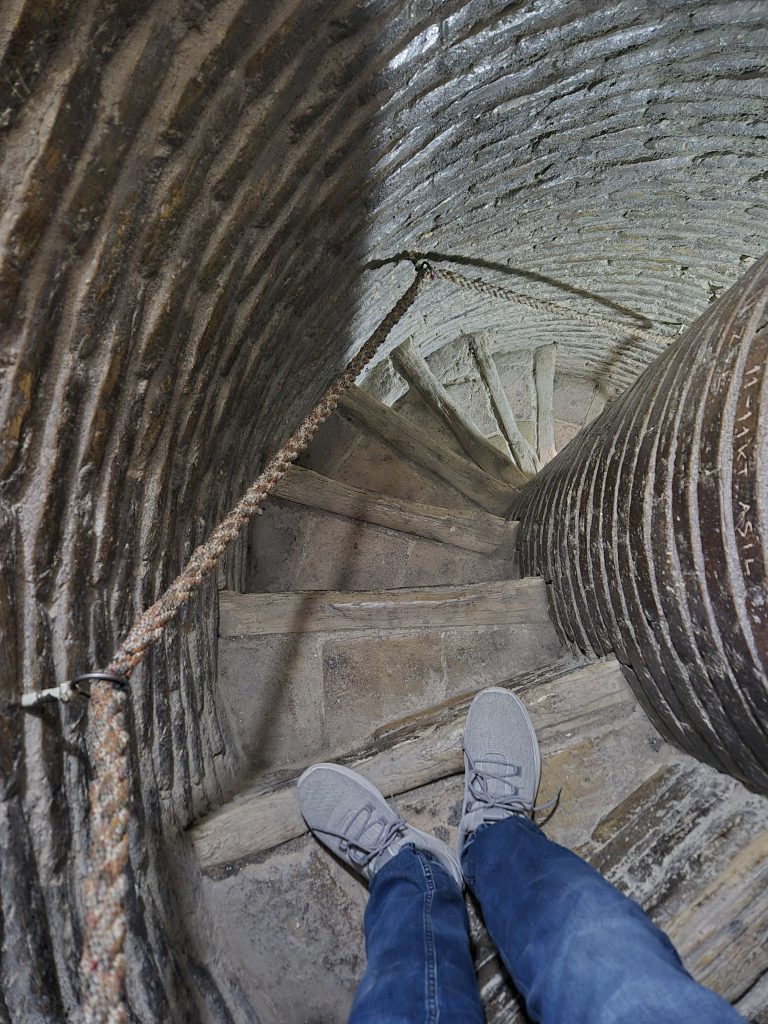
Wer unter Klaustrophobie oder Höhenangst leidet, sollte sich dieser Herausforderung lieber nicht stellen. Der Lohn für die Mühen ist aber ein großartiger Panoramablick über den gesamten Platz und die Stadt.
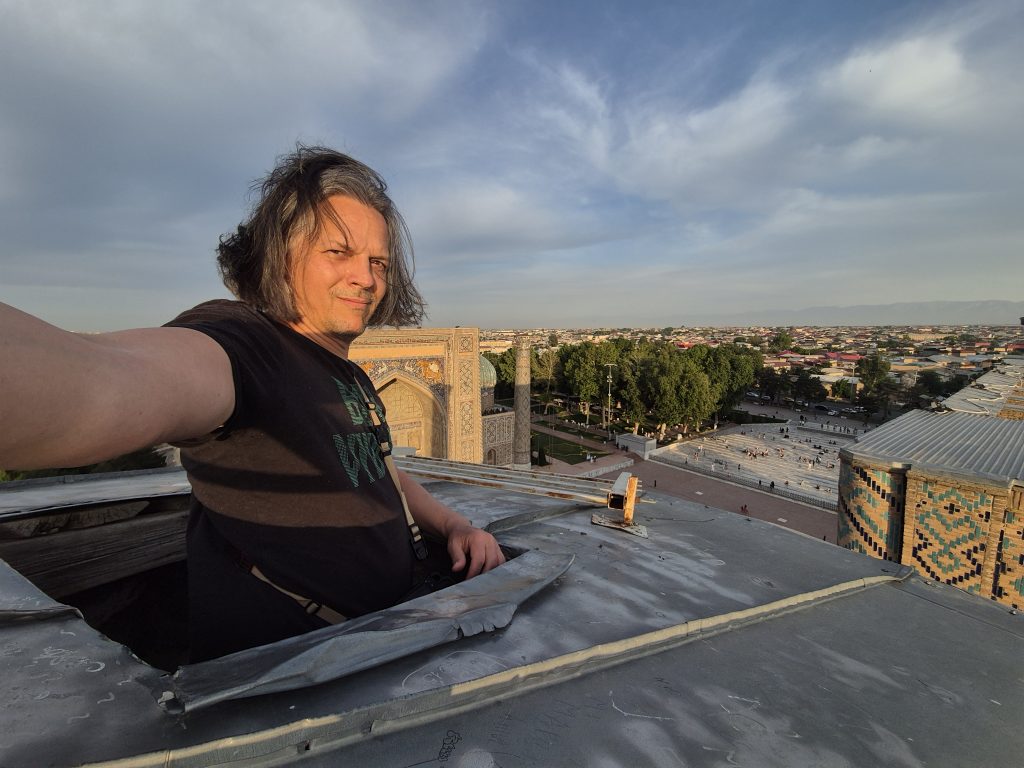
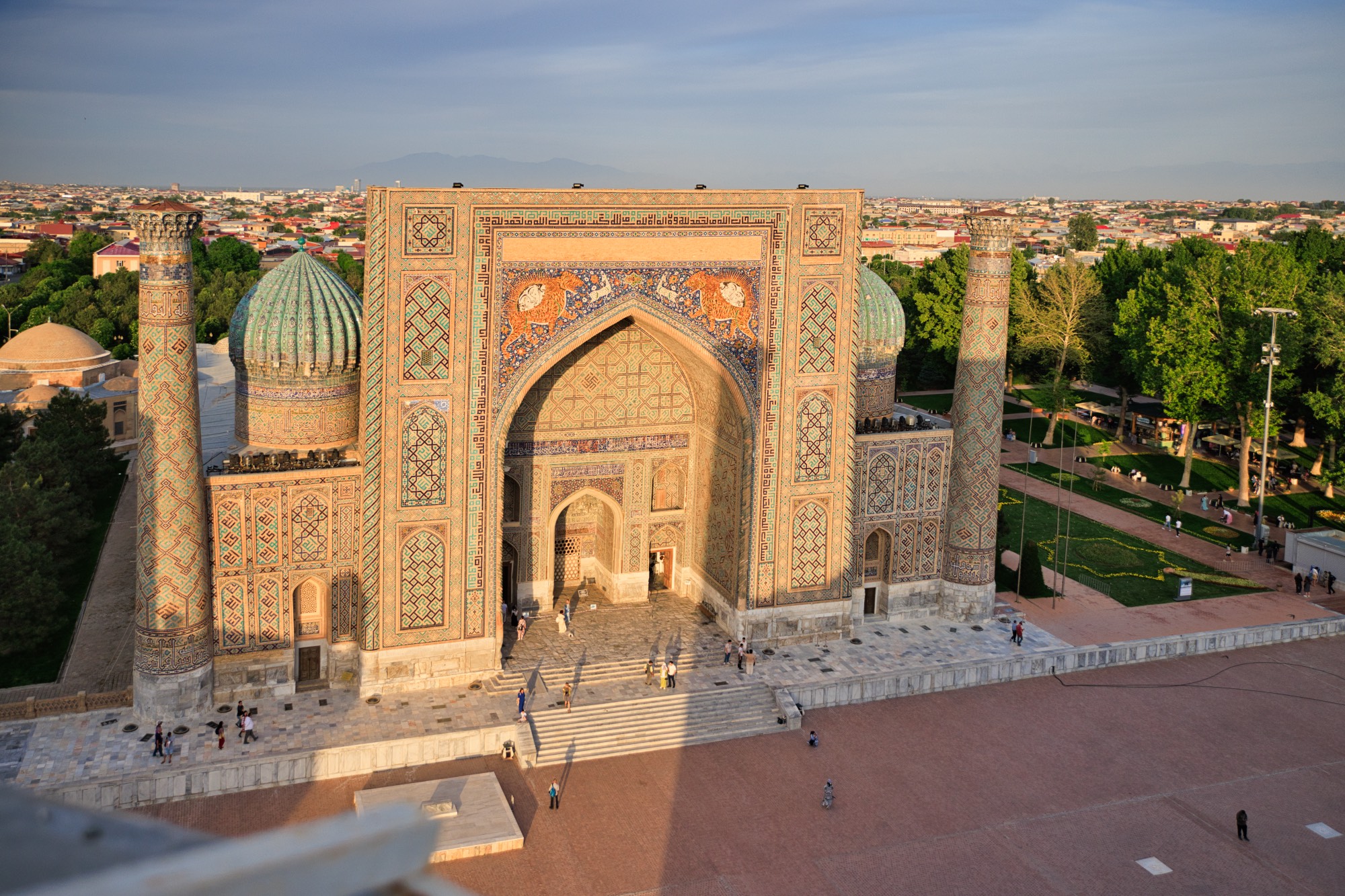
Da es bereits spät am Nachmittag war, hatte Chris den Turm ganz für sich allein und konnte sich in aller Ruhe umsehen und Fotos machen.
Im Anschluß widmeten wir uns dem zweiten Gebäude, der 1636 fertiggestellten Sher Dor Medrese gegenüber dem Platz.
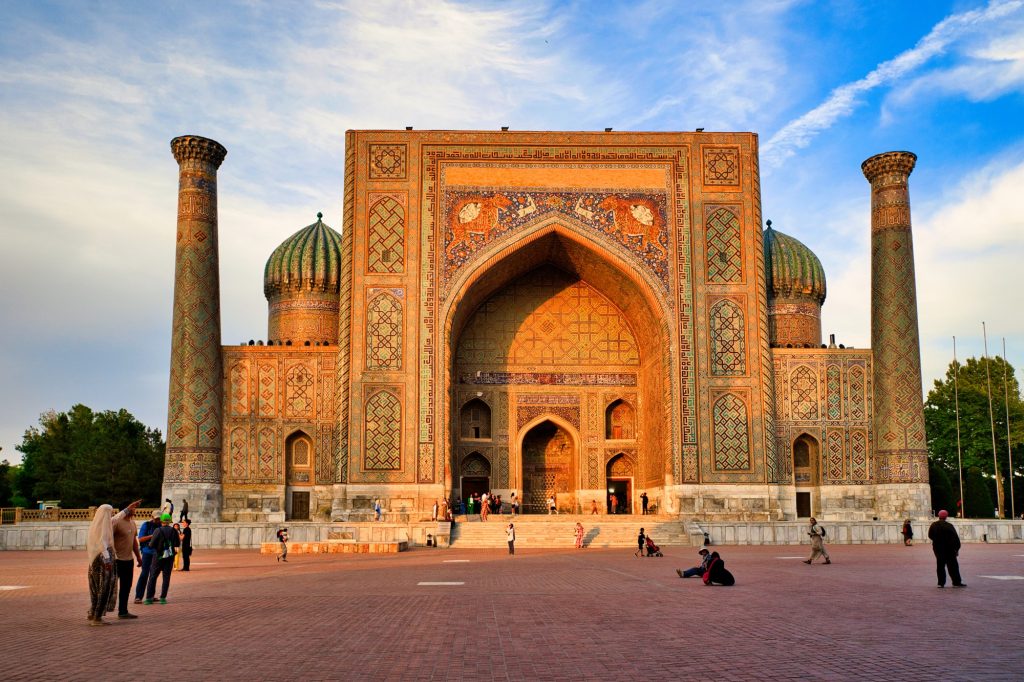
Sher Dor bedeutet auf persich: Mit Löwen versehen. Und tatsächlich: obwohl es im Islam Harām, also verboten war Menschen und Tiere darzustellen, sind auf dieser Medrese zwei Löwen und Hirsche abgebildet. Die Löwen stehen als Zeichen der Macht, während die Damhirsche für die Demut des Volkes vor dieser Macht stehen. (Eigentlich sind es eher Tiger mit Löwenmähne um ehrlich zu sein).
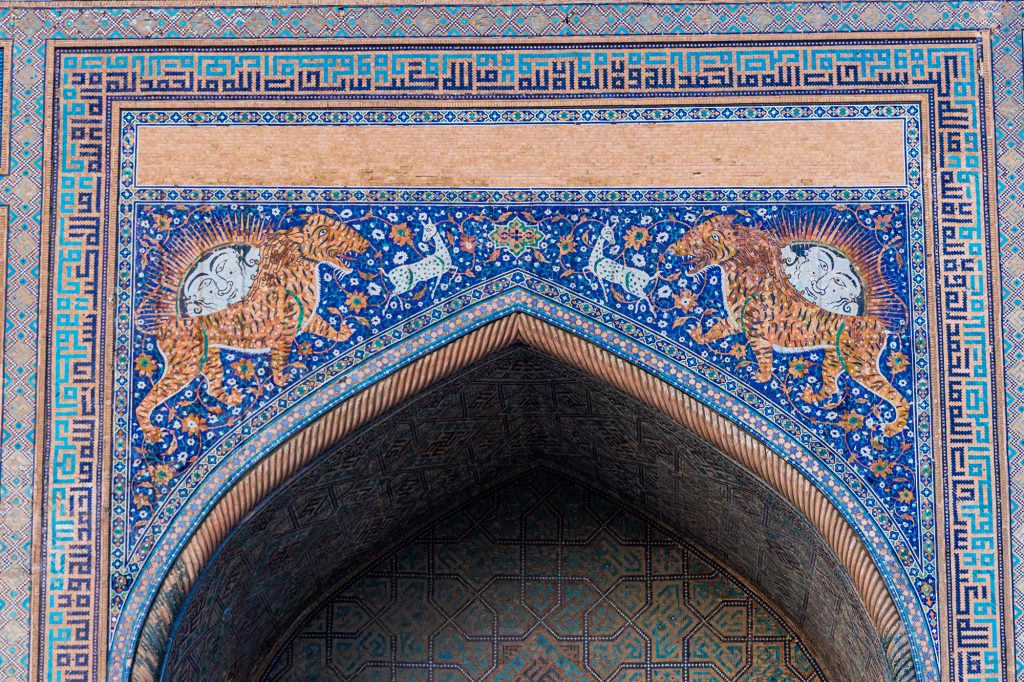
Diese Medrese hatte ebenfalls einen schönen Innenhof, in dem sie einen der Räume im Originalzustand als Studienraum belassen haben, während alle anderen in kleine Geschäfte umgewandelt wurden.
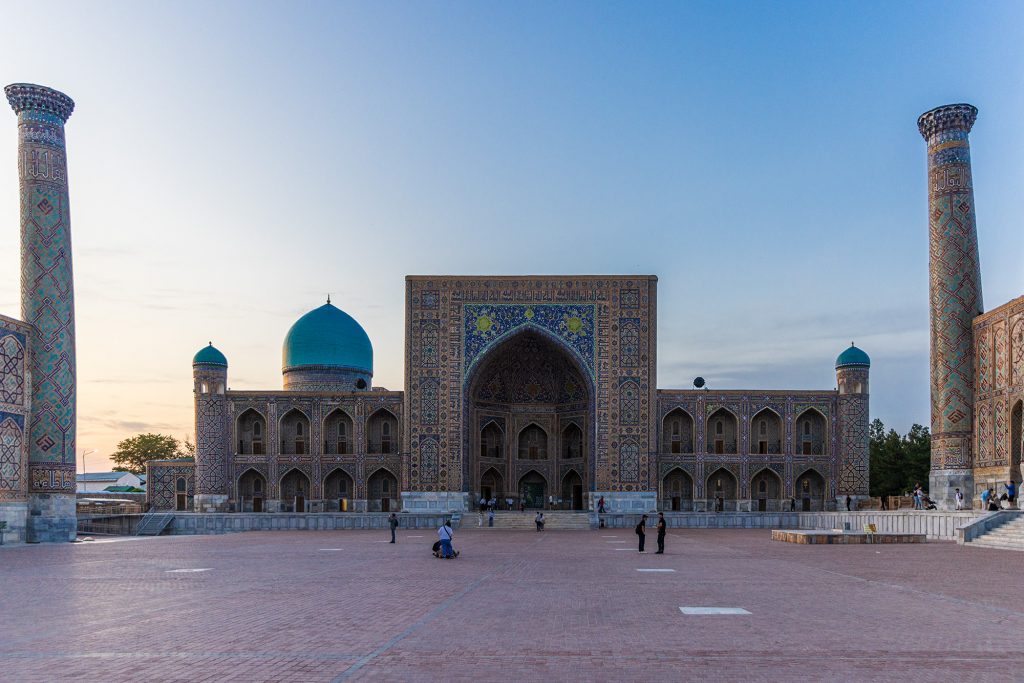
Das letzte und jüngste der Gebäude ist die Tilla Kari Medrese auf der dritten Seite zwischen den beiden. Sie wurde im Jahr 1660 erbaut und zeichnet sich durch eine breitere Fassade und einen großzügigeren Innenhof aus. Er ist gepflastert und sehr hübsch. Von dort aus war auch eine kleine Moschee zugänglich, in der Bilder in Schwarzweiß von den 1930er Jahren zu sehen waren, auf denen wir den schlechten Zustand des Registan-Platzes und seiner großen Medresen vor ihrer Renovierung sehen konnten.
Wir ließen uns durch alle Gebäude treiben und genossen einfach die Atmosphäre eines späten Nachmittags und frühen Abends. Im Dämmerlicht wurden plötzlich die Strahler eingeschaltet, die den Registan-Platz beleuchten.
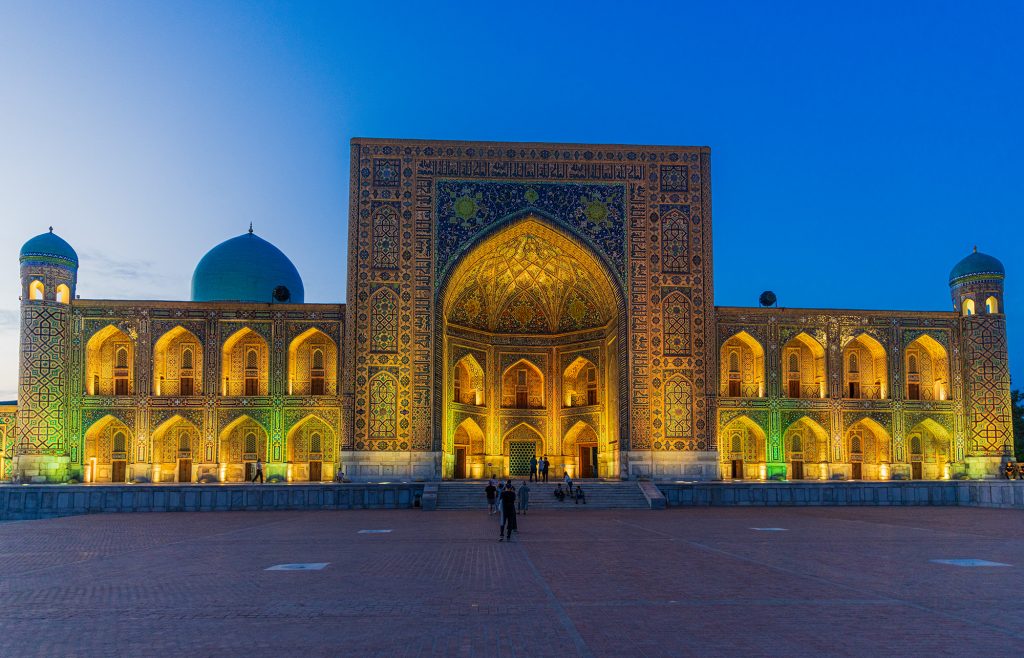
Und das Ensemble erstrahlte in einem fantastischen Licht. Ein kurzes Raunen ging durch die Menge. Die Stimmung war auf einmal eine ganz andere und die verschiedenfarbingen Lichter erzeugten einen grandiosen Effekt. Wir saßen auf den Stufen und gaben uns der Stimmung hin.
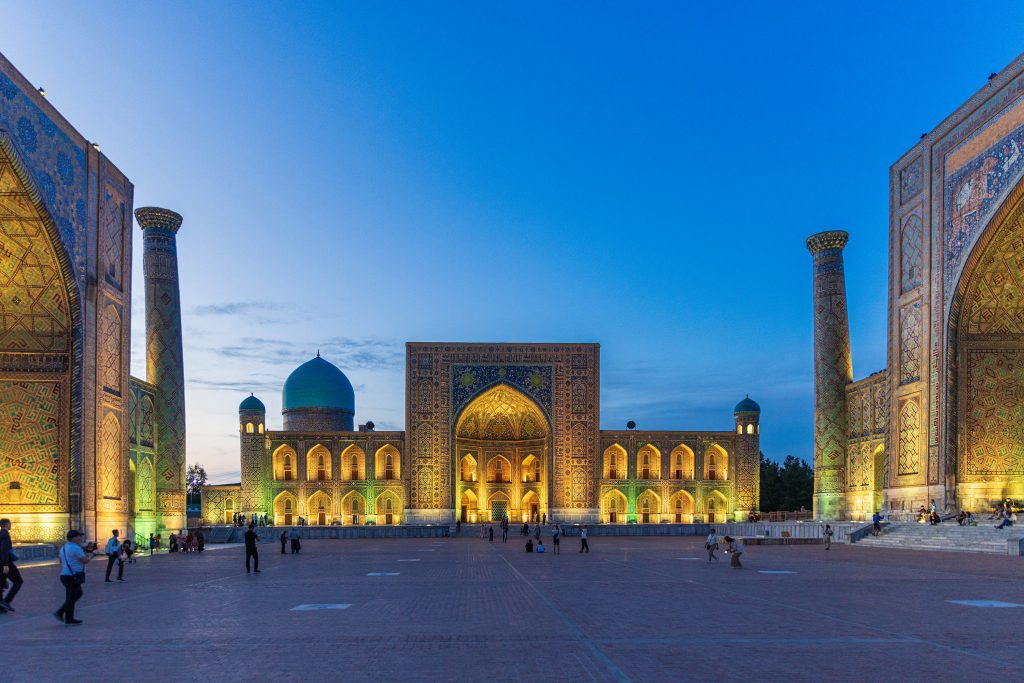
Der Platz selbst war nicht besonders belebt, aber draußen hatte sich eine Menschenmenge auf den Stufen versammelt, um auf die Licht- und Musikshow zu warten, die um 21 Uhr beginnen sollte. Wir entschieden uns, noch solange zu bleiben und durch die Innenhöfe zu schlendern.
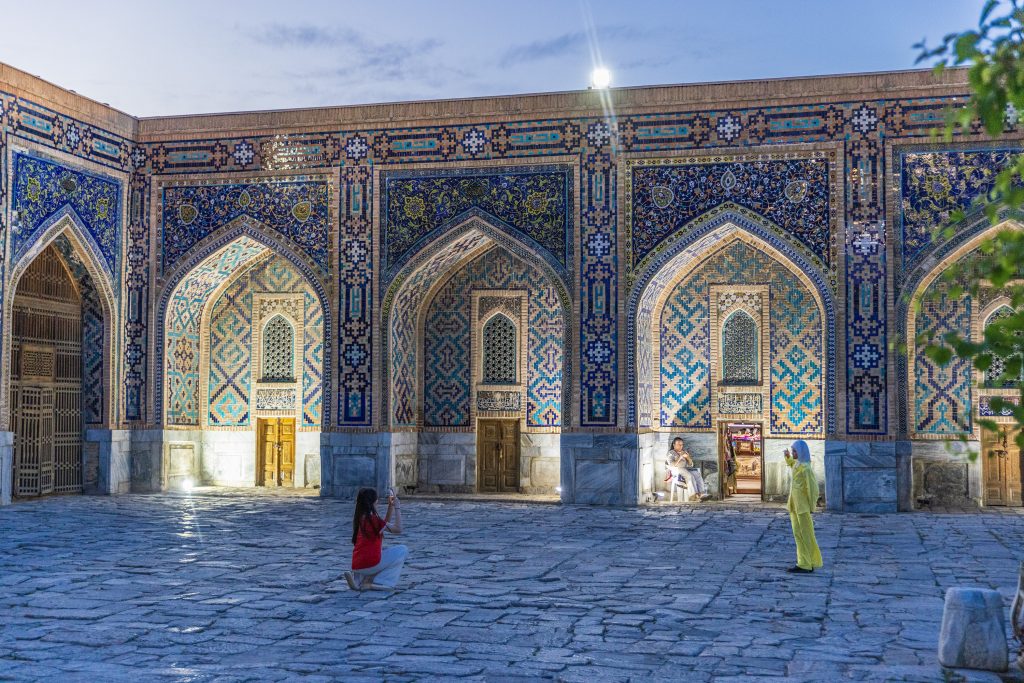
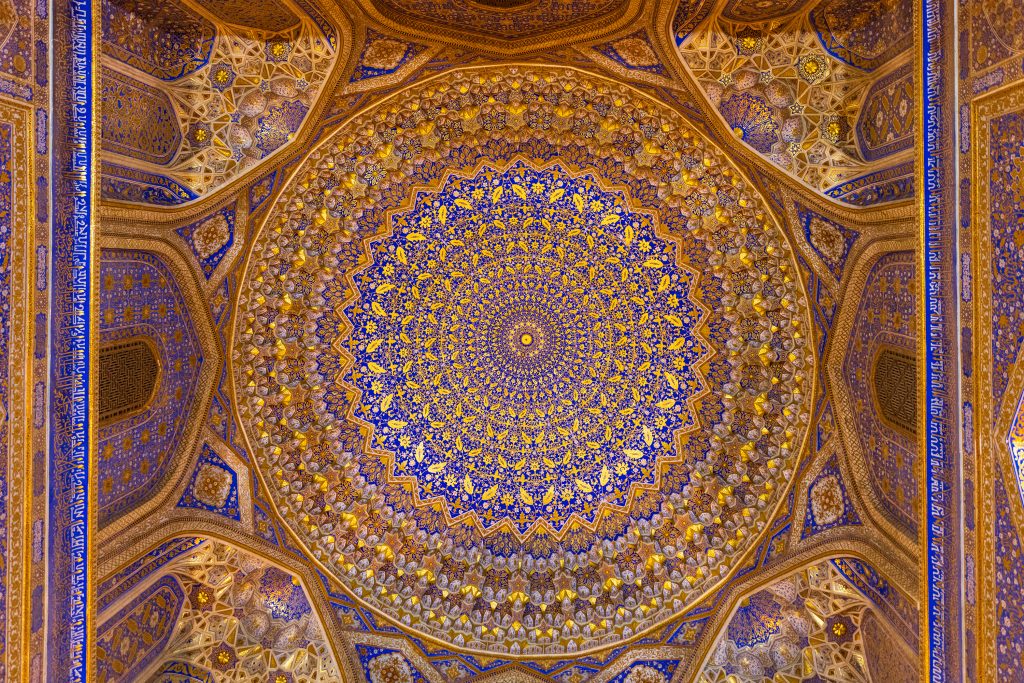
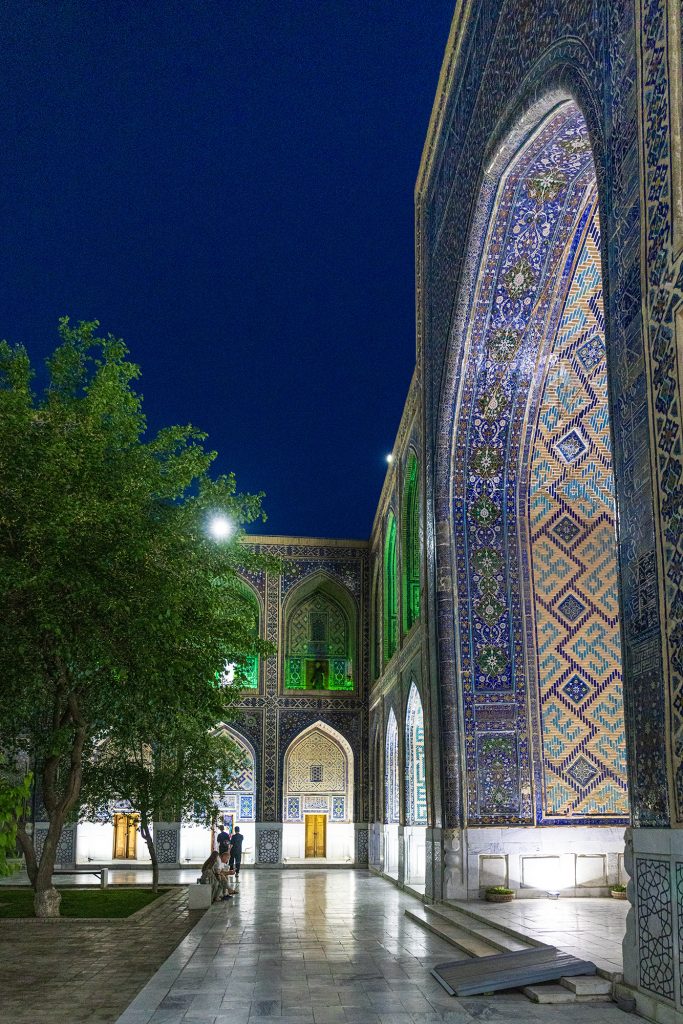
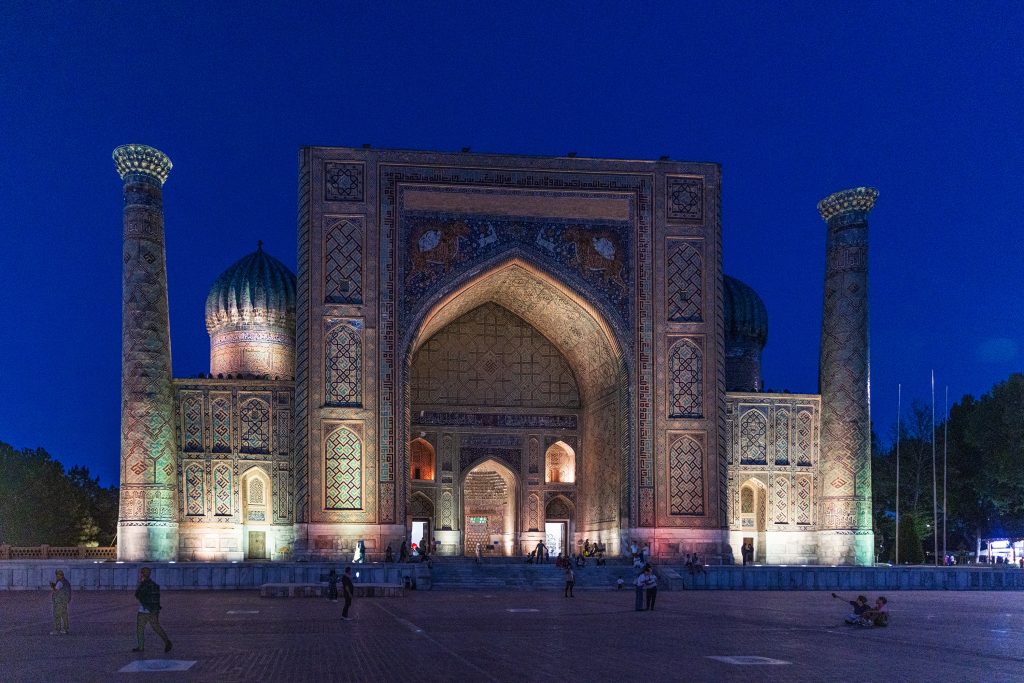
Die Lichtshow war ganz nett, hatte aber nichts mit den 3D-Projektionen zu tun, die hin und wieder gezeigt werden.
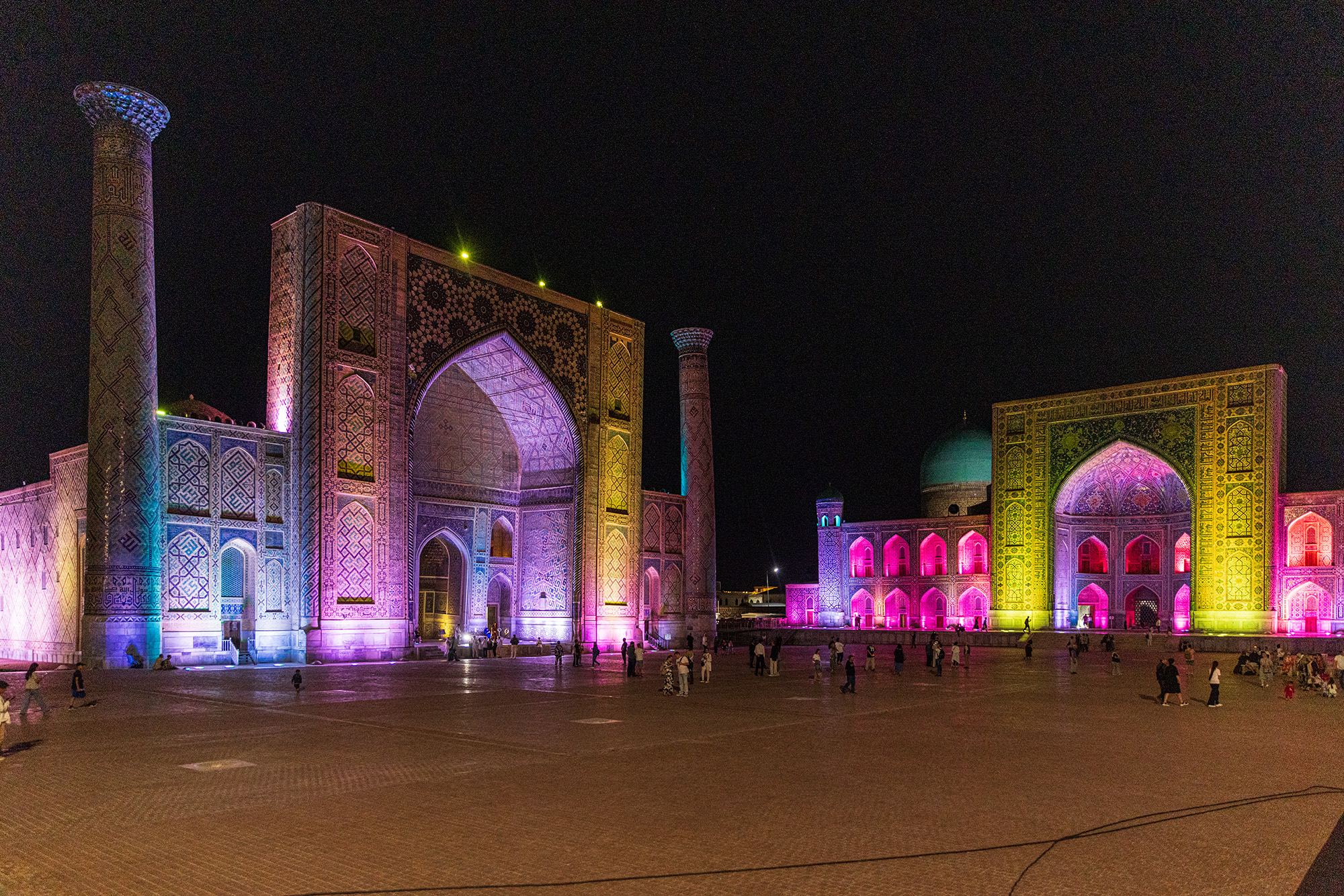
Nach 15 Minuten zogen wir uns in unser Gästehaus zurück um am nächsten morgen für den Sonnenaufganz wiederzukommen. Alles in allem fanden wir, dass deer Registan-Platz in Samarkand dem Taj Mahal durchaus ebenbürtig ist.
Weiter zu Tag 8
Today we said good bye to Tashkent and started our journey to Samarkand with a replacement guide for two days. Unfortunately communication proved difficult as we don’t speak enough Russian and Sherbat does not speak English well. So our communication was challenging to say the least.

After a long six hours drive with some detours we had a yummy lunch in a little road side diner where we ate all sorts of salads and borscht (Ukrainian soup) as well as the best bread we have had in UZ so far. It was still warm and made with butter and you could taste it. In some sense it reminded Chris of a giant Croissant. Less sweet, but same texture. It seems to be in most traditional eating places that if you wanted to eat vegetarian, your only choice is salads. But those were very good. We also got to try a local specialty: pickled mountain onions.

Hard and crispy, they were a treat. The total for the three of us including drinks was a mere 12 Euros. Definitvely worth it.
We pocketed the spare round of bread for later and headed into Samarkand proper.
Samarkand is synonymous with the silk road. It’s one of two Uzbek cities that are called the double silk road cities as two trading routes are meeting here. A northern route through what is called today the Kyrgyz mountains in Kyrgistan and a southern route through todays Tajikistan. Both lead from China to Baghdad but take a different route depending on weather and road risk at the time. Samarkand and Buchara are the two cities that both roads touch. This importance during the high season of the Silk road was clearly visible in their impressive architectural achievements that can still be seen today.
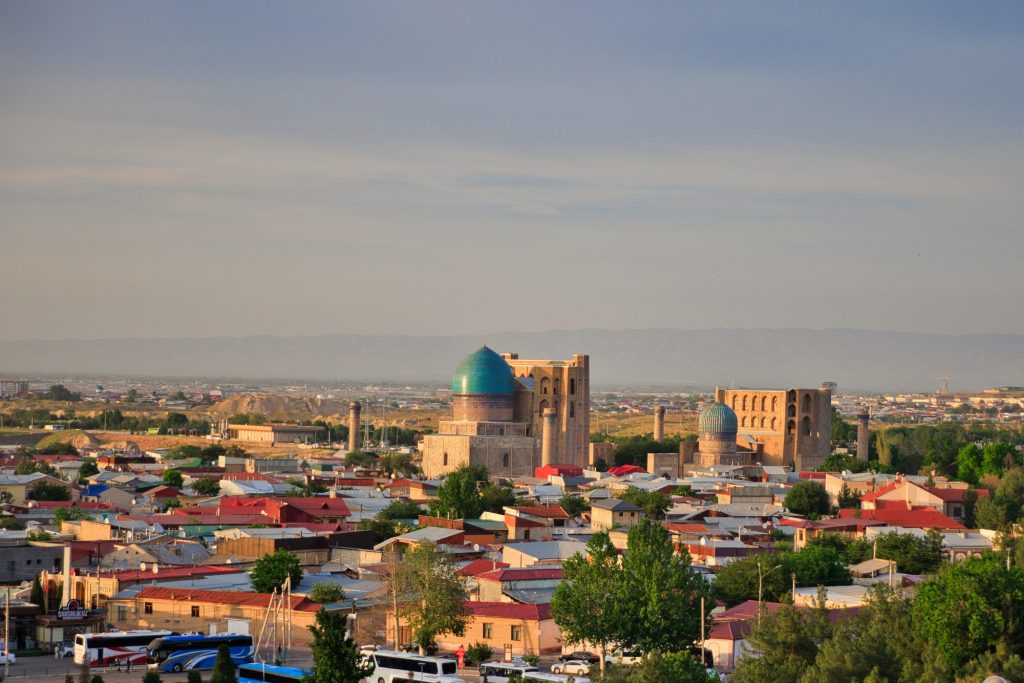
We finally arrived at our lovely little guest house in Samarkand. Jahongir Guest house is in the middle of the old town in Samarkand and it’s only 500m walking distance from the main attraction here, Registan square with its three monumental and impressive buildings grouped around a central square. After checking in we decided that we wanted to head out alone by ourselves and experience Samarkand on foot.

We slowly wandered to Registan square and when you see it for the first time it is as awe inspiring as the Taj Mahal.
Registan originally meant sandy place or desert in Persian and was a center for education and trade. It used to be a public square where people gathered to hear royal proclamations, heralded by blasts on enormous copper pipes called dzharchis — and a place of public executions.

Three medrassas are flanking the square on three sides, the fourth one being open. Originally in the center was a large bazaar but today it’s a cobble stoned flat surface while many of the study rooms in the medrassas have been converted into little tourist and crafts shops.
While those buildings have been taken their knock over the years, the Russians actually restored them back to their old glory during their reign. Lots of colorful tiles, mosaics and art work can be seen everywhere. The buildings look more like palaces than islamic schools. Each of the three buildings looks a bit different.
The oldest is Ulugbek Medrassa, built in 1420 and that one was dedicated to studying sciences like astronomy and mathematics.

It has a nice tree lined interior courtyard and two levels of study rooms. Hidden in one of the entrances is a small wooden door.

For insiders this is the entrance door to one of the minaret towers. Chris having managed to buy ‘a ticket’ for accessing it (which is rather a bribe and limited, as not many people fit onto that staircase and look out.

You shouldn’t try this if you claustrophobic or scared of heights. But yo do get a great birds eye view from above. As it was late in the day Chris had the tower to himself and could take all the time he wanted.
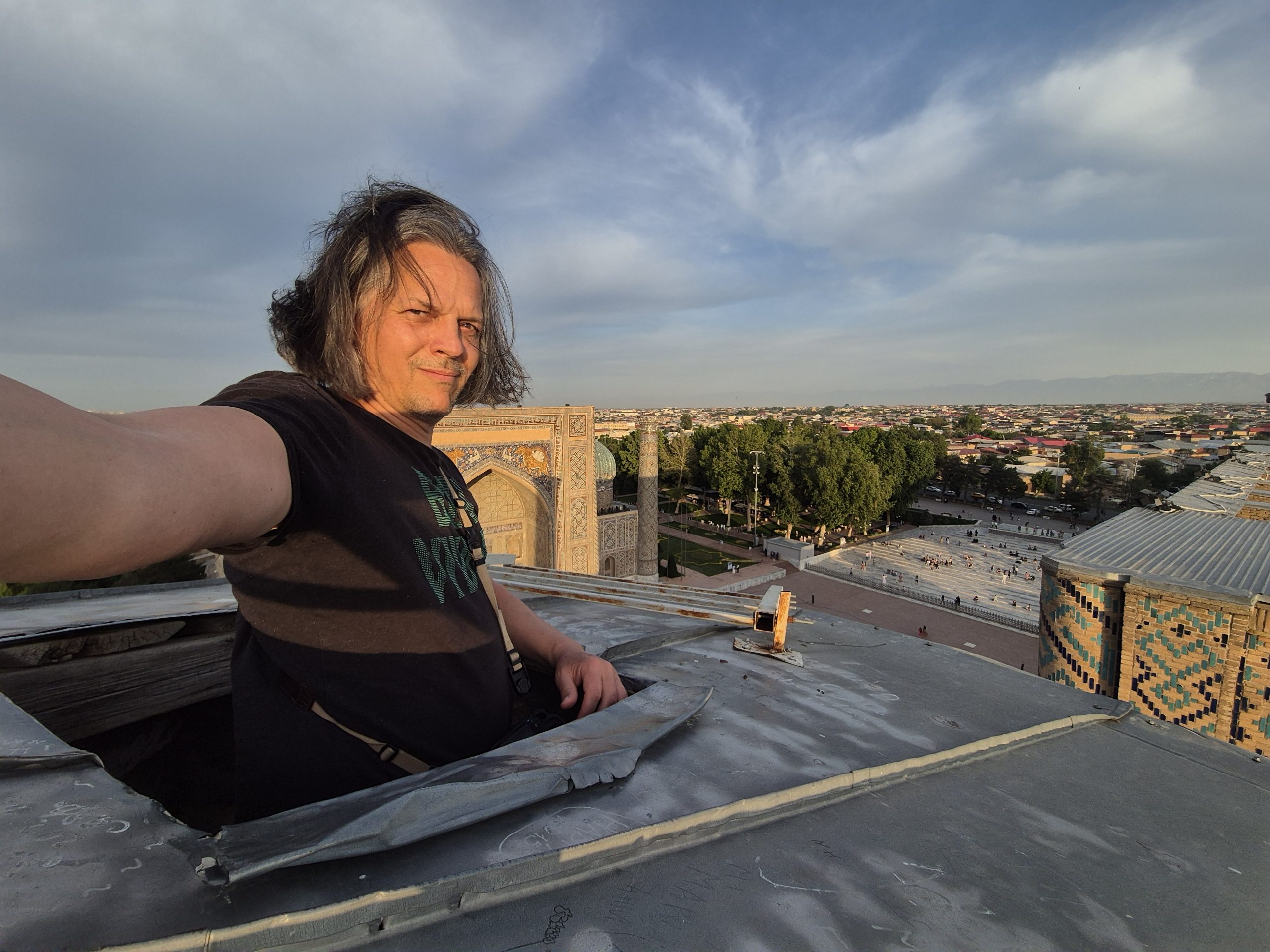

Back down we wandered to the second building, the 1636 finished Sher Dor Medressa opposite the square. Despite it having been forbidden in Islam to picture people and animals, this one has a pair of lions and deer on top protecting it. One of the few depictions defying the rules. This one also had a nice interior courtyard where they kept one of the rooms as an original study room, while all others are converted into little shops.


The last and youngest one of the buildings is the Tilla Kari Medressa on the third side between the two. Built in 1660 it has a wider fassade and larger courtyard. It’s cobblestoned and very pretty.

From there a small mosque was accessible as well with pictures in black and white of the 1930‘s where we could see the poor state that Registan square and it‘s grand medrassas were in before their renovation.
We wandered through all of the buildings and just enjoyed the atmosphere of a late afternoon and early evening. As it got dusk all of a sudden the lights illuminating Registan square came on all at once and bathed everything in fantastic light.

While the setting sun shone only on some parts of the buildings before it set, the lights brigtly lit the entire square and it made everyone gasp for a short moment when that happened.

It changed the entire ensemble to produce an even grandioser effect. We simply sat on the steps and enjoyed the view and the people passing.




It was not very busy and a crowd had athered outside the square on some steps to wait for the light and music show which was supposed to start at 9 PM. We decided to wait it out and it ws OK, but it had none of the 3D effects that sometimes are being used.
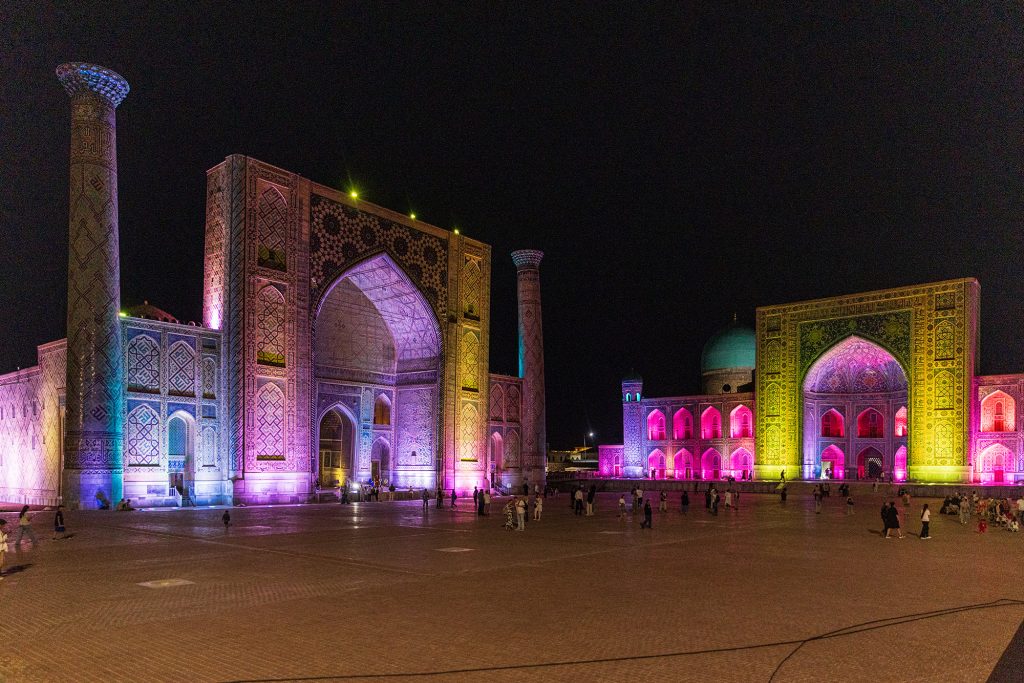
After 15 min we decided to head home to our guest house and rather get an early start tomorrow to see Registan square in the early sunlight again. We have to say we would consider Registan square in Samarkand on par with the Taj Mahal.
Heute machten wir uns auf, um Tashkent mit Inom zu entdecken. Inom hat einen schwarzen Chevrolet. Das ist untypisch, denn 90% aller Autos hier sind weiß, und 80% aller Autos sind Chevrolets. Die häufigsten Autos hier sind also alle weißen Chevrolets.
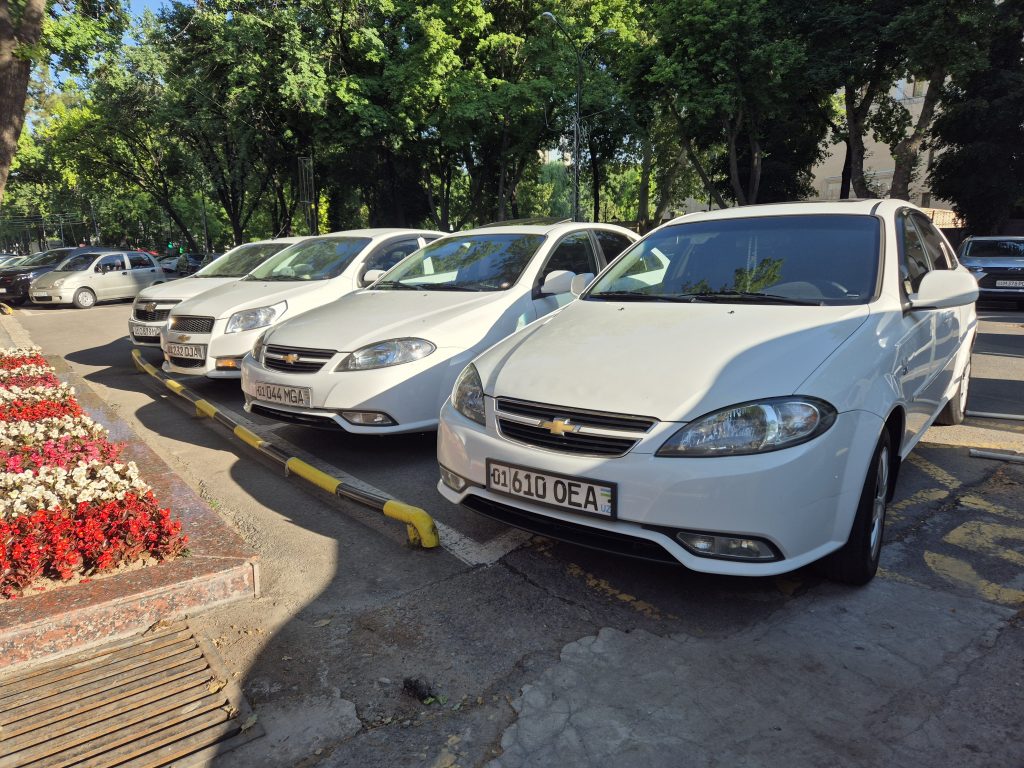
Das erscheint zunächst recht eigenartig, bis man erfährt, dass Chevrolet hier in Usbekistan einige große Fabriken hat und die Chevrolets somit lokal produzierte Autos sind. Im Jahr 2008 schlossen sich General Motors und die Regierung Usbekistans zusammen, um GM Uzbekistan zu gründen und Chevrolet-Autos in Massenproduktion herzustellen. Die Regierung hielt einen 75%igen Anteil an der Firma, während GM 25% besaß. Um ein Auto von außerhalb Usbekistans zu importieren, fallen hohe Importsteuern von 30% an. Deshalb kaufen alle außer den Ultra-Reichen lokale Autos. Andere Autos, die man sehen könnte, sind hauptsächlich asiatisch, wobei chinesische Autos immer mehr Marktanteile übernehmen. Hier und da sieht man auch Elektroautos und Ladestationen.
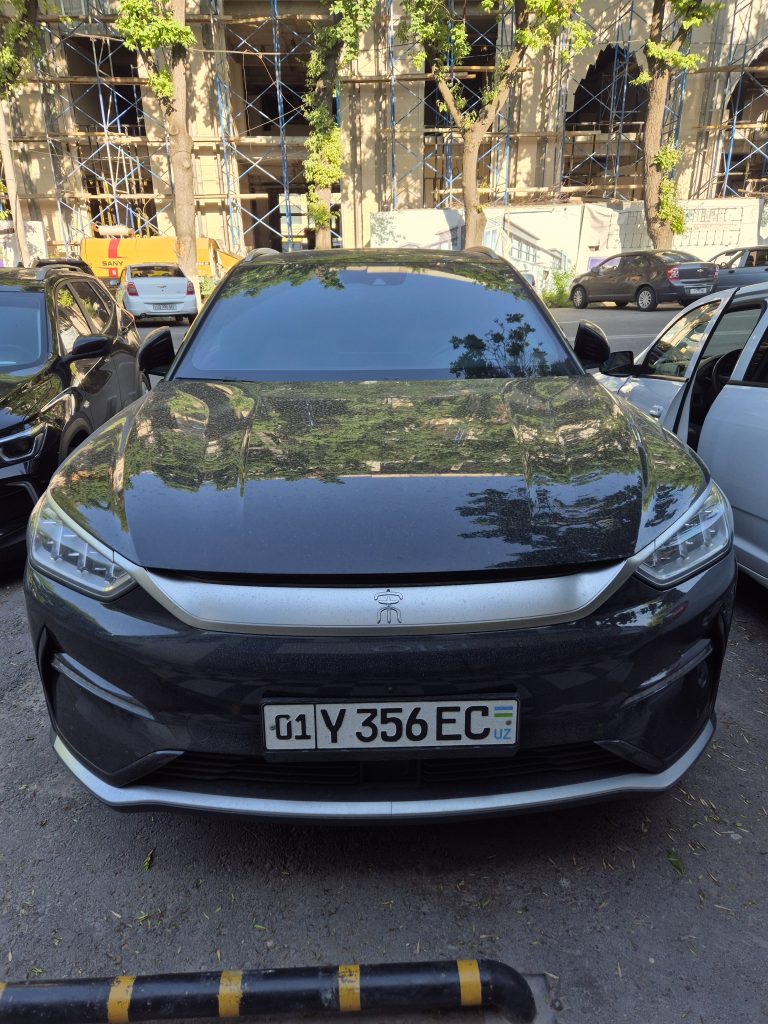
Wir waren angenehm überrascht, durch eine pulsierende, saubere Stadt zu fahren, die eine Mischung interessanter Aspekte aufwies. Überhaupt nicht langweilig. Man konnte deutlich den Einfluss mehrerer Jahrhunderte in der Architektur und den Kunststilen erkennen. Alte, timuridische Gebäude und Basare, traditionelle islamische Medresen, die nicht von den Russen oder dem großen Erdbeben 1966 zerstört wurden, ein sowjetischer Fernsehturm und sehr moderne Gebäude, die an jeder Ecke des neuen Stadtteils entstehen.
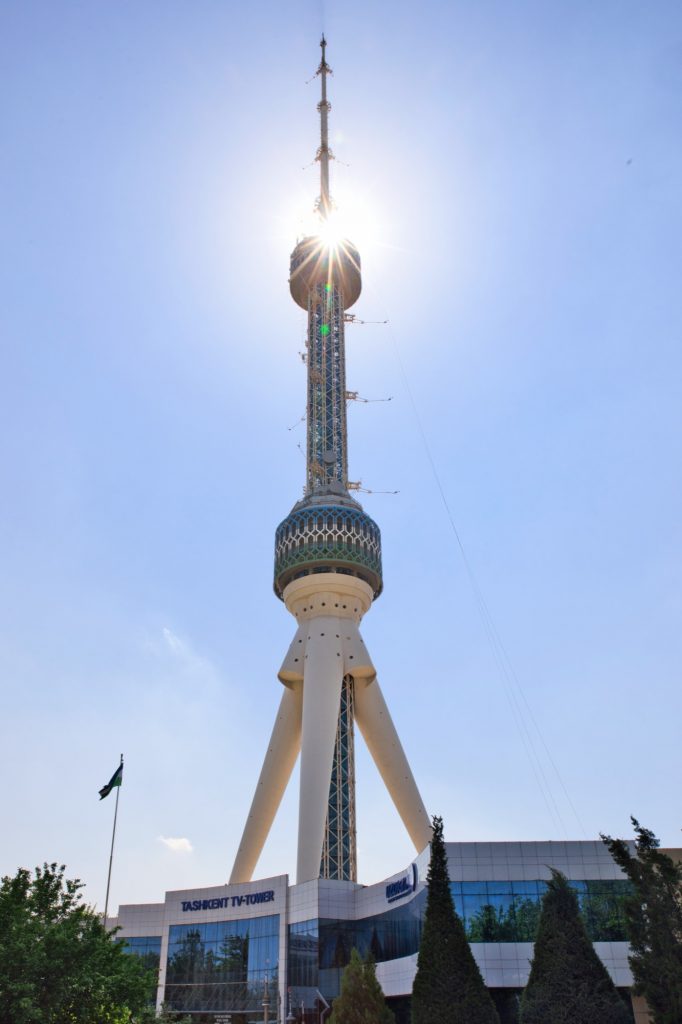
Wir begannen unsere Erkundung mit dem Islamische Religionszentrum Khast Imom, das zwar eine ziemlich neue Konstruktion ist, aber gleich nebenan befindet sich ein viel größerer im Bau – finanziert von Saudi-Arabien. Khast Imom besteht aus einer Moschee, einer Medrese (Koranschule) und dem Moyie Mubarek Library Museum, die um einen großen Innenhof gruppiert sind.
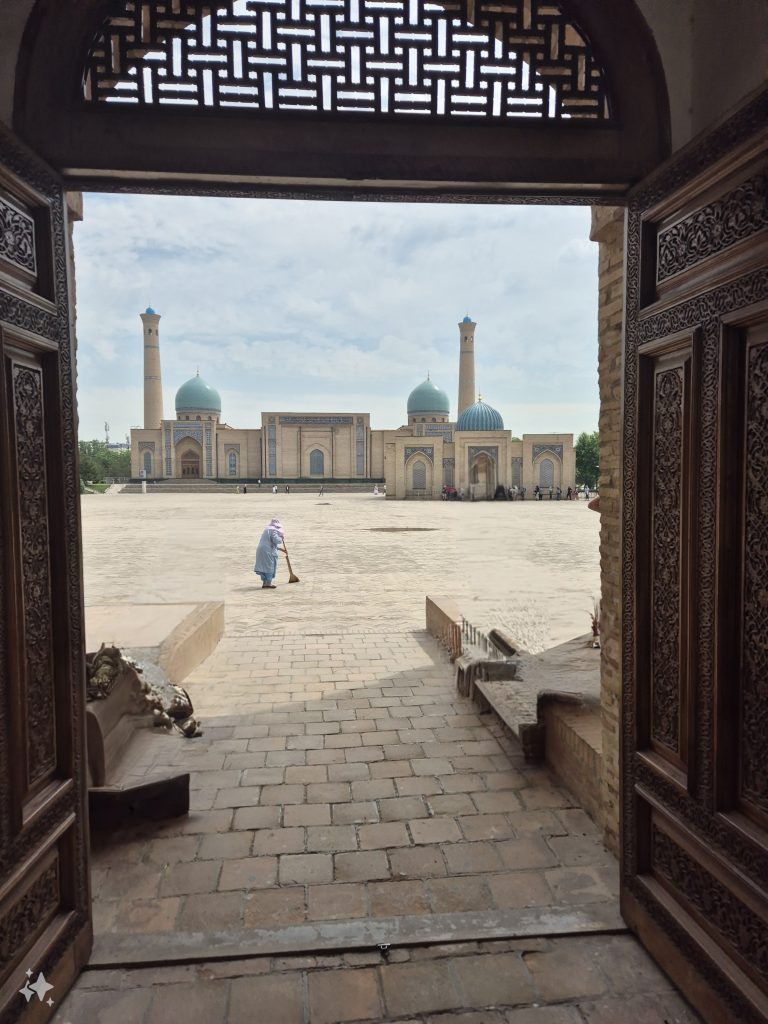
Die Bibliothek beherbergt das älteste bekannte Koranbuch. Auf Hirschleder geschrieben, liegt es in einem klimatisierten Glaskasten, umgeben von Hunderten von Korankopien in allen Formen, Größen und Sprachen. Das kleinste Buch, das wir sahen, war kaum 2 cm groß. Es gibt auch eine hebräische Version des heiligen Koran.
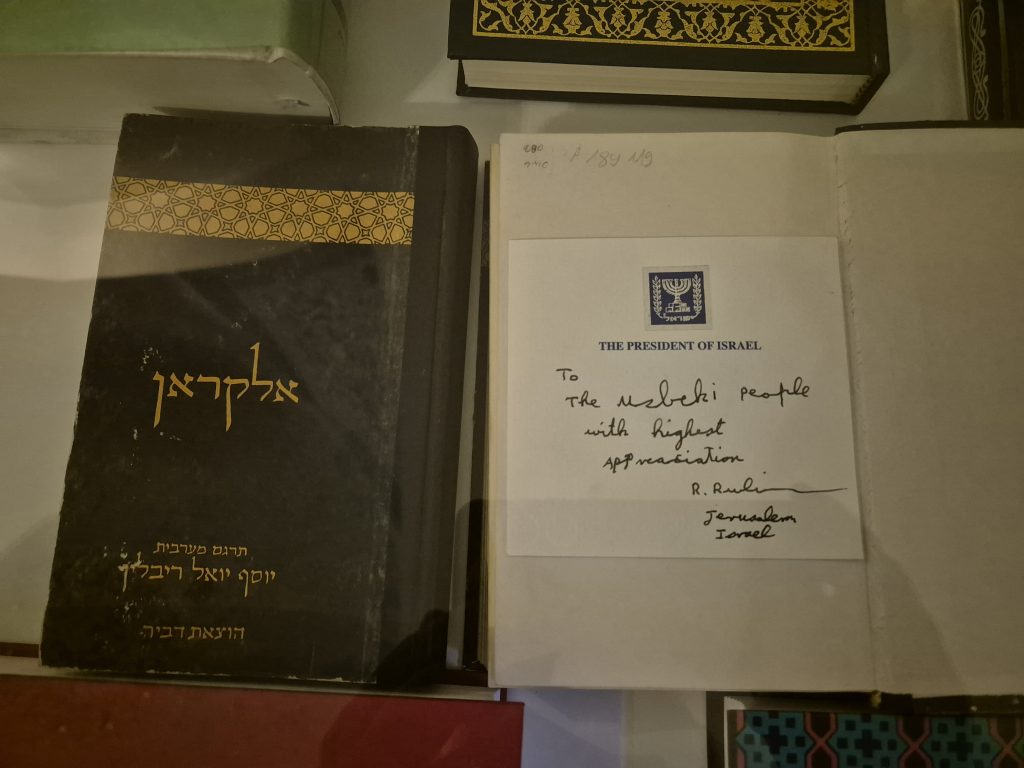
Weiter ging es zum Museum für angewandte Kunst, das die verschiedenen Kunsthandwerkstechniken Usbekistans präsentiert. Seidenweberei, Textildruck, Holzschnitzerei, Fliesenherstellung und andere Keramiken verschiedener Epochen wurden ausgestellt. Die Fähigkeit und das Know-how zur Herstellung von Seide und Papier waren lange Zeit ein Geheimnis der Chinesen. Doch als das chinesische Reich dringend Pferde benötigte, um ihr Territorium zu verteidigen, konnten die Türken (stellvertretend für alle Turkvölker) Pferde gegen das Geheimnis der Seiden- und Papierherstellung eintauschen. Seitdem ist das Ferganatal in Usbekistan nicht nur für seine großartigen Pferde, sondern auch für die Seidenherstellung bekannt.
Wir beschlossen, dass es Zeit für das Mittagessen war, und Inom fuhr uns zum Zentralasiatischen Plov-Zentrum Besh Qozon. Dort in einem großen Gebäude gibt es nur verschiedene Sorten von Plov, dem Nationalgericht Usbekistans. Ihr Plov wird in vier Meter breiten Pfannen über Holzfeuern zubereitet. Riesige Fleisch- und Fettstücke werden darin gebrutzelt und stundenlang gegart, Karotten, Zwiebeln und Gewürze hinzugefügt und der Reis obendrauf. Es dauert mehrere Stunden, bis er gar ist, daher sind gleichzeitig acht oder neun verschieden große Plov-Kochstationen im Einsatz.
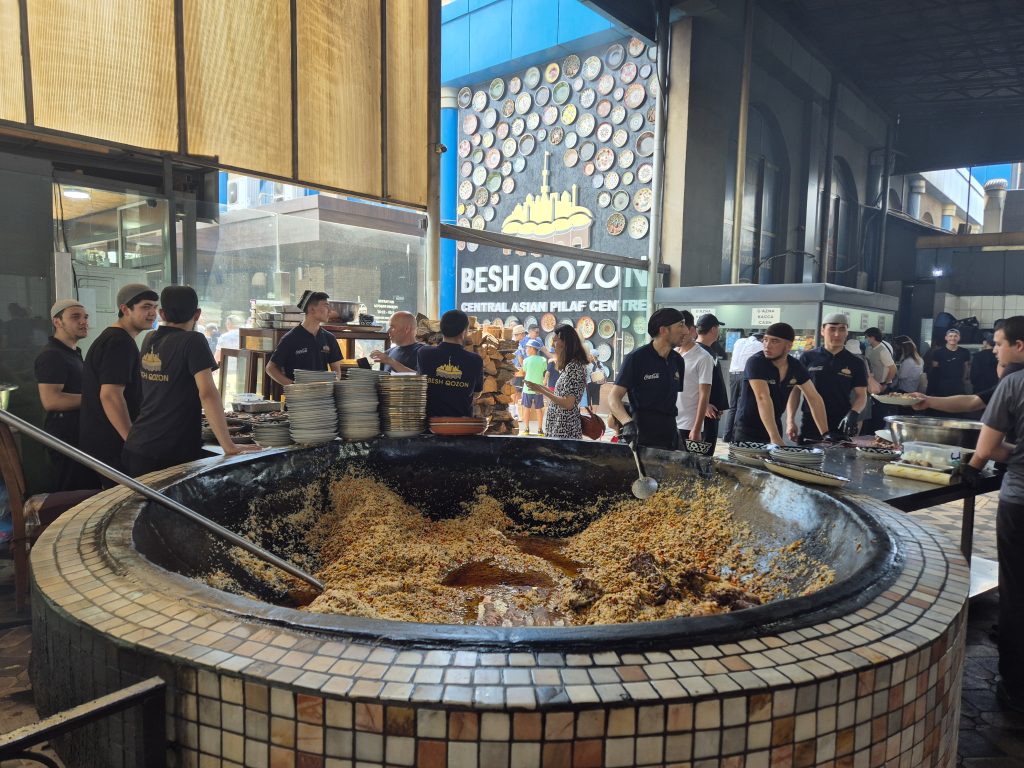
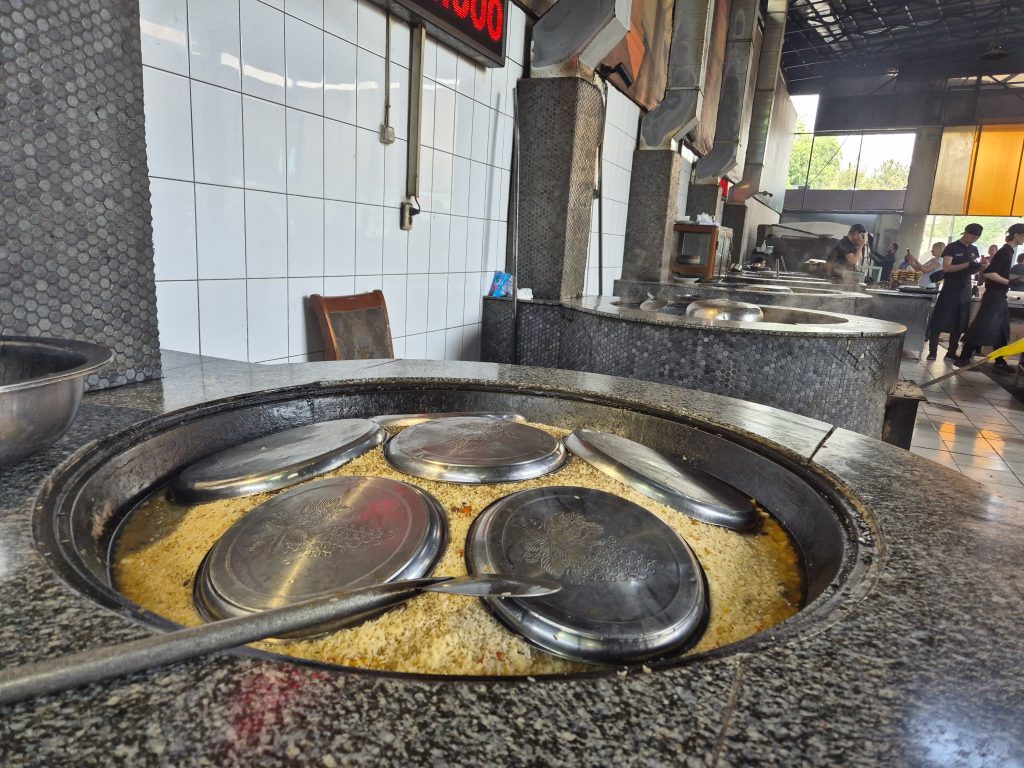
Wir suchten uns einen Tisch und bestellten: Rindfleisch-Plov mit einem Stück Pferdefleisch für Chris und einen großen Tomaten-Zwiebel-Salat für Esther, beide serviert mit Non, dem traditionellen usbekischen rundem Laib Brot.
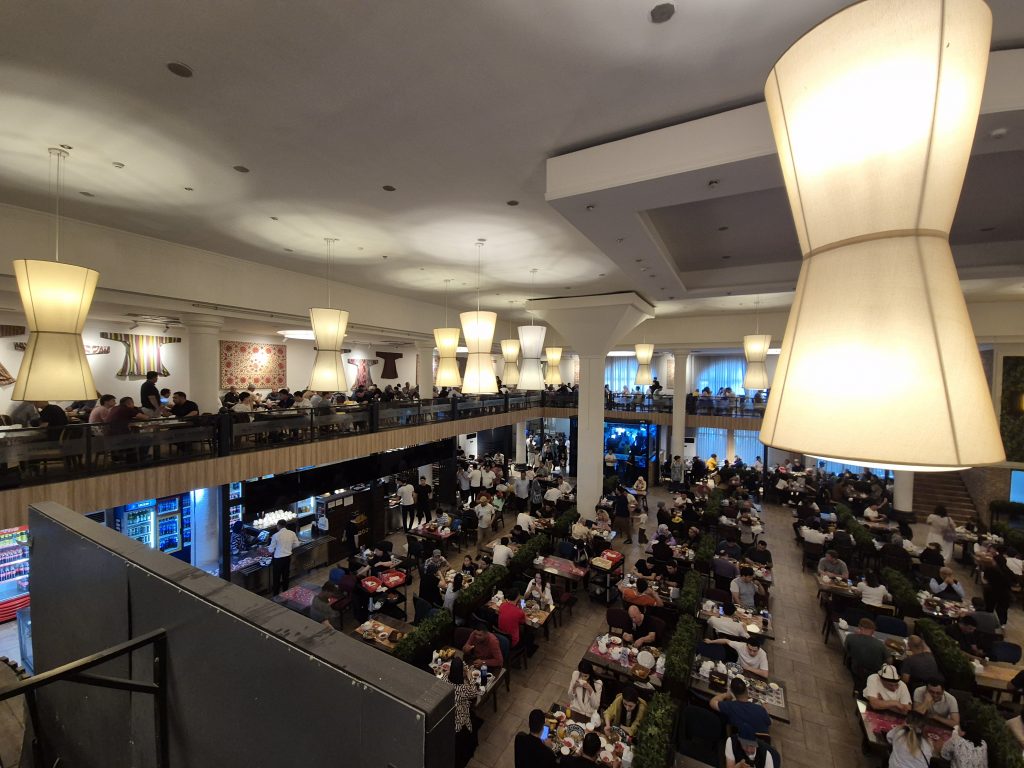
Während Chris’ Plov eigentlich aus Reis und Rindfleisch bestehen sollte, schmeckte es intensiv nach Hammelfleisch, dank des Hammelfetts, das verwendet wurde, um den Plov noch ‘geschmackvoller’ zu machen. Esther probierte nur einen Bissen, Chris pickte das Rindfleisch und ein paar Gemüsestückchen heraus, konnte aber den öligen, intensiv nach Hammelfett schmeckenden Reis nicht wirklich essen. Wir bevorzugten die Hühnervariante des Plovs, die Borat für uns gekocht hatte. Plov dürfte nun für den Rest des Urlaubs abgehakt sein.
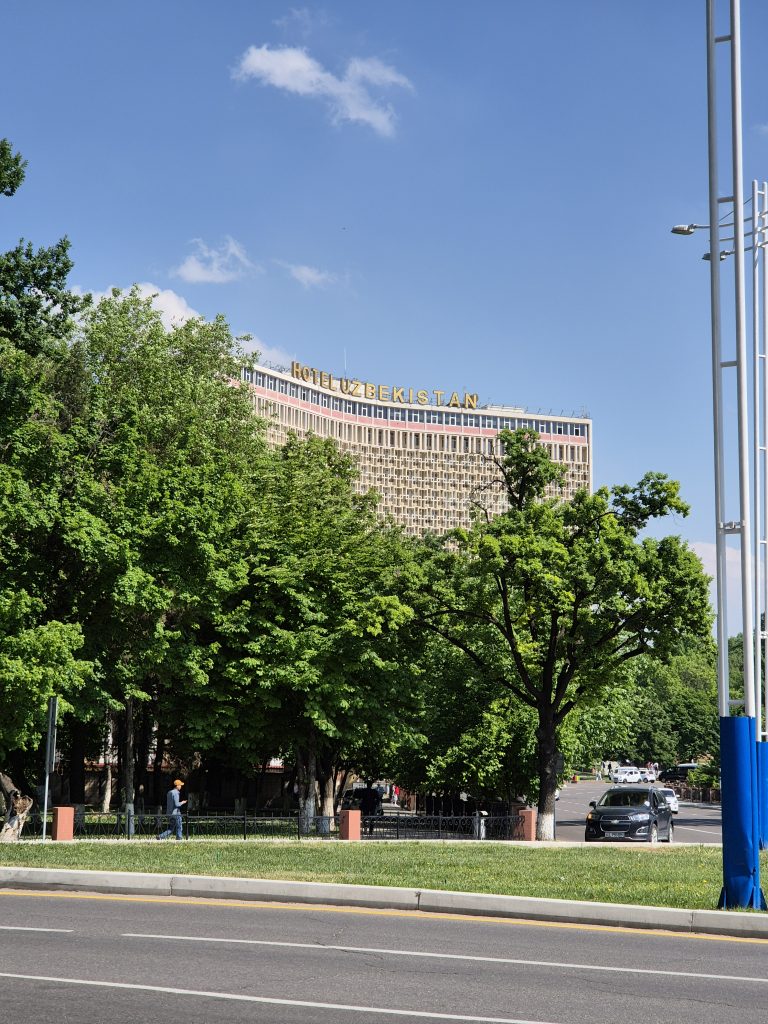
Als nächstes besuchten wir die Amir-Timur-Statue direkt vor dem ikonischen Hotel Usbekistan, dem Inbegriff des sowjetischen Stils. Amir Timur ist wahrscheinlich ebenso berühmt und wichtig für die lokale Geschichte wie Dschingis Khan.
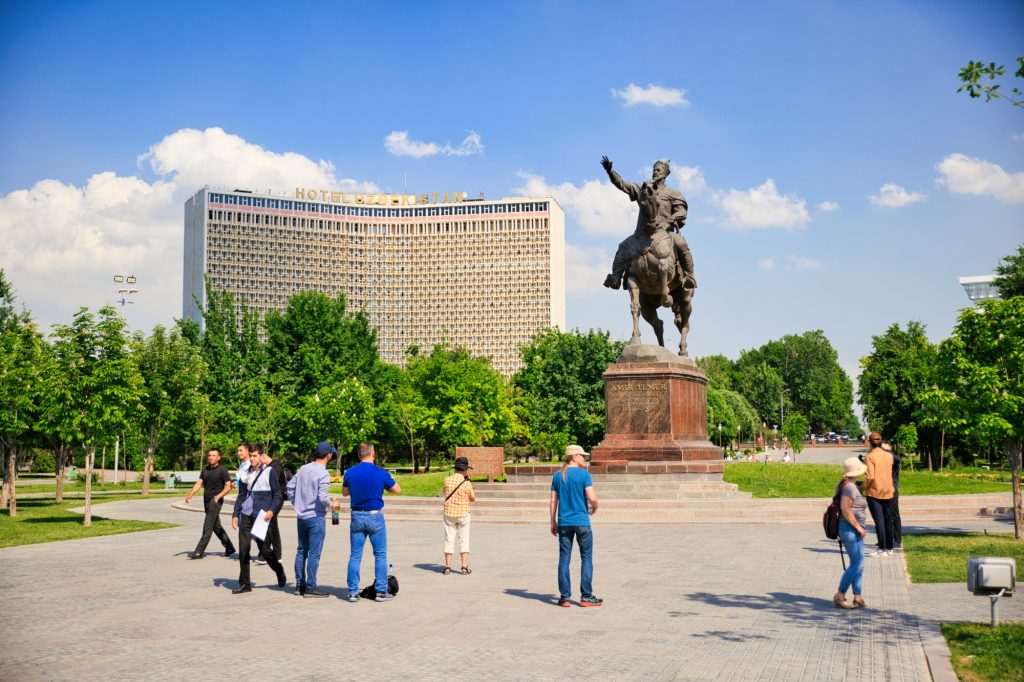
Von jungem Alter an zeigte Timur Hingabe an die Traditionen der nomadischen Steppevölker und zeichnete sich im Reiten und Bogenschießen aus. Nachdem er in einer Schlacht verwundet wurde, war er gelähmt am rechten Arm und Bein, was ihm den Spitznamen “Timur der Lahme” einbrachte. Durch eine strategische Heirat wurde er im Alter von 25 Jahren Gouverneur von Shahrisabz und etablierte schnell seine Herrschaft durch Eroberungen. Timurs Reich, bekannt als das Timuridenreich, erstreckte sich über Zentralasien, Afghanistan, Pakistan, Teile Indiens, Irans, Iraks, des Kaukasus, Syriens und Teile der Türkei.
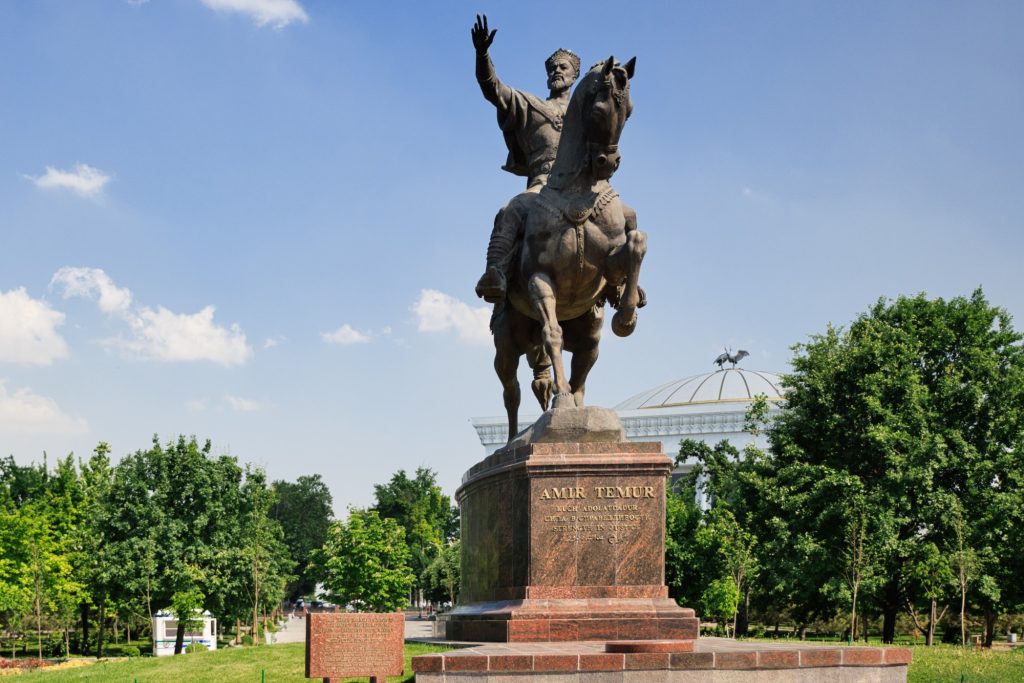
Timur brachte nicht nur Kriegsbeute nach Samarkand (unser nächster Stopp), sondern auch Wissenschaftler und Kunsthandwerker aus verschiedenen Ländern. Folglich waren auch andere Städte in seinem Reich mit architektonischen Meisterwerken geschmückt, die Usbekistan bis heute prägen. Er starb während einer Feldzug in Kasachstan, auf dem Weg, Teile Chinas zu erobern, und sein Erbe lebt weiter in den architektonischen Wundern von Samarkand, wo er begraben wurde. Seine militärische Stärke beruhte auf Mobilität, Überraschung und strategischer Geduld, die es ihm ermöglichten, sein Reich erheblich auszudehnen.
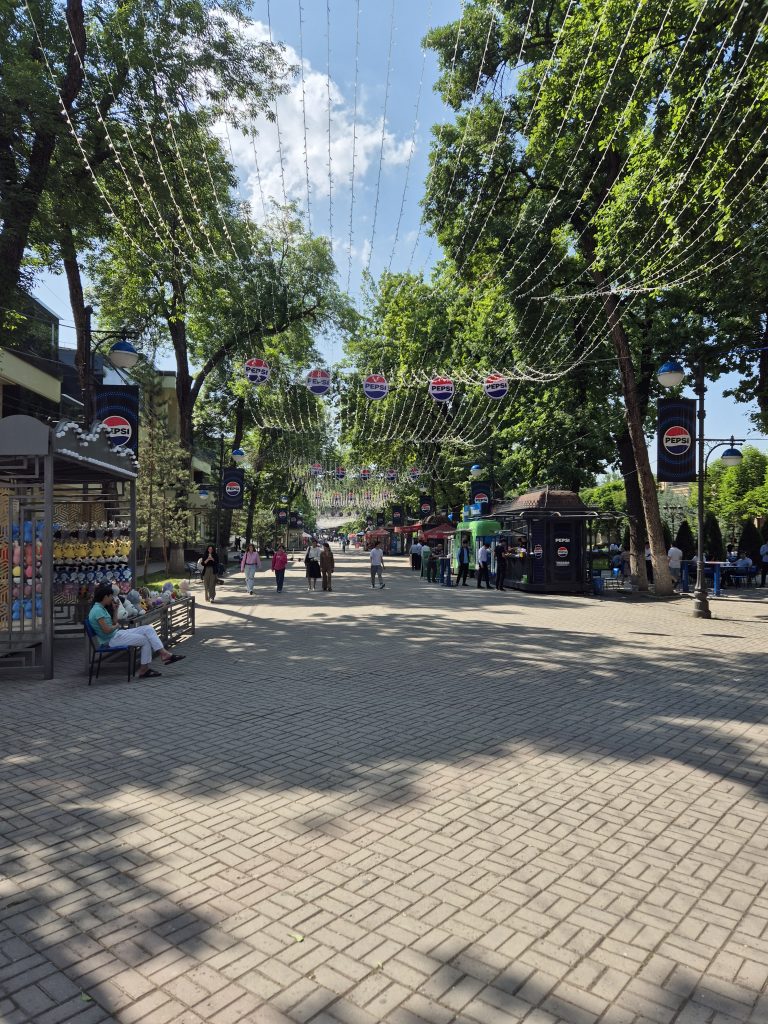
Von dort aus spazierten wir durch den “Boulevard”, eine Fußgängerzone mit kleinen Antiquitätenständen wie an einem Flohmarkt und kleinen Straßenständen für Streetfood, bis wir zu einer der U-Bahn-Stationen von Taschkent kamen.
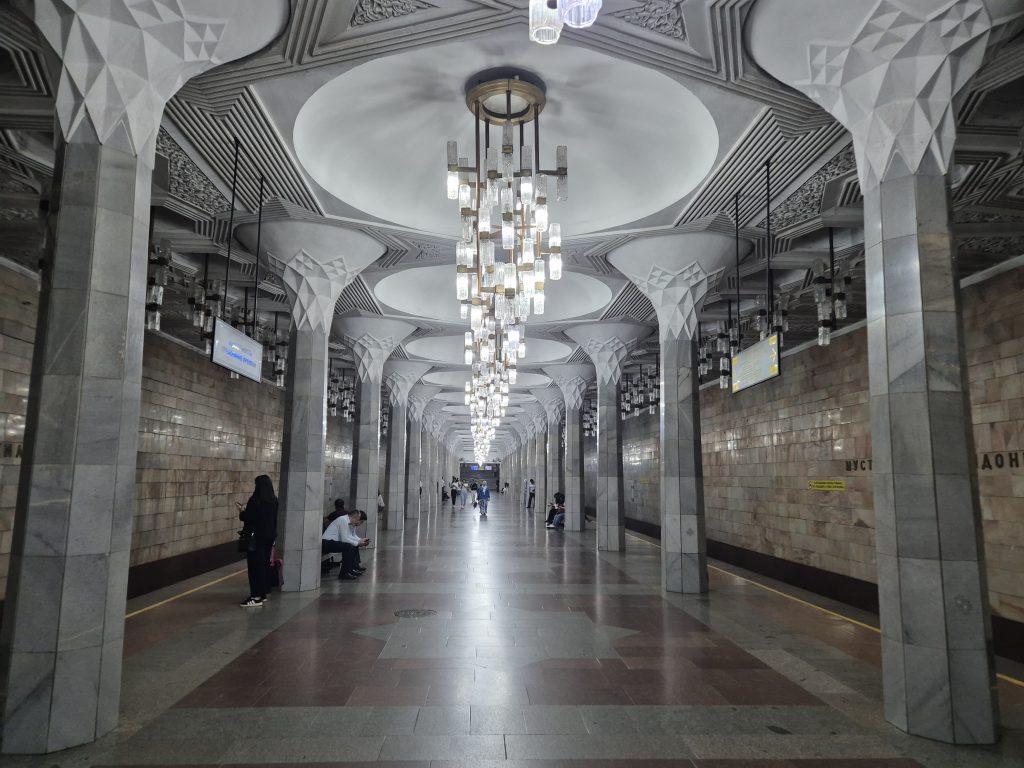
Wir stiegen an der Station Mustaqillik Maydoni ein, wechselten in Alisher Navoi um und landeten schließlich in Kosmonavtlar, der berühmtesten Station, auch bekannt als “die Raumstation”.
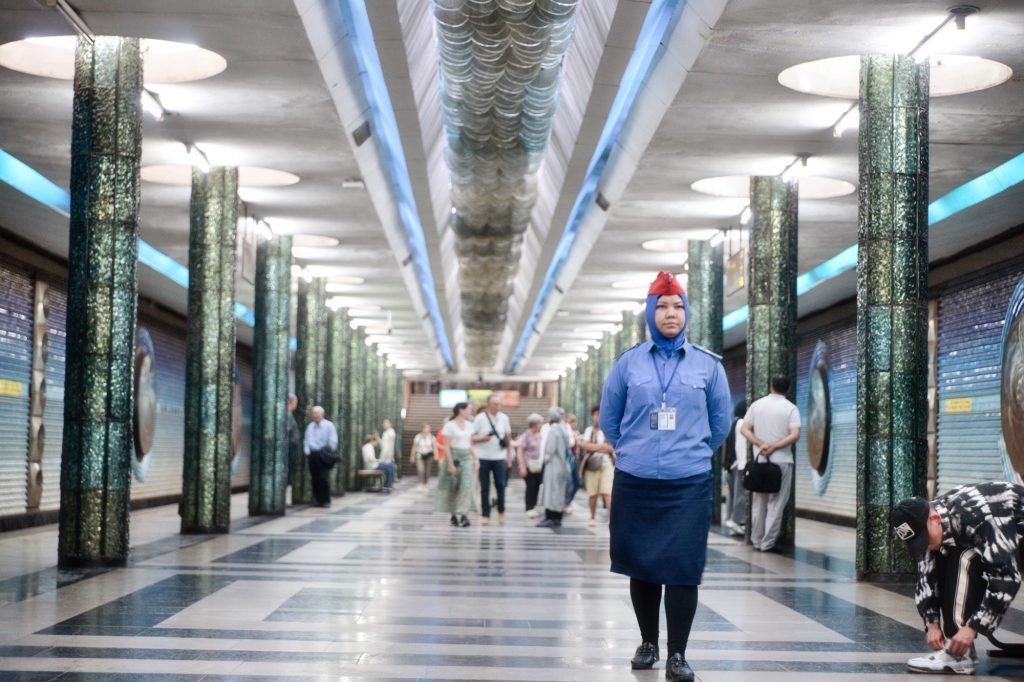
Die Tashkenter Metro ist wirklich etwas, das man erleben sollte. Es ist wie eine Reise durch ein Museum mit dem Zug.
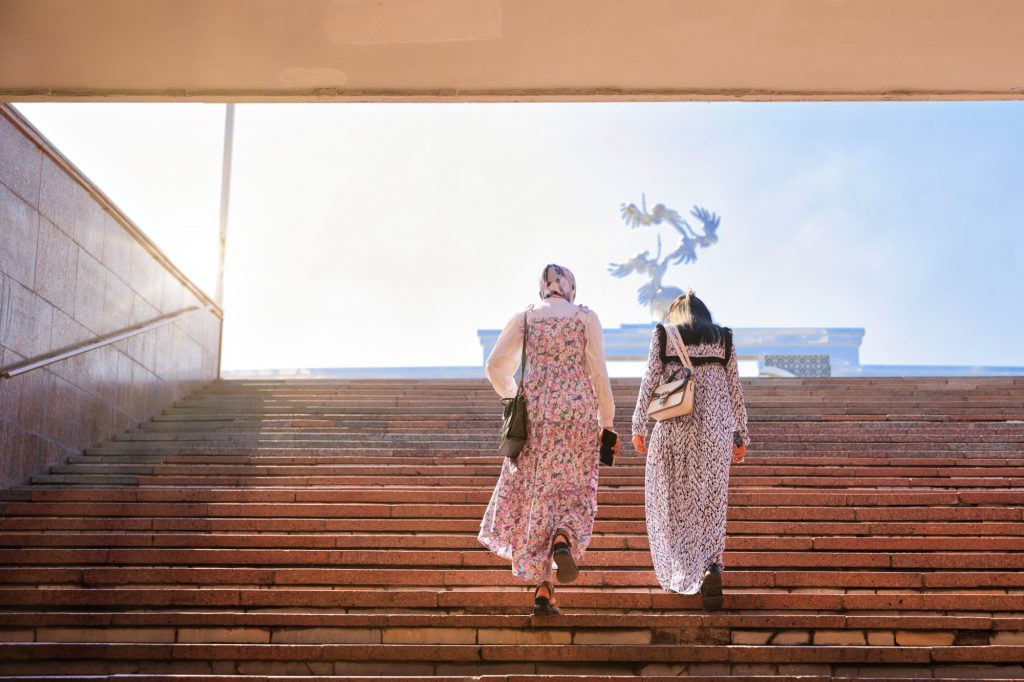
Beim Verlassen der U-Bahn gingen wir zurück zu unserem Auto und passierten das Alsiher-Navoi-Opern- und Balletttheater, ein elegantes Gebäude mit einem Wasserbrunnen davor in Form einer blühenden Baumwollpflanze. Esther wunderte sich, warum keiner der Brunnen in der Stadt in Betrieb war. Als ob das jemand gehört hätte, erwachte plötzlich der Brunnen vor dem Theater zum Leben. Es war ein hübscher Anblick, wie das Wasser aus der Baumwollblüte spritzte.
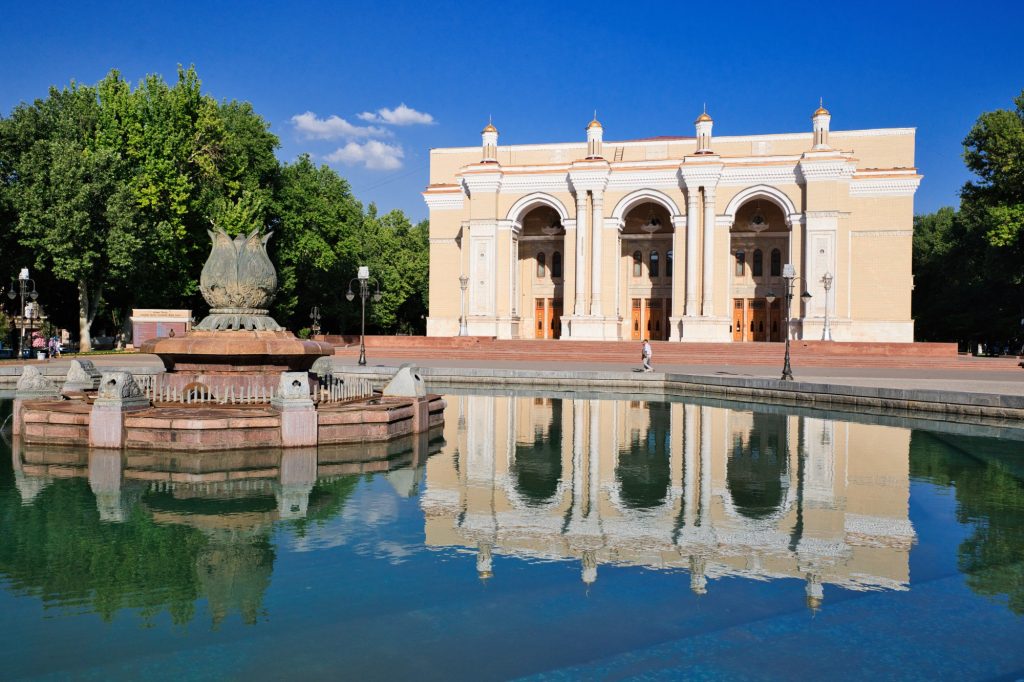
Unser letzter Stopp an diesem Tag war der Fernsehturm, ein 375 Meter hoher Turm im sowjetischen Stil mit einer Aussichtsplattform und einem Drehrestaurant (ähnlich wie wir es in München haben, aber etwas kleiner und daher doppelt so schnell drehend, womit eine Umlauf 30 Minuten braucht).
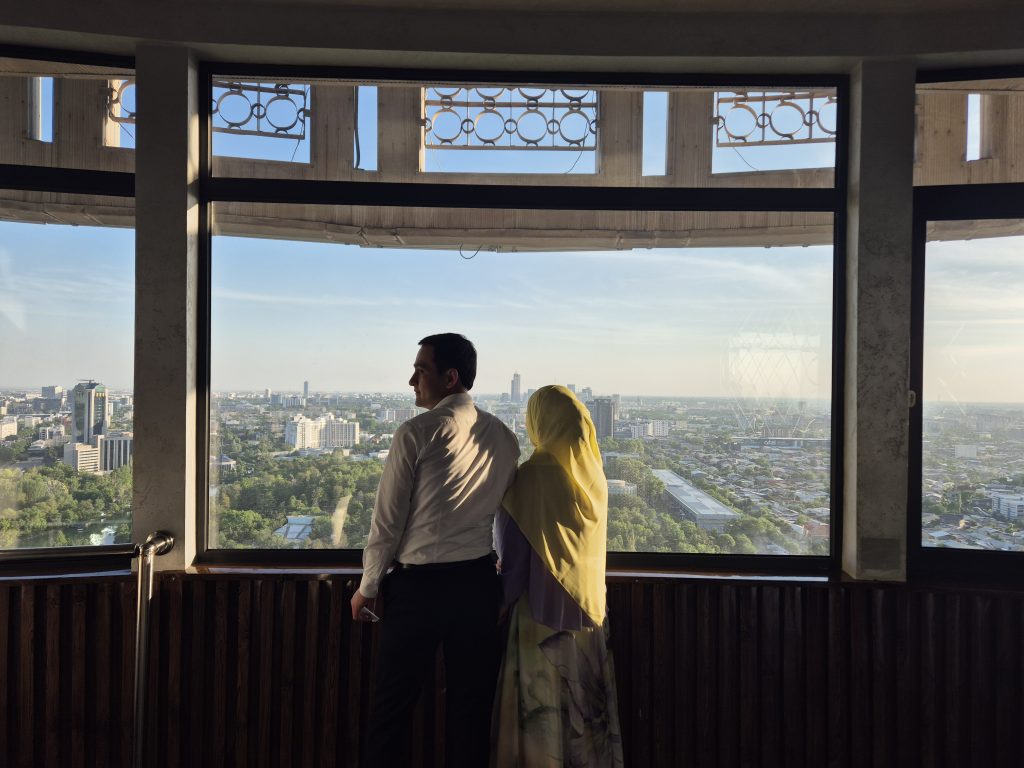
Wir gingen zur Aussichtsplattform hinauf, die großartige Ausblicke über die ganze Stadt bot. Wir waren erstaunt, wie grün Tashkent von oben aussah. Viele Bäume und ein kleiner Kanal, der durch die Stadt führte.
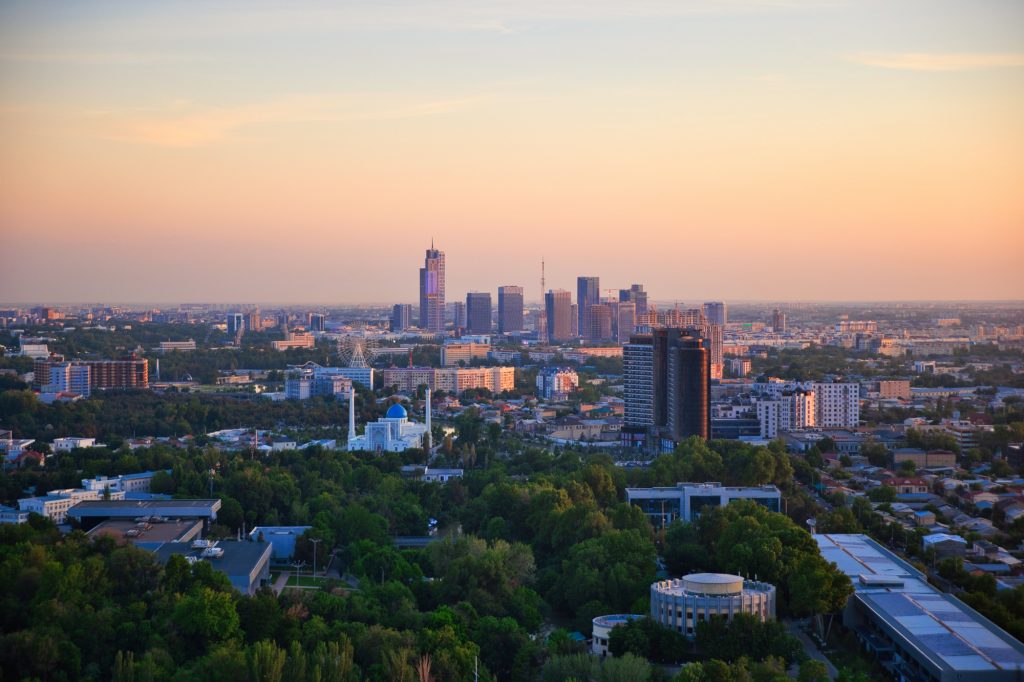
Da wir ein wenig hungrig waren, versuchten wir unser Glück im Restaurant zwei Etagen über der Plattform. Alle Tische waren reserviert, aber wir durften an der Bar sitzen und ein Glas Usbekischen Weins und eine köstliche Vorspeise genießen: knusprige Auberginenwürfel mit Frischkäse. Genau das Richtige für Esther!
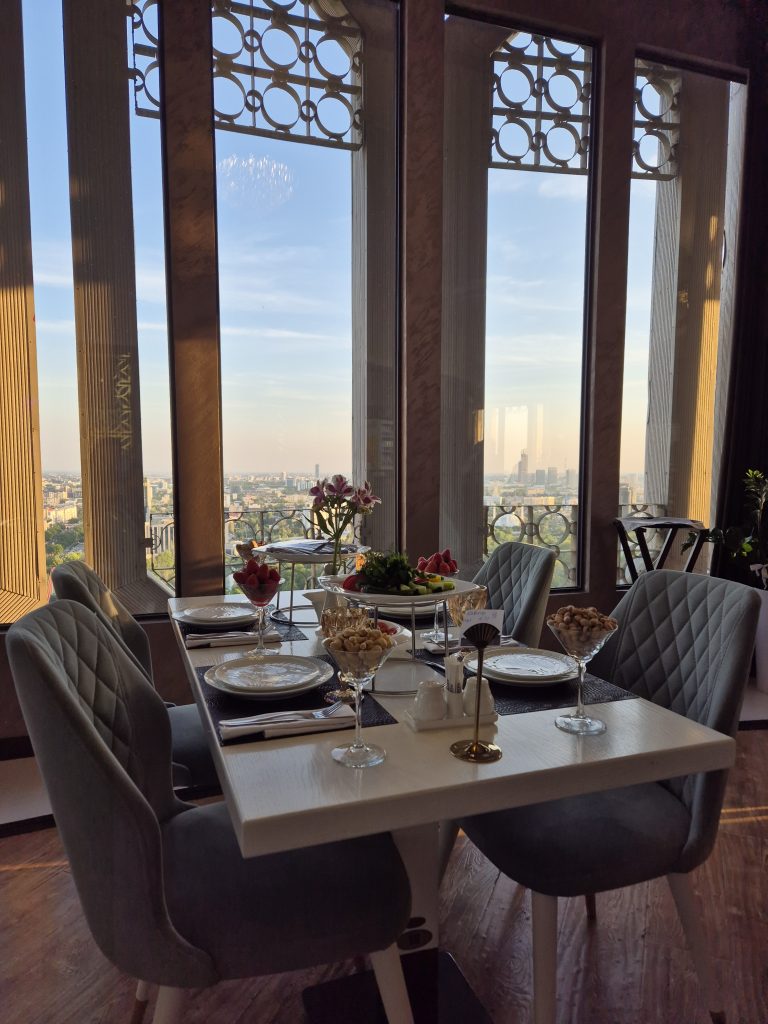
Wir unterhielten uns mit Inom und dem Barkeeper, nippten an unserem Wein (und ja, es gibt lokalen Wein, der trinkbar ist) und erlebten einen sehr schönen Sonnenuntergang über Taschkent. Kein weiteres Essen für uns, wir waren glücklich, einfach ins Hotel zurückzukehren, und für den nächsten Tag zu packen, denn wir müssen früh aufbrechen, um nach Samarkand zu gelangen, was normalerweise eine vierstündige Fahrt mit dem Auto oder 2,15 Stunden mit dem schnellen Afrosiyob-Zug ist.
Weiter zu Tag 7
Today we set out to discover Tashkent with Inom. Inom has a black Chevrolet. This is unusual we discovered, as 90% of all cars here are white, and 80% of all cars are Chevrolets. So the most frequent cars here are all white Chevrolets.

This seems quite peculiar at first until you learn that Chevrolet has some big factories here in UZ and those are locally produced cars. In 2008, General Motors and the government of Uzbekistan joined forces to form GM Uzbekistan and mass-produce Chevrolet-branded cars. The government held a 75% ownership stake, while GM had 25%. To import any car from outside UZ costs a hefty 30% import tax. So everyone but the ultra rich buys local cars. Other cars you might see are mainly asian, with Chinese cars taking over that segment more and more. Here and there you might see electric cars and chargers as well.

We were pleasantly surprised to drive through a clean, vibrant city that had a blend of interesting aspects to it. Not at all boring. You could clearly see the influence of multiple centuries in the architecture and art styles. Old timuresque style buildings and bazaars, traditional islamic medrassas that were not destroyed by the Russians, a Soviet style TV tower and very modern buildings springing up at every corner of the new part of town.

We began our journey by visiting Khast Imom Islamic religious center which is a fairly new construction but next door an even bigger one is being built as we visited – funded by Saudi Arabia. Khast Imom consisted of a mosque, medrassa (quoran school) and the Moyie Mubarek Library Museum grouped around a large courtyard.

The library houses the oldes known Quoran book. Written on deer skin it lies in a climatized glass coffin surrounded by hundreds of Quoran copies of all shapes, sizes and languages. The smallest book we saw was barely 2 cm tall. There was also a hebrew version of the holy Quoran.

On we went to the Museum of Applied Arts showcasing the various arts and craft skills of Uzbekistan. Silk weaving, textile printig, wood carving, tile making and other ceramics of a variety of ages were displayed. The ability and know-how to produce silk and paper was for the longest time a secret kept by the Chinese. But as the Chinese empire was in dire need of horses to defend their territory, the turks (standing for all turk nations) were able to swap horses for the secret of silk and paper making. Since then Fergana Valley in Uzbekistan is known not only for it’s great horses but also for silk making.
We decided it was time for lunch and Inom drove us to the Central Asian Plov Center Besh Qozon. There in a large building all you can get is various types of Plov, the national dish of Uzbekistan. Their Plov is made in four meter wide cauldrons over wood fires. Huge chunks of meat and fat are being cooked for hours, carots, onions and spices added and the rice on top. It takes several hours for it to cook, so they had 8 or 9 of different large Plov cooking stations going at the same time.


We sat down inside and ordered: Beef Plov with a slice of horse meat for Chris, a large tomato and onion salad for Esther both served with Non, the traditional Uzbek round loaf of bread.

While Chris’ Plov was supposed to be rice and beef, it still tasted of mutton thanks to the mutton fat that was used to make the Plov even richer in taste. Esther just tried one bite, Chris picked at the beef but really could not eat the oily, mutton infused rice. We much preferred the ultra light chicken variant of Plov that Borat had cooked for us, but maybe we have had enough Plov for this vacation already.

Next stop was the Amir Timur statue right in front of the iconic Hotel Uzbekistan, the quintessential soviet style hotel. Amir Timur is probably as famous and important for the local history as Djingis Khan was.

From a young age, Timur showed dedication to the traditions of the nomadic steppe people, excelling in horse riding and archery. After being wounded in battle, he was left paralyzed in his right arm and leg, earning him the nickname “Timur the Lame.” He became governor of Shahrisabz at 25 through a strategic marriage, swiftly establishing his rule through conquests. Timur’s empire, known as the Timurid Empire, extended across Central Asia, Afghanistan, Pakistan, parts of India, Iran, Iraq, the Caucasus, Syria, and parts of Turkey.

Timur not only brought war spoils to Samarkand (our next top) but also artisans and craftsmen from various lands. Consequently, other cities in his empire were adorned with architectural masterpieces that define Uzbekistan until today. He died during a campaign in Kazakhstan, on his way conquering parts of China, with his legacy living on in the architectural marvels of Samarkand, where he was buried. His military prowess relied on mobility, surprise, and strategic patience, which enabled him to expand his empire significantly.

From there we walked through the „boulevard“ a pedestrian zone with little antique stalls like a flea market and small street food vendors until we came to one of Tashkents Metro stations.

We boarded our train at Mustaqillik Maydoni Station, changed in Alisher Navor and ended up in Kosmonavtlar, the most famous station also called ‘the space station’.

Tashkent Metro is really something to experience. It is like traveling through a museum by train.

Leaving the metro, we walked back towards our car passing the Alsiher Navoi Opera & Ballet Theatre, an elegant building with an empty water fountain in front in form of a budding Cotton plant. As Esther had noticed before, none of the citys fountains we passed were working. As if someone heard that she liked fountains, all of a sudden the fountain in front of the theatre sprang to life. It was a pretty sight with water coming out of the cotton bud.

Our last stop for that day was the TV Tower, a 375 meter high soviet style tower with an observatory deck and a rotating restaurant (like we have in Munich, but somewhat smaller and thus moving at double the speed, taking 30 minutes for one 365 degree circle).

We went up to the observatory deck which offered grandiose views all over the city. We were amazed at how green Tashkent looked from above. Lots of trees and a small canal running through it.

As we felt a bit peckish, we tried our luck in the restaurant two floors up from the deck. All tables were booked , but we were allowed to sit at the bar and have a nice glass of wine and a delicious appetizer: crispy aubergine cubes with cream cheese. Yummy!

We chatted with Inom and the bar tender, sipping our wine (and yes, there is local wine that is drinkable) and watching a very nice sun setting over Tashkent. No more food for us, we were happy to just return to the hotel, pack for the next day as we need to leave early for Samarkand, which usually is a four hour ride by car or 2.15 h with the fast Afrosiyob Train.
Es stellte sich heraus, dass die Entscheidung, die Nacht in einer Datscha zu verbringen anstatt im Zelt, die beste Idee überhaupt war. Nicht nur regnete es die ganze Nacht über in Strömen, sondern es regnete auch den gesamten Morgen hindurch weiter. Es regnete so stark, dass Inom eine Sequenz von sich im Regen filmte und auf Instagram teilte. Allein die Vorstellung, wie unsere Ausrüstung im Zelt nass wird, einschließlich unserer Schlafsäcke, und dieses nasse Bündel packen zu müssen, dann stundenlang zu reiten während es weiterhin in Strömen regnet, war wirklich nicht sehr verlockend.
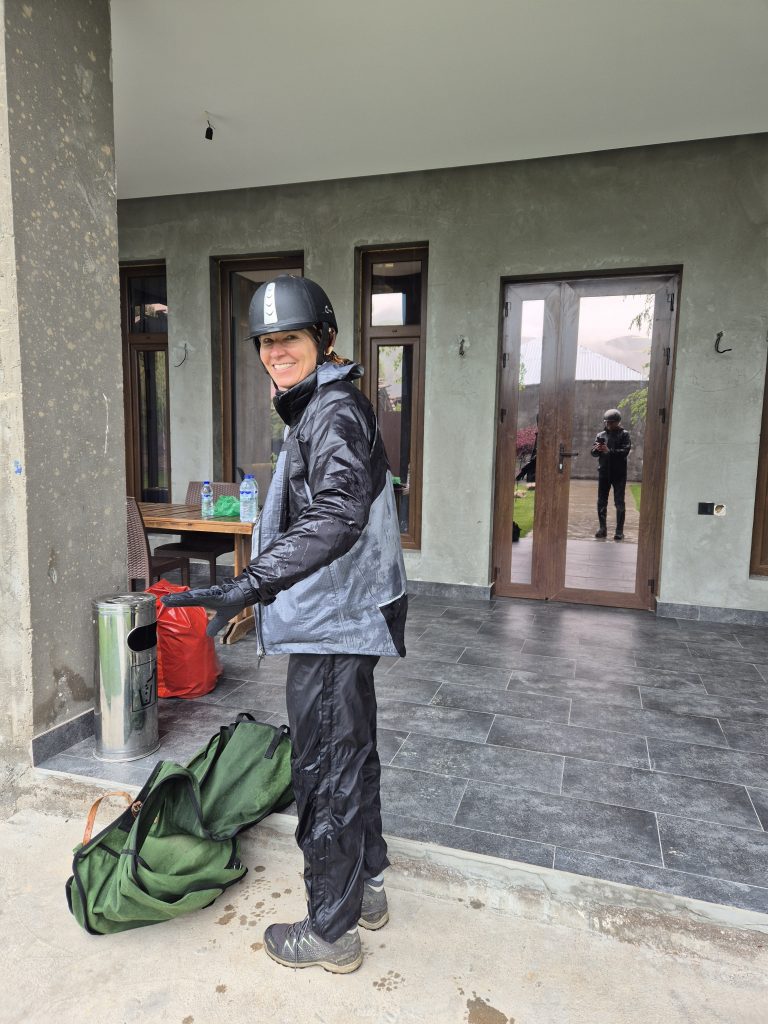
Und selbst wenn wir gewollt hätten – die starken Regenfälle hatten die Lehmpfade, auf denen wir gestern geritten waren, in Schlammrutschen verwandelt. Zu gefährlich für Pferd und Reiter oder zumindest kein Spaß mehr. Also entschieden wir uns stattdessen für einen entspannten Morgen vor dem Riesenbildschirm auf dem wir uns Koʻpkari, den usbekischen Nationalsport ansahen. Koʻpkari wird nur während der kälteren Jahreszeit im späten Herbst und frühen Winter (Oktober bis Dezember) gespielt und ist hier so bedeutsam und beliebt wie bei uns Fußball. Es ist ein abgefahrenes Spektakel. Beispiele finden sich hier, hier und hier.
Zwischen hundert und bis zu eintausend Reiter (nur Männer dürfen mitmachen) auf Hengsten versammeln sich alle auf einem riesigen Feld mit einem weiß umringten Kreis.
Eine geschlachtete und enthauptete Ziege wird mit Salz gefüllt, um genau 70 kg zu wiegen, und irgendwo auf dem Feld abgesetzt. Auf ein Kommando stürzen sich alle Reiter auf die Ziege, um sie aufzuheben und einmal im Kreis um das Feld herum zu tragen, bevor sie versuchen, sie in den weißen umringten Kreis abzuwerfen. Ein Reiter schnappt sich den Kadaver, und 999 andere versuchen, ihm diesen wegzunehmen.
Es folgt eine unwirkliche Szenerie von sich aufbäumenden Pferden, Pferden, die mit Peitschen geschlagen werden, ein Chaotischer Haufen, der sich solange dreht, bis es irgendein Reiter schafft, die Ziege im Kreis abzulegen, nachdem er den Körper der Ziege unter seinem Knie festgeklemmt und am Bein festhaltend gegen die Meute verteidigt hat.
Sobald ein Reiter mit der Ziege entkommt, beginnt eine wilde Pferderaserei und Jagd, bei der die Ziege manchmal auseinandergerissen wird. Es gibt eine sehr angesehene Gruppe von koʻpkari-Reitern, die Profis sind, ähnlich vielleicht den Rodeo-Cowboys in den USA. Man muss verrückt sein, Verletzungen sind zu erwarten, aber der Respekt der Nation ist ihnen sicher. In Deutschland wäre dieses Spiel natürlich sofort verboten. Es gibt nur wenige Regeln, und die betreffen eher das, was getan werden muss, damit ein Tor zählt, als Regeln, was auf dem Pferderücken zu tun oder zu lassen ist. Das Schlagen eines Pferdes ist in Ordnung (halal), ebenso wie das Ziehen an einem anderen Zügel. Aber der Reiter darf nicht geschalgen werden. Das ist haram (nicht erlaubt). Aber mit Schubsen, Stoßen anderer Form brutaler Gewalt muss gerechnet werden.
Die Teilnehmer sind allesamt sehr robuste, kräftige junge Männer auf muskulösen kleinen Hengsten, die einerseits stark genug sind, um 190 kg (120 für den Reiter und 70 für die Ziege) zu tragen, und andererseits cool genug sind, um nicht in Panik zu geraten, wenn sie in einem Meer von Pferden eingeklemmt sind, die sich so eng zusammen bewegen und drängen. Aber es muss auch sehr schnell sein, sonst werden die anderen Reiter aufholen und versuchen, die Ziege aus den Händen des Reiters und unter seinem Knie zu reißen.
Ein Spiel kann zwischen 20 Minuten und einer Stunde dauern. Und es gibt mehrere Spiele am Tag. Zuschauer umringen das Feld in Massen und die Preise sind oft sehr wertvoll. Sie reichen von einer Vielzahl von Tieren (Kamelen, Rindern, Pferden, Schafen) bis hin zu Autos, Elektronik und natürlich Bargeld. koʻpkari-Pferde werden sehr verehrt, aber nicht verwöhnt. Sie werden vier Monaten auf die koʻpkari-Saison vorbereitet. Besonderes Futter, spezielles Training und zwischendrin meist im Dunklen gehalten. Ein Konzept, das uns wirklich fremd ist.
Nachdem wir einige koʻpkari vom sicheren Sofa aus beobachtet hatten, packten wir unsere Sachen zusammen und fuhren mit dem Auto zurück nach Taschkent.
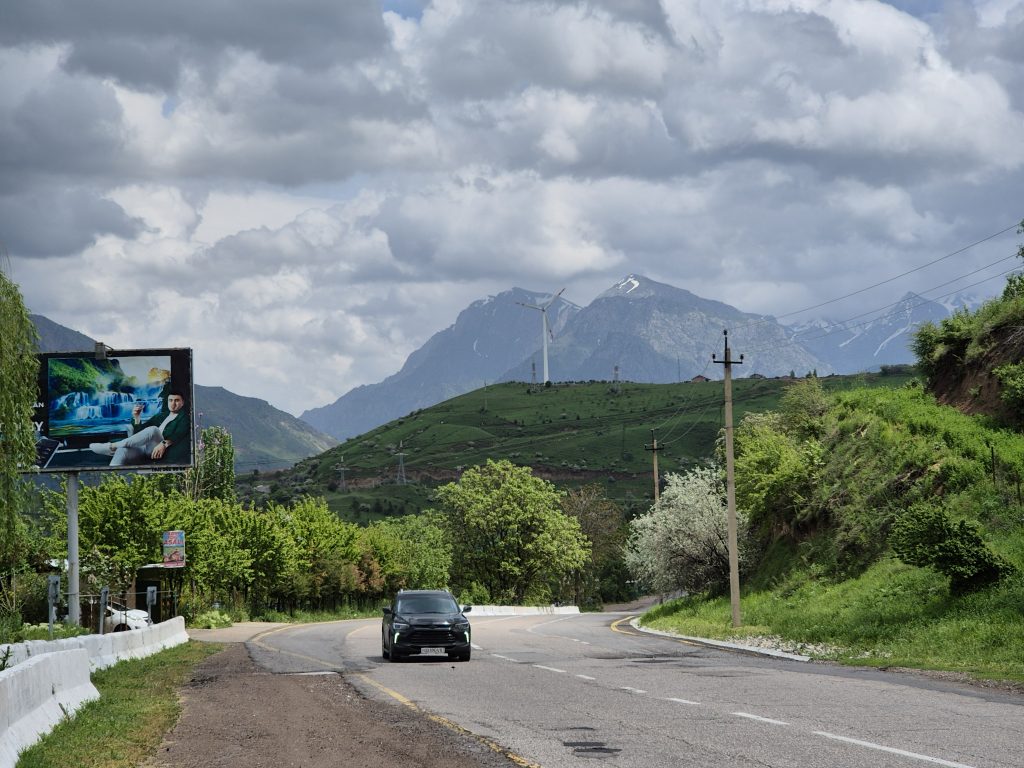
Auf dem Weg machten wir einen Zwischenstopp am Charvak-See, einem großen Stausee mit Damm, der auch als beliebter Erholungsort für Stadtbewohner dient, die saubere Luft und klaren Bergblick in die zwei angrenzenden Länder suchen.
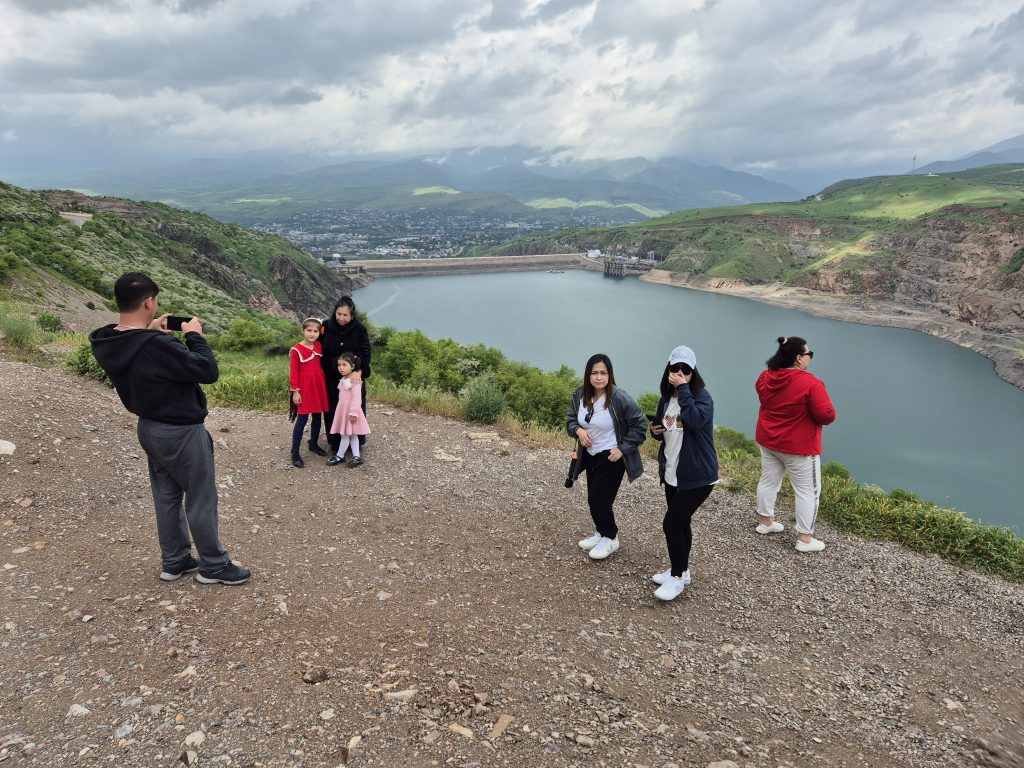
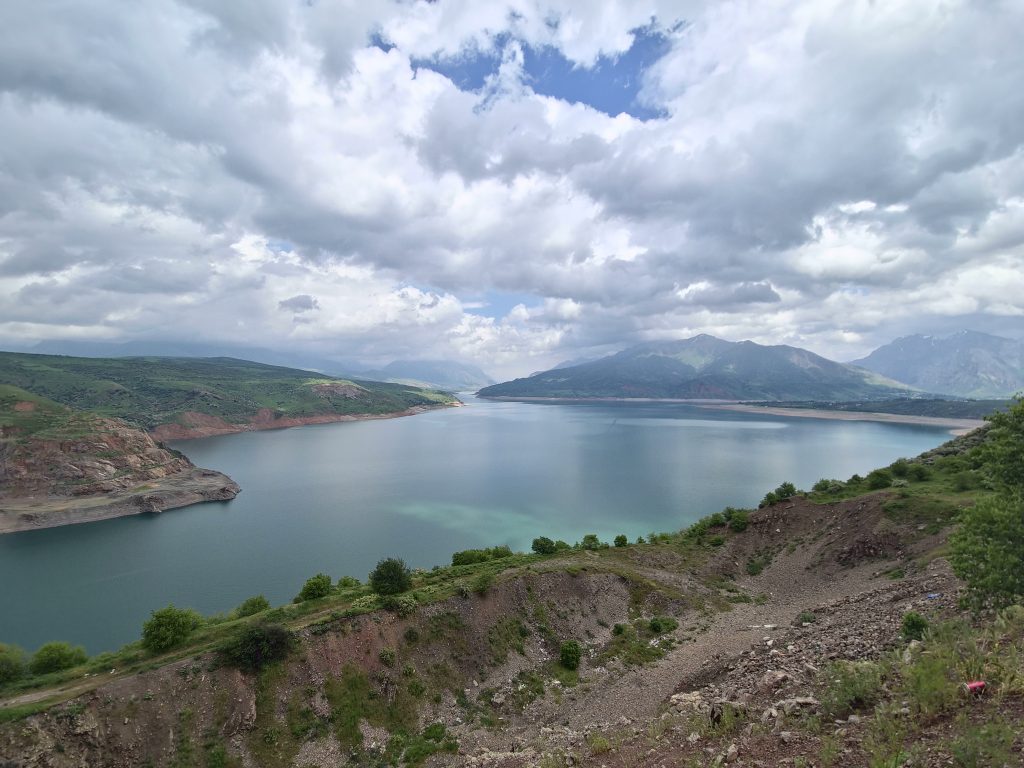
Der Wasserstand war ziemlich niedrig, und wir sahen mehrere von Unternehmen betriebene Ferienanlagen, Überbleibsel aus sowjetischen Zeiten. Mitarbeiter können quasi auf Unternehmenskosten 1-2 Wochen im Jahr im Betriebseigenen All-Inclusive-Appartementhotel übernachten.
Die Rückfahrt nach Taschkent dauerte weitere zwei Stunden und führte an einigen ungewöhnlichen ‘Sehenswürdigkeiten’ vorbei. Reiter auf Eseln, die unerwartet die Autobahn überquerten. Vieh und andere Nutztiere auf wackeligen Anhängern, die von alten Ladas oder Moskwitschs gezogen wurden, die Chris noch aus der früheren Tschechoslowakei kannte.
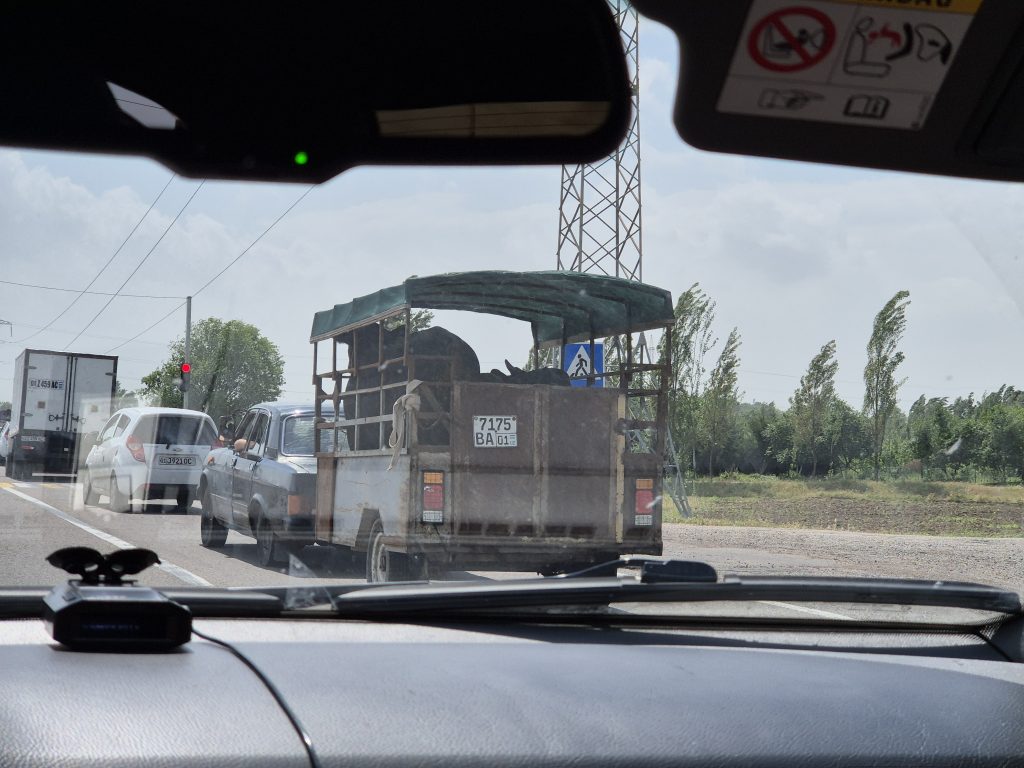
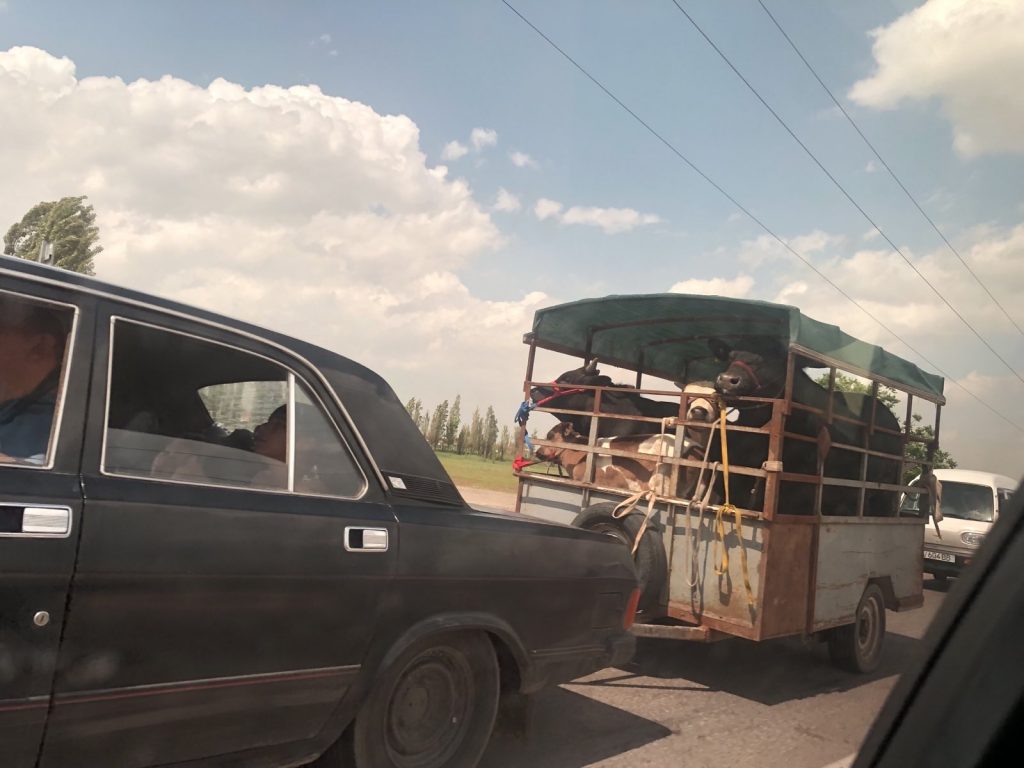
Wir kamen gegen 14 Uhr in Taschkent an und waren ziemlich hungrig. Wir beschlossen, ein spätes Mittagessen mit dem Besuch des größten Marktes von Taschkent, dem Chorsu-Basaar, zu verbinden. Hunderte von kleinen Ständen, die in Abschnitten zusammengefasst sind, verteilen sich über eine riesige Fläche.
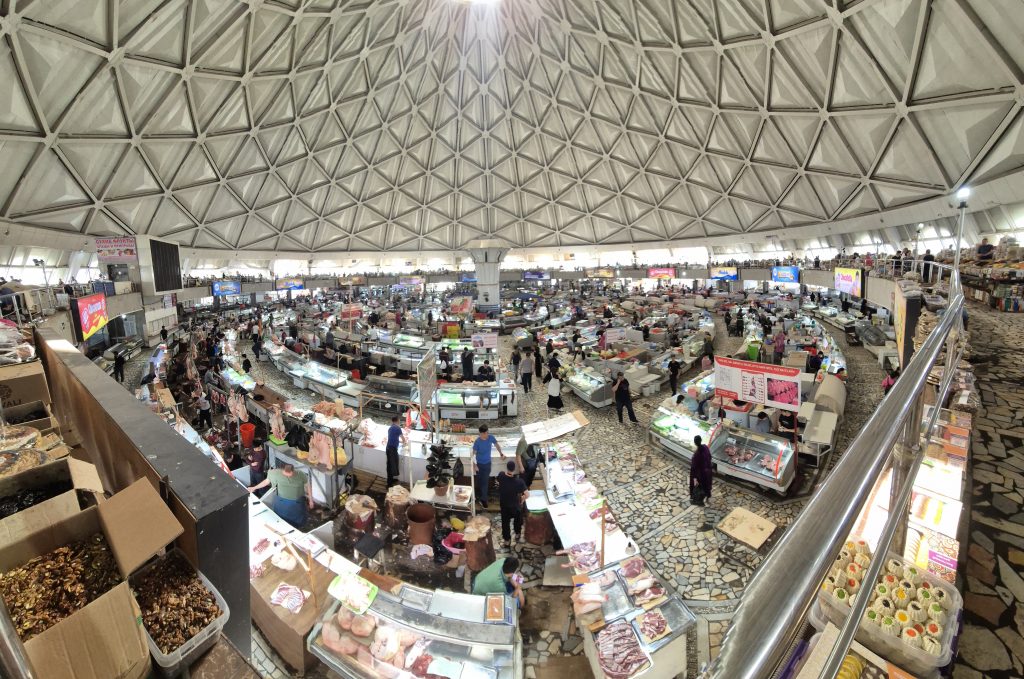
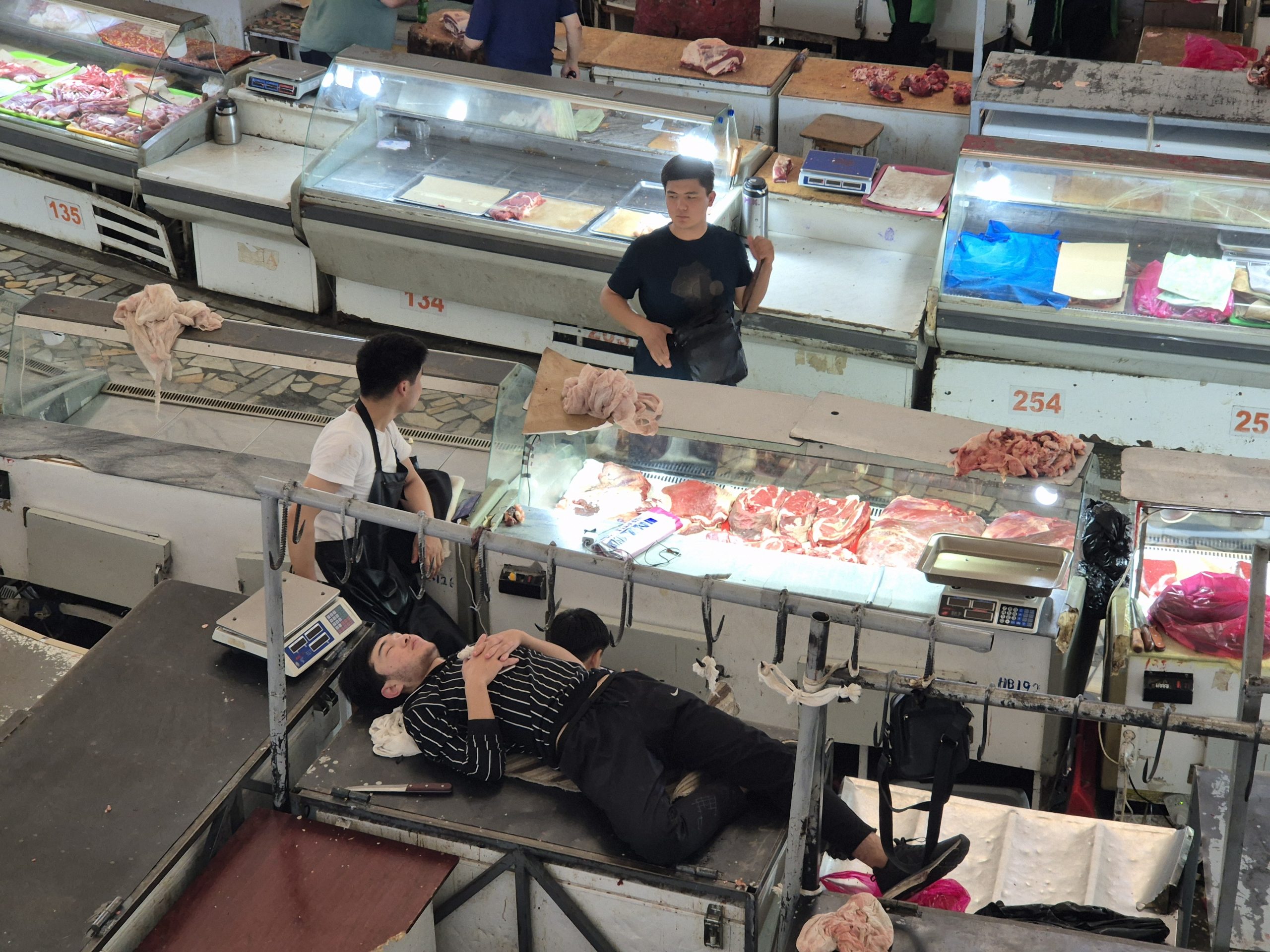
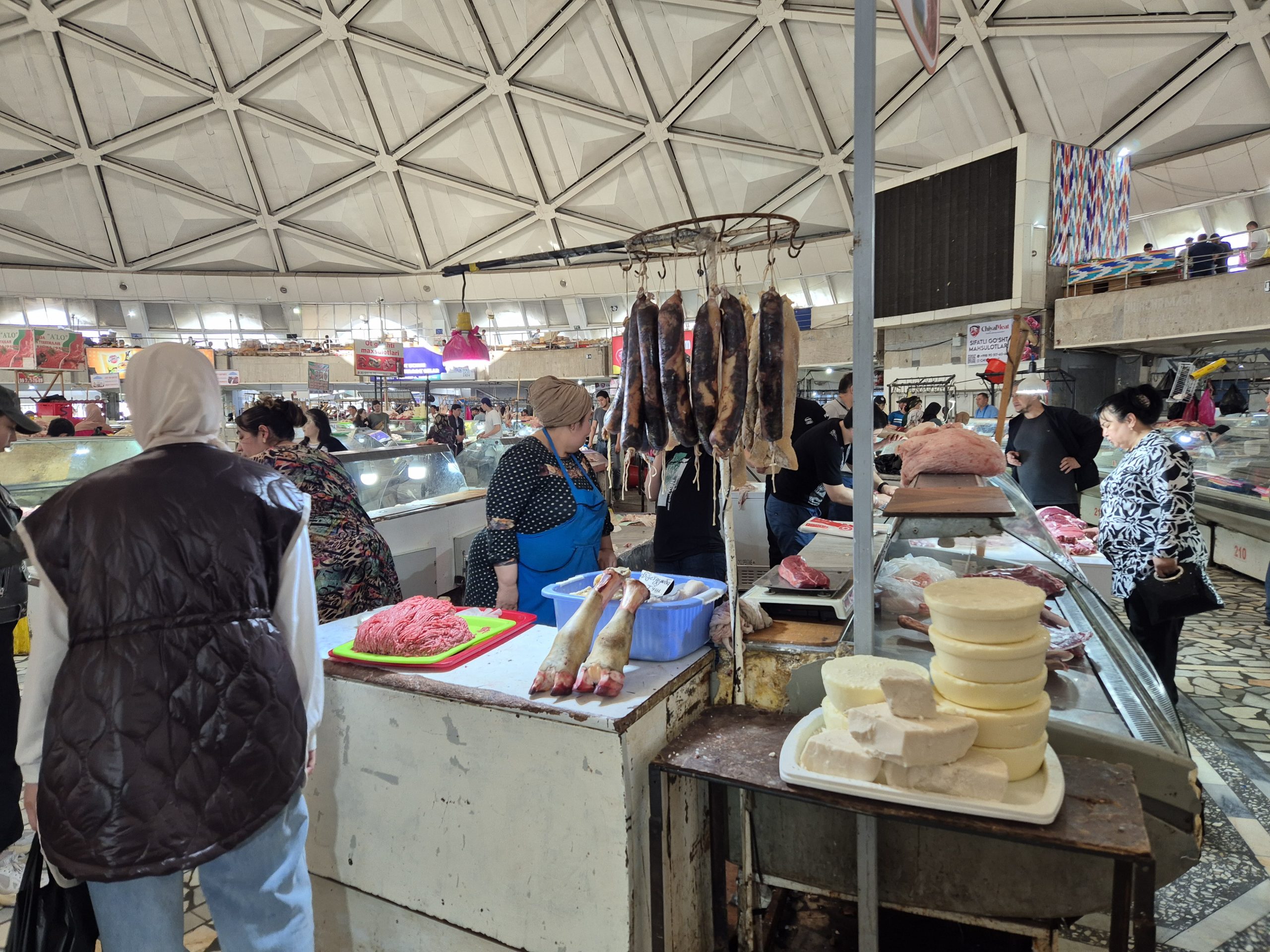
In einer Ecke sahen wir Kleidung, in einer anderen die Haushaltswaren. Wir steuerten direkt auf den Straßenimbissbereich zu, und köstlicher Duft von offenem Grillfeuer umhüllte uns. Usbekistan ist wirklich nichts für Vegetarier. Usbeken sind Fleischesser, und davon gibt es hier reichlich.
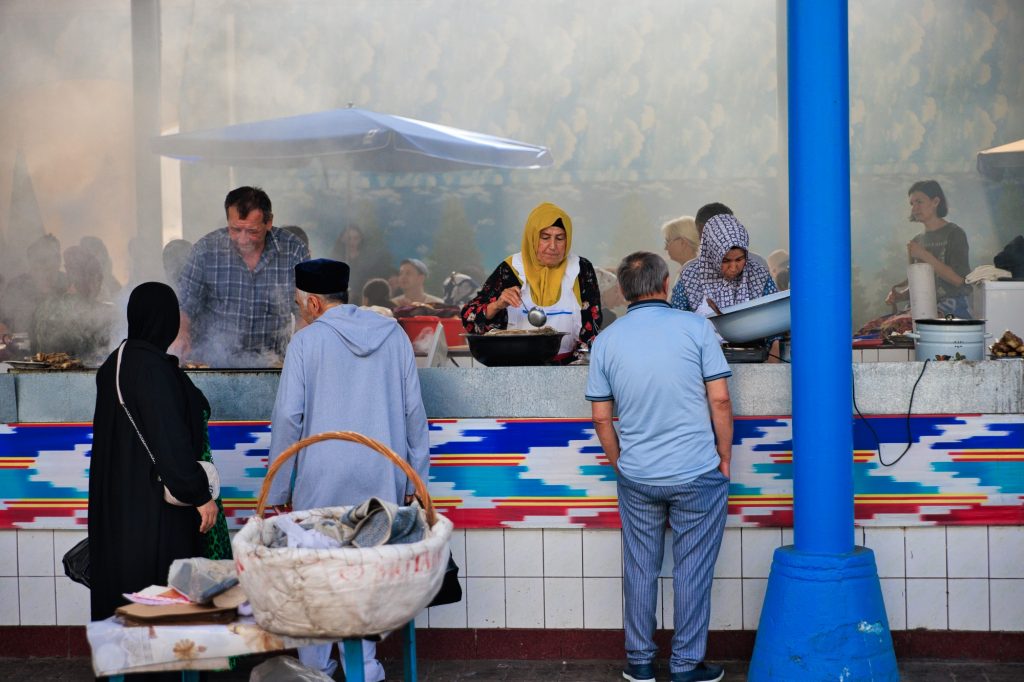
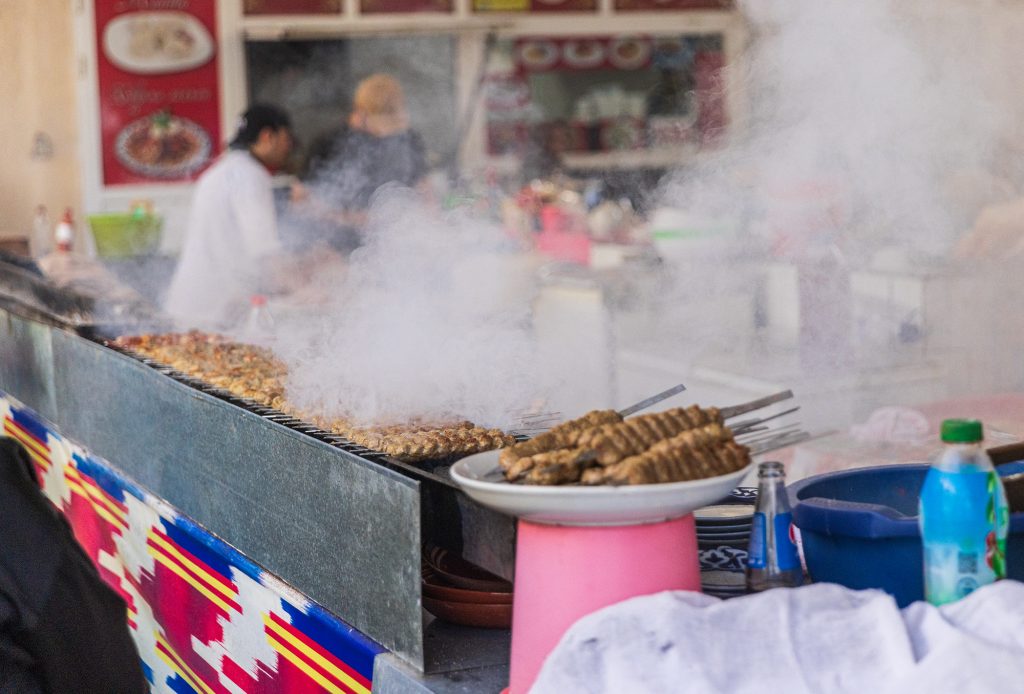
Neben dem Nationalgericht Plov gibt es alle Arten von Kebabs, Schaschliks, Fleischbällchen, Schafsköpfen, usw. Chris und Inom entschieden sich für Schaschlikspieße mit sauer eingelegten Zwiebeln.
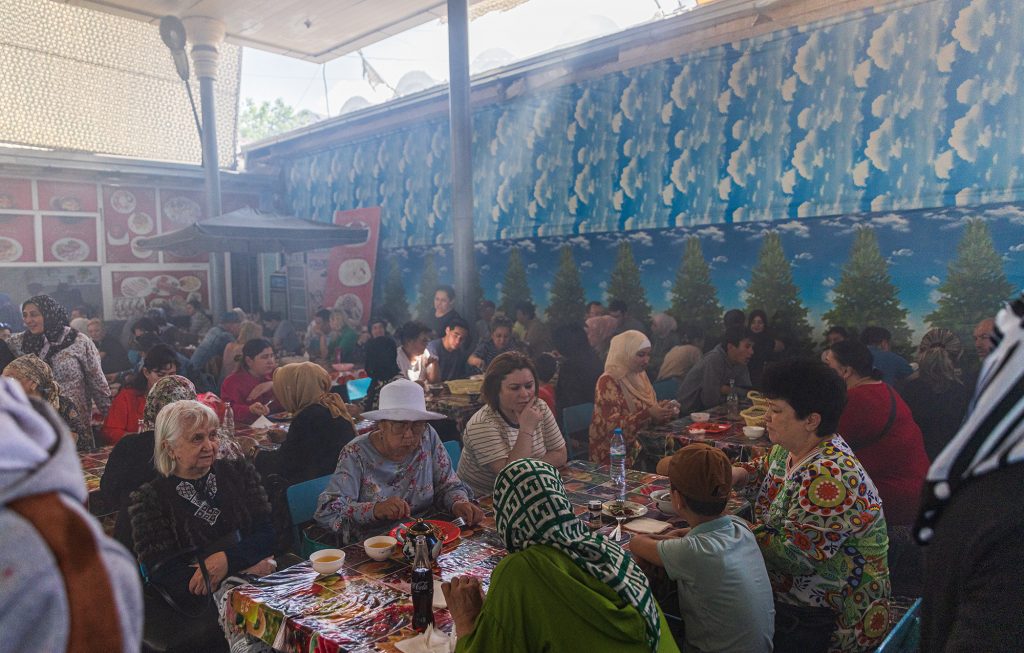
Esther wählte eine Spezialität, und zwar eine der seltenen (genauer gesagt vielleicht sogar die einzige) vegetarischen Optionen: Eine Art großes Dim Sum gefüllt mit Kartoffeln und bedeckt mit einer Art Tomatensauce, darauf Zwiebeln und Fenchel, gennant Hanum. Lange Schlangen bildeten sich um den Stand einer Dame, die dieses Speise anbot. Es schmeckt wie eine übergroße, weiche Ravioli mit Tomatensauce.
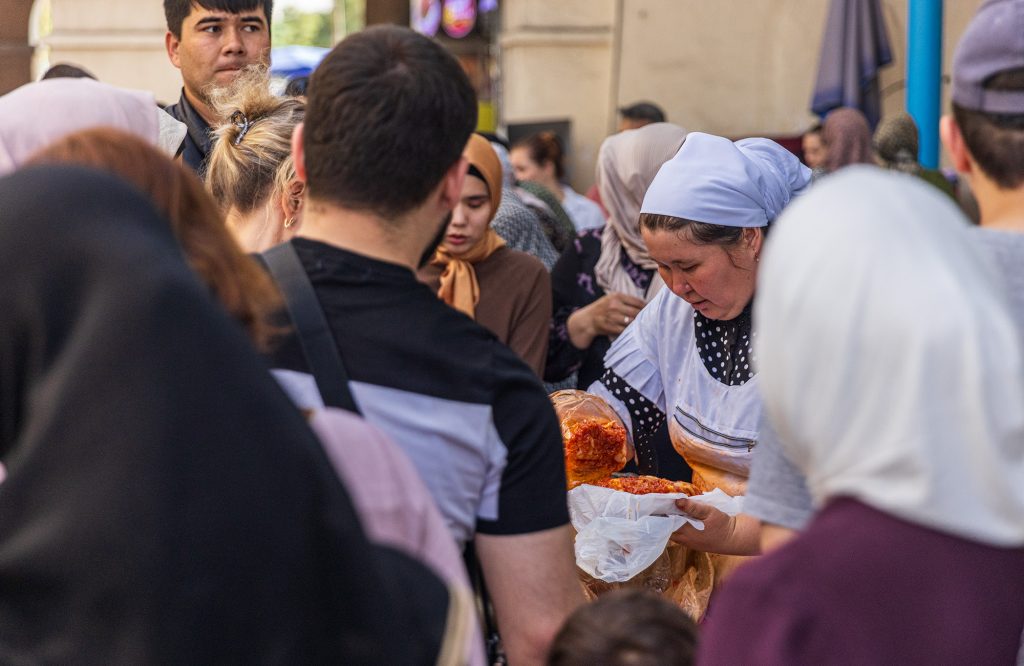
Auf dem Markt lässt sich vermutlich alles finden, was man braucht (oder auch nicht braucht). Die Auswahl ist wirklich überwältigend. Einige Produkte waren uns vertraut, während uns andere uns ein klein wenig eigenartig erschienen oder genauer gesagt: eigenartige Namen trugen. Die Auswahl reichte von Bavaria über Varcagi bis zu Ador. Optische Ähnlichkeiten zu deutlich bekannteren Marken nicht ausgeschlossen.

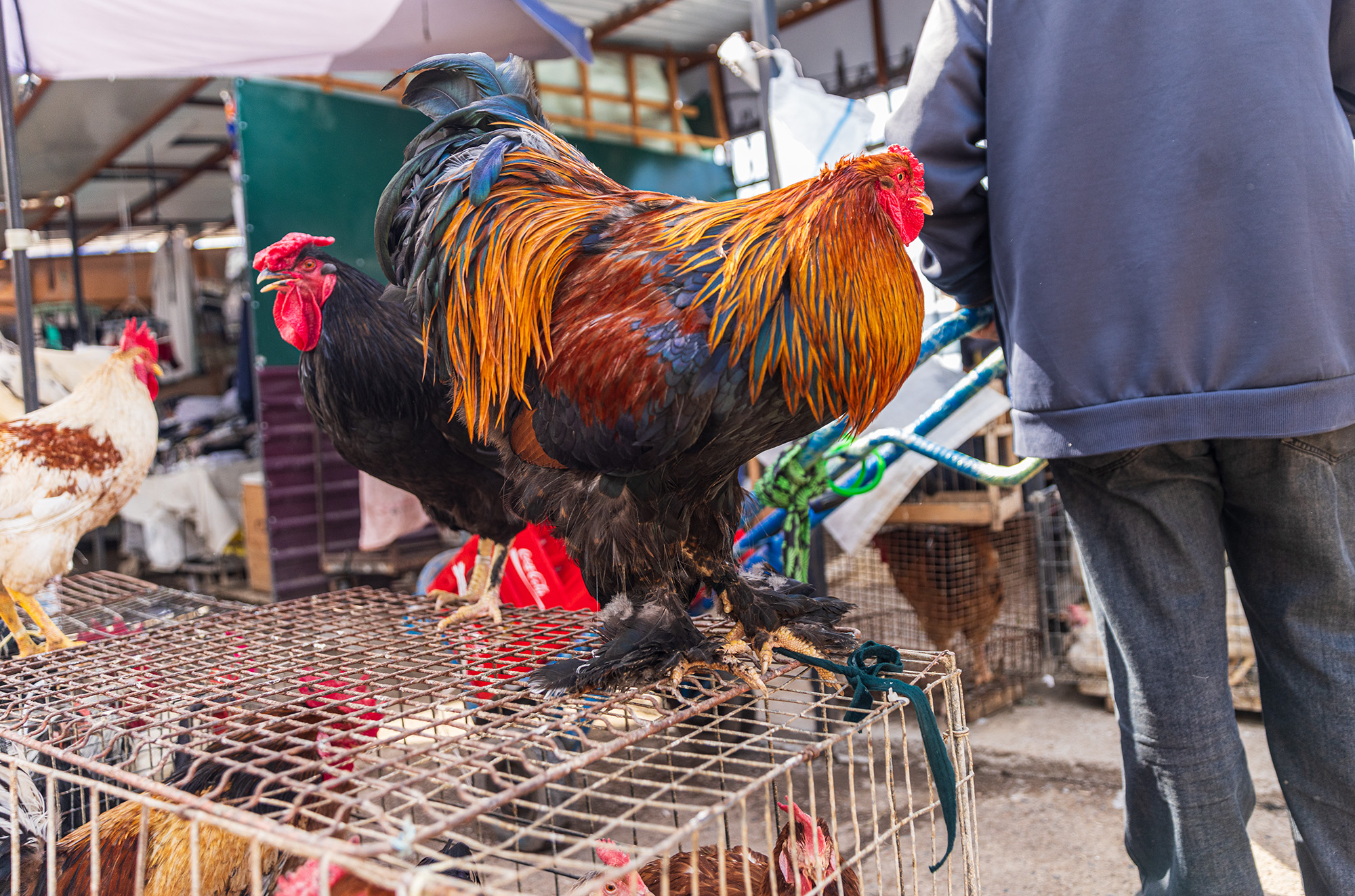
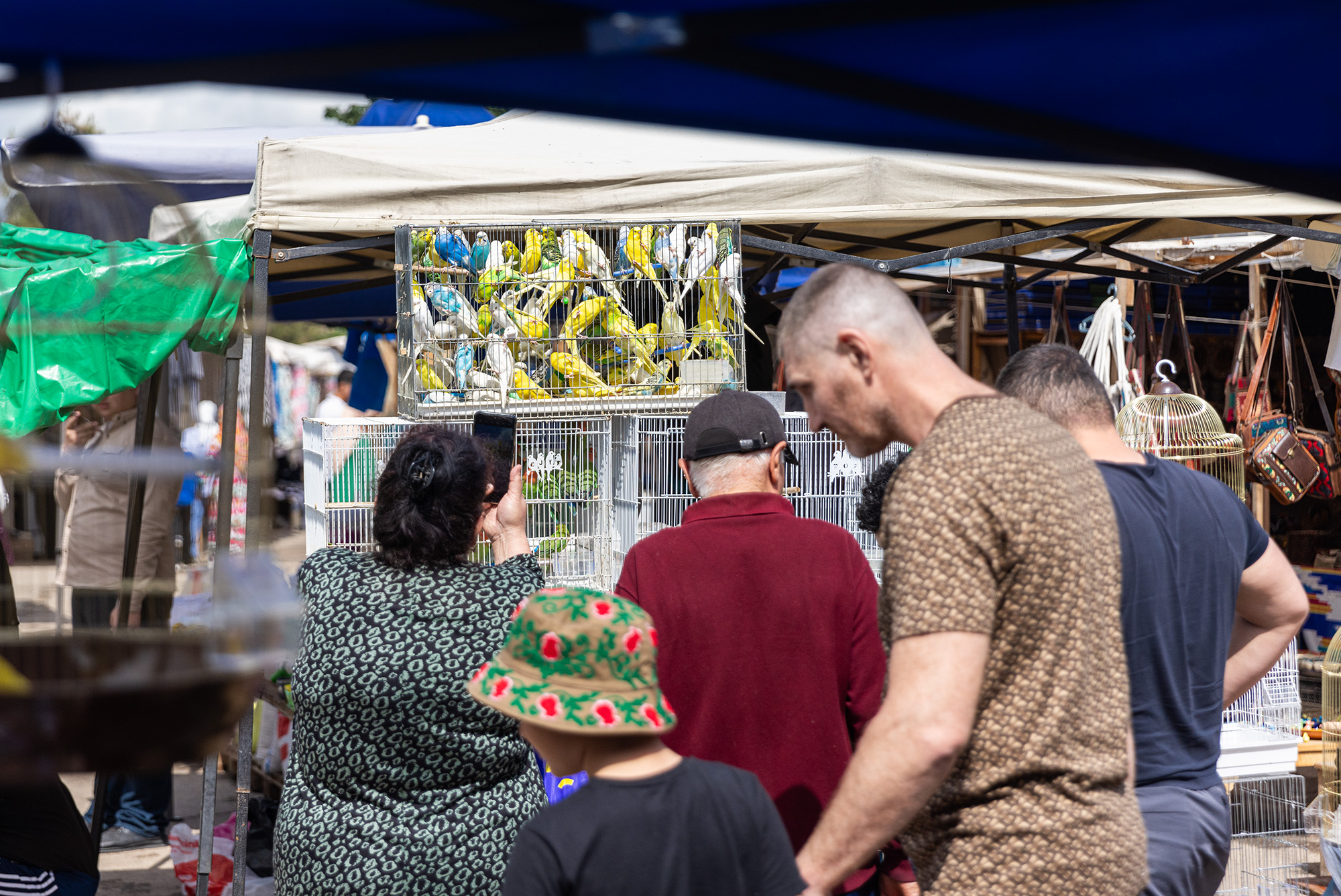
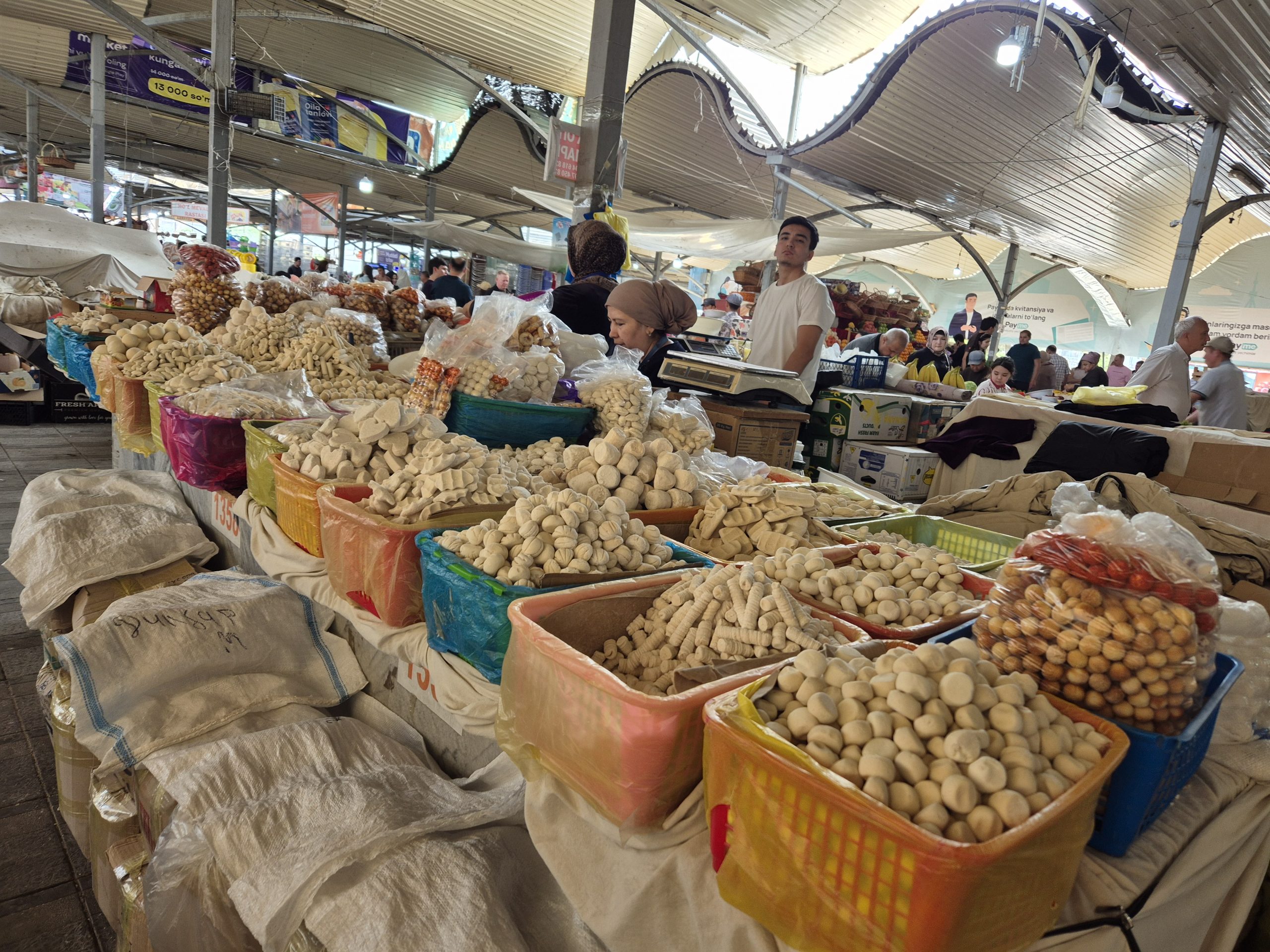
Wir erkundeten ausserdem die Bäckereiabteilung, kauften frischgebackenes, warmes Brot für eine leichte Abendmahlzeit, schlenderten unter der Hauptkuppel, um uns die Fleisch- und Trockenobstabteilungen anzusehen. Wir kauften mehrere Sorten Trockenfrüchte für die Reise sowie frische Gurken, Paprika und Tomaten. Man kann immer erst probieren, bevor man kauft, was wir natürlich auch ausgiebig taten. Wir kauften geröstete Sesamsamen in der Gewürzabteilung sowie eine wunderbar aromatische Früchtetee-Mischung. Mit unserem Abendessen und einigen weiteren Dingen bepackt, machten wir uns auf den Rückweg zu unserer Pension um dort eine heiße Dusche zu nehmen. Dann setzten wir uns in den gemütlichen Innenhof um unseren Blog auf den neuesten Stand zu bringen.
Nach einem leichten Abendessen mit unseren frischen (köstlichen!) Tomaten, Paprika und Gurken sowie Brot fielen wir wie zwei Steine ins Bett.
Weiter zu Tag 6
Turns out the decision to stay over night in a datcha rather than a tent was the best idea ever. Not only did it absolutely pour down all night , it also continued to pour down during the entire morning. It rained so heavily that Inom filmed a sequence of himself in the rain and shared it on Instagram. The sheer thought of having all our gear getting wet in the tent including our sleeping bags and pack everything together in a wet bundle and then spend hours riding while it continues pouring really was not very appealing.

We were supposed to ride another half day today but the heavy rains turned those clay paths we used to ride on yesterday into mud slides. Too dangerous for horse and riders or at least not fun to ride. So we decided on a lazy morning watching koʻpkari, the national (horse) sport, on our giant television screen instead. Koʻpkari are only played during colder season in late fall and early winter ( Oct-Dec), and as popular as soccer. They are a crazy affair. Check some pictures here, here and a video here.
Ranging from a hundred riders up to one thousand horsemen (only men are allowed to play) on stallions are all assembled on a huge field with a white ringed circle in the middle.
A slaughtered and beheaded goat is filled with salt to weigh exactly 70 kgs and is dropped somewhere on the field. On command all riders are dashing for the goat to pick it up and carry it in a circle around the field before trying to drop it in the white ringed middle as a goal. Only one rider can really carry it and 999 others are trying to take it away from him.
What ensues is an unreal scenery of rearing horses, men and horses hit with whips, a mele of chaos that turns around itself for as long as no rider breaks free to take that run in the circle with the goats body clamped under one of his knees and holding onto it for dear life.
Once a rider breaks free with the goat a wild horse race and chase starts with the goat sometimes being ripped apart. There is a very esteemed group of koʻpkari riders that are professionals, similar maybe to Rodeo cowboys in the US. You must be crazy, expect injuries but the respect of the nation is yours. In Germany of course this game would be outlawed in no time. There are few rules and those pertain more to what must be done so that a goal counts, rather than rules what to do or not to when on horseback. Whipping anybody’s horse is OK (halal), taking the others bridle and pulling on it as well. But you do not whip the rider. That’s haram (not allowed). Pushing, shoving with brute force is expected.
The participants are all very sturdy, bulky young men on muscled up small stallions that are one one hand strong enough to carry 190 kgs ( 120 for the rider and 70 for the goat) and cool enough not to panic being squeezed in a sea of horses moving and shoving so tightly together. But it must also be very fast, otherwise once it breaks free the other riders will catch up and try to rip the goat out of the riders hands and under his knee.
A game can last anywhere from 20 minutes to an hour. And there are multiple games a day. Spectators ring the field in masses and the prizes are high. They range from an array of animals (Camels, cattle, horses, sheep) to cars, electronics and of course cash. Kup Kari horses are very revered but not pampered. They are undergoing a special training the four months prior to prepare for the koʻpkari season. Special food, special training and keeping them in darkness during other times. A concept that is truly foreign to us.
After watching a few koʻpkari from the safety of our soft sofa we bundled our belongings together and took a car back to Tashkent.

On the way we stopped on Charvak lake, a big reservoir with dam which also serves as a popular recreation spot for city folk here craving the clean air and clear mountain views into three countries.


The water level was quite low and we saw several company owned holiday retreats, left overs from soviet times. Employees can stay quasi at an all inclusive appart hotel on company money for 1-2 weeks a year.
Driving back to Tashkent took another two hrs , passing some strange sights on the way. Riders on donkeys crossing the highway at unpexpected places. Cattle and other livestock loaded on rickety trailer towed by old Lada‘s or Moskwitch‘s which Chris’ recognizes from former Czechoslovakia.


We arrived around two PM in Tashkent and were quite hungry. We decided to combine a late lunch with visiting Tashkents biggest market, Chorsu Bazaar. Hundreds of little stalls combined into sections cover a vast area.



In one corner we saw the clothes, in another the household goods, we headed straight for the street food section and delicious smells from open barbequeue fires engulfed us. Uzbekistan is not for vegetarians really. Uzbeks are meat eaters and lots of it.


Besides the national dish Plov, they have all sorts of kebaps, shashliks meat balls etc. which Chris and Inom decided for.

Esther chose a specialty and the rare (as in only) veggie option was a sort of large dim sum filled with potatoes and covered in a sort of tomatoe sauce with onions and fennel sprinkled on it called Hanum. Long lines were queuing for that delicacy. It tasted like a oversize soft ravioli.

You can probably find everything you might or might not need at this market. The choice was truly overwhelming. Some products were familiar to us, while others seemed a bit peculiar (or had peculiar names).




We went on exploring the fresh bakery section, buying warm bread for a light evening meal, wandered under the main dome to look at the meat and dried fruit sections. We bought several dried fruit for the trip as well as fresh vegetables. You can always try things out first before buying, which we of course did. We bought roasted sesame seeds in the spice section and a wonderfully aromatic fruit tea mix in the tea section. Packed with our dinner and some more, we headed back to our guest house for a nice shower and settled down to catch up on our blog.
After a light fresh (tasty!) tomatoes, pepper and cucumber with bread dinner we fell asleep like two rocks.
Heute sollte unser dritter Reittag sein. Während der Nacht hatte es ein wenig geregnet und die meiste Zeit genieselt, aber die Wege waren immer noch gut. Für den Vormittag war kein Regen vorhergesagt. Nach einem weiteren herzhaften Porridge-Frühstück packten wir die Zelte weg und machten uns zuerst auf den Weg, um unsere Satteltaschen im Haus von Borat abzuladen, das knapp 40-Minuten entfernt lag. Und da Esther’s Pferd am Vortag einen Hufschuh verloren hatte, mussten wir es neu beschlagen lassen.
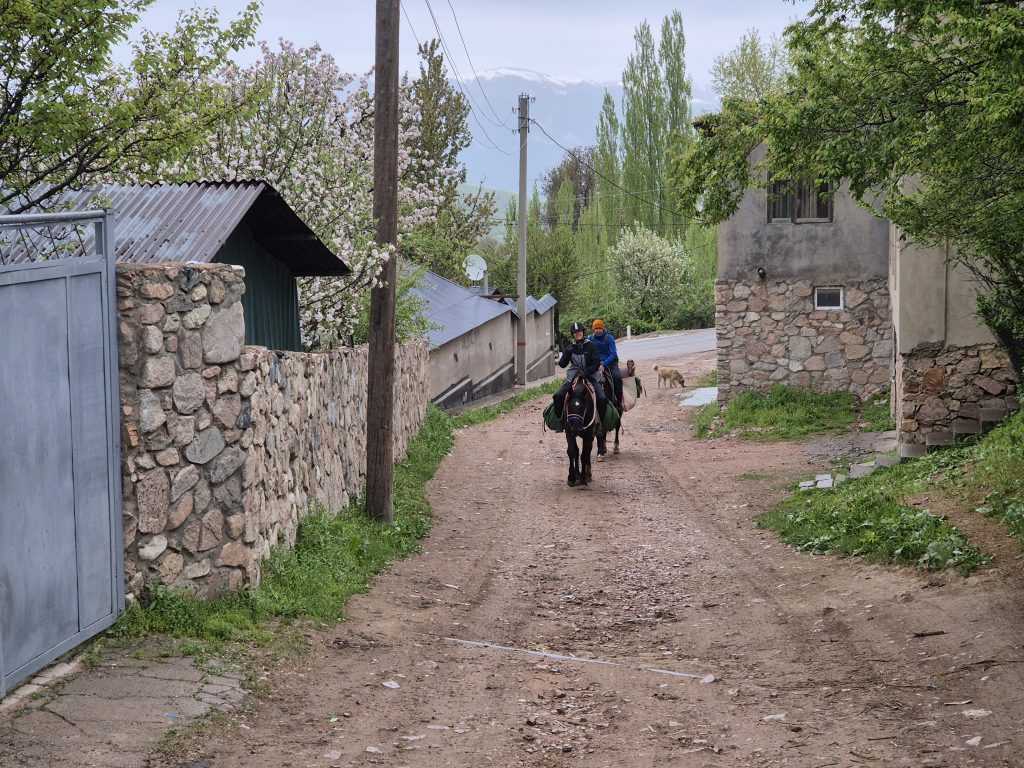
Es dauerte etwas länger als erwartet, und so beschlossen wir, vor dem erneuten Ausritt mit den Pferden zu Mittag zu essen. Unser Ziel dieses Mal war ein großer grasbewachsener Hügel, von dem aus man den großen Staudamm und den See namens Charvak-See überblicken kann. Von dort oben aus sollten wir drei Länder sehen können: Usbekistan, Kasachstan und Kirgisistan.
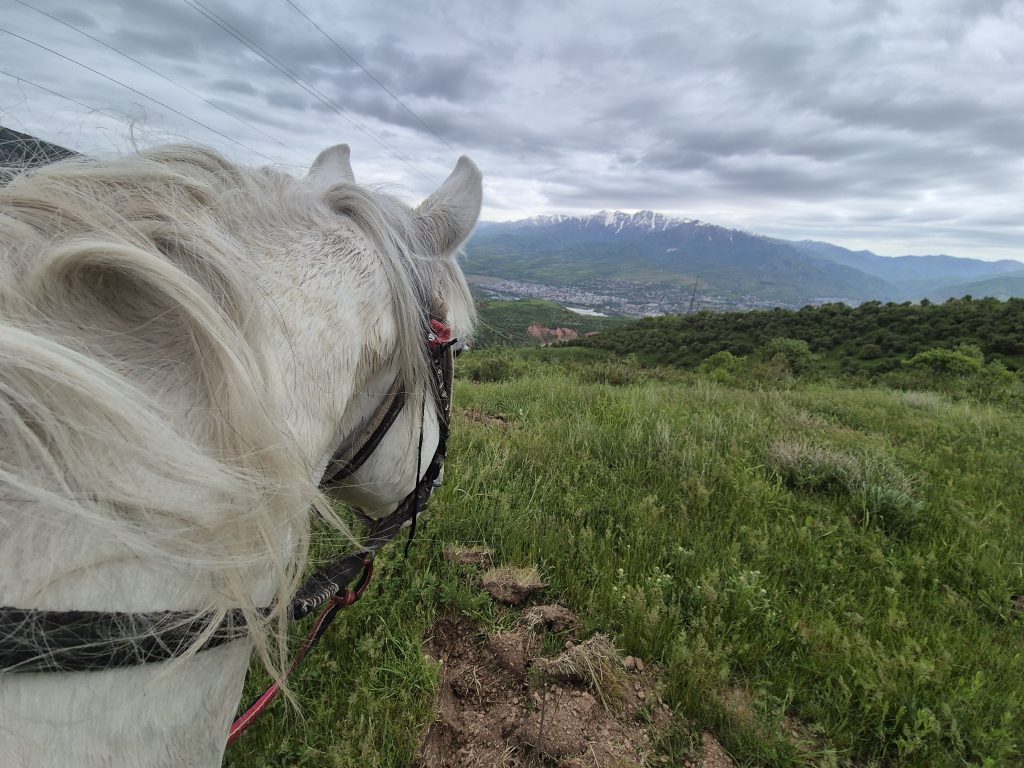
Der Aufstieg war sehr steil, und die Pferde arbeiteten trotz der leichteren Last hart, um nach oben zu gelangen. Aber die Aussicht war die Mühe absolut wert. Leider setzte nun der Regen ein, anfangs nur ein leichtes nieseln, das aber von Minute zu Minute stärker wurde. Wir zogen unsere Regenbekleidung an und machten uns so schnell wie möglich wieder auf den Weg nach unten bevor sich die Wege in Matsch verwandeln konnten. Chris war alles andere als wohl bei dem Gedanken, den steilen Berg runterzurutschen.
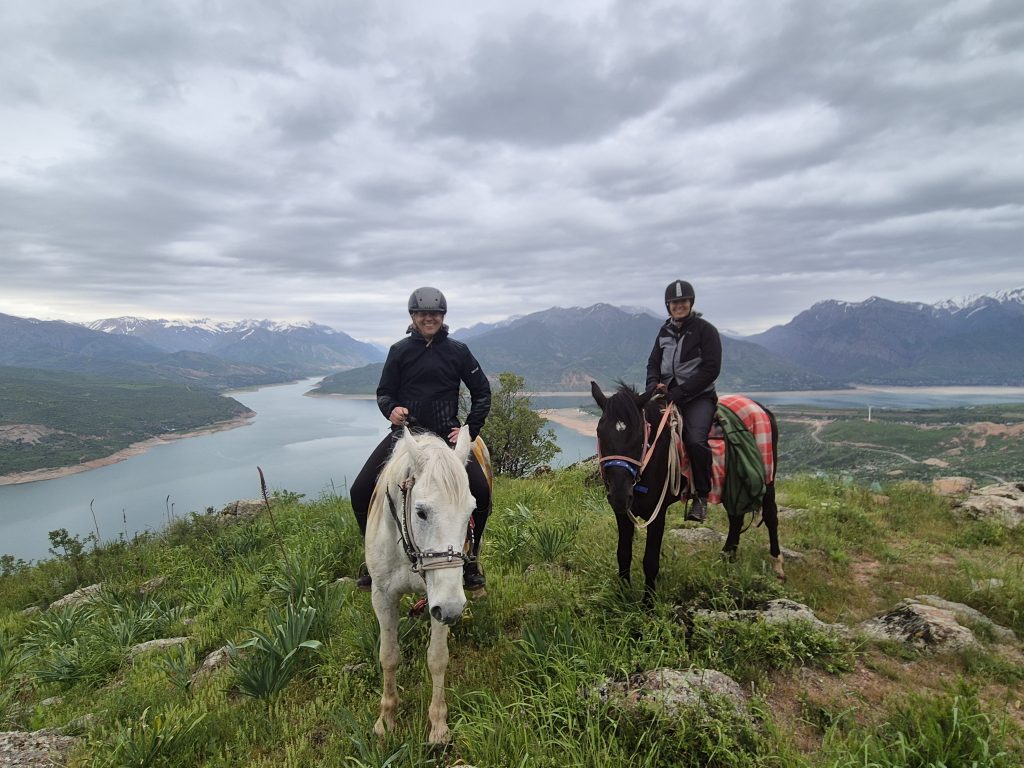
Plötzlich tauchte aus dem Nichts ein junger schwarzer Hengst auf und galoppierte auf uns zu, lauthals wiehernd. Drei unserer vier Hengste wieherten zurück. Aber nicht aus Freude, sondern um ihn in seine Schranken zu verweisen. Denn ein Hengstangriff war das letzte was wir jetzt brauchten. Wir versuchten also, ihn durch Rufen und Winken zu vertreiben. Keine Chance. Er tauchte immer wieder auf, was unsere Hengste richtig aufbrachte. Nur Esther’s Pferd blieb ruhig, die anderen tänzelten, zogen und wieherten herum. Der junge Hengst ging vor uns her, folgte uns, zeigte jedoch kein aggressives Verhalten. Nach und nach wurde klar, dass er keine Herde beschützte und auch keiner angehörte. Er wurde wahrscheinlich von einem älteren Hengst aus seiner ursprünglichen Herde verstoßen und war nun ein einsames junges Tier, das nach neuen Pferdefreunden suchte. Er musste gedacht haben, dass wir seine neuen Pferdefreunde sein könnten.
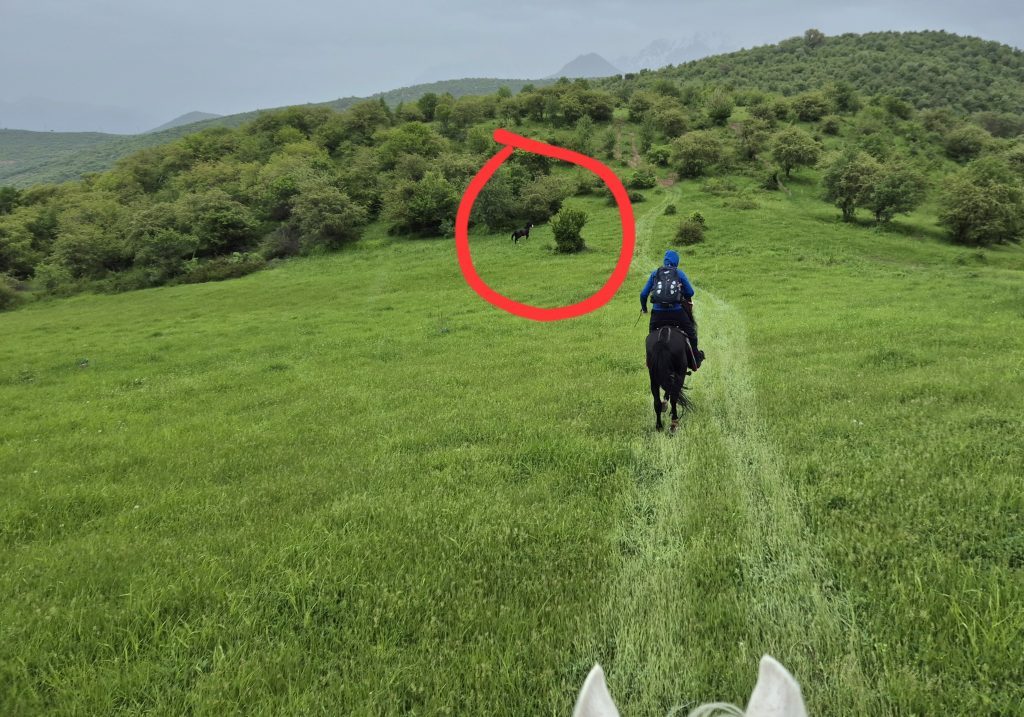
Er folgte uns fast den ganzen Weg zurück zum Dorf, und Borat musste ihn zurückjagen, sonst hätte er uns noch weiter verfolgt. Armer kleiner Kerl. Er tat uns wirklich leid.
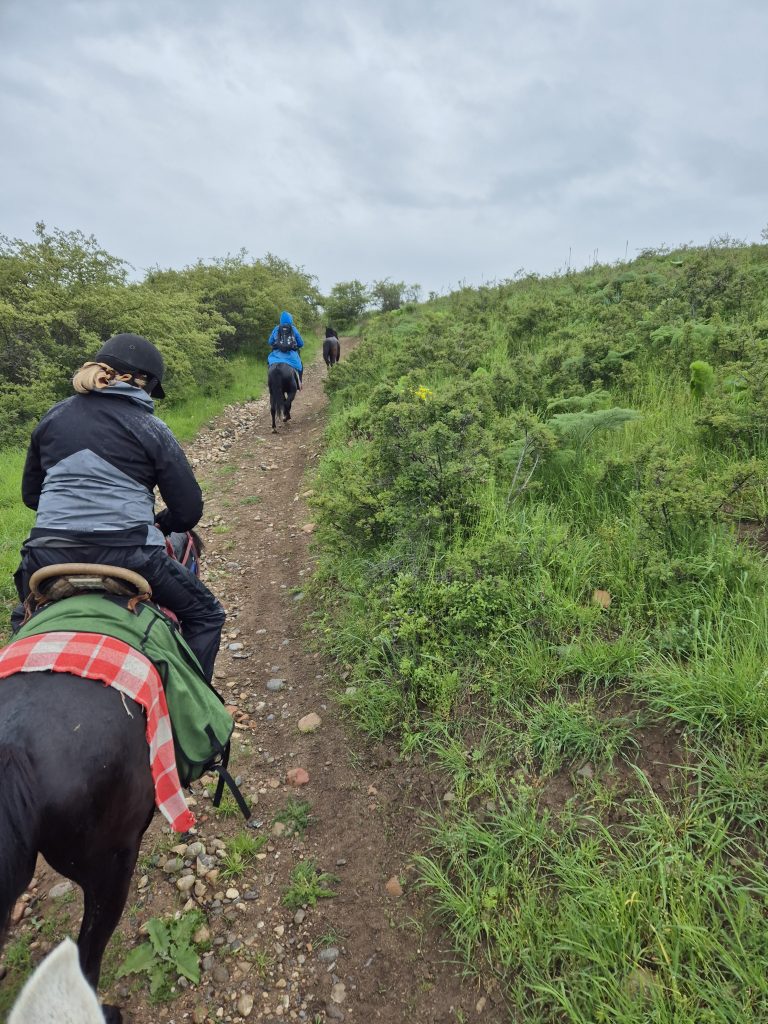
Der Nieselregen hatte sich mittlerweile in einen gleichmäßigen Strom aus starkem Regen verwandelt, und als wir im Dorf ankamen, waren wir völlig durchnässt.
Niemand hatte noch Lust, bei diesem strömenden Regen in Zelten zu übernachten, also änderten wir unsere Pläne und mieteten spontan für die letzte Nacht eine Datscha im Dorf.
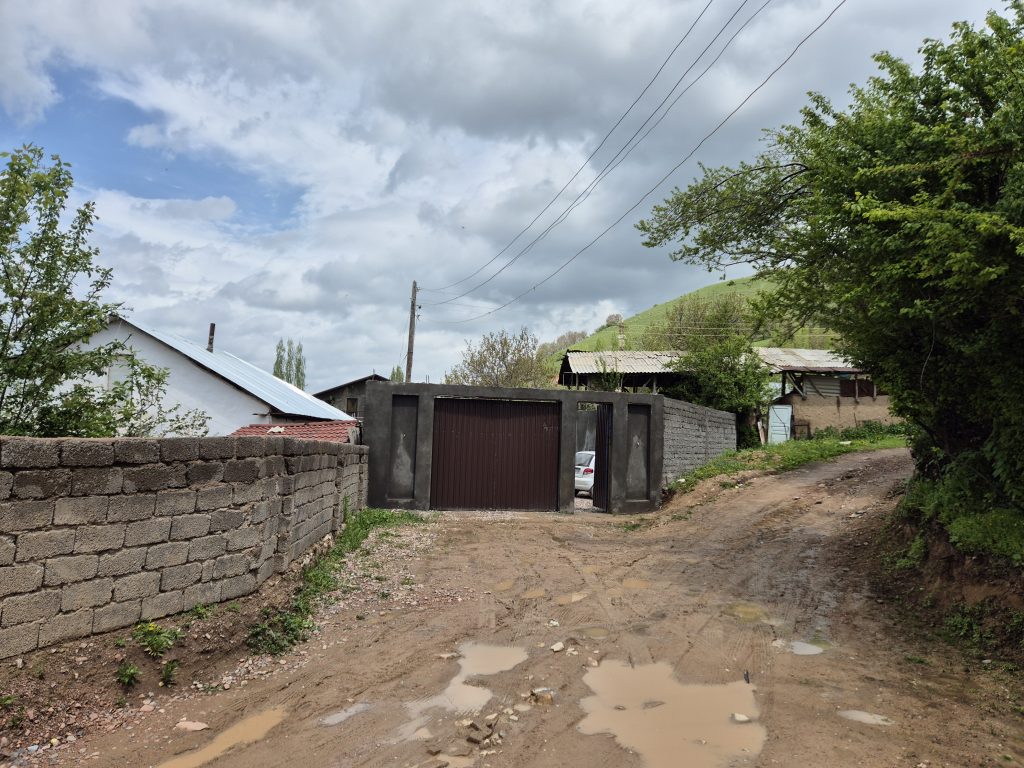
Allerdings entsprach diese Datscha keineswegs dem typischen Bild, das man von einer Datscha haben könnte. Hinter den Wellblechtoren erstreckte sich ein atemberaubender, üppiger Garten mit Birkenbäumen, der zu einer bezaubernden Villa führte.
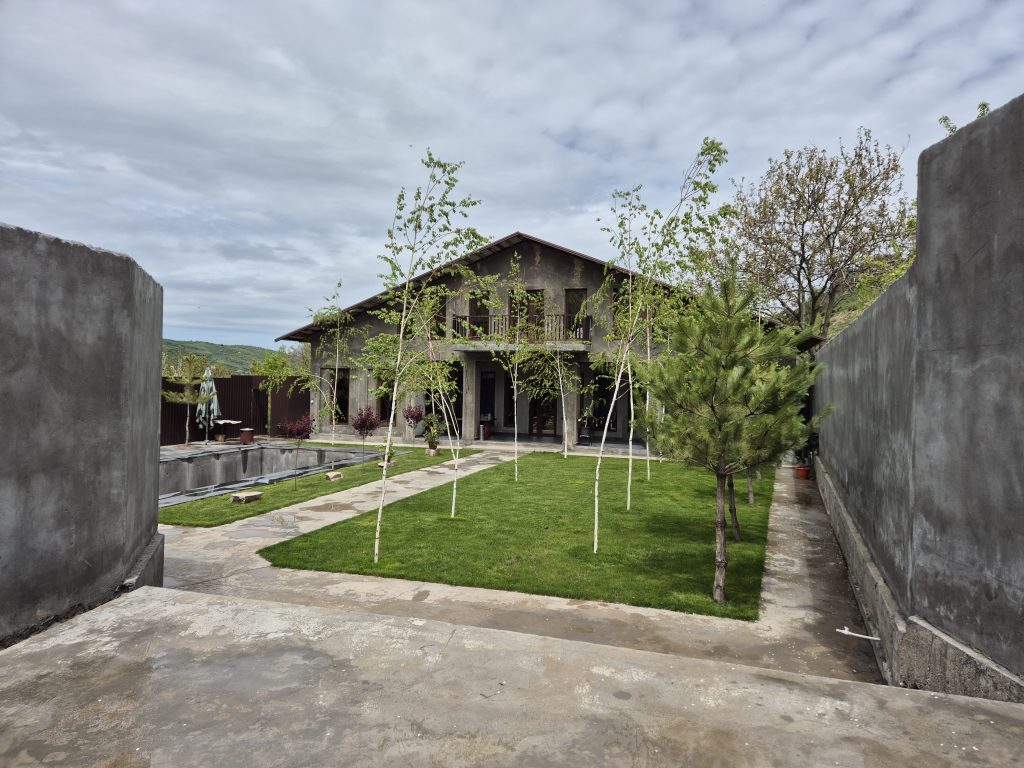
Im Haus entdeckten wir ein geräumiges Wohnzimmer, eine gut ausgestattete Küche, vier Schlafzimmer und sogar eine Sauna. Was für ein luxuriöses Upgrade von unserem bescheidenen Zelt!
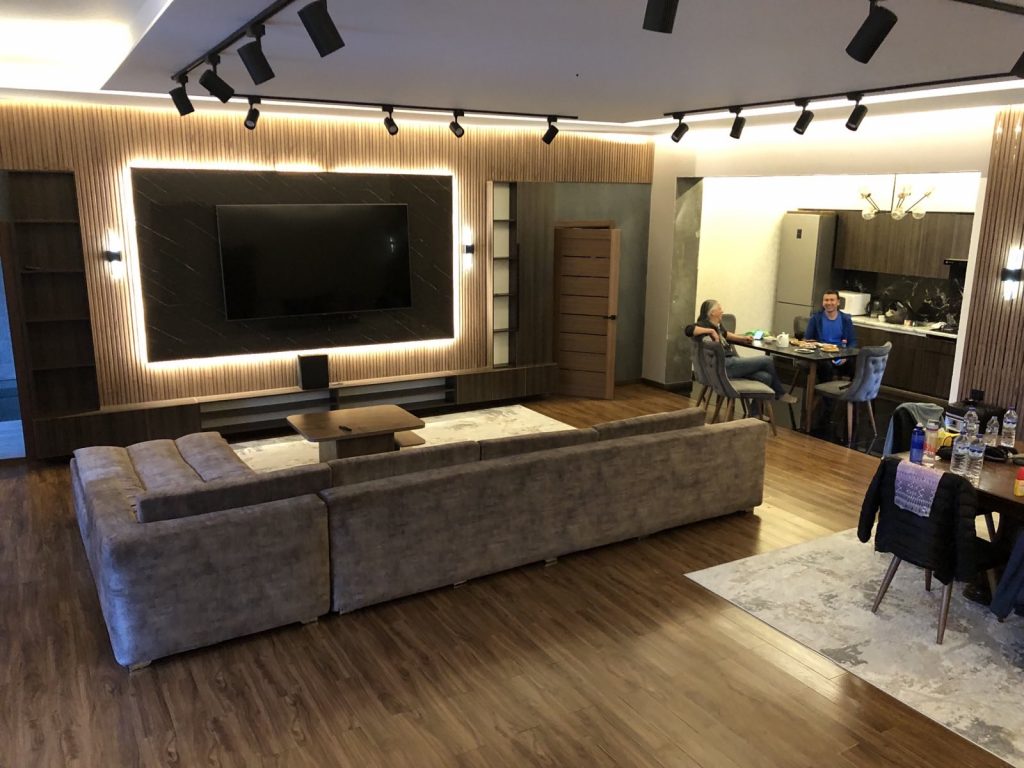
Borat und Inom kochten für uns Plov. Was für eine Köstlichkeit! Plov ist das berühmteste usbekische Nationalgericht. Fleisch, Karotten, Zwiebeln und Gewürze köcheln mindestens zwei Stunden lang in einem Topf, bevor der Reis darauf gegeben wird. Dieser Reis wird von unten mit dem Saft und allen Aromen des Gerichts gedämpft, in dem er gekocht wird. Am Ende wird der Reis umgerührt, das Fleisch in kleine Stücke geschnitten und alles auf einem großen Haufen auf einem zentralen Teller serviert. Wir hatten es mit Hühnchen (was hier kaum als Fleisch betrachtet wird) und es war köstlich.
Erschöpft, aber glücklich, genossen wir eine heiße Dusche, ein fantastisches Essen und weiche! Betten!! Im Nu waren wir eingeschlafen.
Weiter zu Tag 5
Today was supposed to be our third day riding. During the night it had rained a bit and drizzled most of the time, but the paths were still good. No rain was forecast until later that day. After another hearty porridge breakfast we packed the tents away and set out first to offload our saddle bags in Borat’s house which was a 40 min ride away. And as Esther’s horse had lost a shoe the day before we needed to get that fixed in the village too.

It took a bit longer than expected and so we decided to have lunch before heading out with the horses again. Our goal this time was a big grassy hill that overlooked the large reservoir dam and lake called Charvak lake. From up there we were supposed to see three countries. Uzbekistan, Kasachstan and Kirgisistan.

The climb up was very steep and the horses worked hard despite the lighter load to get to the top. But the view was totally worth it. Unfortunately it now started to rain, drizzling at first, but getting heavier by the minute. We put our rain gear on and headed down again as fast as we could.

All of a sudden a black young stallion appeared out of nowhere and galopped towards us whinnying as well. Three of our four stallions whinnied back and we tried to chase him away by shouting and waving. No chance. He kept appearing and unsettling our stallions. Only Esthers mount stayed calm, the others danced, pulled and whinnied around. The young stallion followed us around but did not display any agressive behaviour. Little by little it became clear that he did not protect any herd and did not have one or belong to one. He was probably cast out by an older stallion out of his original herd and was now a lonely young animal looking for some horse friends. He must have thought we could be his new horse friends.

He followed us nearly all the way back to te village and Borat had to chase him back otherwise he would have followed us even further. Poor little guy. We felt sorry for him.

The drizzle from the top of the mountain had changed into a steady stream of solid rain by now and when we arrived at the village we were soaking wet.
No one had any appetite to camp that night in the pouring rain and so we changed plans and rented a datcha for the night in the village.

However, this Datcha was far from the typical image one might have of a Dacha. Beyond the corrugated iron gates lay a stunning, verdant garden adorned with birch trees, leading to a charming villa.

Inside, we discovered a spacious living room, a well-equipped kitchen, four bedrooms, and even a sauna. What a luxurious upgrade from our humble tent!

Borat and Inom cooked Plov for us. What a treat! Plov is the most famous Uzbek dish. Meat, carrots, onions and spices simmer in a pot for at least two hours before rice is added on top. That rice is being steamed from below with all the juices and flavours of the dish it cooks in. In the end the rice is being turned under and the meat cut into little pieces and all served in a big heap on a central plate. We had it with Chicken (which is barely considered as meat here) and it was delicious.
Tired but happy in the datcha enjoying warm showers and a fantastic meal and soft! beds!! we went to sleep in no time.
Jedes Mal, wenn wir uns entscheiden zu zelten, werden wir daran erinnert, dass unsere Körper einfach nicht mehr daran gewöhnt sind, auf hartem Boden zu schlafen. Überraschenderweise hatten wir keine Schmerzen von den hölzernen Sätteln. Aber das Hin- und Herwälzen, während wir versucht hatten, eine bequeme Schlafposition zu finden, hat dann doch ein paar blaue Flecken an unseren Hüften hinterlassen. Als Chris um 7 Uhr morgens übernächtigt und verfroren aus unserem Zelt kroch, machte er sich daran, ein Feuer für unseren Wasserkessel anzuzünden.
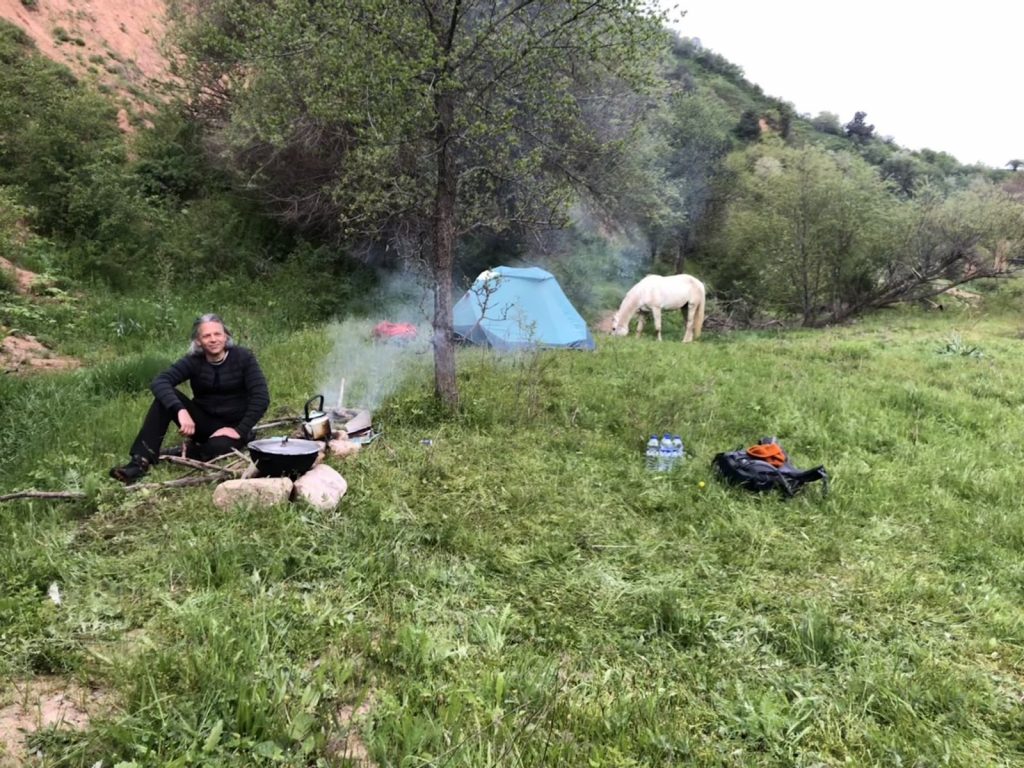
Die Pferde hatten die ganze Nacht unruhig geweidet, und Borat tränkte sie (1.000 Jahre nomadische Erfahrung…) erneut am Morgen. Zum Frühstück gab es Haferbrei und Brot mit Auberginenmarmelade (Esther’s neues Lieblingsgericht). Um 8.30 Uhr saßen wir dann wieder im Sattel, da es bewölkt war und für den späten Nachmittag Regen angesagt war.
Wir versuchten noch, Chris’ Steigbügel anzupassen, um sie etwas länger zu machen, was dann nach einigem Herumprobieren doch ganz gut klappte. Nachdem wir wieder alles gepackt und unsere Sachen in die Satteltaschen gestopft hatten, waren wir bereit, uns auf unseren zweiten Reittag aufzumachen.
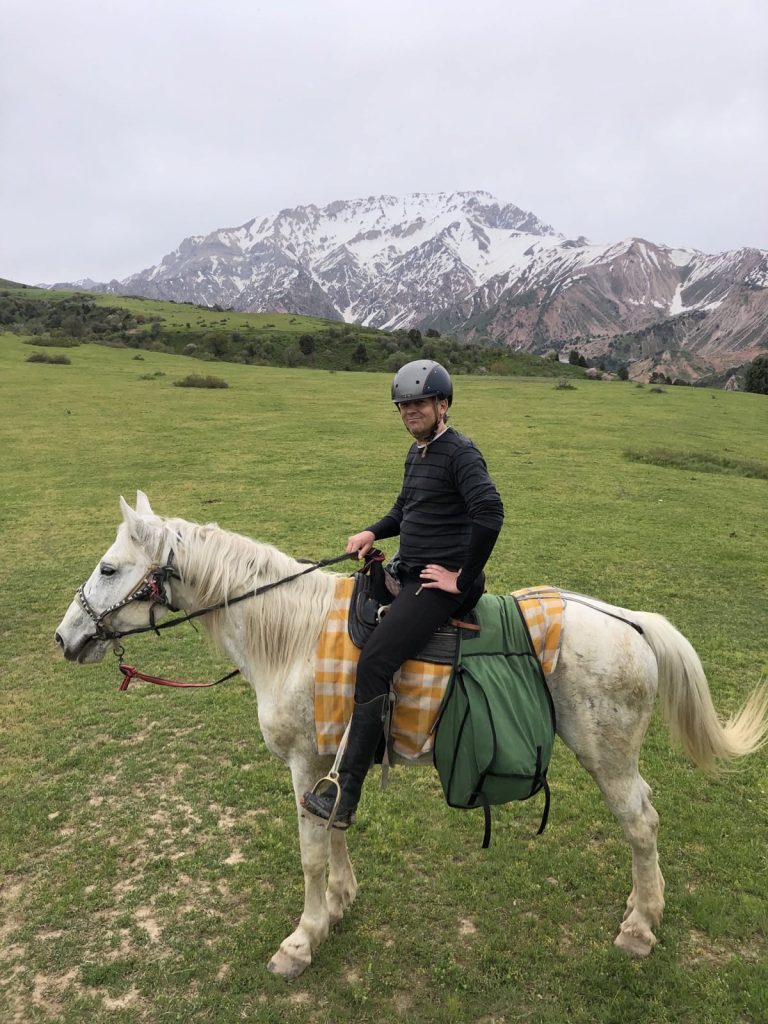
Also machten wir uns auf den Weg entlang der grasgrünen Hügel in Richtung der großen Chimgan-Berge. Aus der Ferne sahen wir einen Skiort und eine Seilbahn, die auf den Gipfel eines nahe gelegenen Berges führte, eine beliebte Sportart hier für die Wohlhabenden und Touristen.
Wir kletterten steile grasbewachsene Hänge hinauf, folgten kleinen Tierpfaden von einem Grat zum nächsten und steuerten dabei stets auf den großen Bergkamm zu. Nach drei Stunden auf unseren robusten und gut vorwärtsgehenden Pferden erreichten wir einen atemberaubenden Pass zwischen zwei Bergen mit herrlichem Blick auf beide Seiten.
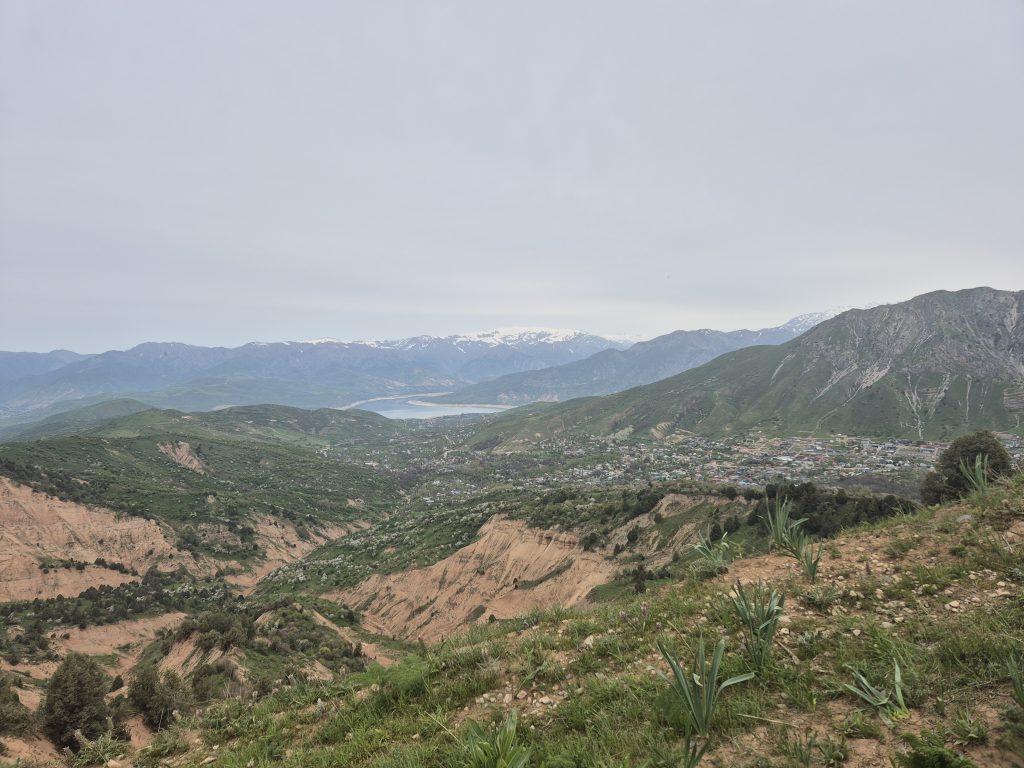
Wir beschlossen, hier eine Mittagspause einzulegen. Erneut versuchten wir, Borat zu überzeugen, den Pferden etwas Freilauf zu gewähren, indem wir dem Führzügel mehr Spiel am Zaunpfosten ließen. Ohne Erfolg. Er lockerte ihre Gurte, band sie aber so kurz, dass sie kein Gras fressen konnten und mit hocherhobenen Kopf auf uns warten mussten. Jahrhundertealte Gewohnheiten ist einfach schwer beizukommen.
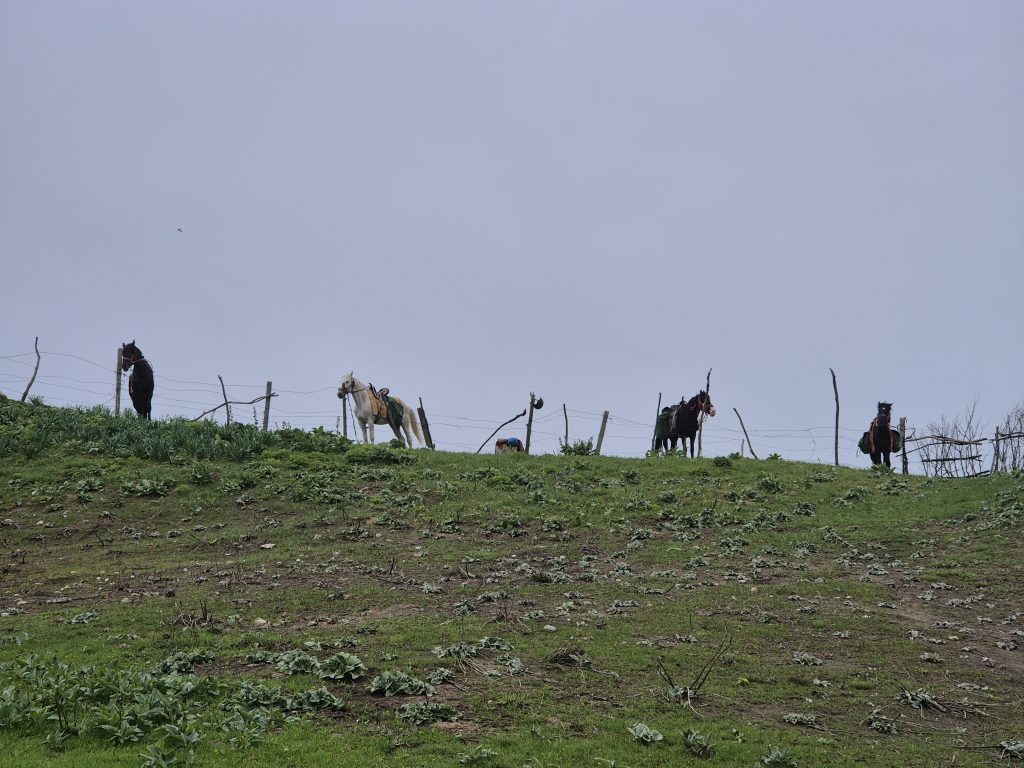
Das Mittagessen bestand wie am Vortag aus Brot (‘Non’), Käse und Wurst, der Auberginenmarmelade sowie vielen kleinen Leckereien wie getrocknetem Obst, Bonbons und kandierten Nüssen. Für uns vollkommen ausreichend.
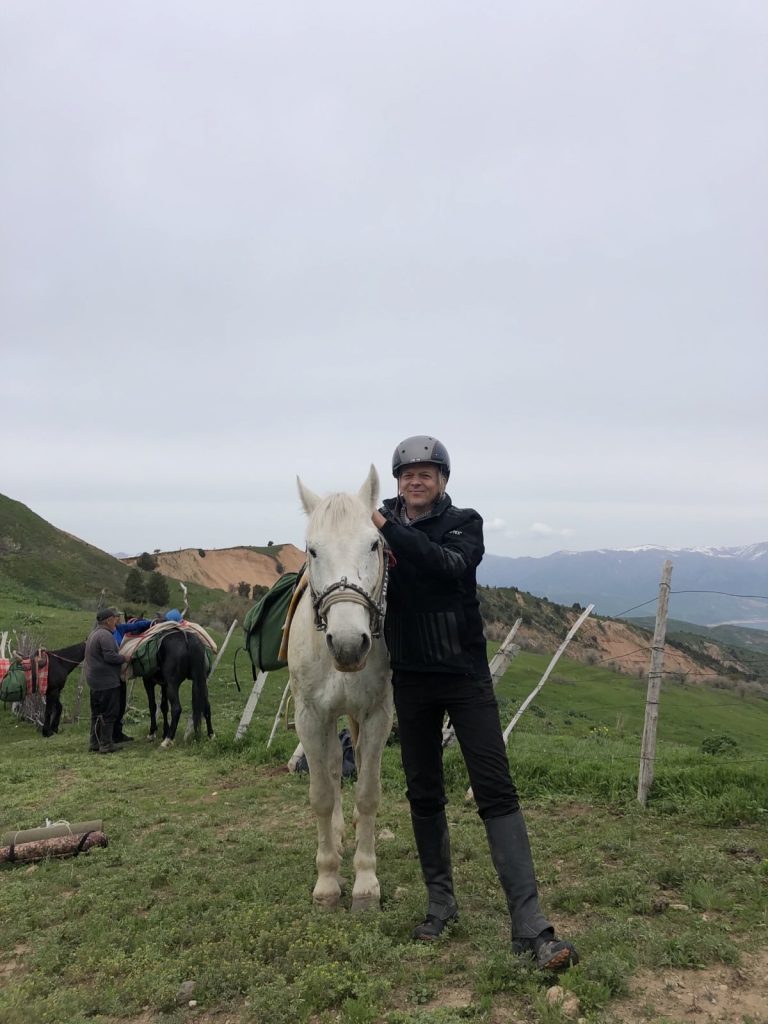
Nach einer Stunde machten wir uns wieder gut gelaunt auf den Weg. Wir passierten Herden von Schafen und Kühen, und ab und zu wieherte Borats Leithengst, wenn er eine andere Pferdeherde in der Nähe spürte. In den meisten Fällen hielten sie Abstand, aber ab und zu versuchte der Herdenhengst, seine Herde vor den vier dahergelaufenen Hengsten zu verteidigen, indem er aggressiv gegenüber unseren Pferden auftrat. Einmal kam einer sehr nahe heran, und Borat und Inom mussten ihre Peitsche erheben und laut rufen, um ihn zu vertreiben. Angriffe von Hengsten sind hier nicht ungewöhnlich, und man muss immer auf der Hut sein, da die grünen Hügel nicht eingezäunt sind und Tiere frei herumlaufen können.
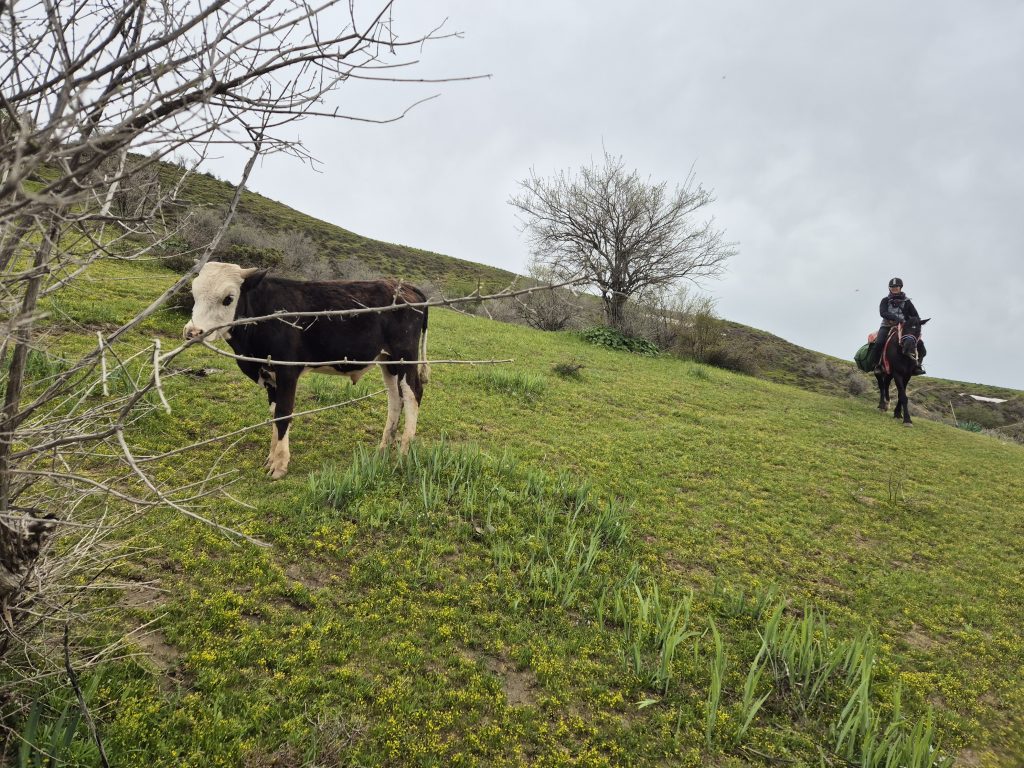
Wir kamen an einem Sommercamp eines Schäfers vorbei, etwas simpler als die unsrigen in den Alpen, wo sie nur für die Sommerperiode mit ihren Tieren in den Bergen leben. Im Winter ziehen sie wieder in tiefere Regionen hinunter. Eine nette Familie überreichte uns etwas in einer Tüte, das wie weiße Tischtennisbälle aussah.
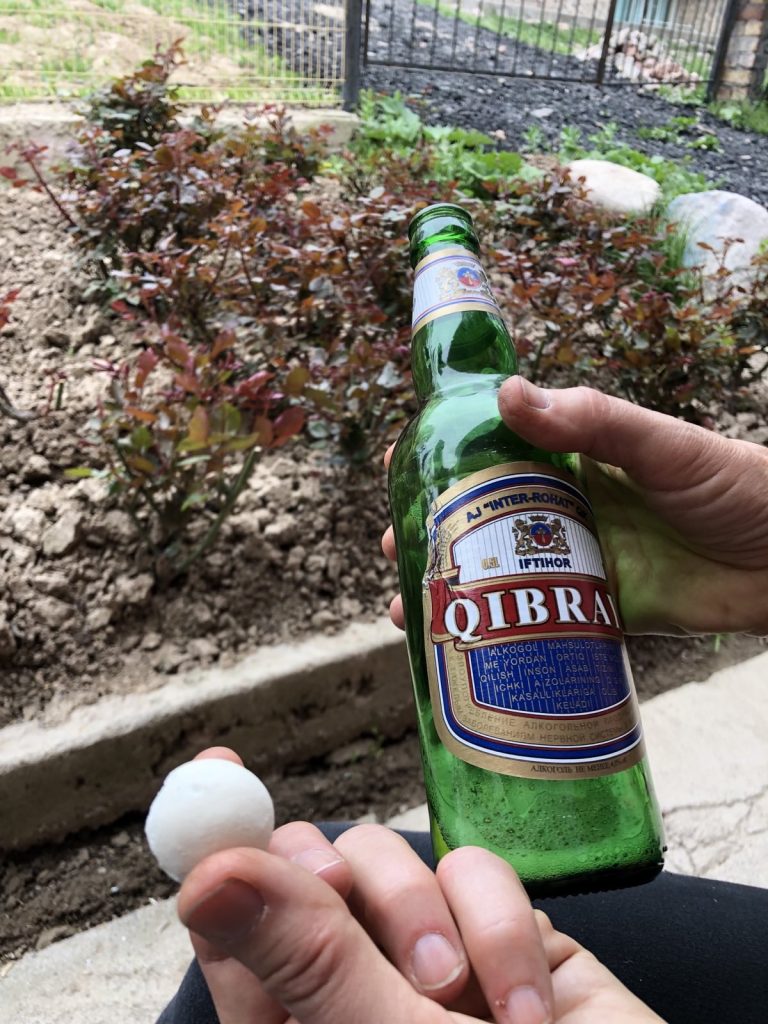
Es stellte sich heraus, dass dies eine usbekische Spezialität namens Kurd ist, ein fermentierter und gereifter Hartkäse, der jahrelang halten kann und perfekte Nahrung für Reisende auf der Seidenstraße war und noch heute ein beliebter Snack ist – am Besten zu genießen mit Bier.
Auf unserem Weg zum zweiten Lager schwärmten Borat und Inom plötzlich aus und begannen nach etwas zu suchen. Verwirrt fragten wir, wonach. Es stellte sich heraus, dass sie uns mit einer besonderen essbaren Pflanze namens ‘Matar’ überraschen wollten. Sie wächst nur in dieser Region in den Bergen und wird nicht kommerziell angebaut. Wir blickten dem Abendessen mit Neugier entgegen.
Nachdem wir eine Herde Schafe und Ziegen durchquert hatten, stießen wir auf ein sehr junges, wahrscheinlich frisch geborenes Ziegenkitz. Es gab erbärmliche Schreie von sich und schien seine Mutter zu suchen. Zunächst versuchten wir, es mit unseren Pferden zur Herde zu führen, aber statt dessen schien es uns plötzlich als seine neuen Betreuer zu betrachten. Folglich entschied Inom, abzusteigen und das Ziegenkitz zu ergreifen, um es zur Herde zurückzubringen. Diese Aktion erschreckte jedoch das junge Tier, und Inom musste ihm hinterher rennen. Nach mehreren hundert Metern gelang es ihm schließlich, es einzufangen und das verirrte Tier wieder mit seiner Herde zu vereinen.
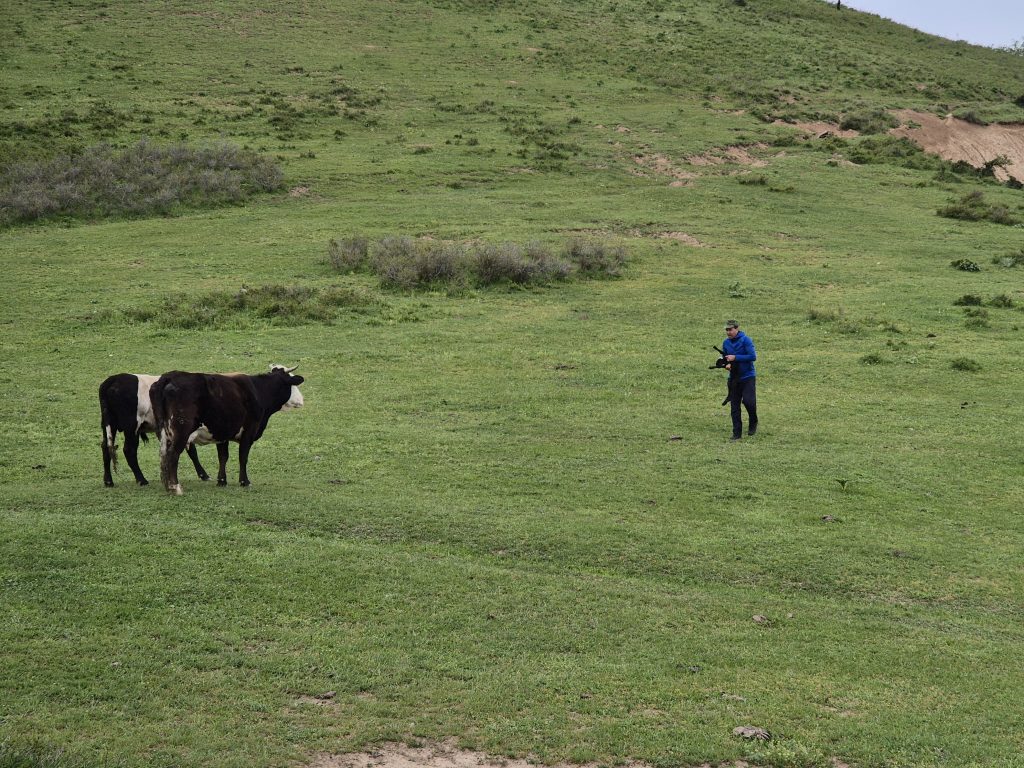
Zwei Stunden später kamen wir in Borats Heimatstadt, Chimgan, an und schlugen unser Lager auf Borats Wiese über der Stadt auf.
Wir hatten ein größeres Zelt mitgenommen, da der Regen zunehmen sollte, und hatten Glück, dass wir das Lager immer noch halbwegs im Trockenen aufbauen konnten.
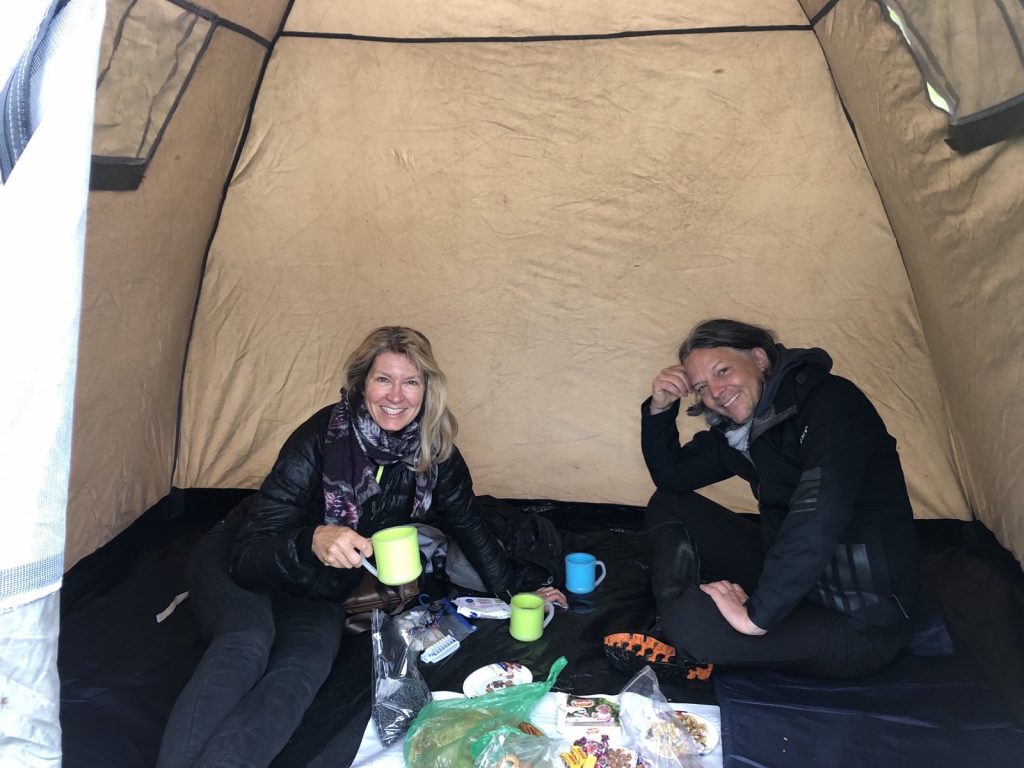
Wir entschieden uns für einen gemütlichen Spaziergang, um die Umgebung zu erkunden. Beim erreichen des Dorfes suchten wir in einem kleinen Laden in Chimgan nach Erfrischungen und teilten uns zwei Flaschen Bier. Währenddessen spielte Chris mit einem lokalen Kind ein Spiel, bei dem es darum geht, eine Karte durch draufschlagen mit der flachen Hand umzudrehen. Das Spiel erwies sich als herausfordernd, und trotz Chris’ Bemühungen ging der Junge als Sieger hervor, weil er zu unfairer Taktik griff, indem er seine Handfläche ableckte.
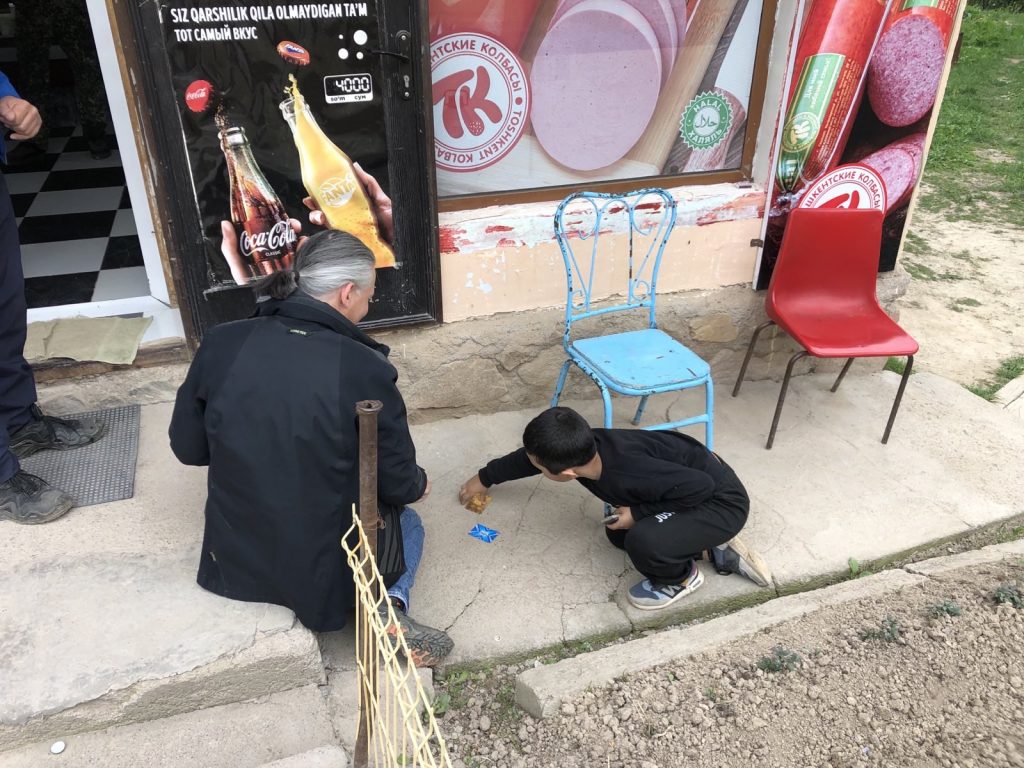
Inom holte eine der Kurd-Kugeln heraus und erklärte, dass sie am besten mit Bier genossen werden. Man muss die harte Oberfläche mit den Zähnen abkratzen, den weißen Kurd(käse) im Mund schmelzen lassen und gleichzeitig einen Schluck Bier dazu trinken. Wir haben es beide ausprobiert; es schmeckte salzig und sauer. Und tatsächlich passte es gut zum Bier. Aber es ist ein Geschmack, der gewöhnungsbedürftig sein kann.
Zurück im Lager brachten wir alles in unser Zelt, denn die Regenwolken rückten näher. Borat hatte das größere Zelt von zu Hause mit einem süßen kleinen Esel herbeigeschafft, der oft wieherte und dabei gleichzeitig furzte. Es brachte uns jedes Mal aufs Neue zum Lachen.
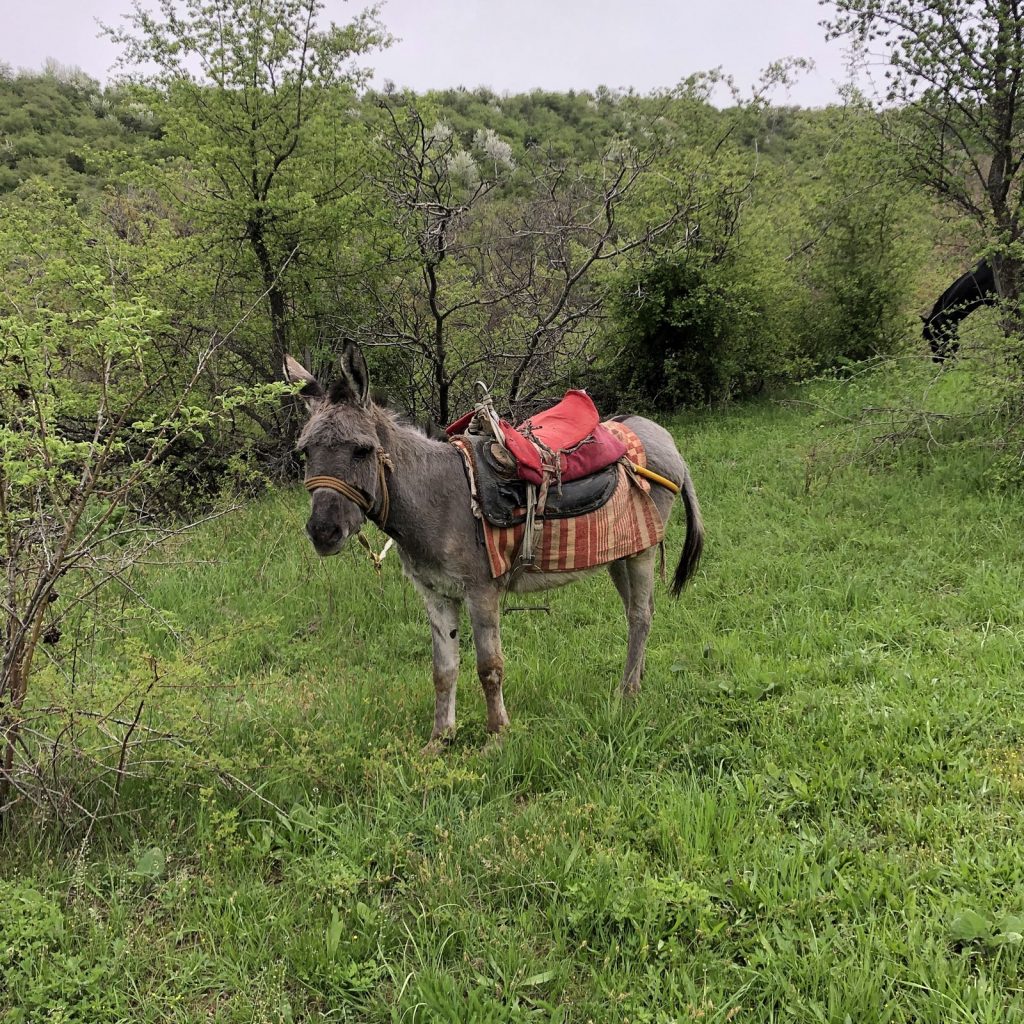
Auf einem ausgeschnittenen alten Eimer stellten sie einen abgerundeten Kessel und begannen, den Matar zuzubereiten.
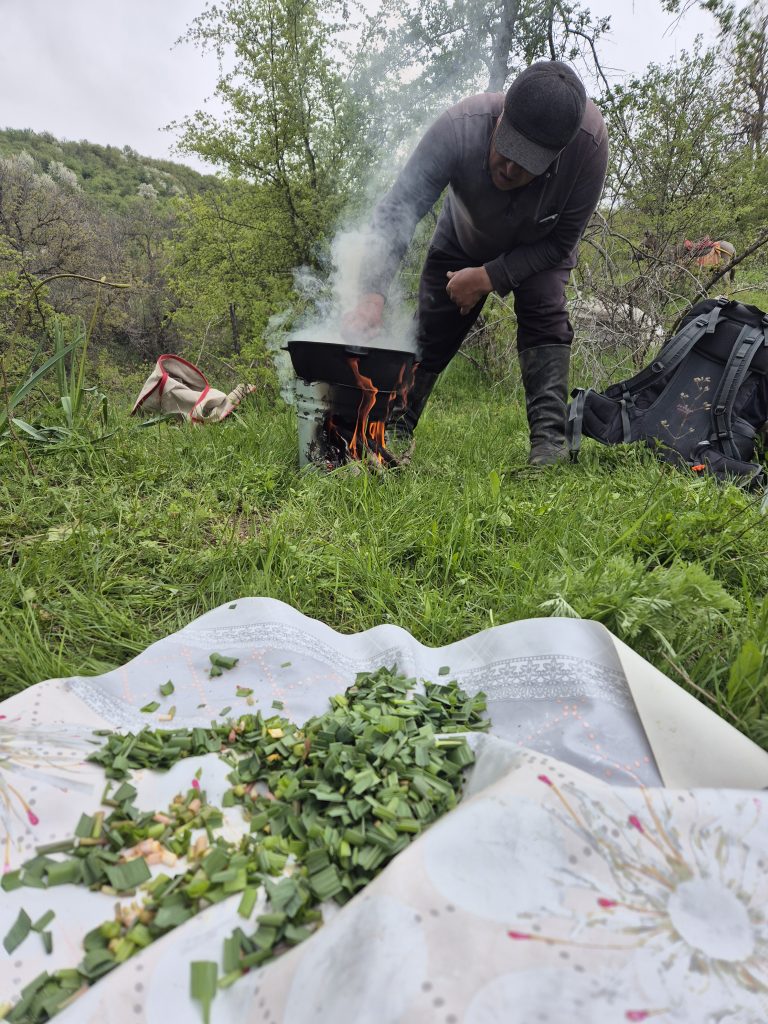
Öl, Zwiebeln und klein geschnittener Matar wurden in den Kessel gegeben und angebraten. Matar ist eine Mischung aus Frühlingszwiebeln und Schnittlauch oder Bärlauch. Nach etwa 30 Minuten Kochzeit bekamen wir alle eine Schüssel voll und verschlangen es mit frischem Brot.
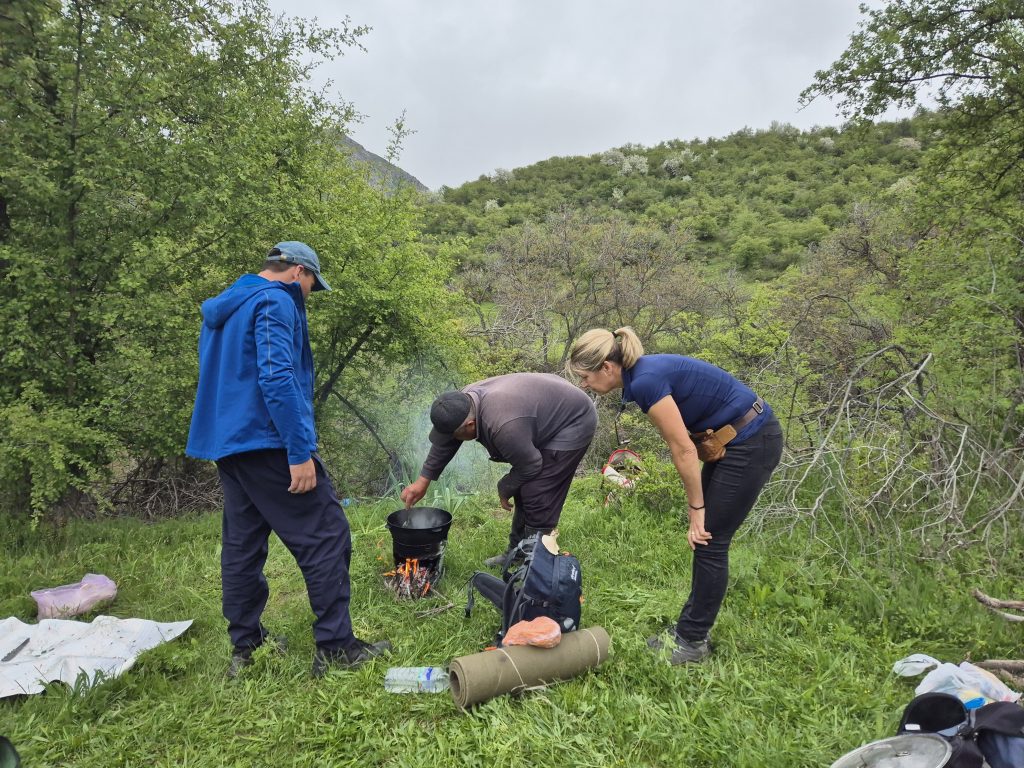
Es schmeckte wirklich sehr gut. Fast wie geräucherter Spinat.
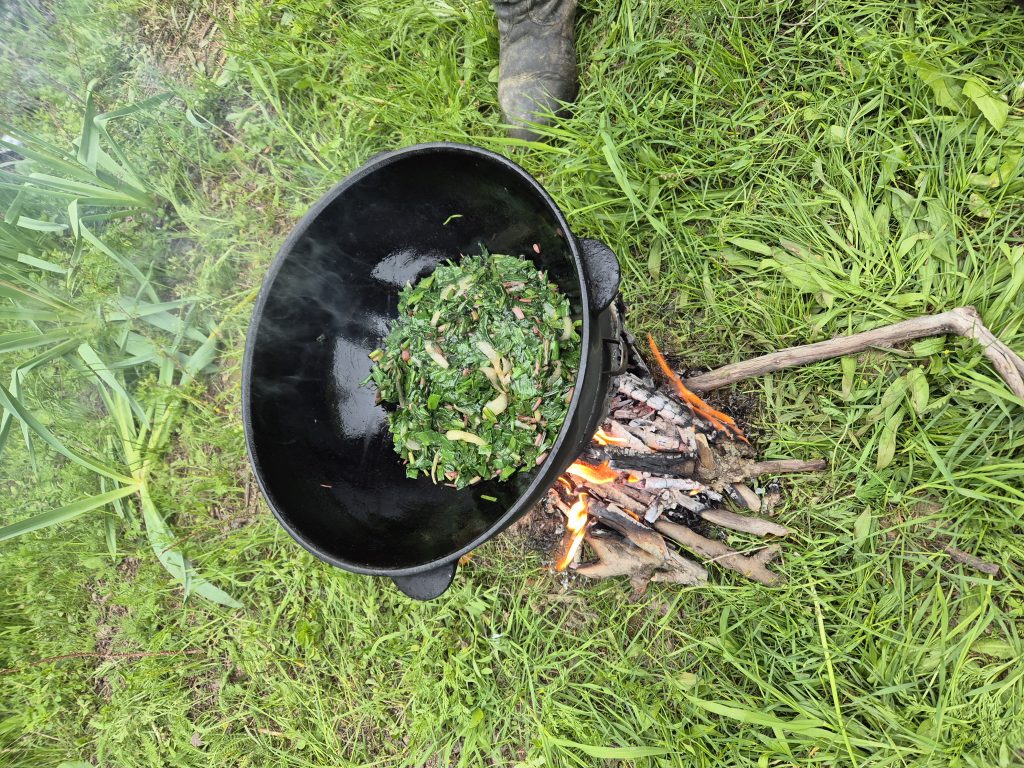
Pünktlich nach unserem Abendessen begann es leicht zu tröpfeln. Wir zogen uns für die Nacht zurück und kuschelten uns in unsere warmen Schlafsäcke, lauschten dem leisen Tropfen des Regens.
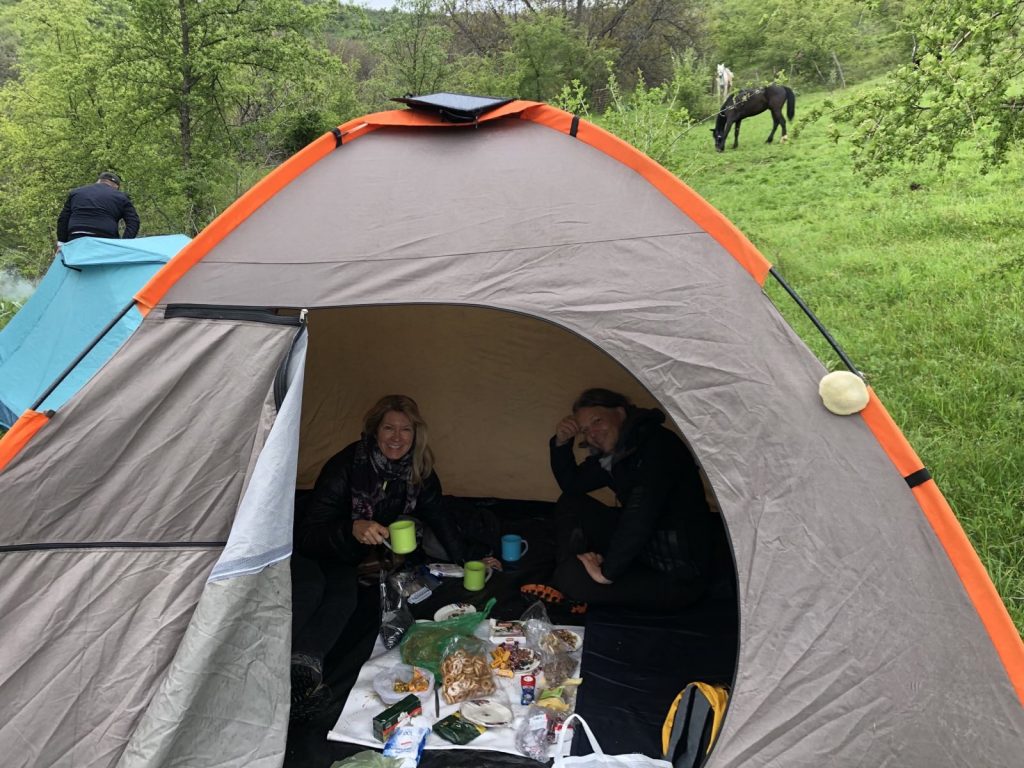
Erneut sehnten wir uns nach weicheren Matratzen, aber hey, man kann nicht alles haben. Immerhin waren die Wettergötter heute auf unserer Seite gewesen, das musste reichen.
Weiter zu Tag 4
Every time we decide to camp, we are being reminded that our bodies simply are not used anymore to sleeping on really hard ground. Surprisingly we were not sore from the local saddles, but the tossing and turning, trying to find a comfortable position to sleep produced bruises on our hips. Crawling out of our tent at 7 AM Chris set to start a fire for our tea kettle.

The horses grazed fitfully the whole night and Borat watered them (1000 years of nomadic experience…) again in the morning. Porridge and bread with aubergine jam (Esthers favorite) was the breakfast for this morning. By 8.30 AM we were on the horse again since it was overcast and we were told it’ll rain by late afternoon.
We tried to adjust Chris’ stirrups to make them a bit longer, which, after some fiddeling, worked out pretty well. After packing everything again and stuffing our things in the saddlebags, we were ready to start our second day of riding.

So off we set along grassy hills towards the great Chimgan mountains. From afar we saw a ski resort and cable car going to the top of a nearby mountain, a popular sport here for the wealthy.
We climbed up steep grassy slopes on little animal paths from one ridge to the next, always heading towards the great mountain ridge. After three hours riding on our sturdy and very forward heading horses, we reached a breathtaking pass between two mountains with splendid views to either side.

We decided to break here for lunch. Again we tried to convince Borat, to let the horses graze a bit by tying them longer to a fence post. To no avail. He loosened their girths but tied them so short that they could not eat any grass. Centuries old habits never die.

Lunch consisted like the day before of bread, cold cheeses and sausage, the aubergine jam and lots of little sweet treats like dried fruit, bonbons and candied nuts. Pferfectly adequate for us.

After one hour we started out again in good spirits. We passed herds of sheep and cows, and once in a while Borat’s lead stallion whinnied when he sensed another herd of horses close by. In most cases they kept a distance, but once in a while the herd stallion tried to protect his herd by agressing our horses. One came realy close and Borat and Inom had to raise their whip and shout out loud to make him go away reluctantly. Stallion attacks are not uncommon here and one always needs to watch out as the green hills are not fenced in and animals can roam freely.

We came by a sheperds summer home, similar to what we have in the Alps , where they live with their animals in the mountains for the summer period only. In Winter they move down again to lower grounds. A nice family handed us something in a bag that looked like white ping pong balls.

Turns out that this is an UZ specialty calles Kurd, fermented and cured hard cheese that can last for years and which was perfect food for those who travelled the silk road.
On we went towards our second camp when Borat and Inom all of a sudden fanned out and started to search for something. Puzzled we asked what it was they were looking for. Turns out that they wanted to surprise us with some special edible plant called Matar. It only grows in that region in the mountains and is not grown commercially. We were looking forward to eating it that night.
After traversing a flock of sheep and goats, we came across a very young, likely newly born goat. It emitted pitiful cries and appeared to be searching for its mother. Initially, we attempted to guide it towards the herd using our horses, but it unexpectedly began to regard us as its caretakers. Consequently, Inom made the decision to dismount and apprehend the goat in order to return it to the flock. However, this action startled the young animal, prompting Inom to pursue it. After several hundred meters, he successfully captured it and managed to reunite the wayward creature with its herd.

Two hours later we arrived at Borat’s home town, Chimgan Village and set up camp at the outskirts.
We got a bigger tent as it was supposed to rain more and were lucky to still set up camp in the dry.

We opted to take a leisurely stroll and explore the surroundings on foot. Venturing into the village, we sought refreshment at a small shop in Chimgan, aiming for a bottle of beer. While there, Chris engaged in a game with a local kid, where the objective was to skillfully flip a card on the ground to reveal its face. The game proved challenging, and despite Chris’s efforts, the young local emerged victorious, resorting to unfair tactics by licking his palm to gain an advantage.…

Inom produced one of the Kurd balls and explained that those are best savoured with beer. You had to scrape the hard surface with your teeth, let the white kurd melt in your mouth and then sip a bit of beer at the same time. We both tried it, it tasted salty and tart and had strange reaction with beer when consumed together, but it is an acquired taste and we had enough sharing one kurd ball between us.
Back at Camp, we moved everything into our tent as rain was imminent. Borat had gotten the larger tent from his home by a cute little donkey who brayed often and farted at the same time.

It made us laugh every time. On a cut out old bucket, they put a rounded kettle and started to prepare the Matar.

Water, oil, onions and small cut Matar went into the kettele and started to fry. Matar is a mix between a spring onion and chives or Baerlauch. After cooking for about 30 min we all got bowls full of it and ate it with fresh bread.

It tasted really very good. Nearly a smokey spinachy flavor to it.

Just in time after our dinner it started to drizzle. We cleaned up for the night and snugled into our warm sleeping bags listening to the drip drip of rain coming down.

Again we wished for softer matresses, but hey you cannot have everything, the weather gods were with us today, that was enough.
